

Lukla to Namche Bazar: Beautiful & Epic Everest Region Treks
Lukla to Namche Bazaar or Everest Base Camp Trek: In 2016, I embarked on a transformative and unforgettable journey to Nepal that deepened my appreciation for this stunning country and its people.
It paved the way for numerous life-changing experiences and lessons. One highlight was a four-night trek through the Everest region!
Table of Contents
I feel, whoever is capable to do so in this lifetime, should absolutely not miss it. charlotte
While I didn’t make it to Everest Base Camp , my trek took me to the enchanting (yet gruelling to reach!) Everest View Hotel. Even during this brief three-day leg, I immersed myself in the most breathtaking scenery I had ever encountered.
During this trek, I forged connections that transcended mere acquaintanceship, turning strangers into lifelong friends. The journey allowed me to disconnect from technology and reconstruct connect with nature. It was a much needed break from our hectic western life!
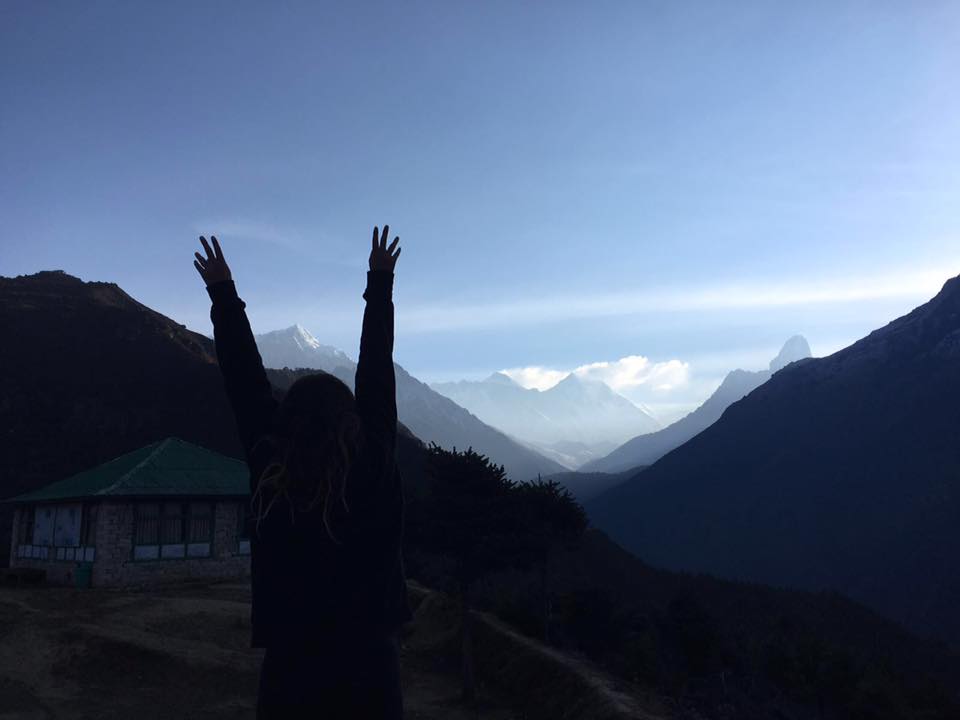
If you are planning a trip to Nepal, check out my Beautiful Nepal Itinerary too!
As I navigated the trails from Lukla to Namche Bazaar, I confronted extreme physical and mental challenges, pushing my limits and discovering a profound sense of pride and strength within myself as I emerged from this unforgettable experience.
Though short, the trek to Everest View Hotel became a poignant chapter in my adventure through Asia. It is one of the best memories of my trip.
It left me with indelible memories and a newfound appreciation for the resilience of both the human spirit of the sherpas, who trek tirelessly down this trial every day of their working lives. But also the awe-inspiring landscapes and culture of Nepal.
Lukla to Namche Bazaar Trek Route Highlights:
- The starting point of the trek, Lukla, welcomes with its small yet bustling airport.
- Quick ascent in altitude from Kathmandu, setting the stage for acclimatization.
- The first stop on the journey was a charming village along the Dudh Koshi River.
- Provides an initial taste of the trail’s natural beauty.
- Entry point to the Sagarmatha National Park, where trekkers obtain permits.
- The bridge crossing over the Dudh Koshi River adds a touch of adventure.
- A scenic village surrounded by lush greenery, offering a brief respite.
- Marks the final stop before the challenging ascent to Namche Bazaar.
- Gateway to the Everest region and a bustling Sherpa market town.
- Stunning panoramic views of Everest and other Himalayan peaks.
- Essential rest day in Namche Bazaar to allow the body to adjust to higher altitudes.
- Opportunity to explore the vibrant local Nepalese culture and visit the Sherpa Museum.
** The Namche Bazaar hike concludes here, offering the optional extension to hike up to the Everest View Hotel (highly recommended) before commencing the descent.
If you Carry on to Everest Base Camp:
- A spiritual haven with the famous Tengboche Monastery.
- Offers breathtaking views of Ama Dablam and Everest.
- Higher altitude brings a change in the landscape with alpine meadows.
- Ideal spot for acclimatization before pushing towards higher altitudes.
- A rugged and challenging terrain, trekking towards the Everest Base Camp.
- Memorial for climbers who tragically lost their lives on Everest adds a somber touch.
- The final stop before Everest Base Camp is situated on a rocky moraine.
- Panoramic views of Everest, Nuptse, and surrounding peaks.
- The culmination of the trek, standing at the foot of the world’s highest peak.
- Optional side trek for unparalleled views of Everest at sunrise.
- Offers a breathtaking panorama of the Khumbu Glacier.
- Retracing steps back through Lobuche, Dingboche, and Tengboche.
- Reflective descent with a chance to appreciate the journey in reverse.
- Bidding adieu to the vibrant market town as the trek concludes.
- The route encapsulates diverse landscapes, from dense forests to high-altitude alpine terrains.
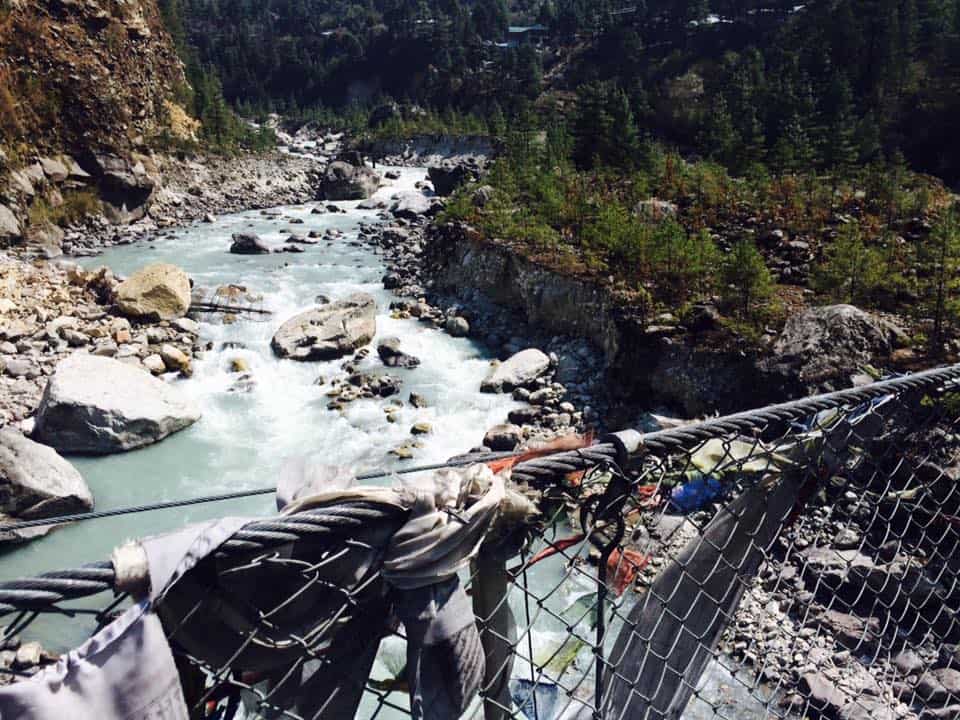
Choosing Your Trek:
Get ready for an adventure that will take your breath away right into the heart of the Himalayas, where Everest stands tall. Whether you’re dreaming of the epic Everest Base Camp trek or opting for the scenic route, much like my unforgettable trek to Namche Bazaar, the Everest region promises an experience beyond the ordinary.
Picture yourself flying from bustling Kathmandu to the charming Lukla, where the excitement of landing at one of the world’s trickiest airports awaits.
You’ll then stroll through the enchanting village of Phakding, heading towards the lively Namche Bazaar, and finally reaching the Everest View Hotel – a luxury spot perched at a jaw-dropping 3880 meters in the Sagarmatha National Park, a world-renowned UNESCO World Heritage Site.
This ‘Everest View Trek’ or the Lukla to Namche Bazaar route is tailor-made for those craving the extraordinary but pressed for time. From wandering around Lukla village to crossing one of the world’s highest suspension bridges, every single moment of this 5-day journey paints a picture of a unforgettable Himalayan adventure.
This journey is not just about the destination. It’s about building friendships while exploring Namche Bazaar and the Sherpa villages, learning about Nepalese culture and exploring this beautiful country. It’s about conquering challenges, savouring natural moments, and disconnecting from the world.
Whether you choose the epic Everest Base Camp trek, a longer journey, or the shorter but equally enchanting Namche trek, the Himalayas always provide some of the most stunning vistas in the world!
With the flexibility of free cancellation up to 24 hours in advance and the ease of reserving now and paying later, these treks are accessible, too. So, listen to the call of the Himalayas!
Also, Read my Blog – Life Changing Spiritual Tours in Nepal Here!
Choosing the Right Trekking Route:
Now, let’s dig into the crucial decision of picking the correct route for you. Whether you’re leaning towards the grand Everest Base Camp or the charming Lukla to Namche Bazaar (Everest View Hotel) trek, your choice should match your time, fitness, and the experience you’re after.
1. Time Consideration:
- If you’re tight on time, the Lukla to Namche Bazaar trek is a condensed yet equally stunning experience in just five days – perfect for those with limited vacation days.
- The Everest Base Camp trek demands more time, usually around 11 to 12 days, which is ideal for those wanting a comprehensive Himalayan adventure.
2. Physical Preparedness:
- Namche trek is less strenuous, accessible to those with moderate fitness levels, and great for tasting Himalayan beauty without intense training.
- The Everest Base Camp trek is physically demanding and requires a higher fitness level. It’s for those who are prepared for the sustained challenges of a longer trek.
3. Experience Preferences:
- If you’re drawn to a shorter but still incredible journey, Namche is the way to go. It lets you savour the highlights without committing to a more extended adventure.
- Everest Base Camp trek deepens into Himalayan culture, majestic landscapes, and the triumph of reaching Everest Base Camp. It’s the ultimate adventure for those seeking a profound connection with the region.
Ultimately, whether you pick the iconic Everest Base Camp trek or the shorter but equally enchanting Lukla to Namche Bazaar trek, the Himalayas promise an adventure that leaves a mark on your soul. The choice is yours, and each route offers a unique set of experiences waiting for you to explore.
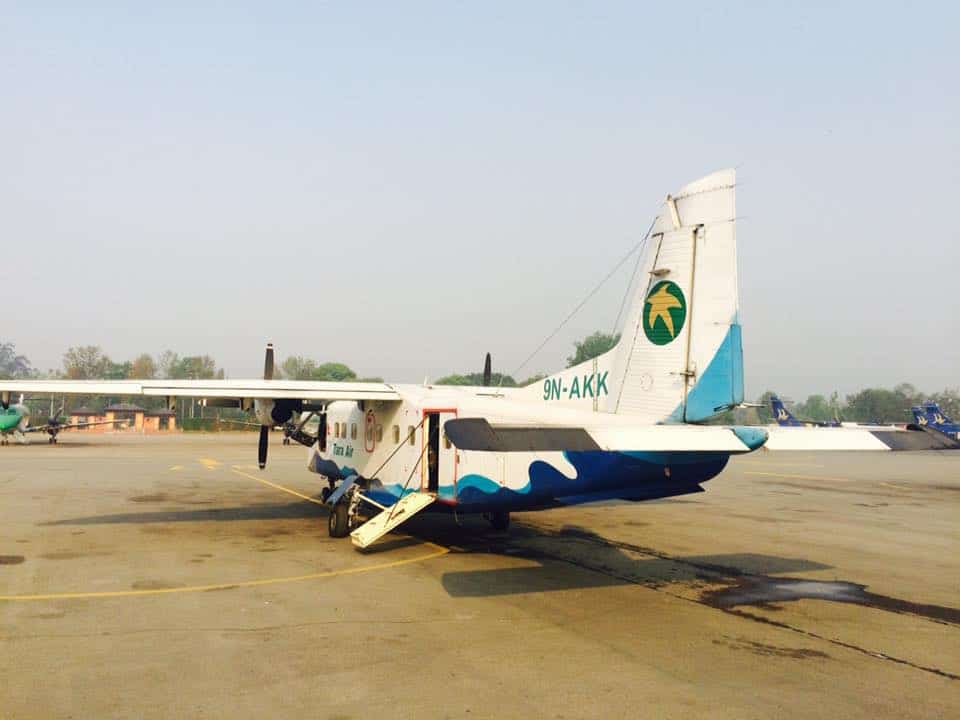
Lukla to Namche Bazaar Trek
Day 1: kathmandu – lukla, flying into lukla.
On the initial day, we set out from Lukla, renowned as the world’s smallest airport. However, the challenges commenced well before our departure.
As an individual with a fear of flying and heights, the first hurdle was conquering the anxiety over boarding a plane designed for approximately 22 passengers. Overcoming this fear became my initial triumph, essential for reaching the starting point of our Himalayan journey.
The actual trial lay in the simple act of boarding the small aircraft. Seated with nerves gripping me, the ascent began. However, when I glanced out the window and beheld the towering snow-covered mountains, my initial nervousness transformed into sheer awe.
The descent into Lukla, landing at the world’s smallest airport, challenged me to completely surrender to the unpredictable forces of fate, which my nervous system wasn’t a fan of.
Releasing all control and trusting the plane and the pilots became our adventure’s inaugural lesson and perhaps the most significant lesson of the trip.
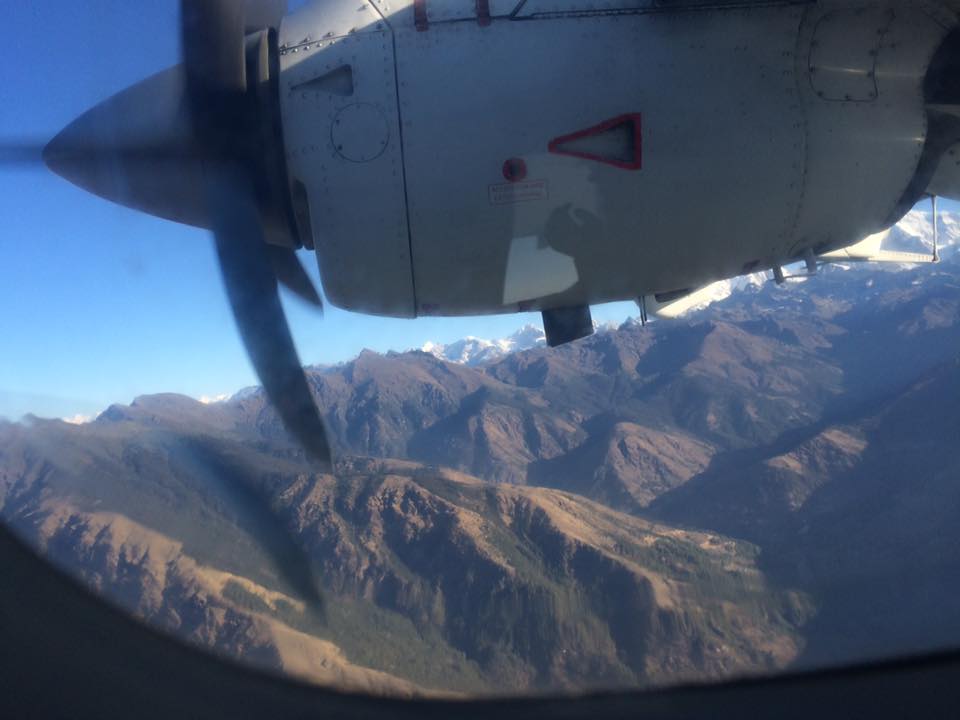
Starting the Trail into the Himalayas
I vividly recall embarking into the foothills, traversing cobbled stone paths, passing by ancient temples, navigating through narrow gauges, and finally entering lush fields and forests.
Our journey led us to our first accommodation of the trek—a charming log cabin in Phakding. It served as an oasis from the cold, offering much-needed respite after our first day in the Himalayas as naive trekkers.
The memory of the view from my bedroom remains etched in my mind even today, seven years later. Waking up in the crisp morning air, grappling with the cold as I put on my socks, brought excitement and nervous anticipation for the day ahead. I will never forget it.
Despite the soreness from the previous day, there was an eagerness for the days ahead, promising further ascents into the majestic mountains.
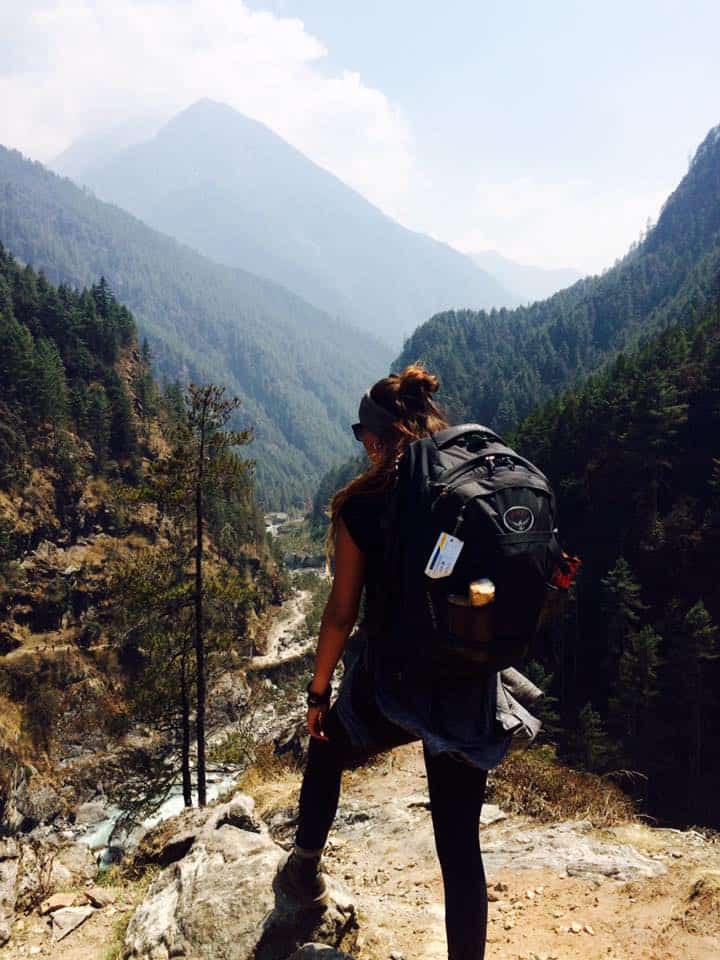
DAY 2 – The Gruelling Accent to Namche Bizzare
On the second day, we bid farewell to the comforting haven of our hotel in Phakding and embarked on a new chapter of our journey. The trail led us through the enchanting village of Monjo, where every step revealed more of the stunning Himalayan landscape.
Before this trek, I had never been in the mountains. I had always traveled to hotter countries so it was my first time seeing snow-capped peaks and i was in awe. Monjo left an indelible mark with its charm and beauty, making it one of the most stunning villages I had ever experienced.
As we pressed on, the journey took a turn upon reaching Jorsalle, a place marked by conflicting emotions. On the one hand, the village presented an unparalleled beauty, captivating with its picturesque surroundings and the soothing melody of the Dudh Koshi River.
However, Jorsalle also served as the precursor to one of the most grueling challenges awaited us. The anticipation loomed as we faced a near-vertical ascent up to the village of Namche Bazaar.
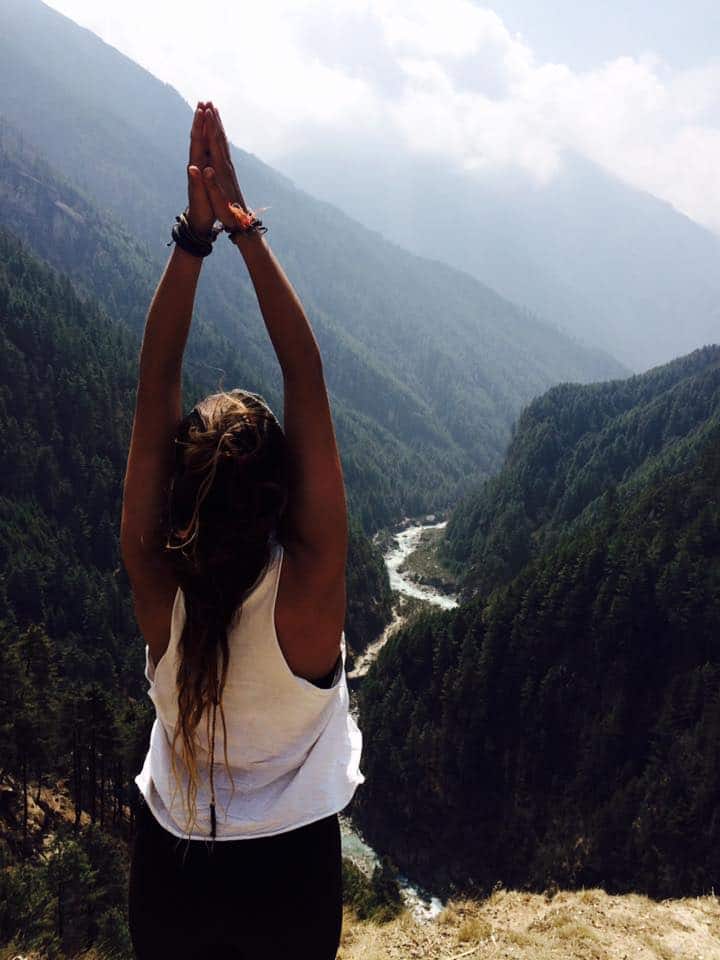
The next three hours proved to be the most physically demanding of the trek. The path unfolded, winding up the mountain, with each step feeling like a battle with gravity. The climb was strenuous, each upward stride pushing our bodies and minds to their limits.
Despite the physical demands, the stunning landscapes and the camaraderie with fellow trekkers fueled our determination to conquer the mountains ahead. I did feel like i was dying on multiple occasions but the view and sense of achievement made me forget about it not long after.
The ascent from Jorsalle to Namche Bazaar became a testament to the resilience and the unwavering spirit required to navigate the rugged terrains of the Everest region.
The perseverance it took me to complete the hike, not give up, and learn to enjoy the incredible view even though I felt I was dying was the second most significant lesson I learned on the Lukla to Namche’s bazaar trek.
DAY 3: Namche Bizzare – The Acclimatisation Day
On the third day, our trek landed us in the lively heart of Namche Bazaar, where we all felt excited about a well-deserved acclimatization day. Our cosy lodge in the centre of Namche was a comforting retreat after the challenges of the previous day’s near-vertical climb.
The day unfolded as a welcomed break for our tired feet. Namche, perched at 3440m, revealed its charm as we strolled through its narrow streets and bustling markets.
My friends and I nearly had a heart attack when we realized there was cheese fondue practically on tap in the mountains! It was music to our ears ( or mouths!) You couldn’t end a long day of hiking any better.
Beyond the tasty food, Namche Bazaar’s acclimatization day became a time for deep conversations among out group. The strangers who started as trekking companions had become dear friends and inspirations.
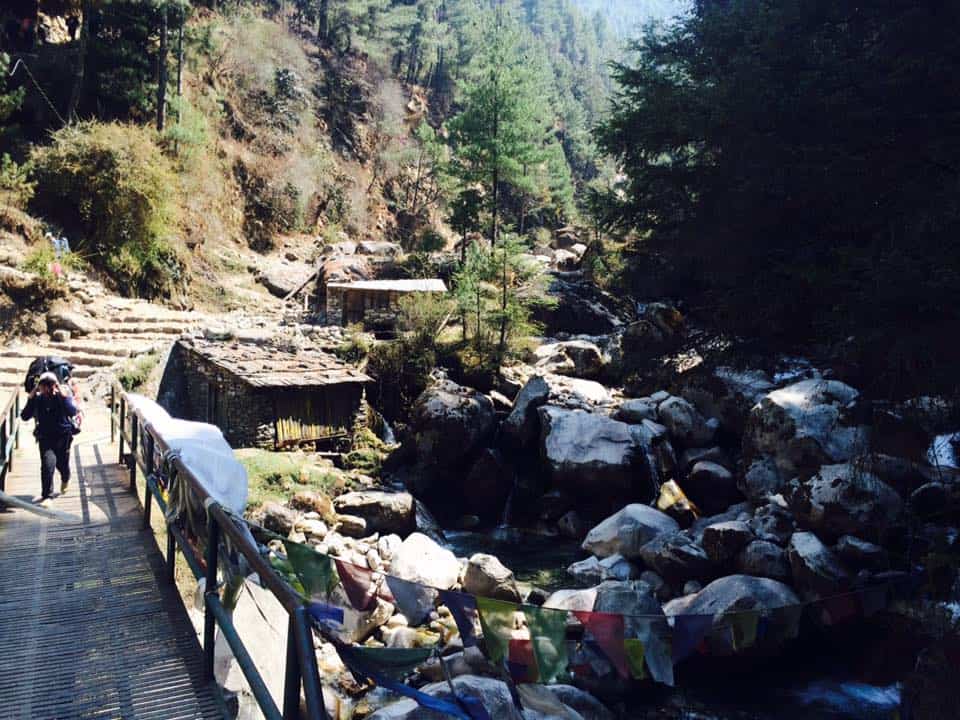
The day was a spent hearing each other’s life stories, trials, triumphs and everything in between. It allowed us to relax with our sore feet and share our stories.
Even though we were all from different backgrounds and cultures, we were seated together, facing the breathtaking Himalayan view, and the shared experiences of our journey wove a sense of unity.
These connections extended beyond Namche Bazaar. Even today, those strangers-turned-friends remain an essential part of my life. Something about experiencing challenges with other humans creates a bond unlike any other!
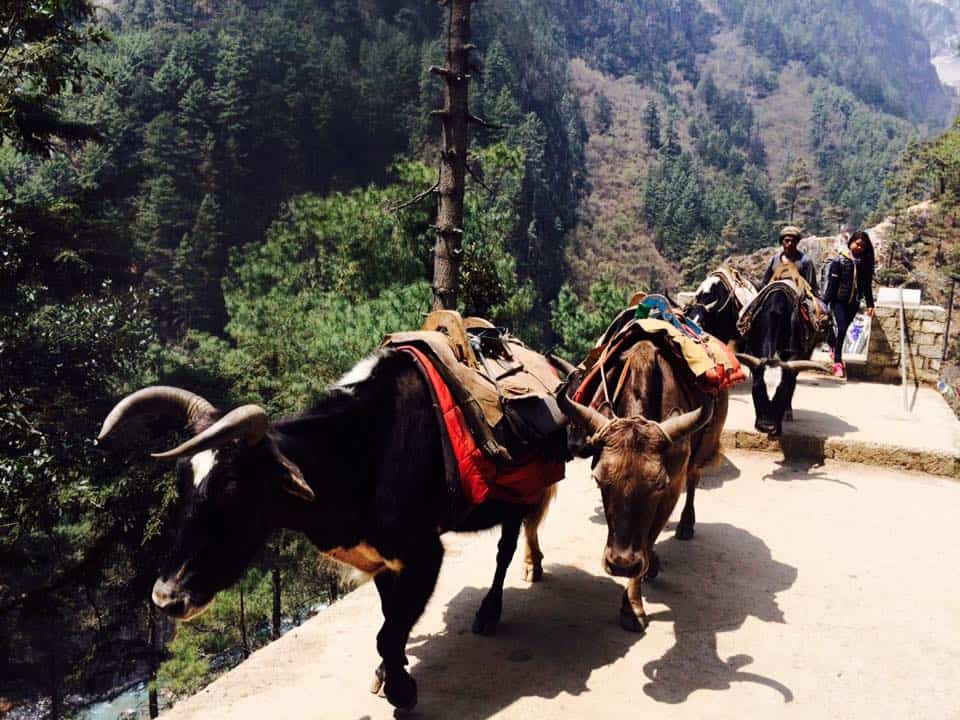
DAY 4: Everest View Hotel & Everest Sunrise
On the fourth day, our journey took a different turn as we started the descent. Going downhill brought a change of pace, letting us reflect on the incredible days behind. If you decide to wrap up your trek here, the descent is smoother, offering time to absorb the landscapes from a new viewpoint.
But hold on – the adventure doesn’t have to end just yet. There’s an optional trek up to the Mount Everest View Hotel, and I strongly recommend you take it.
Trust me; the experience is mind-blowing. Don’t forget to do the extra hike to the viewpoint for your first glimpse of Everest at sunrise – it’s a scene beyond words.
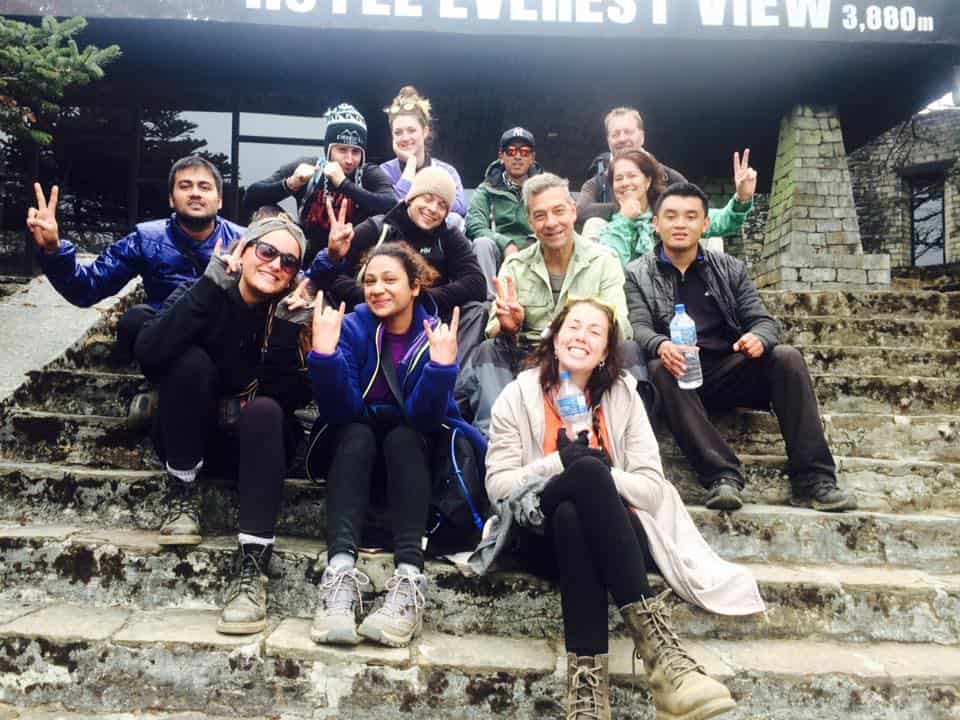
I almost missed out on this because of my sore, blistered feet, a too-early 5 am wake-up call, and the altitude sickness struggle. It felt challenging, but I pushed through. And let me tell you, I’m so glad I did because that sunrise over Everest is now one of the absolute best moments of my life. It’s a lesson in pushing past your comfort zone, bringing rewards you can’t imagine.
So, whether you continue the descent or opt for that extra trek, remember the sunrise over Everest – a breathtaking reward for stepping outside your comfort zone. It’s a memory etched in my journey, reminding me of the incredible payoffs of pushing your limits.
Carrying on to Everest Basecamp from Namche
I concluded my trek at Everest View as only five days were available. However, for those eager to continue the journey to Everest Base Camp, let me provide a glimpse of what lies ahead, including expectations and recommended places to stay.
For those adventurers with the resolve and time to continue beyond Everest View Hotel, the path to Everest Base Camp unfolds with promise and challenges. Here’s a glimpse of what to expect and where to find respite along the way:
Continuing the Ascent:
Embarking on the trail to Everest Base Camp means navigating through rugged terrain and ascending to higher altitudes. As you leave the comforts of Everest View, the trek becomes more physically and mentally demanding. Be prepared for more extended and steeper ascents, but remember, the rewards are equally grand.
Acclimatization at Key Points:
The trail to Everest Base Camp is strategically designed to include acclimatization stops. Places like Tengboche, Dingboche, and Lobuche provide essential breaks to allow your body to adjust to the thinning air. Take advantage of these moments to soak in the stunning surroundings and rest your trek-weary muscles.
Lodging Along the Way:
Accommodations on the trail range from teahouses to lodges, each offering a unique experience. Tengboche, renowned for its monastery, provides a spiritual retreat.
Dingboche’s lodges nestle amidst alpine landscapes, and Lobuche sets the stage for the final push to Everest Base Camp. These accommodations offer shelter and become part of the Himalayan journey’s tapestry.
Challenging Terrain and Thin Air:
The trek beyond Everest View introduces challenging terrain, including rocky paths and steep ascents. The higher altitudes mean the air becomes thinner, demanding a slower pace. Listen to your body, acclimatize well, and savour the journey.
Everest Base Camp:
Reaching Everest Base Camp is a culmination of determination and resilience. Nestled against the Khumbu Glacier, Everest Base Camp offers a surreal experience. The iconic prayer flags and the sight of Everest’s formidable peak create a backdrop for reflection and accomplishment.
Kala Patthar:
Consider the optional side trek to Kala Patthar for an even more panoramic view. At 5643m, this vantage point provides a breathtaking panorama of Everest, Nuptse, and the surrounding peaks. Sunrise or sunset here is a mind-blowing experience.
As you tread higher, every step brings you closer to the world’s highest peak. The Everest Base Camp trek is an odyssey of discovery, challenge, and triumph, with each stop offering a unique perspective of the majestic Himalayas.
For those who embark on this extended journey, the rewards are boundless. I’ll be sure to do it next time I’m in Nepal!
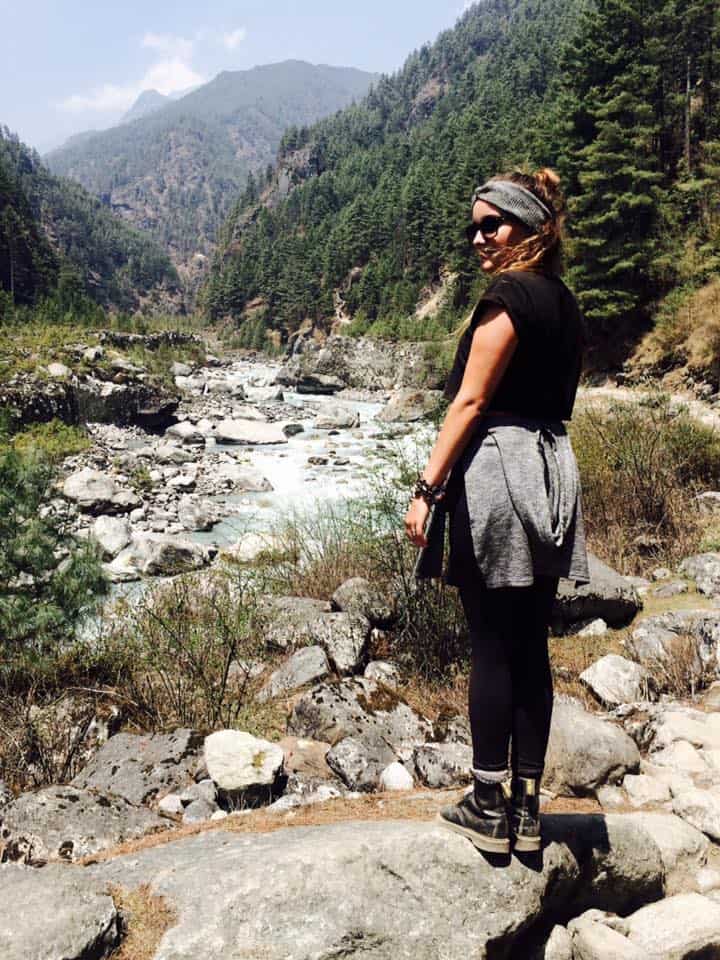
Concluding on the Everest Region Treks
In wrapping up, whether you’re eyeing the Namche trek or gearing up for the Everest Base Camp adventure, there’s one resounding truth – these Himalayan journeys are more than just treks; they’re transformative odysseys. Namche offers a taste of the Everest region’s beauty, an enchanting introduction that leaves you craving more.
On the other hand, the Everest Base Camp trek is the epitome of conquering heights, literally and metaphorically. It’s a symphony of challenges, camaraderie, and breathtaking moments that etch themselves into the canvas of your life.
So, why embark on these treks? The Himalayas beckon not just to challenge your physical limits but to stir something within – a profound connection with nature, a camaraderie born from shared struggles, and a collection of moments that redefine your notion of what’s possible.
If you enjoyed this travel guide, check out our other Asian travel Guides below!
Our Most Popular South East Asia Travel Guides!
Thailand: Epic Thailand Itinerary 1 Month Travel Guide! Unique & Popular Destinations
Cambodia: Ultimate Cambodia Itinerary! The Most Comprehensive Travel Route and Highlights!
Vietnam: The Ultimate 14 Days in Vietnam Guide: Epic Route & Highlights
Laos: Laos’s best-kept secrets: A Complete Guide to Beautiful Laos.
Bali: 3 Weeks in Bali Itinerary: Guide to Authentic & Beautiful Bali
Java: East Java Itinerary: A Complete Guide to the Spectacular Volcanic Island 2024
Nepal: The BEST 3-Week Nepal Itinerary! A Complete Guide
India: The Ultimate 2 Month India Itinerary! – A Spectacular India Guide
RECENT POSTS on Sacred Footprints
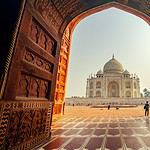
Similar Posts
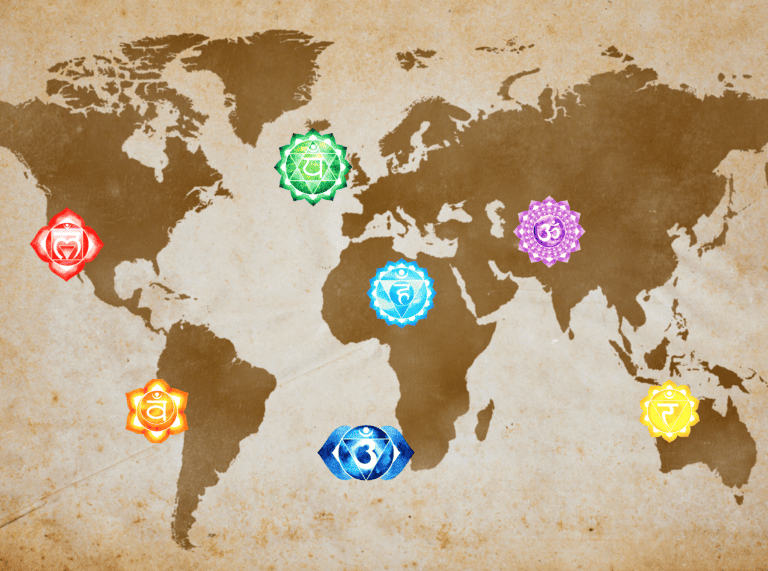
7 Powerful Earth Chakra Locations: How They Link to Our Body!
Where are the 9 famous Earth Chakra locations? Stay tuned to learn more about this incredible spiritual phenomenon! Did you know that in Indian philosophy, many believe seven sacred sites on our planet correlate with the Chakras (powerful energy centre) of the earth? They correlate with the seven main energy centres (chakras) located in every…
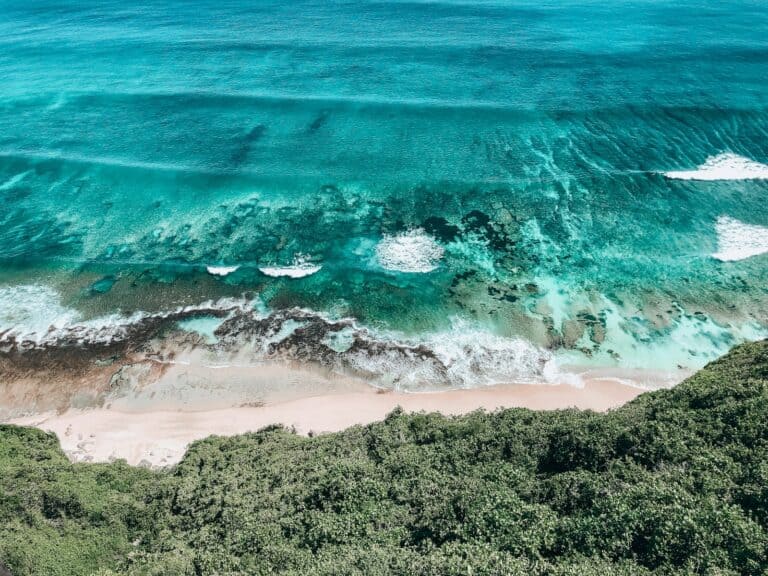
Best Beaches in Uluwatu: A Complete Guide to Bali’s Beautiful Coast
The Beaches in Uluwatu are among the best on the island of Bali! Uluwatu, often refered to as “Ulu”, is a charming bohemian village in southwest Bali. It is known as the surfer’s hot spot in Bali. You can beach hop, eat and drink your days away in the intoxicating laid-back culture here. Situated along…
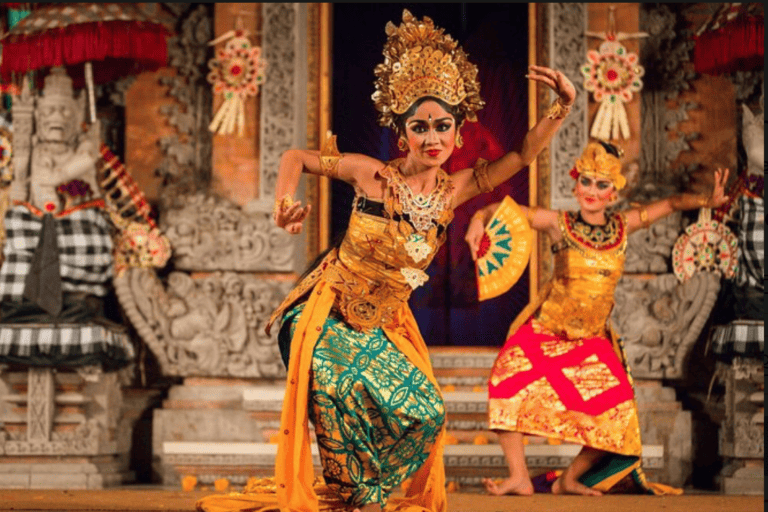
17 Spiritual Things To Do In Bali: Sacred & Beautiful Experiences
Spiritual Things To Do In Bali: Bali is a mystical island with many spiritual things to do and take part in.Bali, Indonesia, is a destination renowned for its breathtaking landscapes, vibrant culture, and deep-rooted spiritual traditions. In Indonesia’s heart, Bali is a paradise for sun-seekers and beach lovers and a haven for spiritual seekers. If…
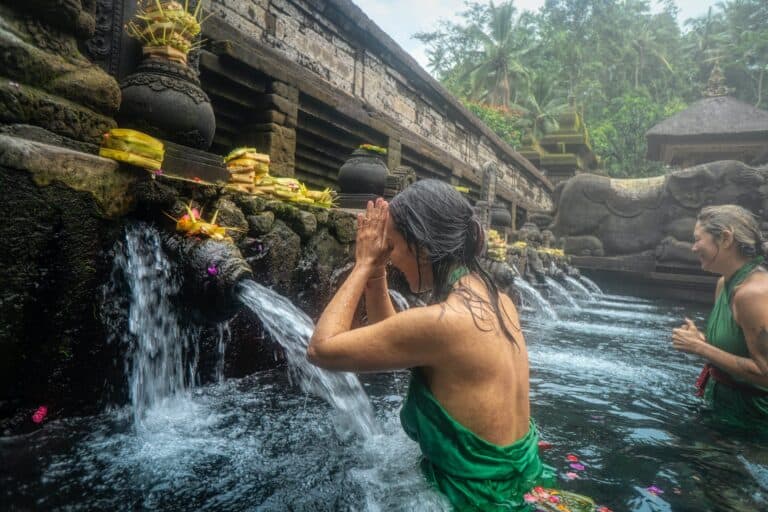
Balinese Spirituality: What is it? Why is it so Unique and Special?
If you have travelled to Bali, you will have noticed that there is something special and unique to the Balinese spirituality and traditions. But what is it? Baleinese spirituality is a vast and profoud (and slightly confusing topic!) So, in this post, I will help you uncover what Balinese spirituality is and why it is…

Laos’s best-kept secrets: A Complete Guide to Beautiful Laos.
Are you wondering where Laos’s best-kept secrets are? Then join us on this journey through Laos, where I share all my top tips, secret destinations, and more. Beyond the beaten (but still beautiful) tracks of Vang Vieng and Luang Prabang, we wanted to get more out of this incredible country, and boy, did it provide!…
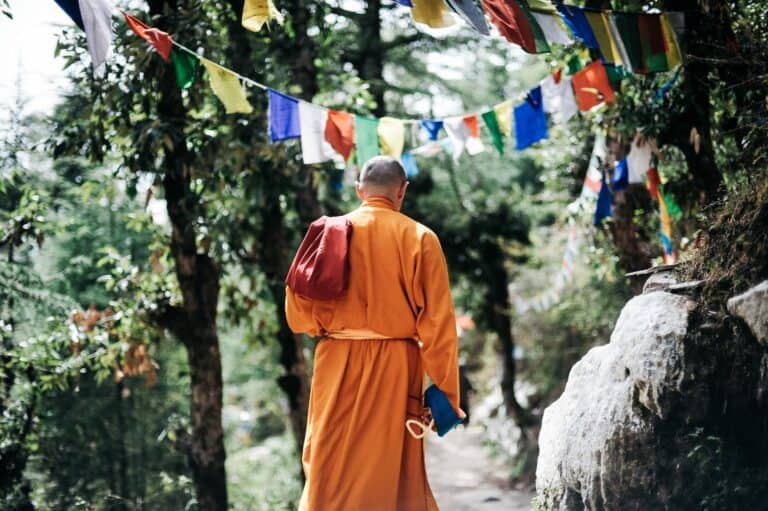
Do the Great SAGES OF SIVARNA Truly Exist? & Where to Find Them.
Sages of Sivarna – From ‘The Monk That Sold Its Ferrari” Hunting for the Sages of Sivarna? Then we have you covered. We have to read the book and asked the same questions… What if I, too, wanted to find the sages and join them? After scanning the book for clues, we have compiled a…

Destinations
Contact info.
- Sacred Footprints Enterprise House Wilmslow, Cheshire
Copyright© 2023 | Sacred FoodPrints | All Rights Reserved.
- [email protected]
- +977 9841161593
- +977 9851149890
- You are here:
- Destinations
- Budget Trek in Nepal
Namche Bazaar Trek 2024-2025
Short and simple way to explore the highest mountain on earth...
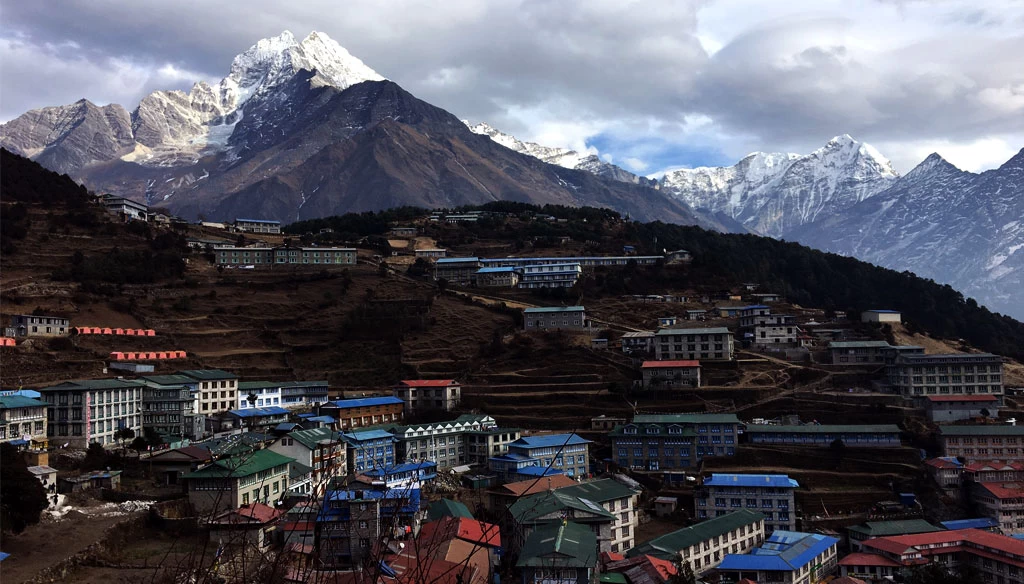
Namche Bazaar is a popular destination in the Everest region and is one of the most popular and demanding trekking trails. This region includes the numerous Himalayas over 8000 meters along with the highest mountain Mt. Everest (8848.86 meters).
Everest region has always been a dream trekking trail for many trekkers, resulting in to increase in the flow of trekkers from time to time. But trekking all the way to the base of Mt. Everest might not be an easy task for many. This can be affected by numerous factors, such as time limitations, physical conditions, high altitude, limited budget, etc.
The popularity of the Everest region will take you on one of the fabulous journeys into the Himalayas of Nepal. Namche Bazaar Trek is not a mere hike but a pious journey into the Everest region in a short time to explore the nature and culture of the Everest region along with Mt. Everest in a limited time frame.
Also known as the ‘gateway to Everest’, Namche Bazaar is the capital of the entire Khumbu region/Everest region , making it a regional headquarters. It is also the highest settlement area of the Sherpa community. Namche itself comes under a UNESCO heritage site , known as the Sagarmatha National Conservation Area.
With numerous gumbas, mani, praying wheels, monasteries, etc. the little town Namche is the only available area where tourist can spend their luxurious stay with standard hotels, bars, restaurants, etc. and an abundance of natural beauty.
This trail will lead you to one of the popular towns of the entire Khumbu region for the magnificent views of the great Himalayan ranges, which include Mt. Everest, Ama Dablam, Mt. Lhotse, Mt. Nuptse, Kongde, Thamserku, Khangtega Peaks, etc.
Trekking to Namche will be an unforgettable journey. It will take you to the highest point of Syangbuche for a jaw-dropping view of the entire Himalayan ranges. So, never miss an opportunity with your friends, family, and relatives to be at one of the most demanding destinations in a short period.
This will be an easy trek with a maximum altitude of 3440 meters for the overnight stay, but a short day hike will take you to Everest View Hotel (3880M) for the fabulous journey, far away from high altitude sickness.
Discover Altitude offers numerous tailor-made packages in the Everest region, which include Everest Base Camp Trek 16 Day , 9 Days Everest Base Camp Trek , Short Everest View Trek , and many more. Trekking packages can be customized according to travelers’ time limitations and budgets.
Highlights of Namche Bazaar Trek
Experience the glorious adventure into the highest region on earth, i.e. the Khumbu region. Namche Bazaar is one of the most desired towns in the entire Khumbu region, inhabited by the Sherpa community. It is also the gateway to Mt. Everest.
Namche Bazaar lies at an altitude of 3440 meters and is an easy trail to explore the wide range of the Himalayas which includes Mt. Everest, Lhotse, Ama Dablam, Thamserku, Kusum Kanguru, etc.
apart from the Himalayas, Namche Bazaar Trek will lead you towards an exotic destination filled with varied vegetation, culture, monastery, gompa, etc., it is a journey of paradise on earth, far away from modern means.
Namche Bazaar Trek will take you to the highest Sherpa settlement area. Their age-old well-preserved culture, customs, and ritual ceremonies will excite any travelers.
Trekking through nature, snow-melted rivers, and crossing suspension bridges with the sound of Himalayan birds will be a soothing journey, and never miss the thrilling short flight to Lukla with the magnificent view of the mighty Himalayas.
How to reach Namche Bazaar
Namche Bazaar is one of the oldest trade towns and also the capital headquarters of the entire Khumbu region and is also the gateway to Mt. Everest and also the other popular Himalayas of the Everest region.
Namche Bazaar which lies at an altitude of 3440 meters is one of the popular acclimatization camps for trekkers, where trekkers mainly spend 2 nights ascending Everest and one- night descending Lukla.
For a short trek into the Everest region, Namche Bazaar provides mesmerizing views of the wide ranges of the Himalayas, which includes Mt. Everest.
The easiest and the most popular route to reach Namche Bazaar is to take a short 30-minute flight from Kathmandu to Lukla and then further hike through Phakding to Namche, which will take 2-days, or can take a chopper from Kathmandu to Namche.
Best time to hike Namche Bazaar
Trekking to the Himalayas of Nepal is always a joyful adventure toward a peaceful destination, and Namche is not an acceptance. Namche Bazaar also popularly known as Namche is one of the most well-developed and busy trade centers in the entire Khumbu region of Nepal, it is the headquarters of the Himalayas as well with all the modern facilities available.
Namche Bazaar lies at an altitude of 3440 meters and is the acclimatization place for all trekkers and climbers. This makes Namche an easy trekking destination for all trekkers irrespective of age and gender.
Namche is also a popular spot to explore a wide range of the Himalayas including Mt. Everest, Lhotse, Ama Dablam, etc. Hikers can spend a couple of days exploring the surrounding villages and hills surrounding the Namche Bazaar.
Namche can be hiked throughout the year except for the monsoon season, which is June and July. This time of the year is regarded as a monsoon in Nepal with heavy rains in the lowland areas but in the high altitudes like Namche we can experience fewer showers of rain but the clouds cover the Himalayas making the visibility very less.
Overall, to conclude Namche trek can be accomplished in the best and easiest way during the Spring season (March-May), Autumn (September-November), Winter (December-February), and Summer (May-August) but June and July receive a sufficient amount of rainfall.
Kathmandu to Namche Bazaar Trek Distance
Kathmandu to Namche Bazaar Trek starts with a short flight to Lukla, one of the most exciting journeys between the Himalayas of Nepal. In this 30-minute flight, you will be able to explore the Himalayas, valleys, villages, and beautiful farmland.
Upon landing at the Lukla airport, you can enjoy a cup of tea/coffee and hike further towards your first overnight destination, which will be Phakding. This will be an easy hike with short ups and downs through the river in between the forest. Crossing some Sherpa villages, you will be at Phakding for your first overnight stay.
On the very next day, your hike starts with an inclined climb uphill toward Namche. This will be through the rocky trail, crossing the suspension bridge over the Dudh Koshi River to reach Monjo.
Further passing by the rhododendron forest you will reach the entry point of Sagarmatha National Conservation Area for documentation. With a steady climb with a view of the Himalayas, you will be at Namche Bazaar early afternoon.
You will have sufficient time to explore the old and exotic villages of the Khumbu region. The very next day you take a splendid journey towards the Everest view hotel for the fabulous view of the mighty Himalayas.
This will be a tour day, so you can manage some time to visit the surrounding villages of the Sherpa settlement before descending towards Namche for the overnight stay.
And finally, on the third day, you will descend to Lukla through the same trail for our overnight stay. And the very next day you will take an early flight to Kathmandu.
Altitude Chart of the entire Namche Bazaar Trek
- Kathmandu 1,350M/4,429Ft
- Lukla 2,840M/9318Ft
- Phakding 2,610M/8,563Ft
- Namche Bazaar 3,440M/11,306Ft
- Everest View Hotel 3,880M/12,730Ft
Lukla to Namche Bazaar Trek Distance
Lukla (2840M) to Namche Bazaar (3440M) is just an 18 km distance ascending uphill.
This is a two-day trekking trail, taking you through cascading waterfalls, snow-melted rivers, Sherpa villages, a Suspension bridge, a praying flag, etc to enter Sagarmatha National Conservation Area.
Landing at Lukla which is the only domestic airport in the entire Khumbu region is a busy airport. Every day early in the morning from 6:30 AM-11:00 AM there is a regular flight to and from Lukla (depending upon the weather).
As you land at Lukla (2840M), you will hike through the forest, village, and riverside to reach Phakding (2610M) for the first overnight stay, covering a distance of 7 KM.
The next day your journey starts through the conservation area of the Khumbu region. This will be a strenuous uphill climb to reach Namche Bazaar.
During the spring season, the forest blooms with magnificent rhododendron flowers of the mountain till Namche Bazaar. Namche Bazaar lies at an altitude of 3440M and is around 11 KM from Phakding. Thus, the Lukla to Namche Bazaar distance is 18 KM.
Namche is a popular overnight camp for trekkers, you will spend 3-night altogether in Namche, 2-night while ascending, and a night while descending.
This helps trekkers to acclimatize themselves, as there are numerous hiking hills around Namche. Among those, Everest View Hotel is one, which lies at an altitude of 3880M, with magnificent views of hills, villages far away, and the Himalayas including Everest, Ama Dablam, Thamserku, Lhotse, etc.
Namche Bazaar Trek Difficulty
Namche Bazaar Trek is an easy-going trail to reach the highest altitude of 3880M. This is just a 3-day trek from Kathmandu to Kathmandu. However, to make the hike to Namche Bazaar memorable, trekkers prefer to spend a night extra at Namche to explore the Himalayas, Sherpa culture, and the village.
Landing at Lukla Airport after a 25-minute flight, you will have a sufficient amount of time to explore the Lukla village and acclimatize herein. This will help your body to cope with the altitude.
After a short interval, the trail will descend towards Phakding or Monjo through the forest and villages. This will be around 4-5 hours of easy hike.
The very next day’s hike will be an important trial. Although the trail is well maintained, your hike will be uphill to the altitude of 3440M. hiking through the forest, passing by the suspension bridge over the DudhKoshi River.
With the Himalayan flowers, mainly rhododendrons, you will reach the Sagarmatha National Conservation Area entry point, a UNESCO Natural Heritage Site. Further hiking with the view of the Himalayas, Namche Bazaar will be at first hand.
The very next day you will be hiking toward Everest View Hotel at an altitude of 3880M. this will be uphill but through the favorable trail for the magnificent view of the Himalayas including Mt. Everest.
This hill point is the best destination to explore the Himalayas, after some tea/coffee with a magnificent view, you will descend towards Namche, exploring the Sherpa village.
The afternoon will be free time to explore Namche Bazaar one of the most popular towns in the entire Everest region.
Finally, the last day will be a descending hike from Namche Bazaar to Lukla through the same trail you did while going uphill, and on the final day take an early morning flight to Kathmandu.
Overall, to sum up, trekking into Namche Bazaar is a relaxing trail in an easy way. Trekking to Namche Bazaadoes not require any prior experience, this can be done by any age group or gender.
Namche Bazaar to Everest Base Camp Trek Distance
Everest Base Camp Trek is a 130 KM round trip from Lukla-Everest Base Camp-Lukla. Thus one way from Lukla to Everest Base Camp is 65 KM, and ascending all the way to Everest Base Camp will be 8 days. These 8 days include two nights of acclimatization, one night in Namche and one in Dingboche as extra to acclimatize yourself before heading to a higher altitude above 5000+ meters.
From Namche Bazaar, you will be stopping in 4 different Sherpa villages to reach Everest Base Camp and the last overnight lodge will be at Gorakshep (5140M). This will be around 42 KM from Namche Bazaar to Gorakshep and a further 5 KM to Everest Base Camp.
From Gorakshep, you will have a day tour to Everest Base Camp, which is just a 5 KM distance and will take around 2 hours. The next day, hike early in the morning to Kalapatthar for a sunrise view and descend downhill all the way to Lukla. This descent will take 3 days to cover 65 Km.
Ascending Uphill takes longer due to the high altitude and have to do so because you have to acclimatize your body accordingly for the success of the entire trip.
What to Expect
Namche Bazaar Trek is one of the easiest treks in the Everest Region that will take you to the highest altitude of 3440 Meters. Namche Bazaar is the official headquarters of the entire Everest region and is also the center of the trade hub for the people.
Namche Bazaar is a popular destination for trekkers to acclimatize before ascending higher and is the gateway to Everest Base Camp. Trekkers can easily reach Namche through Lukla within two days and explore the highest mountain range, Sherpa culture, monastery, etc while being in Nepal for a short vacation.
The trail to Namche will be one of the best, passing through the forest and Sherpa villages. Moreover, throughout the hike, you will be able to have magnificent views of nature and the high Himalayas including Mount Everest.
Crossing the suspension bridge over the Dudh Koshi River and hiking through the alpine forest will be the best experience.
There will be a number of lodges and tea houses ranging from basic to standard with a common attached toilet within the room, all the lodges will have electricity facilities and WiFi access. This will help you to be in touch with your family and friends.
As Namche Bazaar Trek is a low-altitude trek, this is the best for any age group. Spending two nights at Namche Bazaar will help you to explore the Kyangjuma village, Namche village, and Everest View Hotel. The very next day, you can explore all the popular Sherpa villages and reach at an altitude of 3880 Meters for a day hike before descending to Namche.
Evening explores the typical Namche Bazaar and spend some time in the popular bar and snooker house and the very next day descend to Lukla. This will help you to explore the most popular and the highest existing region on earth in just 4 days.
Trail Passing Through Namche Bazaar
Namche Bazaar is the gateway to the entire Everest Region and is the capital and official headquarters as well. Trekkers spend at least three nights in Namche Bazaar for the regular trekking to any part above the Namche Bazaar Trek.
This is the best place for acclimatization while ascending toward the Himalayas. Blessed with numerous facilities, this little town is the business hub for the local Sherpa community and also is the last stop for trekkers to buy their necessary gear.
Thus, while trekking into the Everest Region, you can divert the trail into numerous popular areas of the Everest region for trekking or climbing depending upon your time frame and interest, as this trek can be easily customized.
Following are the POPULAR TREKKING TRAILS that pass through the NAMCHE BAZAAR:
Everest Base Camp Trek (5364Meter)
Gokyo Lake and Gokyo Ri Trek (5357Meter)
Three Pass Trek (Kongma La Pass 5535Meter, Cho La Pass 5368Meter, Renjo La Pass 5360Meter)
Ama Dablam Trek (4600Meter)
Kalapatthar Trek (5545Meter)
Island Peak Trek (6160Meter)
Ama Dablam Expedition (6812Meter)
Mount Everest Expedition (8848.86Meter)
For more information contact: Discover Altitude or WhatsApp: at +977-9841161593
OTHER ALTERNATIVE BEST WAYS TO TREK NAMCHE BAZAAR:
Namche bazaar trek itinerary with helicopter return.
This can be a Combo Pack for those who lack long holidays and are desperate to explore the Everest Base Camp along with the Majestic Himalayas. One can easily and in a relaxing way trek to the Namche Bazaar and take a Helicopter Ride to Everest Base Camp (5364M), Kalapatthar (5545M), Khumbu Glacier, Gokyo Lake, etc., and fly back to Kathmandu or Namche Bazaar or Lukla.
Day 1: Flight to Lukla 2840M and Trek to Phakding 2610M or Monjo 2832M
Day 2: Trek to Namche Bazaar 3440M
Day 3: Exploration Day - Hike to Everest View Hotel 3880M
Day 4: Fly over Everest Base Camp and Kalapatthar and Helicopter Fly back to Kathmandu.
Namche Bazaar Trekking Itinerary for Senior Citizen
If you are worried about your age factor or are a first-time trekker. This itinerary will definitely be one of the best options with just a 4-hour hike every day , carefully designed keeping the Senior Citizen on the priority list.
However, there is the option for trekkers to take a Helicopter towards the Everest Base Camp (5364M) and Kalapatthar (5545M) and descend directly towards Kathmandu or Lukla. This will minimize your number of days and you can skip the same way descend towards Lukla.
Day 1: Flight to Lukla 2840M and Trek to Phakding 2610M
Day 2: Short Trek to Monjo 2832M
Day 3: Ascend to Namche Bazaar 3440M
Day 4: Exploration Day - Hike to Everest View Hotel 3880M
Day 5: Descend to Phakding Village 2610M
Day 6: Easy Hike to Lukla Village 2840M
Day 7: Flight to Kathmandu (1350M) drive to your hotel.
If this Itienary does'nt fits your interest, please feel free to contact us. We will redesign accordingly.
Customize or Contact us if you have any special requirements +977 9851149890 WhatsApp
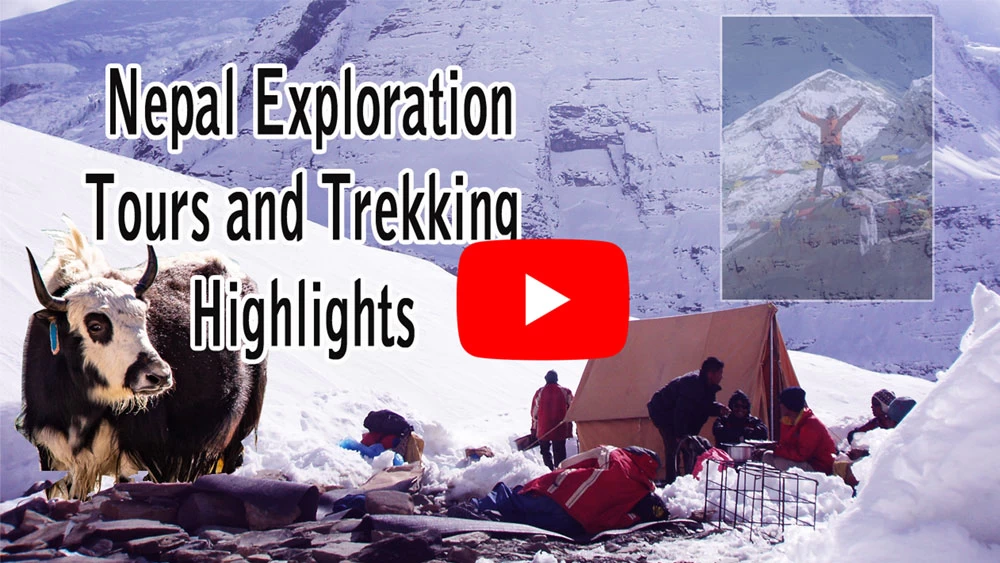
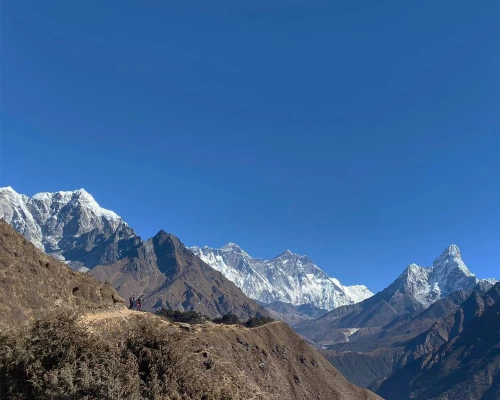
If the following itinerary doesn't match your interest, to customize it, please feel free to contact us: WhatsApp: +977-9841161593 or Email: [email protected]
Day 1: Arrival Kathmandu
- Accommodation Not Provided
- Meals Not Included
- Time 25-Minute (Free Airport Pickup)
- Maximum Altitude 1350m/4429ft
This will be your first day in Nepal, On arrival at Kathmandu International Airport, a representative from Discover Altitude will welcome you and escort you to your respective hotel.
Day 2: Kathmandu to Lukla Flight (2840m/9318ft) and hike to Phakding (2610m/8563ft)- 4 hours.
- Accommodation Lodge
- Time 4 Hours
- Maximum Altitude 2610m/8563ft
Today will be our early day, we will drive to the domestic terminal of the airport to take the first flight to Lukla. This will be a stunning flight in between the mountains with a splendid view of the hills and Himalayas before we land at Lukla airport.
Enjoying a cup of tea/coffee at the nearby hotel in Lukla, our real hike in the Himalayas begins. This short break will help our body to acclimatize. The trail will be easy going for the first day, as we will pass by villages, farmland, rivers, and varied vegetation.
The trail goes descending towards Chauri Kharka, before crossing a small snow-melted stream. We will then pass by large mani-walls related to Buddhism before descending toward the small Sherpa village of ThadoKosi.
Climbing a bit higher we will reach Ghat, the trail will then take us through the tranquil forest until we reach a small settlement of Phakding.
Overnight in Phakding
Day 3: Hike to Namche Bazaar (3440m/11286ft)- 7 hours.
- Time 7 Hours
- Maximum Altitude 3440m/11286ft
Passing by Phakding, we will hike through the deep forest with different flora and fauna. This will lead us towards Monjo, a popular overnight camp, mainly operated by the Sherpa community.
Crossing Monjo, one can experience the majestic Himalayas view throughout the trail. Ascending uphill, we will be towards the main entrance gate of Sagarmatha National Park, this is a UNESCO-listed natural heritage site of the Himalayas.
Further, with a steep climb uphill with a majestic view of the Himalayas including Mt. Everest we will be at Namche Bazaar, the official headquarters of the entire Khumbu region.
Overnight in Namche
Day 4: Explore Namche and hike to Shyangboche (3880m/12730ft)- 5 hours.
- Time 5 Hours
Namche is one of the most popular towns in the entire Khumbu region and also the trade hub for the local Sherpa community of the Himalayas. Namche although being at such an altitude is filled with beautiful restaurants, pubs, hotels, lodges, banks, ATMs, hospitals, Snooker houses, etc.
Apart from all this Namche is also the main acclimatization spot for the trekkers heading into Everest Base Camp. Normally trekkers spend 3 nights in Namche bazaar, 2 nights while ascending, and 1 night while descending towards Lukla.
Today, we will explore the entire Namche Bazaar and further hike uphill towards Everest View Hotel (3880m) for the magnificent Himalayan view of the entire Khumbu region. This will be around a 3-4 hours hike both ways.
Everest View Hotel in the Syangbuche is one of the popular star-category hotels in the Himalayas of Nepal and also the highest-placed hotel at such an altitude.
Trekkers can spend hours with the majestic view of the numerous Himalayas including Mt. Everest just standing unmoved.
If interested we can visit Khumjung village of Sherpa community before descending back to Namche for our overnight stay.
Day 5: Descend to Lukla. (2840m/9318ft)- 7 hours.
- Maximum Altitude 2840m/9318ft
Today will be our easy day, as we will be descending all the way towards Lukla. This will be through the same trail which we followed while ascending uphill.
Passing by the Sagarmatha National Park, we will descend towards Monjo through pine and rhododendron forests. The trail will be through natural vegetation, we will cross a suspension bridge over the Dudh Koshi River to descend Phakding.
After our lunch in Phakding, we will pass by numerous Sherpa villages to reach Lukla.
Overnight in Lukla
Day 6: Fly back to Kathmandu (1350M/4429Ft)- 5 hours.
- Time 35-Minute
- Maximum Altitude 1350M/4429Ft
This will be our last day in the Himalayas of Nepal, after our breakfast, we will take our flight back to Kathmandu. This will be a short flight of around 30 minutes. Bidding farewell to all the hills and the Himalayas of the Khumbu region through the window panel of our flight we will finally arrive in Kathmandu.
A representative from Discover Altitude will escort you all the way from the airport to your respective hotel.
Day 7: Final Departure
- Accommodation Free Airport Transfer
- Time 25-Minute (Free Airport Drop)
This will be your final day in Nepal, a representative from Discover Altitude will escort you to the international airport in Kathmandu at your scheduled time for your safe flight back home.
We hope your journey to the Himalayas of Nepal was awesome and mesmerizing. Hope to see you in the coming days.
- Download PDF
Not happy with this regular itinerary?
Rearrange according to your timeframe.
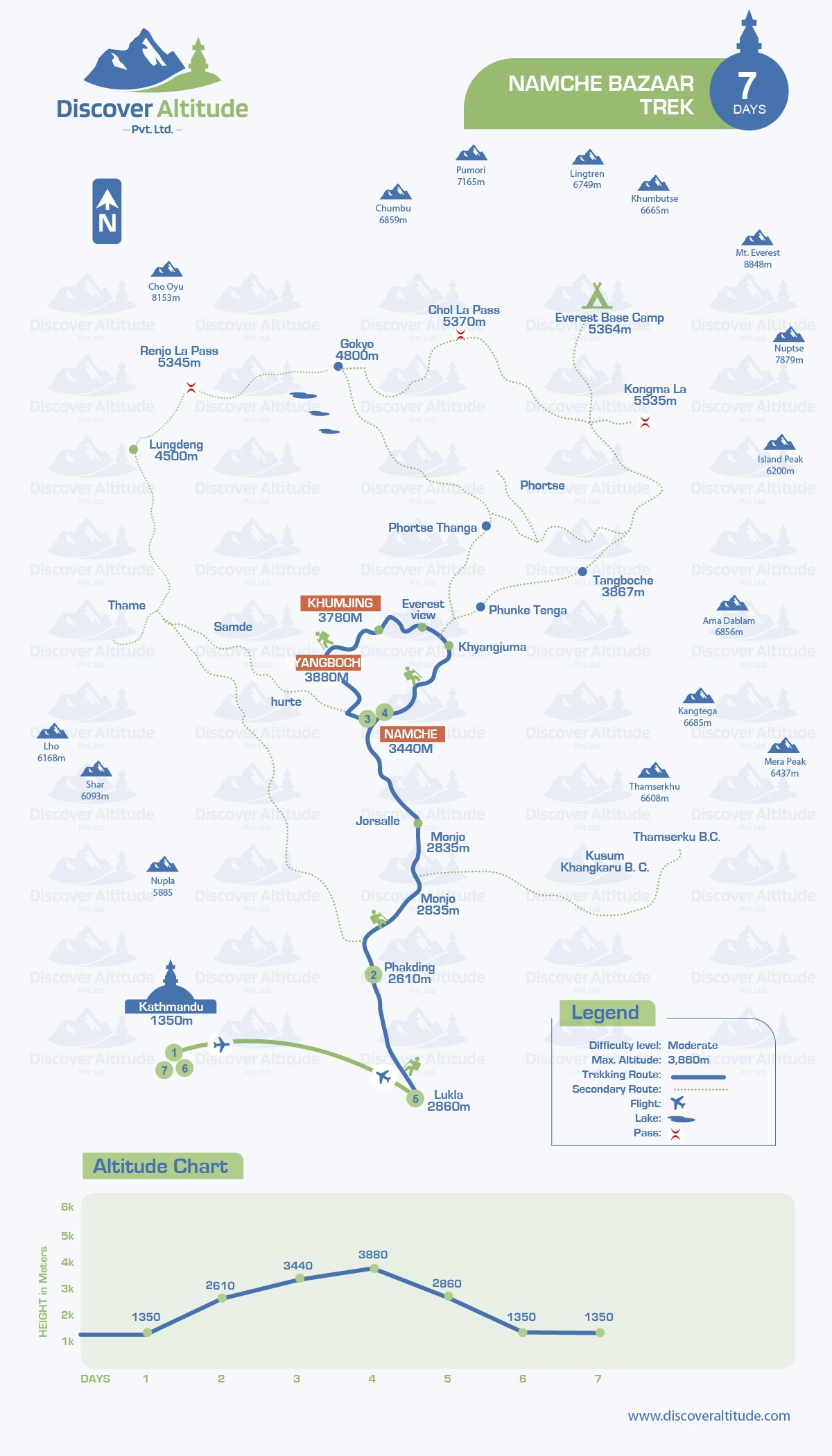
Cost Details
Airport pickup and drop-off service (private).
- International Arrival Pickup
- Domestic Airport Drop on the Day of the Trek
- Domestic Airport Pick Up and transfer to your Hotel after the Trek
- International Airport Drop-Off on the Final Day
Domestic Flights Service
- Kathmandu to Lukla Flight Ticket
- Lukla to Kathmandu Flight Ticket
Accommodation During the Trek
- 4-Night Accommodation in a Lodge during the Trek
Guide During the Trek and Our Liability
- Experienced Government-Registered Trekking Guide
- All Meals of Guide
- Insurance of Guide
- Allowance of Guide as per Government Rules
- First-Aid Medical Kit Carried by our Team.
Trekking Permits
- Sagarmatha National Park Permtis
- Pasang Lhamnu VDC Permits (Local Permit)
- TIMS Permits
Our Supplementary Services for Trekkers
- Duffle Bag During the Trek
- Trekking Pole During the Trek
- Water Purification Tablet/Liquid
- Sleeping bag ( Can be arranged)
- Trip Achivement Certificate
- All Government Taxes and Service Charges
- Hotel in Kathmandu
- Your lunch and dinner in Kathmandu.
- Meals during the trek (Breakfast, Lunch, and Dinner).
- Hot shower, Hot water, WiFi, phone call, charging electronic equipment during the trek only (unless it is free)
- Extra night accommodation during the trek or in Kathmandu (in case the itinerary becomes longer due to unpredictable circumstances)
- Personal expenses (shopping, snacks, bottled water, hot water, cold drinks, souvenirs,s, etc)
- Tips and gratitude to your guide.
Risk free booking & Free Cancellation.
Add-Ons Options help our travelers to Upgrade their trip according to their fancy:
Hotel in Kathmandu:
Stay in a comfortable 3-star Hotel in Kathmandu on a BB Basis for just USD 35 Per Person.
Hire a Porter for the Trek:
Need a Porter to carry your Backpack during the trek, if so pay daily of USD 20
Dates & Price
If not match above fixed departure dates, feels free to request your own date.
Trip Reviews
Discover altitude is the best.
Discover Altitude is the best trekking guide / tour operator in Nepal. Two days ago my friend and I reached Everest Base Camp on May 4th (trekking day 8). On day 9, helicopter picked us up at Gorakshep - last tea house before EBC. Helicopter transported us back to Kathmandu via Lukla — 2.5 hour stop for refueling and other logistics. Hiking back down 3 extra days is not for everyone. Reaching EBC was a small miracle for me. I was the biggest person (XXL) trekking. I trained for over a year… lost significant amount of weight to even attempt EBC. Everything had to go perfectly and it did. Planning was key. Some days were incredibly challenging and required very-very slow / steady pace. At every step my guide was right there to support as needed. On some hills my guide was 12 inches behind me in case I lost balance from exhaustion. We were blessed to have Amar as our guide and his younger brother, Shukla, as porter. They did everything for us … from finding bathrooms, ordering meals, dealing with hotels, first aid, and fun to talk with too. Multiple times during the trek other guides whispered to us that Amar is one of the best guides in the region. We opted for the luxury tour with nicer hotels + helicopter ride to Lukla to start + helicopter return from the top. Paying extra for luxury tour is worth every penny. We met some hikers not having a good experience. Painfully obvious they chose the wrong guide / tour operator. If you are in perfect shape and you’ve trekked Nepal many times before- maybe having the best guide isn’t as critical. But for us we relied on our guides for every decision … even down to what to eat and drink at different altitudes. TIPS: 1- take diamox right from the start (1 day before starting the trek) 2- take helicopter to/from Lukla. If you don’t take helicopter, be prepared to sit around for days waiting on weather to clear for airplane flight. People stuck at the airport waiting multiple days to get out aren’t having a good time. 3- go vegetarian. You’ll love ra-ra noodle vegetable soup 4- bring tons of electrolyte packets and drink 5 liters/day 5- pack for very cold days at the end (EBC). Both outer-wear gear and warm jackets for nights at the hotel. Be prepared for extremely dry air at night. Bring nasal spray to help breath through your nose. 6- get plenty NPR cash in Lukla or Kathmandu. In a pinch, tea house hotels can run your CC to give you NPR cash… will cost 10% extra charge. 7- tip your guides as generously as you can 8- don’t bring huge camera unless you are ok lugging the extra weight. Newer iPhone or Android do fantastic job. 9- go slow. Don’t skip rest (acclimatizing) days. 10- Book your trip with Discover Altitude. Kumar will email you immediately with details to help you customize your trip. He will work through every question / idea with patience. We had at least a dozen unusual requests including special activities in Kathmandu after the trek. Kumar and our guides made them all happen. Remember to request booking at nicer hotels. 11- go with friend or family you really enjoy being with for two weeks. Having someone to motivate you and just hang out together makes the trip so much better. 12- day 2 to Namche might be your hardest day, particularly after Hillary Bridge… 1-2 hours straight uphill at the end. Don’t give up. Go slow and ask for help (horse available if can’t make it up that hill).

James T , United States
Awesome 10 day ebc trekking experience.
I’m towards the tail end of my 10 day EBC trek arranged by Discover Altitude. Overall, I’ve been very happy with the trip so far. Santosh did his best to make sure my trip went according to plan. He was also extremely accommodating to my request for alterations to itinerary during the trip. Always ready to help, no questions asked. I also wanted to take this opportunity to thank my guide, Sandip Lama. He is an energetic and hardworking young man that went above and beyond to make me trip as comfortable as possible. He’s also flexible in accommodating my last minute change request. For example, when I saw Ama Dablam for the first time, I was blown by its beauty and came up with the idea of doing a side trip to its base camp. It’s require at least half a days time. Sandip agreed without any hesitation and helped with the trip planning. In the end, the side trip didn’t happen simply because I ran out of steam. As a guide, Sandip’s main responsibility is leading me with the trip. But he also offered to carry my bag when I got very tired. This is what I call above and beyond. Again, thank you Sandip and I hope we’ll embark on my adventures in the future!
Hongtao Chen , United States
Great experience in kathmandu.
Kumar was so helpful from the moment I was introduced to him. He listened intently so he could work out the best tour based on our discussion. He was open, transparent, and always prompt to reply to my many messages. He went over and above his call of duty as my visa had expired and without hesitation assisted me in ensuring it was all sorted. He is extremely knowledgeable and was happy to share his knowledge if you make it known to him just how keen you are to hear stories. I would highly recommend Kumar and his team and feel like this review will be sufficient to not have to look any further as he is one of the best you'll ever find in Kathmandu.
Balance for Life Corporate Retreats , Australia
Unforgettable experience in beautiful mountains.
This was my first trek in Nepal and it was truly amazing. The trip was very well organized, our guide Thakur was very friendly and always selected great places for rest and food. Our porter Chandra was very helpful and always in the good mood, although he needed to carry a lot more than we did. The surrounding of Manaslu is amazing piece of nature full of wild animals, beautiful plants, breathtaking views and nice locals in the villages. Also the journey to the start of the trek by local transport was unforgettable experience. I would recommend this tour to all trekkers, who are looking for great adventure in beautiful mountains and don't want to share the track with crowds as it could happen at the better known treks around Everest or Annapurna. You should be ready to step out of the comfort zone for few moments - yes, few ascents were challenging due to high altitude and it was very cold one night we spent at Dharmasala - the last village before Larkey Pass. After our comeback to Kathmandu we had very nice lunch with Kumar and Santosh - the guys from Discover Altitude who told us many interesting facts about life in Nepal. All in all it was one of the best experiences in my life and in few years I will definitely come back to Nepal and go for another trek with Discover Altitude.
Martin , Czech Republic
Fabulous tour & excellent organisation..
I have just completed a private six day tour with three of my Australian girlfriends through Discover Altitude. Dealing with Kumar right from my initial contact has been seamless, communication & planning was excellent. The entire Discover Altitude team gave us an unforgettable holiday & it couldn't have been planned better, fitting in all of our wish list, with Kumar adding rafting on the Trishuli River, a homestay in beautiful Bandipur, hiking to Ramkot, visiting Nagrakot, and a personal tour of Kathmandu by Kumar. One highlight was a cooking class at Sungabha (formerly Seven Sisters), what a worthwhile organisation & an unforgettable afternoon, and thank you Santosh for taking such great photos! We also enjoyed our hike from Telkot to Changunarayan village with Kumar, fabulous day. Our very safe & considerate driver for the entire trip was brilliant. It was a dream holiday & we can't thank Kumar & his team enough for giving us a holiday of a lifetime!
Leanne C , Australia
Fabulous day with fantastic guide kumar.
Great tour with fantastic guide Kumar! We did a full day Bhaktapur trip and then Nagarkot hike. Kumal was an awesome guide, he had so many stories to share and answered our many many questions. The hike to Nagarkot was nice, unfortunately the view of the Himalayas was obstructed by clouds but a nice easy walk through some forest and then along a paved road through Nepalese villages. A great trip!
Amy , Australia
Everest base camp trek with helicopter return..
Unbelievable trip. Extremely well organised from airport pick up to drop off. The entire team - Kumar, Santosh, Amar and our porter took great care of us from preparation before the trip to purchasing the odd forgotten piece of kit in Kathmandu and then the trek itself. Amar our guide and our porter were very attentive the entire trek and were a pleasure to spend time with. Amar taught us about Nepalese/sherpa/tibeten culture and gave us an explanation of each location. Everyone on the trek felt very safe and well looked after. I also highly recommend the chopper flight back. Once in a lifetime thing to experience. After we returned to Kathmandu I booked two more day tours with Kumar who personally acted as our guide and gave us fantastic explanations of each location and of Kathmandu’s history and culture. Will definitely be using this company again, next time we visit Nepal.
Tim D , United Kingdom
Amazing tour company.
My husband and I did a number of day tours with Discover Altitude. Kumal, our guide was amazing. He is so knowledgeable and makes his tours so interesting. He was very helpful and tailored the tours to ensure we had the best experience. Our driver Ram, was also excellent. I highly recommend Kumal and his company if you are visiting Nepal. Thanks so much for making our visit so memorable. I hope to see you again.
kim h , Australia
Q1. can we see mt. everest from namche bazaar.
Yes, we do. Namche Bazaar is the first place to explore the wide range of the Himalayas including Mt. Everest. Apart from Namche Bazaar, trekkers can hike up to Everest View Hotel which is in Syangbuche to explore the majestic view of the Himalayas from close range.
Q2. What is the altitude of Namche Bazaar?
Namche Bazaar which is in the Khumbu region of Nepal lies at an altitude of 3446 meters. It is the capital town of the entire Khumbu region with government officials, Police check-post, Army barrack, Bank, ATM’s, Post office, hospital, luxurious hotels, bars, restaurants, etc. Namche is the largest Sherpa community settlement area as well.
Q3. What will be the highest altitude of Namche Bazaar Trek?
There will be two different altitudes during Namche Bazaar Trek. The first will be Namche Bazaar, which is 3446 meters. This will be the highest overnight camp for trekkers. Apart from this, on the very next day, trekkers will spend a day extra to explore the surrounding villages of Namche and will further hike to Everest View Hotel which lies at an altitude of 3880 meters.
This will be a day hike to explore a wide range of the Himalayas including Mt. Everest from a close range and further descend towards Namche for an overnight stay.
Q4. Can we explore in and around Namche Bazaar?
During Namche Bazaar Trek, trekkers will have an extra day to explore in and around Namche Bazaar, visit the different monasteries, gompas and also visit Sherpa villages. Further, you will be visiting Everest View Hotel in Syangbuche 3880 meters to have magnificent views of the wide ranges of the Himalayas including Mt. Everest from a closer range.
Q5. Is Namche Bazaar in the Khumbu region?
Namche Bazaar is one of the oldest settlement areas of the entire Khumbu region. It is also the largest Sherpa settlement area. Namche Bazaar is the official headquarters of the Khumbu region as well.
Q6. How difficult is Namche Bazaar trek?
Namche Bazaar Trek is one of the easiest treks of the entire Khumbu region. It is just a 2- days trek from Kathmandu. The trail to Namche Bazaar is easy-going into the Sagarmatha national conservation area to explore the ancient and the largest Sherpa settlement areas in the entire Khumbu region.
Q7. How long does it take to reach Namche Bazaar from Kathmandu?
Namche Bazaar is just a two-day hike from Kathmandu. Trekkers take a short flight from Kathmandu to Lukla and hike to Phakding on the same day and on the very next day they will hike towards Namche Bazaar through Sagarmatha National Conservation Area, which is also the UNESCO heritage site.
Q8. Is there any danger of altitude sickness in Namche Bazaar Trek?
Namche Bazaar Trek is a short trek into the Khumbu region to explore the majestic Himalayas including Mt. Everest. This trek is mixed with the nature and exotic culture of the Sherpa community. The trek will lead us to the highest altitude of 3446 meters which is Namche Bazaar.
On our very next day, we hike towards Everest View Hotel (3880meters) to explore a wide range of the Himalayas and we descend back to Namche Bazaar for our overnight stay. As the highest overnight stay will be Namche (3446meters), this is the safest trek far away from any sort of altitude sickness.
Similar Trips
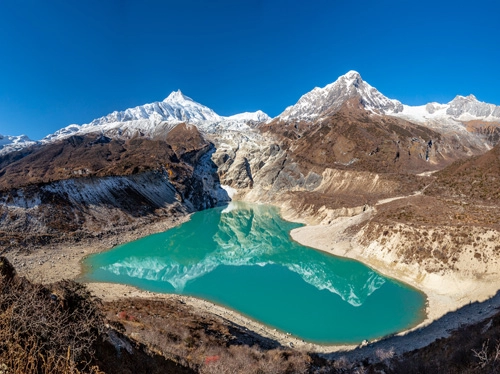
Budget Manaslu Circuit Trek 12 Days
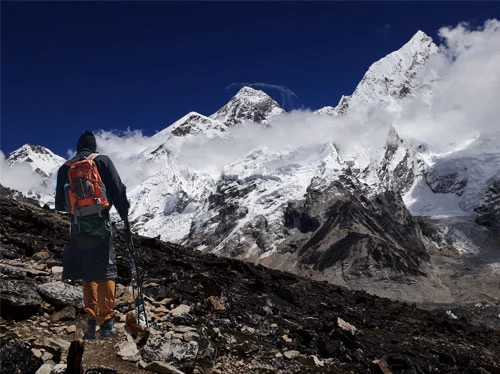
Budget Everest Base Camp Trek - 12 Days
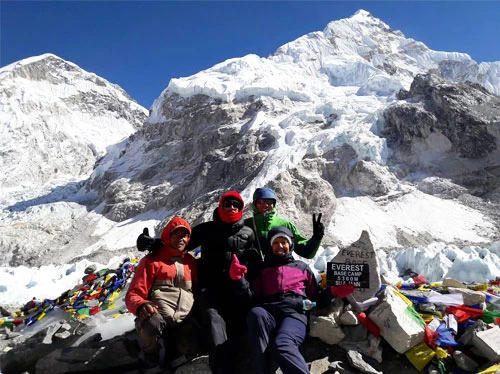
9 Day Everest Base Camp Trekking
Send an inquiry.
We use cookies to ensure that we give you the best experience on our website.
A trail from Lukla to Namche Bazaar
Embarking on the trail from Lukla to Namche Bazaar, situated in the heart of marvel-filled Nepal, is like turning the pages of a surreal fairy tale. The terrain is a painted canvas of nature’s best, holding you captive with glimpses of silver linings – majestic peaks crowned by glistening snow under the blue arc sky. It’s daunting and utterly beautiful.
But what really gets your blood rushing isn’t just these sublime views. It’s encountering mountaineering legends who’ve trodden this coveted path, and local Sherpas whose tales weave magic into each bend on your path from Lukla to Namche. Meeting them is as intriguing as beholding that first glimpse of Everest peeping amid clouds at sunrise from Namche Bazaar, their stories becoming part of your journey – bold yet humble reminders that there’s no summit out of reach when our hearts are tuned to bravery and resilience.

Lukla village
Nestled in the rugged terrains of northeastern Nepal, the Lukla village presents an unforgettable fusion of adventure and serenity to enthrall every visitor. It is more than just a place; it marks the beginning of a thrilling trekking journey from Lukla to Namche, leading your steps into the heart of Everest’s paradise.
The second you land in Lukla’s daunting Tenzing-Hillary Airport (known as one of the most challenging airports in the world), your adrenaline will instantly surge. As you acclimatize yourself with its high altitudes and breathe in cool mountain air offering invigorating whiffs, prepare for majestic sights. From monasteries echoing tranquility, sherpa houses displaying vibrant Tibetan-Buddhist culture, quaint tea houses serving aromatic local tea to panoramic landscapes framing white tips of enormous mountains – each encounter here contributes towards scripting an epic Himalayan tale! Life surely thrills at 2,830 meters above sea level!
Steps to reach from Lukla to Namche Bazaar
Lukla’s Gateway Lukla, a gateway to the Himalayas, serves as the starting point for this remarkable journey. Nestled amidst towering peaks, Lukla’s Tenzing-Hillary Airport is renowned as one of the world’s most challenging airstrips.
Trekking Essentials Equip yourself with sturdy trekking gear and essentials. From durable hiking boots to weather-appropriate clothing, ensuring you have the right equipment is vital for a seamless expedition through the rugged terrain.
Phakding Pit Stop As you trek onwards, Phakding emerges as a welcome pit stop. This quaint village along the Dudh Koshi River offers a serene setting and a chance to acclimatize before ascending further.
Monastery Marvels in Monjo The trail continues to Monjo, where the renowned Monjo Monastery stands as a testament to the region’s rich cultural heritage. Take a moment to absorb the spiritual ambiance of this sacred site.
Sagarmatha National Park Entrance Prepare to be enchanted as you reach the entrance of Sagarmatha National Park. The gateway to the Everest region, this UNESCO World Heritage site is a haven for biodiversity and natural wonders.
The Hillary Suspension Bridge Crossing the iconic Hillary Suspension Bridge is a thrilling highlight of the journey. Suspended over the raging Dudh Koshi River, this bridge offers breathtaking views of the surrounding landscapes.
Namche Bazaar: Gateway to Everest Finally, the jewel of the trek awaits – Namche Bazaar. Nestled amid the Himalayan peaks, this vibrant market town is a hub of Sherpa culture and commerce. Enjoy panoramic views of Everest and the surrounding peaks.
Time Duration:
The time it takes to reach Namche Bazaar from Lukla can vary depending on individual walking pace and weather conditions. On average, it takes about 6 to 8 hours to trek from Lukla to Namche Bazaar. The distance between Lukla and Namche Bazaar is approximately 9 miles (15 kilometers) along the Everest Base Camp trekking route. The trail involves ascending and descending through hilly terrain, and factors such as acclimatization breaks and weather conditions can also affect the overall trekking time. It’s important to note that trekking in the Himalayas requires proper preparation and acclimatization to avoid altitude-related issues.
After your comfortable hike from Lukla, you will enter one of the most beautiful villages of nepal: Namche Bazaar.

Namche Bazaar
Nestled in the heart of Nepal, at a dizzying elevation of nearly 3,500 meters, you’ll uncover the Himalayan gem known as Namche Bazaar. It’s much more than an otherworldly landscape with breath-taking panoramas – this vibrant trading hub boasts quite an exotic blend of cultures too! Discover the Sherpa people’s charming hospitality and watch how their centuries-old traditions harmonize with touches of modernity.
Strap on your walking boots and hike through iconic trails where scenes from Everest expeditions unfold right before your eyes and also drive you to the Gokyo lake trails . Be sure to visit on a Saturday when Namche Bazaar transforms into a bustling marketplace; captivate your senses with the colourful mélange of fresh produce, traditional handicrafts, and local delicacies! In this surprising blend of high-altitude simplicity and bustling commerce, every moment is an explosion waiting to delight not just intrepid trekkers but all kinds of globetrotters!
Namche Bazaar Experiences
Stepping through the doorway of the Himalayas, one is greeted by Namche Bazaar, a quaint mountainous village that stands as a proud melting pot of age-old Sherpa culture and breathtaking natural vistas. A labyrinth of narrow lanes chock full with colorful prayer flags fluttering in the breeze, stalls selling exotic yak cheese and piles of hand-woven carpets – it’s an intimate embrace of local life. As you saunter down its winding trails, you can perceive the stunning panorama of snow-clad mountains piercing the sky, while getting warmed by smiles from strangers.
Up above 11,000 feet where wispy clouds breathe life into stories untold stands Hotel Everest View – reportedly holding the Guinness Record for being the highest hotel in the world. Overlooking Namche Bazaar, it offers surreal masterpieces where Gods presumably painted peaks onto azure skies! Equally delightful is a mystic rendezvous with customs at Saturday market – a vibrant spectacle deeply embedded in tradition or simply chatting away with the Sherpa community over their buttery brew – Chang (local beer, wine). Every nook mirrors an ethereal charm; promising heavenly escapade right here on earth!
In short: when visiting this unexplored gem tucked neatly into Nepal’s bosom, expect whimsical visuals meeting soulful narratives around every corner–all heavily laced together under generous drizzles of mountain enchantment!
Also Read: Everest Base camp trek cost
Q: Where is Namche Bazaar located? A: Namche Bazaar is an exciting and vibrant market town nestled in the heart of the Khumbu region, Nepal.
Q:: What makes Namche Bazaar a must-visit destination? A: With its rich Sherpa culture, stunning Himalayan views, local markets, and adventurous trekking trails, there’s never a dull moment in Namche Bazaar!
Q: What’s the best time to visit Namche Bazaar? A: The optimal time to visit this Himalayan wonderland would be during pre-monsoon (February-May) and post-monsoon (September-November).
Q: How do I get to Namche Bazaar? A: You can reach Namche Bazaar by flying into Lukla airport followed by a thrilling two-day trek.
Q: Which famous treks start from Namche Bazaar? A: Some of the most popular treks like Everest Base Camp Trek and Three Passes Trek begin from this bustling little town.
Regd. No: 175840/074/075, Tourism License No: 2432

Run and Managed by:
Local tourism experts & sherpas of nepal.

- Trek to Nepal
Namche Bazaar Trek (Short Everest Trek)
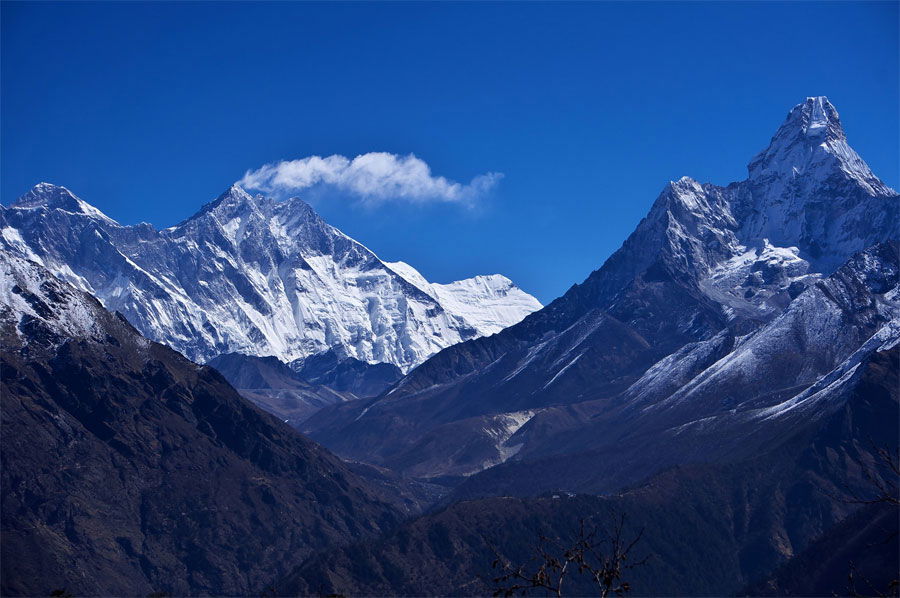
- Trip Overview
Namche Bazaar is the gateway of Mount Everest and also the center of the Everest (Khumbu) region. Namche Bazaar Trek leads you to visit this bustling Sherpa Market with views of Mount Everest and its surrounding towering peaks. This trek is relatively short but still, it offers a delightful trekking experience in the Everest region.
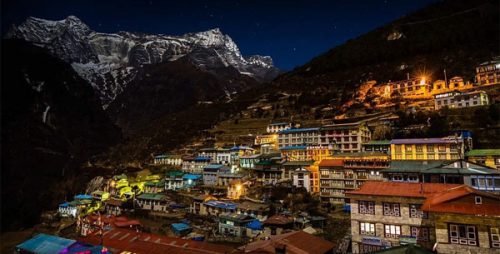
Namche Bazaar Trek can be done year-round although the months of March to mid-May and September to mid-December are the best times for trekking. It is suitable for trekkers with average physical fitness. Age isn’t a restriction either all you need is positivity and enthusiasm. This trek has almost none of the altitude sickness.
In this trek, you hike through the land of the legendary Sherpa community, where you can enjoy the unique culture, traditions, and ancient heritage of the Sherpa people. Immerse yourself in the breathtaking mountain scenery and marvelous landscape and witness the glorious and ever-enchanting Himalayas.
You begin the Namche Bazzar trek after a scenic flight from Kathmandu to Lukla. Upon landing at the Lukla airport, the magic of the Everest region starts mesmerizing you. You have a unique experience as you trek passing the prayer stones carved with Buddhist mantras and suspension bridges festooned with prayer flags.
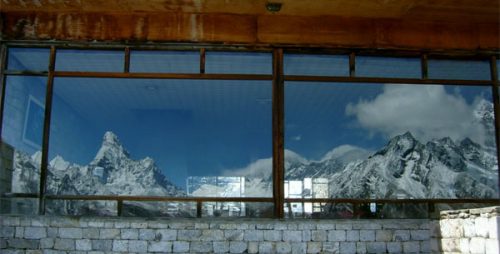
As you cross deep gorges and fast flowing Dudh Koshi River you can interact with the warm welcoming locals of culturally rich villages such as Chheplung, Phakding, Nurning, Benkar, and many others. Then you arrive at the check post of Sagarmatha National Park. Further, you will cross a high suspension bridge over the mighty Dudh Koshi River and follow a steep trail for an hour to reach Namche Bazaar.
As you trek higher from Namche, you enjoy the panoramic view of Mount Everest, gorgeous Ama Dablam, scenic Lhotse and Nuptse, and other Himalayan peaks, and also exceptional beauty embedded in the dramatic mountains and deep valley.
In Khumjung, the Sherpa village, at Khumjung Monastery you can see the scalp of Yeti, a mythical Himalayan creature, and also experience the lifestyle of Sherpa people. After exploration of Namche Bazaar, you return to Lukla through the scenic trail and fly back to Kathmandu to complete this short and easy Namche Bazaar Trek.
In Summary, the highlights of Namche Bazaar Trek are as below:
• Short and delightful trekking in Everest region • Enjoy the views of Mt. Everest, Lhotse, Ama Dablam & other peaks • Explore around busy Namche Bazaar, the gateway to Mt. Everest • Pass through villages of Sherpa • An opportunity to get insights into Sherpa culture and tradition • Good for all regardless of age or level of fitness
ITINERARY OF NAMCHE BAZAAR TREK (SHORT EVEREST TREK)
Day 1: Arrival in Kathmandu
After landing at the Tribhuvan International Airport in Kathmandu, you will be received by our representative at the arrival gate who will then transfer you to you the hotel. Orientation of the trip. Explore the Thamel Tourist Market or relax at the hotel to overcome your jet lag. Overnight at a hotel in Kathmandu.
Day 2: Kathmandu – Lukla – Phakding (2,652 m/8,700 ft)
Early morning flight to Lukla (2,800m/9,186ft), a gateway destination from where your trek starts. After 35 minutes of flight above breathtaking green and white mountains, you will reach the Tenzing Hillary Airport at Lukla. Here you meet your other crew members and after some packing and arrangements, you start your trek through the prosperous village of Lukla until you reach Phakding. To assist in acclimatization, you only have a short hike today around 4 hours. You hike through Chaurikharka village and descend towards Dudhkoshi Ghat (2,530m/8,300ft). The trail follows the bank of the Dudhkoshi River until Phakding (2,652m/8,700ft). Overnight at mountain lodge in Phakding.
Day 3: Phakding – Namche Bazaar (3440 m/11,280 ft)
You will have breakfast in Phakding before gearing up for the trek to Namche Bazaar, the biggest sherpa village in Nepal. Today you will walk through a beautiful pine forest. The trail takes you along the Dudh Koshi River crossing many suspension bridges, one of which is the famous Hillary Suspension Bridge. You catch a wonderful panorama of the glistening Mt. Thamserku (6618 m). At Monjo, you come to the check post and entrance to Sagarmatha National Park. Then you pass through the last village of Jorsale. After a final steep ascent of about two hours, you will get first sight of Mt. Everest, peering over the Lhotse-Nuptse ridge. From thereafter 1.5 km of walking you will reach Namche Bazaar. Namche is the gateway to Mt. Everest and the main trading center of this region. Overnight at Mountain Lodge in Namche Bazaar.
Day 4: Namche Bazaar – day hike to Syangboche, Everest View Hotel, and Khumjung Sherpa Village
Namche Bazzar is the main center of the Everest (Khumbu) region and has government offices, Internet cafes, shops, restaurants, a bakery, and a colorful market each Friday evening and Saturday. You leave early for the hike up towards Everest View Hotel, which is about an hour’s hike above Namche Bazaar. Their great sights await you with a fantastic panorama of the Himalayas and a great view of Everest, Lhotse, and Ama Dablam. After enjoying the view you continue hiking to the traditional Sherpa villages of Khumjung. If you are interested, you may ask your guide to take you to the Khumjung Monastery which houses what is said to be a Yeti scalp. Leaving the village you circle back to Namche Bazaar. Overnight at Mountain Lodge in Namche Bazaar.
Day 5: Namche Bazaar – Phakding – Lukla
Today from Namche Bazaar you retrace your journey to Lukla. Although you are traveling the same route down, you feel completely different views. We can see a mixture of open plains, rhododendron, and pine forests, and in the distance snow-covered peaks. You walk through the Sherpa villages noticing impressive faith in Buddhism and the culture of prayer stones and prayers flag while we walk through the villages. On arrival in Lukla, you stretch those sore legs and recall the experiences of the last couple of days. Overnight at Mountain Lodge in Lukla.
Day 6: Lukla to Kathmandu
In the morning, you’ll take a brief flight from Lukla, where your journey both began and ends. After arriving in Kathmandu you’ll transfer to your hotel. Relax at the hotel. You can do last-minute shopping in Kathmandu. In the evening we offer you a farewell dinner at one of the best Nepalese restaurants in town. During dinner, we would love to hear your feedback about the trip. Overnight at a hotel in Kathmandu.
Day 7: Departure from Kathmandu, Nepal
It’s your last day in Nepal! Grab some breakfast at the hotel. Then, before 3 hours of your flight time, we transfer you to Kathmandu International Airport for your onward flight to your home.
Additional Info: If want to see Mount Everest without taking any flight and in short trekking, we advise you PIKEY PEAK TREK .
Pikey Peak Trek is the newly discovered incredible trekking trail in the Everest region. From Pikey Peak, you will have incredible views of Mt. Everest, Makalu, Kanchenjunga, Annapurna, Gaurishankar, Lhotse, Nuptse, Numbur, Sishapangma, Thamserku, and Mera Peak.
Edmund Hillary, the first summiteer of Mount Everest, said that the best views of Everest can have from Pikey Peak (4067m) which is located in the lower part of the Everest Region.
Please click here: Pikey Peak Trek for detailed information.
EXCELLENT HIMALAYA TREK & EXPEDITION: OPERATOR OF NAMCHE BAZAAR TREK
Excellent Himalaya Trek and Expedition is the leading trekking operator and company managed by local tourism experts and Sherpas who have more than 20 years of experience organizing treks and expeditions into the Himalayan zone. We will take care of all permits and logistical matters, including food and accommodation on the Namche Bazaar Trek.
FOR NAMCHE BAZAAR TREK COST
For up-to-date Namche Bazaar Trek cost, please contact us by email at [email protected] or WhatsApp/ Viber at +977 9851203181 mentioning no. of people interested to do this trek. Once we receive your request message, we get back to you within 24 hours with a reasonable package price.
Ask our experts (Inquiry)
Select Trip Special Puja at Pashupatinath, Abhishek, Cost and Time Annapurna Base Camp Trek with visit to Hot Water Spring Rafting in Pokhara Bisket Jatra in Thimi Motor Bike Tour in Nepal Kathmandu to Manaslu Trek Canyoning in Pokhara Manang Tilicho Lake Trek Kathmandu to Langtang Trek Trek to Kala Patthar Nagarkot Tour from Kathmandu Thorong la Pass Trek: Affordable Cost with Best Services Lukla to Tengboche Trek: Tengboche Monastery Trek Ghandruk Poon Hill Trek Namche Bazaar Trek (Short Everest Trek) Sikles Kapuche Lake Trek Lwang Village Homestay Tour Panchase Trek 2 Days Astam Village Trek Tour Chitwan Sauraha Tour Package Mardi Himal Trek for Nepali and Indian People Australian Camp Trek Nepal Poon Hill Trek Package Besisahar to Jomsom Trek Pokhara to Jomsom Trek Khopra Danda Trek: Cheap Cost with Perfect Itinerary Mohare Danda Trek: Community Lodge Trek in Nepal Pikey Peak Trek: Affordable Cost and Package Pikey Peak Trek Nepal: Itinerary and Price 7 Days Annapurna Base Camp Trek Tamang Heritage Langtang Trek Cost: Cheap Package Price Langtang Tour Package: Hiking Trip Everest Base Camp Trek Booking 12 Days Short Everest Base Camp Trek Kushma Bungee Jump and Swing in Nepal Kathmandu to Ghandruk Tour Package Poon Hill Trek Route, Distance, Itinerary Annapurna Base Camp Trek Distance Tilicho Lake Annapurna Circuit Trek Itinerary with Length Everest Base Camp Gokyo Lake Trek Combine Tilicho Lake Annapurna Circuit Trek Everest Base Camp Trek Nepal Companies Poon Hill Trek Cost Mount Everest for Beginners Annapurna Circuit Trek inclusive Tilicho Lake Everest High Passes Trek Cost Everest Base Camp Trek with Daily Hiking Distance in Km/ Miles Everest Base Camp Trek Kathmandu Manaslu Tea House Trek Annapurna Circuit Trek Package Manaslu Nar Phu Valley Trek Tsum Valley Manaslu Trek Three Passes Trek Distance Gokyo Lake Trek Distance Mera Peak Climbing Itinerary and Cost Guide Cost for Everest Base Camp Trek Mardi Himal Trek Distance Langtang Trek Distance in Km and Miles How Long Annapurna Circuit Trek Distance in Km and miles Difference between Annapurna Circuit and Annapurna Base Camp Trek Annapurna Base Camp Mardi Himal Trek Mardi Himal vs Annapurna Base Camp Trek Best Company for Mera Peak Climbing Upper Mustang Jeep Tour Package Upper Mustang Trek Package Best Company for Upper Mustang Trek Best Tour Company for Everest Base Camp Trek Nepal Everest Base Camp Trek How Long? Nepal Trek to Everest Base Camp 4 Nights 5 Days Hiking Around Kathmandu 3 Nights 4 Days Hiking Around Kathmandu 2 Night 3 Day Hiking Near Kathmandu 1 Night 2 Day Hiking Around Kathmandu Hiking in Kathmandu Paragliding Kathmandu from Chandragiri: Price & Booking Contact Mardi Himal Trek Nepal One Week Nepal Honeymoon Tour Package Kathmandu Pokhara Honeymoon Tour Kathmandu Honeymoon Tour Package Nepal Honeymoon Tour Packages from India Nepal Tour Package for Couple Solo Poon Hill Trek Solo Three Passes Trek with Everest Base Camp Solo Mardi Himal Trek 7 Days Mardi Himal Trek Kalinchowk Package Langtang Trek with Local Company of Nepal Langtang Trek Nepal Island Peak Climbing: Cheap Cost and Best Package Everest Base Camp Trek: Hiking to Mt. Everest Everest Base Camp Trekking in Nepal Annapurna Base Camp Trek in Nepal Solo Annapurna Base Camp Trek Nepal Mahayana Buddhist Tour in Nepal Gokyo Renjo La Pass Trek: Less Crowded Trekking Route in Everest Trekking Agency to issue Upper Mustang Permit, Guide, Porter Hire Price Shortest Mardi Himal Trek Trekking Agency to issue Manaslu Trek Permit, Guide, Porter, Jeep Hire Poon Hill Trek for Malaysia, Singapore People Mardi Himal Trek with Recommended Agency of Nepal Manaslu Trek with Best Local Company of Nepal Everest Three Passes Trek with Best Recommended Company Everest Base Camp Trek with Local Company Recommended Company for Island Peak Summit Climb Annapurna Base Camp Trek with Recommended Company of Nepal Annapurna Circuit Trek with Recommended Trekking Company of Nepal Best Everest Base Camp Trek Company Mount Everest Tour by Plane Quickest Trek to Everest Base Camp Best Nepal Trek Packages for Christmas and New Year Vacation Best Nepal Tour for Christmas and New Year Vacation Everest Base Camp Trek UK for British Poon Hill Trek by Jeep Drive Tour Everest Base Camp Trek in December Gokyo Lake Renjo La Pass Trek Mardi Himal Trek: Best Cost and Perfect Itinerary Trekking Guide and Porter Hire Cost in Nepal Everest Base Camp Trek from Brazil Everest Base Camp Trek from Philippines Everest Base Camp Trek from Indonesia Greenline Bus Kathmandu Pokhara Everest Mountain Flight for Bangladeshi, Sri Lankan & Others Everest Mountain Flight for Chinese, Thai, Malaysian & Others Three Passes Trek with Everest Base Camp Everest Mountain Flight for Indian Citizen Langtang Trek for Beginners, Seniors and Family Langtang Solo Trek Package Trek to Langtang Langtang Trek Cost- Best Package and Perfect Itinerary Annapurna Circuit Trek for Beginners Annapurna Base Camp Trek for Beginners Everest Base Camp Trek for Seniors Muktinath Tour Package Sarangkot Hiking Everest Base Camp Trek from Singapore Everest Base Camp Trek for People from Australia Everest Base Camp Trek for Beginners: Best Itinerary with Price Recommended Operator of Everest Base Camp Trek Manaslu Circuit Trek: Best Cost and Package Manaslu Trek with Cost Annapurna Base Camp Trek Cost: ABC Trek Package Annapurna Circuit Trek: Affordable Cost and Package Bungee Jump in Pokhara at Affordable Price: 101 meters Height Annapurna Circuit Trek Cost for Single Trekker for 2020/ 2021 Best Price of Annapurna Circuit Trek Annapurna Circuit Trek for Malaysia and Singapore Hikers Everest Base Camp Trek Cost for Single Solo Everest Base Camp Trek in Nepal Everest Base Camp Trek at Hong Kong Dollar HKD Daily Hiking Distance of Everest Base Camp Trek in Kilometers and Miles Everest Base Camp Trek from Malaysia Annapurna Base Camp Trek from Malaysia Annapurna Base Camp Trek for Indian People Everest Base Camp Trek without flight to Lukla (By Road) 7 Days Poon Hill Trek 12 Days Annapurna Circuit Trek Short Annapurna Base Camp Trek Annapurna Base Camp Trek via Ghandruk Everest Base Camp Trek: Affordable Cost and Package Short Everest Base Camp Trek Hot Air Balloon in Pokhara Everest Base Camp Trek Manaslu Expedition: 8163 m/26781 ft Everest Expedition: 8848 m/29029 ft Amadablam Expedition: 6812 m/22349 ft Helambu Trek Tamang Heritage Trek Phaplu Everest Base Camp Trek Gokyo Renjo La Pass Trek Everest Base Camp Gokyo Lake Trek Cost: Perfect Itinerary, Best Package Amadablam Base Camp Trek Naya Kanga Peak Climbing: 5844 m/19168 ft Hinuchuli Peak Climbing: 6441 m/21126 ft Saribung Peak Climbing: 6346 m/20815 ft Dhampus Peak Climbing: 6012 m/19724 ft Tent Peak Climbing: 5663 m/18563 ft Singu Chuli Peak Climbing: 6501 m/21323 ft Mardi Himal Peak Climbing: 5587 m/18330 ft Paldor Peak Climbing: 5896 m/19343 ft Yala Peak Climbing: 5732 m/ 18790 ft Chulu West Peak Climbing: 6419 m/ 21059 ft Chulu East Peak Climbing: 6564 m/ 21005 ft Lobuche Peak Climbing: 6119 m/ 19581 ft Makalu Base Camp Trek Dhaulagiri Base Camp Trek Khopra Danda Trek Pashupatinath Tour Pashupatinath Janakpur Tour Muktinath Overland Tour Muktinath Tour Maratika Tour: Halesi Tour Lumbini Tour Kathmandu Temple Tour 3 Days Nepal Tour: Classic Nepal 4 Days Nepal Tour: Glance of Nepal 5 Days Nepal Tour: Romantic Nepal 5 Days Nepal Travel: Kathmandu World Heritage Tour 6 Days Nepal Tour: Wonderful Nepal 6 Days Nepal Travel: Nepal Jungle Safari Tour 7 Days Nepal Tour: Incredible Nepal 1 Week of Nepal Tour 7 Days Nepal Trip: Discover Nepal Best Selling Nepal Tour: Affordable Package Price Langtang Helicopter Tour 9 Days Nepal Tour: Nepal Vacation Package 10 Days Nepal Tour: Fascinating Nepal 11 Days Nepal Tour: Exploring Nepal 12 Days Nepal Tour: Colorful Nepal Island Peak Climbing: 6189 m/ 20305 ft Mera Peak Climbing: 6461 m/ 211907 ft Pisang Peak Climbing: 6091 m/19980 ft Rara Lake Helicopter Tour Muktinath Damodar Kund Heli Tour Annapurna Base Camp Helicopter Tour Nepal Honeymoon Tour Mardi Himal Trek Druk Path Trek: 10 days Trekking in Bhutan Gangtey Trek: 9 Days Trekking in Bhutan Bhutan Travel 8 days : Paro Thimphu Trongsa Tour Bhutan Travel 7 days : Paro Thimphu Gangtey Tour Kalinchowk Tour Bhutan Travel 6 days : Paro Thimphu Punakha Tour II Bhutan Travel 5 days : Paro Thimphu Punakha Tour I Bhutan Travel 4 days : Paro Thimphu Tour Bhutan Travel 3 days : Paro Tour Everest Base Camp Tour by drive: Nepal Tibet EBC Tour Nepal Tibet Travel: Kathmandu Lhasa Overland Tour II Nepal Tibet Tour: Kathmandu Lhasa Overland Tour I Guge Kingdom Tour Kailash Heli Yatra: Kailash Helicopter Tour Kailash Yatra : Kailash Overland Tour Kailash Tour with Lhasa Everest Base Camp Mount Kailash Tour with Lhasa Tibet Tour 9 days : Lhasa Everest Base Camp Travel Tibet Tour 8 days : Lhasa Everest Base Camp Tour Tibet Tour 7 days : Lhasa Gyantse Shigatse Tour Tibet Travel 6 days : Lhasa Tsedang Tour Tibet Tour 6 days : Lhasa Namtso Lake Tour Hindu Pilgrimage Tour Nepal Buddha Temple Tour Nepal Muktinath Helicopter Tour Everest Base Camp Helicopter Tour Nepal Adventure Tour 9 days Nepal Adventure Tour 6 Days Tibet Tour 5 days : Lhasa Yamdrok Lake Tour Upper Mustang Trek Nepal Family Tour Everest Family Trek Nepal Family Trek Rara Lake Trek Kanchenjunga Base Camp Trek Upper Dolpo Trek Lower Dolpo Trek Tsum Valley Trek Langtang Gosaikunda Lake Trek: Cheap Cost with Perfect Itinerary Everest View Trek Three Passes Trek Everest Cost- 3 Passes Trek Package Gokyo Lake Trek Cost: Affordable Gokyo Lake Trek Package Classic Everest Trek The Last Resort Bungee: Bhotekoshi Bungy Jump Paragliding in Pokhara: Updated Price with Best Services Manaslu Trek Zipline in Pokhara: Classic and Superman Zipline Bhote Koshi Rafting Ultralight Flight in Pokhara: Best Price with Exciting Flight Everest Mountain Flight Everest Helicopter Tour Trishuli Rafting: Affordable Best Price Chitwan Jungle Safari Tibet Tour 4 days: Lhasa Tour Nar Phu Trek Ghandruk Trek Tilicho Lake Trek with Annapurna Circuit Poon Hill Trek Annapurna Circuit Trek Annapurna Base Camp Trek Langtang Valley Trek
Share this trip on
Have you any questions, if this trip doesn't suit you, make your trip happen, why travel with us.
- Run by local experts, guide & Sherpa.
- Focus on your needs.
- Good value for money.
- Real cared services.
- Government recognized company.
- Best reasonable rate.

Quick Navigation
- Trip Reviews
Steps of Contact and Booking with us

Namche Bazaar Trek - 3 Days

- Duration 3 Days
- Trip Grade Easy
- Trip Destination Everest Tour, Nepal
- Starts at Kathmandu
- Ends at Kathmandu
- Max. Altitude 5545m
- Trip Type Heli Tour
- Transport By private Vehicle, By Helicopter
- Accommodation Hotel & Lodges
- Easy and Safe Online Booking System
- Last-minute booking facility
- Free trip postponement facility.
- Free Cancellations according to Company Policy
- Full packages trip with 3-time meal Meal Plan
- A professional guide with fluent english
- Flights from Kathmandu to Lukla
- Helicopter fly over EBC/ Kalapatthar
Everest Base Camp Trek 3 Days is a compressed adventure, also known as the Namche Bazaar Trek. It is like a power-packed version of the classic trek, designed for those who are short on time but eager for a Himalayan experience.
This 3-day trek to Everest Base Camp (Namche bazaar Trek) offers a glimpse into the heart of the Khumbu region, showcasing the breathtaking landscapes and cultural richness that define the Everest region. Even though it's shorter, this trek captures the essence of the traditional Everst Base Camp Trek and is still an exciting experience for those who don't have much time.
In this 3-day Everest base camp trek, trekkers cover a distance of approximately 20 kilometers, making their way from Lukla to Namche Bazaar and back, with a special side trip to the renowned Hotel Everest View. The short timeframe doesn't compromise the trek's authenticity but instead offers a taste of the region's majestic beauty.
This Namche Bazaar Trek (Everest base camp trek 3 days) offers a variety of attractions, including the bustling Sherpa town of Namche Bazaar, with its vibrant market and rich cultural heritage. The trek also includes a visit to the iconic Hotel Everest View, which provides a stunning panorama of Everest and neighboring peaks.
The highlight of the EBC 3-day trek is a helicopter flyover to Everest Base Camp, offering an exclusive aerial view of the world's highest peak and the Khumbu Icefall.
The Everest 3 days trek route passes through lush forests, crosses suspension bridges, and unveils unparalleled views of Himalayan giants like Ama Dablam, Lhotse, and Nuptse. Trekkers take in the unique Sherpa culture as they pass traditional villages adorned with prayer flags and charming teahouses.
The best seasons for the Namche Bazaar Trek (Everest 3 days trek) are spring (March to May) and autumn (September to November), offering clear skies, moderate temperatures, and vibrant landscapes.
These months provide optimal trekking conditions, allowing for an enjoyable and comfortable experience. If the weather is favorable, trekkers can also complete the 3-day Namche bazaar trek (EBC 3-day trek) in January and February.
This Everest base camp trek 3 days package maximizes the trekking adventure within a short timeframe. Highlights include a guided trek to Namche Bazaar, a visit to Hotel Everest View, and a helicopter flyover to Everest Base Camp. We seamlessly arrange accommodations, permits, and transportation to ensure a hassle-free journey.
Our services extend beyond a standard trek package. Experienced guides accompany trekkers throughout the journey, providing insights into the local culture and ensuring safety. We prioritize sustainable and responsible trekking practices, aiming to minimize our environmental impact.
Join us on this incredible 3-day Everest Base Camp adventure, delving into the awe-inspiring beauty of the Himalayas. Whether you're a trekking pro or stepping into adventure for the first time, this quick trek promises an unforgettable journey. Secure your spot now for 2024 or 2025, and don't miss the chance to make your mark on the Himalayan landscape—book your adventure with us today!
Major Attractions of Everest Base Camp Trek 3 Days
- Enjoy the vibrant Sherpa culture and the bustling market atmosphere at Namche Bazaar.
- Experience breathtaking panoramic views of Everest, Lhotse, and Nuptse from the charming Hotel Everest View.
- Admire the majestic peaks of Ama Dablam and Thamserku as you hike the trekking trail.
- Cross thrilling suspension bridges that cross deep gorges, adding an exciting element to your trek.
- Take a helicopter flyover to Everest Base Camp for a unique and awe-inspiring perspective of the iconic location.
- Witness the enormous Khumbu Icefall, a key feature of the Everest climbing route, during your helicopter journey.
- Enjoy unparalleled views of Everest Base Camp, a tent settlement nestled amidst the stunning Himalayan landscape.
- Descend from the Himalayas in style with a helicopter, offering a bird's-eye view of the picturesque valleys and terraced fields.
- Traverse through lush forests, adding a touch of greenery to the rugged and high-altitude terrain.
- Engage with the warm and hospitable Sherpa community, gaining insights into their unique way of life.
Everest Base Camp Trek 3 Days Best Season
The best time to do this quick 3-day Everest trek is during spring (March to May) and autumn (September to November). In spring, the weather is mild, and the rhododendron blooms paint the landscape with vibrant colors, creating a picturesque setting. The trails are also less crowded, allowing for a more intimate connection with the stunning surroundings.
Likewise, autumn brings clear skies, comfortable temperatures, and breathtaking views of the snow-capped peaks. The air is crisp, and the visibility is excellent, making it the perfect time to witness the grandeur of Everest and its neighboring giants.
These seasons offer optimal trekking conditions, ensuring that your three-day adventure is not only physically rewarding but also a visual feast for the senses. If the weather is favorable, you can also do the 3-day EBC trek in January and February.
So, whether you're a nature enthusiast, a photography buff, or just seeking a memorable trekking experience, plan your 3-day Everest Base Camp adventure during these best seasons to make the most of your trek.
Trip Details for the Everest Base Camp Trek 3 Days
- Duration: 3 days
- Distance: Approximately 20 kilometers
- Maximum altitude:3,880 meters (Hotel Everest View)
- Minimum altitude: 1,400 meters (Kathmandu)
- Heli flights: HEV to Kathmandu with Everest base camp flyover
- Flight duration: 1 hour, 30 minutes
- Attractions: Namche Bazaar, Hotel Everest View with panoramic views, aerial perspective of Everest Base Camp
- Best Seasons: Spring (March to May) and Autumn (September to November)
- Highlight: Exclusive helicopter flyover to Everest Base Camp
- Package Inclusions: Guided trek, accommodations, permits, transportation
- Scenery: Lush forests, suspension bridges, views of Ama Dablam, Lhotse, Nuptse, and Himalayan landscapes
Everest Base Camp Trek 3 Days Cost for 2024 and 2025
Start an extraordinary journey with our 3-day Everest Base Camp trek, also known as the Namche Bazaar Trek. Unlike the typical trek, this unique adventure combines a thrilling 2-day hike with an exciting helicopter ride back. Allow yourself to enjoy the stunning beauty of the Everest region, creating memories that will last a lifetime.
Bookings for a 3-day Everest base camp trek are now open for 2024, 2025, and 2026, giving you plenty of time to plan your epic Everest adventure.
The cost for the Everest base camp trek over 3 days is $1950 per person for group joining basis. Take in breathtaking views, experience Sherpa culture, and inhale the clean mountain air that shrouds the high peaks.
For a more exclusive experience, consider our private treks for 1–5 adventurers, with prices ranging from $1950 to $5550 per person. Craft your own Everest odyssey with your tribe, tailored to your preferences and pace. Experience an unforgettable journey amidst the world's highest peaks with our Everest Base Camp 3-Day Trek, whether you prefer the camaraderie of a group trek or the intimacy of a private journey. Join us for the adventure of a lifetime!
Private Everest Base Camp Trek 6 Days for 2024 and 2025
A private trek offers an exclusive and personalized experience tailored just for you. This includes private accommodation, transportation, and the dedicated services of a guide and porter throughout the trek. The trekking portion is entirely private, ensuring a more intimate and customizable adventure. However, please note that the helicopter ride is on a shared basis unless specified otherwise.
If you prefer a private helicopter ride, you can opt for this option by selecting the add-on during the booking process via the " Book a Private Trip " section. Choosing a private helicopter ensures a guaranteed flight back to Kathmandu, which is especially helpful during peak seasons when flights are often diverted to Ramechhap.
Here is a table for Private Everest Base Camp 5-Day Trek Cost for 2024 and 2025:
If a private trip is beyond your budget, an alternative is available through our daily departure dates, which can be checked for availability in the " Check Availability " section. This option provides a more budget-friendly trekking experience while still offering the adventure of a lifetime with a group of fellow travelers.
Book now and get free t-shirts, caps, and stickers.
Day 1: Kathmandu to Lukla Flight and Trek to Phakding
- Duration 35 minutes (by air)/ 3 to 4 hours (by trek)
- Highest Altitude 2,610 m (Phakding)
- Accommodation Tea houses (twin sharing)
Your Everest Base Camp trek for 3 days begins with an early morning flight from Kathmandu to Lukla. The scenic flight itself is an adventure as you soar above the magnificent Himalayan peaks, catching glimpses of breathtaking landscapes. The 35-minute flight covers a distance of around 13 kilometers from Kathmandu to Lukla. Landing at Tenzing-Hillary Airport in Lukla, the gateway to the Everest region, you'll feel the excitement building.
Upon arrival in Lukla, the trek officially starts. The trail initially descends through charming villages, passing by Mani walls, small stupas, and prayer flags that add a spiritual touch to the trek. The route offers stunning views of the Dudh Kosi River Valley and the surrounding hills. As you make your way through the beautiful landscape, you'll reach Phakding, a quaint village located at an altitude of around 8,563 feet (2,610 meters).
On the first day, you will cover approximately 8 kilometers and complete the trek in around 3–4 hours, depending on your pace. The relatively gentle descent provides a good warm-up for the days ahead. Along the way, you'll encounter suspension bridges that cross the Dudh Kosi River, adding an adventurous element to the trek.
The beauty of today's trek is awe-inspiring, with dense forests, rhododendron blossoms (depending on the season), and occasional glimpses of snow-capped peaks in the distance. Phakding, situated along the banks of the Dudh Kosi River, offers a serene setting to rest for the night. You can enjoy a cozy teahouse stay, relishing the warmth of traditional Sherpa hospitality.
Transportation: Transfer from hotel to airport by private vehicle
Flight Distance: around 136 km (Kathmanu to Lukla)
Flight Duration: around 35 minutes
Trekking Distance: 8 km (Luklat to Phakding)
Trekking Duration: 3 to 4 hours
Meal: Lunch and Dinner
Highest altitide: 2,610 m (Phakding)
Highlights of the day: lush green forests, temples, rivers, suspension bridges, and local settlements
Mountain Viewed: Mount Karyolung, Mount Kusum Kanguru, Mount Nupla, and Mount Gongla
Day 2: Trek to Namche Bazaar
- Duration 6 to 7 hours
- Highest Altitude 3,440 m (Namche Bazaar)
As the sun rises on the second day of your Everest Base Camp 3-day trek, you'll be filled with anticipation for the adventure ahead. After a hearty breakfast in Phakding, you'll begin your trek towards Namche Bazaar.
The trail follows the Dudh Koshi River, and the path passes through lush pine forests, providing a refreshing start to your day. The trek today covers a distance of approximately 11 kilometers and takes around 6 to 7 hours, depending on your pace.
Leaving Phakding behind, the route gradually ascends, and you'll cross suspension bridges decorated with colorful prayer flags. These bridges offer stunning views of the river below and the surrounding mountains. You'll encounter quaint villages like Monjo, where you'll need to check in at the Sagarmatha National Park entry point. This is an excellent opportunity to learn more about the local culture and the conservation efforts in the region.
Continuing your trek, the trail becomes steeper, but the breathtaking scenery around you serves as constant motivation. As you approach Namche Bazaar, the views of Thamserku and Kangtega peaks become more prominent. After a challenging uphill climb, you will eventually arrive at Namche Bazaar, a vibrant and bustling market town nestled in the heart of the Khumbu region.
Upon reaching Namche Bazaar, settle in the teahouses and explore the remaining time. Take some time to explore the vibrant streets, interact with the locals, and immerse yourself in the unique atmosphere. The town offers panoramic views of Everest, Lhotse, and Ama Dablam, creating a perfect backdrop for your well-deserved rest.
Distance: Approximately 11 kilometers
Duration: 6 to 7 hours
Routes: Phakding to Monjo to Namche Bazaar
Sceneries: Riverside trails, suspension bridges, pine forests, traditional villages, and panoramic mountain views
Highlights of the day: rivers, greenery, settlements, local people, stunning mountain views, waterfalls, and more.
Mountain viewed: Kusum Kanguru, Nuptse, Thamserku, Kangtega peaks, and a glimpse of Everest.
Day 3: Hike to Hotel Everest View, Tour to EBC and Return to Kathmandu
- Duration 1 and half hour(by trek)/ 1 hour, 30 minutes (by air)
- Highest Altitude 3880 m (Hotel Everest View)
- Accommodation on your own
Today is the most exciting part of your 3-day trek to Everest Base Camp, filled with breathtaking landscapes and unforgettable experiences. Wake up early in Namche and enjoy a hearty breakfast to fuel your adventurous day. The initial part of the hike involves a steady ascent, gradually revealing panoramic views of the surrounding peaks, including the majestic Ama Dablam and Thamserku.
Continue up the trail towards Hotel Everest View, a picturesque viewpoint at about 3,880 meters above sea level. The hike covers around 3 kilometers and will take about 2 to 3 hours, depending on your pace and the photo stops you choose to indulge in. The route offers a mix of lush forests, suspension bridges, and captivating glimpses of the towering Himalayan giants.
Upon reaching Hotel Everest View, take a moment to catch your breath and savor refreshments while soaking in the awe-inspiring views of Everest, Lhotse, and Nuptse. The Everest panorama from this vantage point is simply unparalleled.
After your refreshing break, the Everest 3-day trek continues with a helicopter flyover to Everest Base Camp. Enjoy the sights at the iconic Khumbu Icefall, the bustling tent city of base camp, and the towering beauty of the world's highest peak—all from the comfort of your helicopter. This flyover offers a unique perspective on the EBC experience, allowing you to witness the beauty of the region in a way few have the privilege to.
After the EBC flyover, you will head back to Kathmandu. Bid farewell to the Khumbu region as you fly over lush valleys and terraced fields, reminiscing about the incredible landscapes you've traversed in the past few days.
Trek Distance: around 3 km
Trek Duration: 1 and half hour
Heli Flight Duration: around 1 hour, 30 minutes
Meals: breakfast, Lunch and Farewell Dinner
Accommodation: on your own
Maximum Altitude: 3880 m (hotel Everest View)
Highlights of the day: lush forests, suspension bridges, panoramic views of Everest, Lhotse, and Nuptse, Khumbu Icefall, Everest Base Camp, and Himalayan landscapes.
Mountain View: Ama Dablam, Lhotse, Nuptse, Thamserku, and Everest.
Our team guides, porters and accompanying staff are locals with a broad knowledge about each and every location that we travel through.
What's Included
Airport pickup and drop-off services.
- International Arrival Pickup
- Domestic Airport Dropoff Before Trek
- Domestic Airport Pickup After the Trek
- International Dropoff on your Final Departure Day
Accommodations Services
- 2 nights in local teahouses (Twin Sharing Basis)
Trekking Permit
- Local Government Entry Permit (Trek Card)
- Sagarmatha National Park Permit (Everest Permit)
- Trekkers' Information Management Systems Card (TIMS)
Helicopter Flight
- Helicopter from Hotel Eerest View to Kathmadnu with Everest Base Camp flyover
Domestic Flights
- Kathmandu to Lukla Flight
In the case of the Lukla Flight Via Ramechhap
- Ramechhap to Lukla Domestic Flight Ticket
- Kathmandu to Ramechhap by Sharing or Private Jeep
Food During in Kathmandu/Trekking
- 3 Breakfast: Local and Continental Choices from Tea House Menu
- 3 Lunch: Simple and Light Lunch in Lunch Camp Tea Houses
- 2 Dinner: Veg and Non-Veg Meals of your Choice Domestic and Continental Foods from the Local Tea House Menu
- 1 Farewell Dinner by NTA
Guide/Porter Services and Their Liabilities
- English Speaking Government Licensed Trekking Guide (minimum 10 years of experience)
- All Meals for Guide/Porter
- Insurances for Guide & Porter
- Well Paid Salary as Per the Government`s Rate or the Concerned Association`s Circular Rate
- Local Sherpa for carrying your luggage up to 20 KGs Max
- First-Aid Kit Carried by Our Team
What's Excluded
- Fees for International flight tickets to and from Nepal.
- Food and lodging in Kathmandu.
- Charge of extra luggage.
- Medical and emergency rescue charge.
- Tips or gratitude to the guides or porters
- Extra expenses like drinking any kind of hard or soft drinks, shopping, laundry, etc.
- Extra night of accommodation and food (in case of changes in regular itinerary or due to other reasons).
- Extra facilities like extra porters, hot shower, wifi, etc during the trek
- Travel insurance that covers both medical and emergency evacuation with a minimum worth of 100,000.00.
Hotels in Kathmandu
Looking for a hassle-free start and end to your trek? Let us take care of your stay in Kathmandu. Relax and recharge in the comfort of a 3-star hotel or similar quality accommodation, with a little extra charge for added convenience.
Kathmandu to Lukla By Sharing Heli Flight
Want to kick off your adventure with a unique twist? Consider our shared Kathmandu-Lukla helicopter ride. It's not just a flight; it's an extra layer of excitement, offering a different perspective and a smooth ascent. Keep in mind that this comes with an additional cost.
Availability & Private Trip
Pick your suitable date, everest base camp trek 3 days difficulty.
The Everest Base Camp Trek 3-day itinerary is an exciting yet easy adventure. While the shorter timeframe adds a layer of intensity, the journey primarily involves trekking through well-established trails.
The initial phase, trekking to Namche via Phakding, presents a relatively moderate challenge, with gradual ascents and descents along the Dudh Koshi River. However, the rapid elevation gain and varying weather conditions may pose some difficulty for those unaccustomed to high-altitude trekking.
The real adventure unfolds during the helicopter flyover to Everest Base Camp, providing stunning views and a unique perspective without the physical demands of a full trek to the base camp. Despite its short duration, the 3-day Everest Base Camp Trek demands a reasonable level of fitness, making it accessible to those seeking a taste of the iconic trek in a shorter timeframe.
Food during Everest Base Camp Trek 3 Days
Namche Bazaar Trek (Everest base camp trek 3 days) is not just a journey through stunning landscapes but also a delightful exploration of local flavors that fuel your adventure. One advantage of this trek is that the package cost conveniently includes the food, enabling you to focus on the breathtaking scenery and cultural experiences without the need to worry about meals.
Starting the day in Kathmandu, your culinary adventure kicks off with a diverse breakfast spread featuring pancakes, hash browns, cornflakes, local bread, chapatti, and an assortment of egg dishes like fried, scrambled, boiled, and omelet. The variety sets a flavorful tone for the day ahead.
As you trek towards Namche Bazaar, the teahouses along the trail offer a lunch menu that showcases regional specialties such as Dal Bhat, Tenduk Spaghetti Noodles, Thukpa, Pasta, Vegetable Curry, Tibetan Bread, and soul-warming soups. These hearty meals provide the perfect refuel, sustaining you for the trek through the picturesque landscapes.
In the evenings, the dining experience in Namche Bazaar introduces delights like Dal Bhat, various soups (tomato, chicken, mushroom, garlic), and more, fostering a sense of community and camaraderie among fellow trekkers. The fact that the food is inclusive in the package not only adds convenience but also allows you to fully savor the rich tapestry of flavors without any additional concerns.
Accommodation for Everest Base Camp Trek 3 Days
The accommodation during the Everest base camp trek for 3 days provided as part of the package ensures a cozy and welcoming retreat after a day of exploration. Throughout the 3-day trek, local teahouses will provide accommodation for you.
These places offer better services. Even though most rooms are shared, our experienced guides will arrange accommodations based on gender. If you're a couple or prefer your own room within a group, let us know in advance, and we'll make the necessary arrangements.
These teahouses are cozy spots with basic furnishings. While the comfort may vary, each teahouse has a warm atmosphere, letting you experience local hospitality. The shared dining areas in teahouses create a friendly vibe, where you can connect with other trekkers, share stories, and make new friends.
For bathrooms during the trek, teahouses usually have shared facilities with basics like hot showers. Despite their simplicity, these bathrooms are well-maintained, maintaining high cleanliness standards for a hygienic and pleasant experience.
Permits for Everest Base Camp Trek 3 Days
For your 3-day Everest base camp trek, you'll need permits to make your journey smooth and hassle-free. The required permits include:
- Sagarmatha National Park Entry Permit
- Khumbu Pasang Lhamu Rural Municipality (KPRM) Entry Permit.
- TIMS (Trekkers' Information Management System) card.
Don't worry about the paperwork—we've got it covered! We include all the necessary permits, including the TIMS card, in your trekking package. We'll take care of obtaining them for you before the trek begins. So, you can focus on enjoying the breathtaking landscapes and the adventure without any permit-related concerns.
Travel Insurance for Everest Base Camp Trek 3 Days
For your three-day trek in Namche Bazaar, getting travel insurance is crucial. It should cover medical emergencies, especially altitude-related issues, and potential trip cancellations or interruptions due to unforeseen events. Make sure your insurance also considers the helicopter ride back to Kathmandu, accounting for weather-related delays and offering protection for your belongings during the journey.
With a good travel insurance plan, you can enjoy the trek without worrying about unexpected challenges, as it ensures your financial protection. It should cover health emergencies, trip disruptions, and potential issues during the helicopter ride, providing peace of mind for your Namche Bazaar adventure.
Alternative Trips for the Everest Base Camp Trek 3 Days
Time-pressed thrill-seeker? Soar above the clouds on an Everest Helicopter Tour , witnessing the Khumbu Icefall's raw power and landing at Kala Patthar's breathtaking viewpoint. Everest in a day—a once-in-a-lifetime adrenaline rush.
Yearning for a taste of the trek? Embark on a 7-day Everest Short Trek , savoring Namche Bazaar's vibrant hub, Tengboche's serene monasteries, and finally, the crown jewel—Everest Base Camp. Helicopter back for a grand finale, panoramic views etched in your memory.
Seeking a quick Himalayan escape? The 5-day Everest Trek beckons. Nestled amongst towering peaks, find your haven at Syangboche's iconic Hotel Everest View. Witness the majesty unfold—a perfect blend of adventure and leisure—in just five days.
Craving the classic Everest Base Camp experience? Immerse yourself in the 14-day Traditional Everest Base Camp Trek . Acclimatize at your own pace, soak in the Sherpa culture, and conquer each pass: Namche Bazaar, Tengboche, Dingboche, and finally, Everest Base Camp. A true odyssey, rewarding you with unparalleled vistas and deep cultural connections.
Choose your Everest adventure. Each path unveils a unique perspective, igniting your spirit with the wonder of this legendary region. So, whether you seek a whirlwind helicopter tour, a condensed trek, a quick Himalayan escape, or a timeless journey to Everest Base Camp, let your adventure begin!
Tips for Everest Base Camp Trek 3 Days
- Ensure good physical fitness for the trek's challenges.
- Pack layers, a sturdy backpack, and essential trekking gear.
- Wear comfortable, waterproof, and well-broken-in hiking boots.
- Stay hydrated; drink plenty of water throughout the trek.
- Dress in layers for varying weather conditions.
- Use sunscreen, sunglasses, and a wide-brimmed hat for sun protection.
- Consume balanced meals for sustained energy levels.
- Be respectful of the local Sherpa culture and customs.
- Ensure all necessary permits and documents are in order.
- Consider using trekking poles for added stability on uneven terrain.
- Keep emergency contacts and insurance information handy.
- Listen to experienced guides for safety and trek insights.
- Familiarize yourself with emergency procedures and evacuation routes.
- Maintain a positive attitude and enjoy the journey's unique experiences.
- Secure trek bookings and permits well in advance.
Frequently Asked Questions
Q1. when is the best time to do the everest base camp trek 3 days.
The best time to do this quick 3-day Everest trek is during spring (March to May) and autumn (September to November). In spring, the weather is mild, and the rhododendron blooms paint the landscape with vibrant colors, creating a picturesque setting.
Q2. How can I book this Everest base camp for a 3 days trek?
You can book the Everest base camp trek 3 days through various methods, including:
- Text or Call: Reach out to us via text or phone call at 9751017030 (Binod Sapkota) to discuss your interest in the trek, ask any questions, and initiate the booking process.
- Direct Online Booking: Visit our website and use our secure online booking platform . Follow the provided instructions to select your preferred dates, customize options if needed, and complete the booking process.
Feel free to choose the method that is most convenient for you, and we're here to assist you every step of the way.
Q3. Is the Namche Bazaar trek transferable to my partner ?
Yes, the trek is transferable to your partner after completing certain formalities. Please consult with us before, and we will provide you with the necessary details and guidance on the transfer process.
Q4. Is the helicopter flight included in the 3 days trek package?
Yes, the helicopter flight from HEV to Kathamdnu via Everest Base Camp flyover is included in the trek package. This unique and thrilling experience is a highlight of the 3 days Everest base camp trek, offering breathtaking aerial views of the iconic landmarks in the region.
Q5. Can I customize the itinerary or add extra days to the trek?
Yes, you have the flexibility to customize the itinerary or add extra days to the trek. Please inform us about your preferences and any customization requests during the booking process. Alternatively, you can choose from our available add-on options to tailor the trek to better suit your preferences and schedule. We are here to ensure your 3 days Everest base camp trek is a personalized and memorable experience.
Q6. Is Namche Bazaar trekking safe?
In general, this Namche Bazaar trek is safe and possible for everyone. With a little preparation, the right gear, and adaptability (acclimatization), this 3-day EBC trekking journey will be less risky. Also, this trek is really popular, so the trails are wider and smoother, and local support is more readily available in case of need.
Q7. Can you see Everest from base camp during the Namche Bazaar Trek?
Yes, you can see Mount Everest during this 3-day EBC trek. As the trek involves a helicopter ride back to Lukla on the fifth day, you will have the opportunity to witness the bird's-eye view of Everest and its surrounding peak.
- Reserve now and pay later
- Change dates
- You can pick a different tour
- Trip transfer to your friends
- We accept PayPal payment
- 24 hours response time

Binod Sapkota
What our clients say, everest 3-day trek,.
I visited Nepal with my family, which included my four-year-old twin babies. I really wanted to see the entire region of Nepal, but due to age restrictions and higher risks, my family decided to go on the Annapurna base camp trek. Seeing me want to be at Everest so badly, Binod suggested the Everest 3-day trek, which involved a helicopter ride to Everest Base Camp and back to Kathmandu, starting from the hotel Everest View, which was outstanding. We got the opportunity to experience landing at the most dangerous airport in Lukla, known as Lukla Airport, and trek till the hotel Everest View, which took us 2 days. On the last day, we enjoyed the best helicopter ride. I would like to thank the Nepal Trek Adventure family for this amazing experience.

Everest three-day trek
The best thing about my visit to Nepal was the Everest three-day trek, which was the perfect combination of thrill and excitement. This trip made me experience trekking and helicopter rides in the Everest region of Nepal, which was beyond my expectations. We landed at Lukla, which was the most thrilling part of the trek, then trekked to Phagding and Namche Bazaar, respectively, which took us two days. Then, on the third day, we had a short trek to the luxurious hotel in Everest and the highest altitude hotel, which was Hotel Everest View. We boarded our helicopter and had the best experience of getting to witness an aerial view of the majestic Everest and the other mountains until we returned to Kathmandu. Thanks to the Nepal Trek family for such amazing hospitality.
Overall Rating

Why travel with Nepal Trek Adventure?
Nepal Trek Adventure and Expedition is one of the best local travel companies based in Kathmandu with leading adventures.
Our experienced guides have extensive knowledge of the local area and culture, ensuring a safe and authentic adventure.
Our team is dedicated to providing exceptional customer service, from personalized trip planning to attentive support throughout your journey.
We understand that travel plans can change, which is why we offer flexible itineraries and customizable tours to meet your specific needs and preferences.
We strive to provide the best value for your money, with competitive pricing and transparent, all-inclusive pricing that eliminates hidden fees.
Get Your Free Guide Now
Download a detailed PDF with all the information you need to plan an enjoyable vacation in Nepal.
We use cookies to ensure that we give you the best experience on our website.

Everest Region Cultural Trek (7 Days)
Trip duration, start point, max altitude, best season, diffic. level, accomodations & meals.
- 3 Nights 3-Star Hotels
- 3 Nights Tea Houses
- Daily Breakfasts
- 3 Lunches and Dinners
- Water (Pay Extra on the trek)
Locations Covered
- Namche Bazaar
" The Lukla Namche Bazaar trek is ideal for those who have limited holiday time. This 5-day trek from Lukla airport to Namche bazaar takes you through Phakding Bazaar, Monjo, Sagarmatha National Park, and Namche with its famous suspension bridge. And Hike to the Hotel Everest View for a spectacular view of Mount Everest. "
Everest Region Cultural Trek (7 Days) allows you to explore Lukla, Phakding, and Namche Bazaar . You can hike for about two hours to Syangboche (3800m) for the outstanding panoramic views of several giant mountains, including Mt. Everest, where Hotel Everest View is located. Namche Bazar is the busiest town in the Everest region. This is an ideal place to rest for acclimatization if you head up the mountain. The cultural Lukla Namche Bazaar trek ends up in Namche, visiting Sherpa’s heritage and cultural aspects. Also, you will be an eyewitness to splendid Mt. Everest, Mt. Amadablam, Thamserku, Lhotse, Nuptse, and more .
Everest Region Cultural Trek (7 Days) initiates from Lukla by flight and starts your trek from Lukla following a gentle walk up the mountainside on the left bank of Dudh Koshi River. The mountain called Nupla (5885m) can be visible in the distance on the opposite bank of the Kongde Ridge. The next day you reach Namche Bazar (3440m), which is surrounded on three sides by mountain ranges; early morning, you observe your first view of the several peaks from the historical town.
Everest Region Cultural Trek (7 Days) is pretty pleasant, except for a few short ascending climbs and the Bhote Koshi Rivers crossing several times. This itinerary can be suitable for those looking for the shortest day excursions and getting the complete taste of adventure on Everest. The Lukla Airport to Namche Bazaar trek is fit for any aged group trekkers, including families with kids, senior citizens, and solo trekkers.
Everest Base Camp tour by a Helicopter
Are you looking for a helicopter tour to explore Everest Base Camp/Kalapathhar in one day? We can help you plan this Helicopter tour landing at Kalapathar in a half day. Check our itinerary and Everest Base Camp Helicopter Landing Tour prices to get more information. Also, check out Everest Base Camp 14 days itinerary for a complete trek up to the Everest Base Camp and Kala Patthar.
Itinerary Expand All
Fly from Kathmandu to Lukla (2886m), takes half an hour by flight, Trek to Phakding (2640m) – Trek for 3-4 hours.
Trek from Phakding to Namche Bazaar (3440m)- Trek for 5-6 hours.
Exploration day in Namche Bazaar, hike for a couple of hours nearby.
Trek from Namche Bazaar to Lukla.
Fly back to Kathmandu.
Full-Day sightseeing in Kathmandu valley.
Flyback home or your onward destination.
What's Included
- Airport Pick up and Drop Services
- 2 Nights of standard accommodation in Kathmandu with Breakfast
- All necessary permits such as TIMS, National Park Fee
- All nights’ Lodge or tea house accommodation while trekking
- 3 times meals in a day such as Breakfast, Lunch, and Dinner
- Trekking Gears such as Duffle Bag, Walking sticks during trekking ( needs to be returned)
- Medical Kit First-Aid Bag
- English Speaking Professional license holder Local Guide
- Kathmandu to Lukla to Kathmandu flight and domestic airport taxes including guides
- One porter for every 2 trekkers including his entire expenses
- Staff insurance, Salary, necessary equipment, Food, and accommodation
- Rescue Arrangements but Not the bills.
- Best Price Guaranteed
For cancellation more than 30 days before the Tour Start Date, No Cancellation fee is charged. For cancellation from 29 calendar days up to and including 4 calendar days before the Tour Start Date, a charge of 30% of the total invoice amount is charged. For a cancellation occurring within 3 days of the date of travel or No Show shall be charged 100% of the total invoice amount. Learn more about Terms and Conditions.
- Privacy Protected
- Secure Online Payment
- Guaranteed Departure
Got questions? Reach out to us for expert assistance in tailoring your dream trip. Let's begin your journey!
What's Included ?
What's excluded .
- Lunch and Dinner in Kathmandu
- Nepal Visa Fee ($30 for 15 days)
- Extra Night in Kathmandu because of early arrival, late departure, or early arrival from the mountain than the scheduled itinerary
- Any drinks such as hard or soft
- Personal insurance
- Personal Expenses
- Rescue operation charges
- International Airfare To and From Kathmandu
- Tips for Supports staffs and etc.
Customer Reviews
John uy . jul 24, 2019, 3 country tour - nepal, tibet and bhutan.
Hassle-free is the word. If you plan to visit these countries? Anup at Himalayan Windows is the guy you need to see. Almost a year of planning and he was on top of things every single time. Any questions? He answers. Any suggestions? He answers. Better yet? You don’t need to plan anything. Have him plan it for you! He even booked us a fine dining restaurant in which my…
Trip Information Expand All
Payment & cancellation .
Payment: A deposit of 30% of the total tour cost is required to book the tour with Himalayan Windows (HW). The remaining balance is to be paid three days prior to the departure date. Payment can be made via Wire Transfer or Credit Card. All credit card payments are securely processed and a bank fee applies.
Cancellation: For cancellations more than 30 days before the Tour Start Date, there will be no cancellation fee. If the cancellation happens within 29-4 days prior to the Tour Start Date, a charge of 30% of the total invoice amount will be applied. Cancellations occurring within 3 days or less of the start date or in the case of a no-show, 100% of the total invoice amount will be charged. Learn more about Terms and Conditions .
ACCOMMODATION & MEALS
Accommodation: Accommodation is typically provided in twin rooms in cities, though a single supplement can be requested for an additional fee. During peak season, it can be difficult to find single or twin rooms in the mountains, so our lodges usually offer dormitory-style accommodation. Our priority is always to provide clean and safe rooms for our guests.
Meals: Our packages in Bhutan include full board meals, with breakfast, lunch, and dinner included. For treks, all meals are provided, but you will need to pay extra for drinking water and snacks.
VISA REQUIREMENTS
Nepal Visa: If you are planning a trip to Nepal, you must have a valid passport and Nepal Visa. Depending on your country of origin, you may need to obtain a Nepal Tourist Visa before your arrival. To be eligible, your passport should be valid for a minimum of six months from your Tour Start Date. If you are planning on traveling to multiple countries on your trip, make sure to get a multi-entries Nepal Visa.
Bhutan Visa Clearance: All visitors to Bhutan must have a valid Bhutan Visa Clearance before their trip. To obtain it, you must submit a color-scanned copy of your passport, which must be valid for at least 6 months from the start date of your tour. Your tour operator will send you a Visa Clearance prior to your departure, which you must present at the Druk Air/Bhutan Airlines counter during check-in. Once you arrive at Paro Airport, your passport will be stamped with the original visa.
Tibet Group Visa (TGV): All travelers from any nation intending to go to Tibet from Nepal must obtain a Tibet Group Visa (TGV) in Kathmandu with the help of a tour operator. To ensure the successful application of the TGV, you should plan to arrive in Kathmandu 3-4 working days before your travel date. If you are coming from China, you will not require a TGV; instead, you will need a Chinese Visa and Permit. To find out more about the process of entering Tibet, please look into the Tibet entry procedure.
BEST TIME TO VISIT
Nepal & Bhutan: Visiting Nepal and Bhutan at the same time is ideal as they share a similar climate. From high mountains to low land sub-tropical plains and jungles, the two countries have similar weather. The best time to visit is from March to April (spring) and October to December (autumn and early winter). During these months, the air is clean and fresh with sunny skies. January and February are colder months, while June, July, and August (summer) are typically monsoon seasons.
Tibet: It is best to visit Tibet between April and October when the weather is warm and the skies are clear. However, from November to March, it is still possible to explore certain areas like Namtso, Everest Base Camp, and Mount Kailash, as long as the roads are not blocked by snow. Temperatures during this time may be quite cold.
TRAVEL INSURANCE
HimalayanWindows strongly recommends that anyone planning to travel in the Himalayas purchase Travel Insurance. This policy will provide coverage in the case of medical emergencies, evacuation, theft, loss of belongings, and last-minute tour/ticket cancellations. Having this protection in place will help ensure that your trip is safe and enjoyable.
Top 10 FAQs on Everest Base Camp Trek
Everest Base Camp is one of the world's famous trekking destinations. Every mountain lover dreams of scaling the base camp of mighty Everest. There are several trekking routes in the Everest Region, and the EBC trek is the most popular one. We have prepared the Top 10 FAQs on Everest Base Camp Trek (EBC) in Nepal based on our previous trekkers' experiences. If the given FAQs are not helpful enough,… Read More »

Related Packages
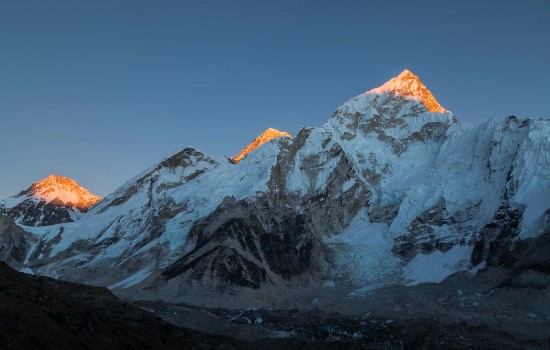
Everest Base Camp Trek Nepal & Lhasa Tour -19 Days
Mount Everest Base…
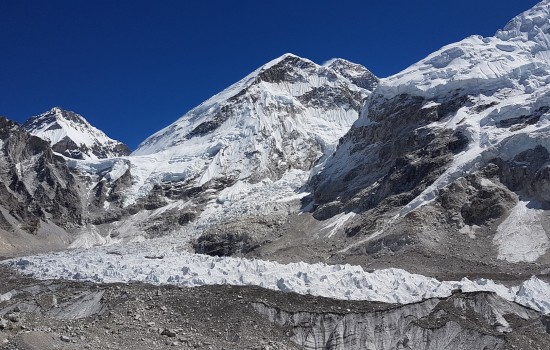
Everest Base Camp Trek with Bhutan Short Tour
Considered one of…
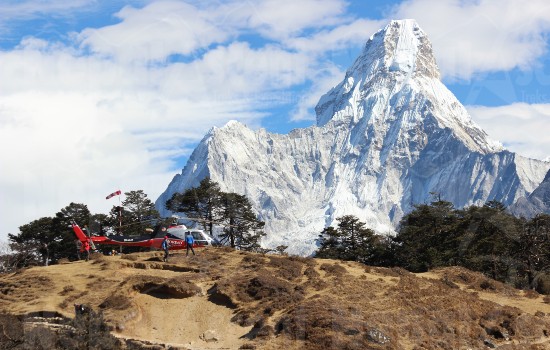
Helicopter Tour Landing at Everest Base Camp
Are you a…

Everest Base Camp Trek via Salleri
The Everest Base…
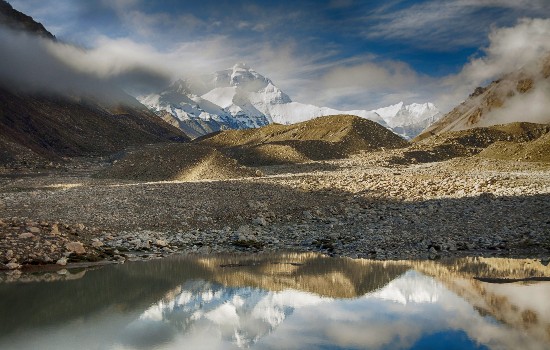
Lhasa Everest Base Camp (EBC) Tibet Tour
Lhasa is Tibet's…
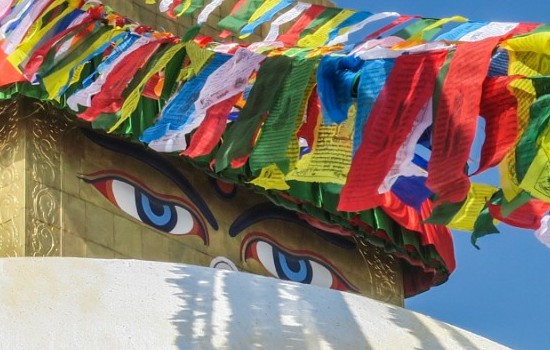
3Nights 4Days Nepal Tour Package
Whether you are…

Island Peak Climbing (6189m/20305ft)
Island peak Climbing…
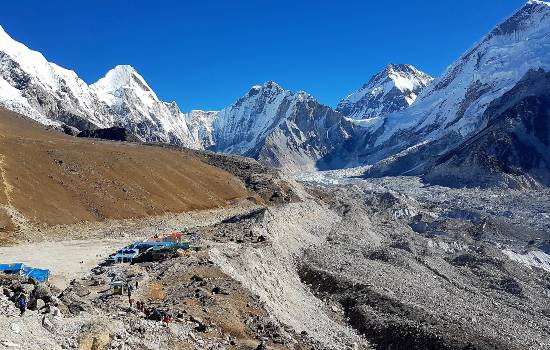
Everest Base Camp Trek 14 Days Itinerary
Everest Base Camp…
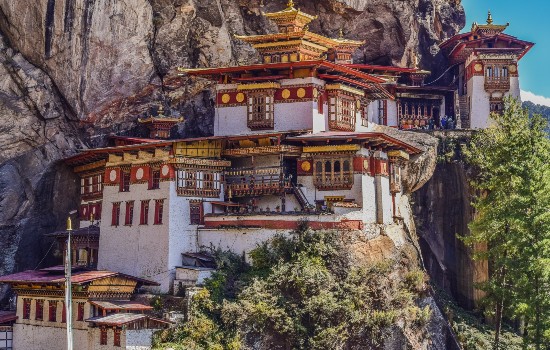
Shortest Bhutan Tour 03 Days 02 Nights
Nestled in the…
Related Information
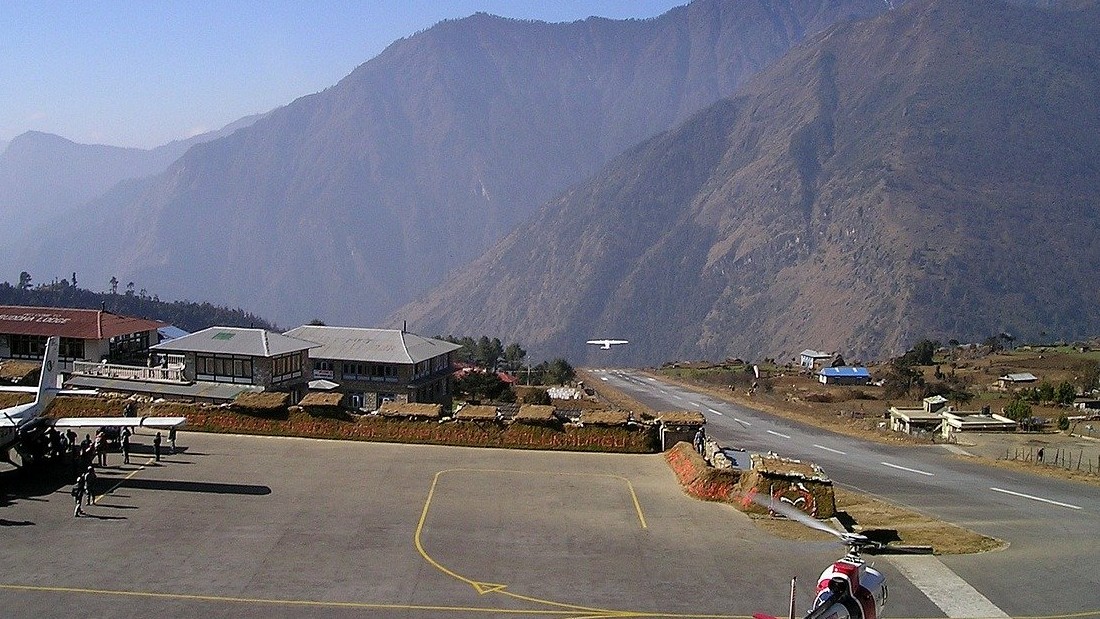
Getting Into Lukla from Kathmandu | A Complete Guide
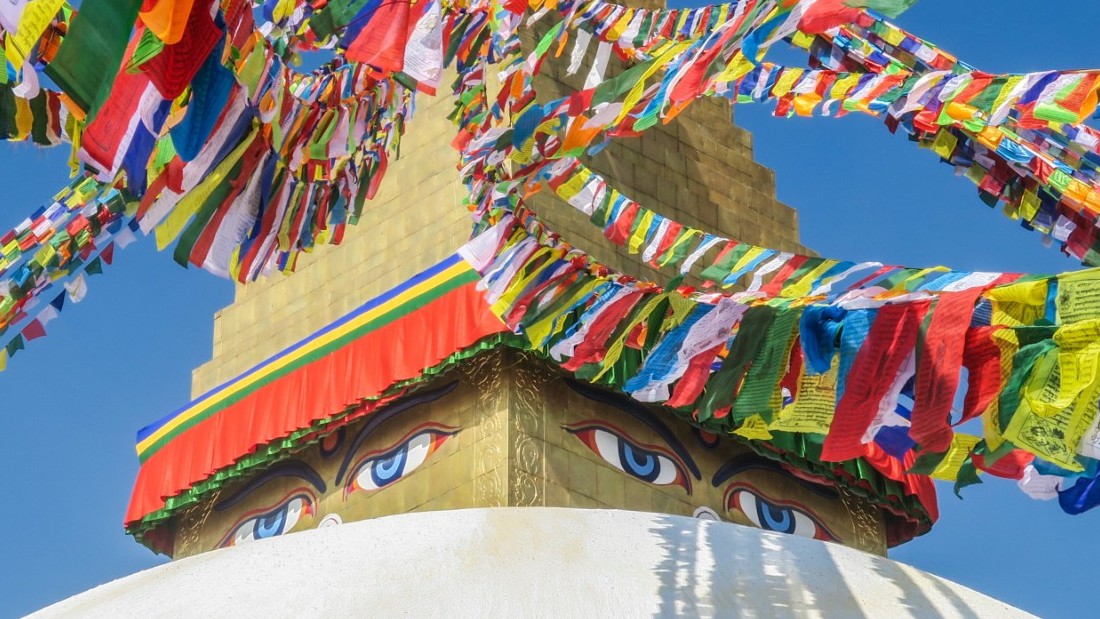
Essential Info Before Heading For Nepal
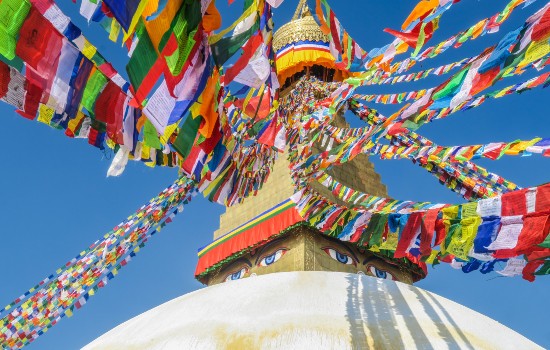
Suggested itinerary & things-to-do for a-week trip to Nepal
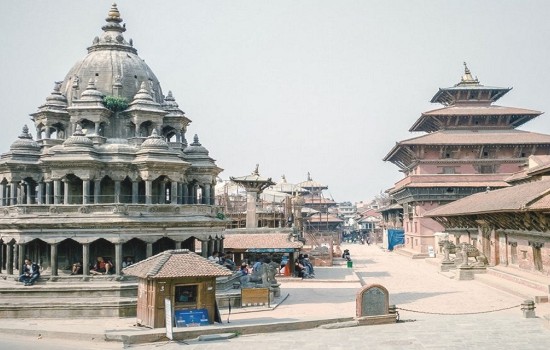
Places To See In Patan Durbar Square
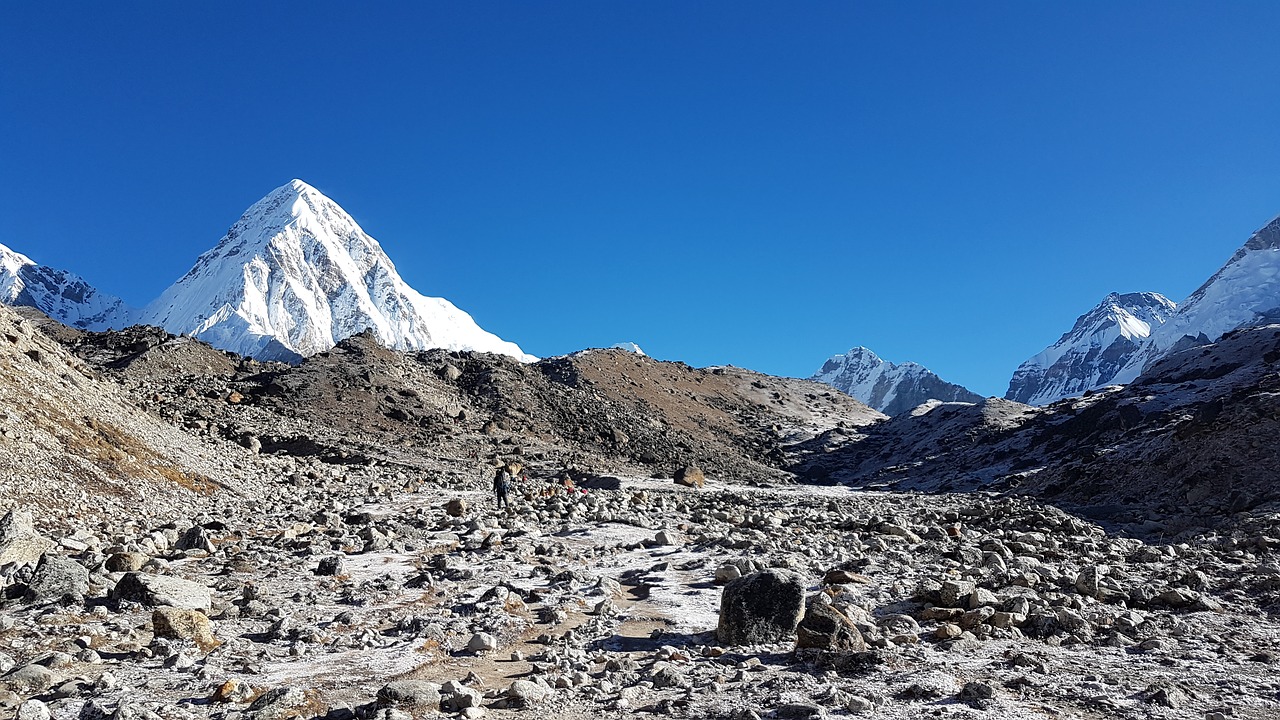
5 Best Moderate Trekking Routes in the Everest Region

Everest Base Camp Trek Gear Packing List
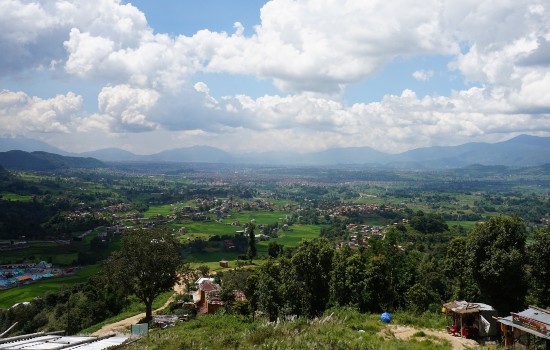
Post-Coronavirus (COVID-19) Quarantine TRAVEL TIPS

NEW NEPAL VISA FEE UPDATE FOR FOREIGN VISITORS FROM JULY 17, 2019

5 BEST SHORT AND EASY TREKS IN NEPAL
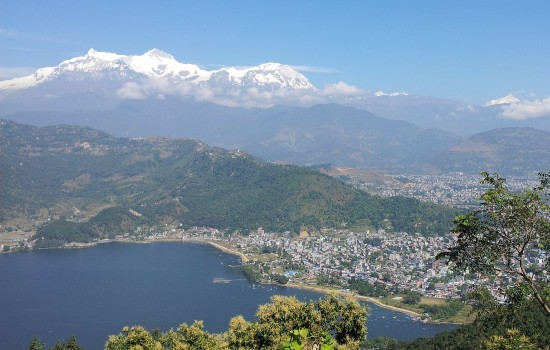
5 FACTS EVERY TRAVELER SHOULD KNOW BEFORE TRAVELING TO NEPAL


Namche Bazaar to Lukla Trek | Everest Base Camp Day 11
By: Author Charles
Posted on May 8, 2023
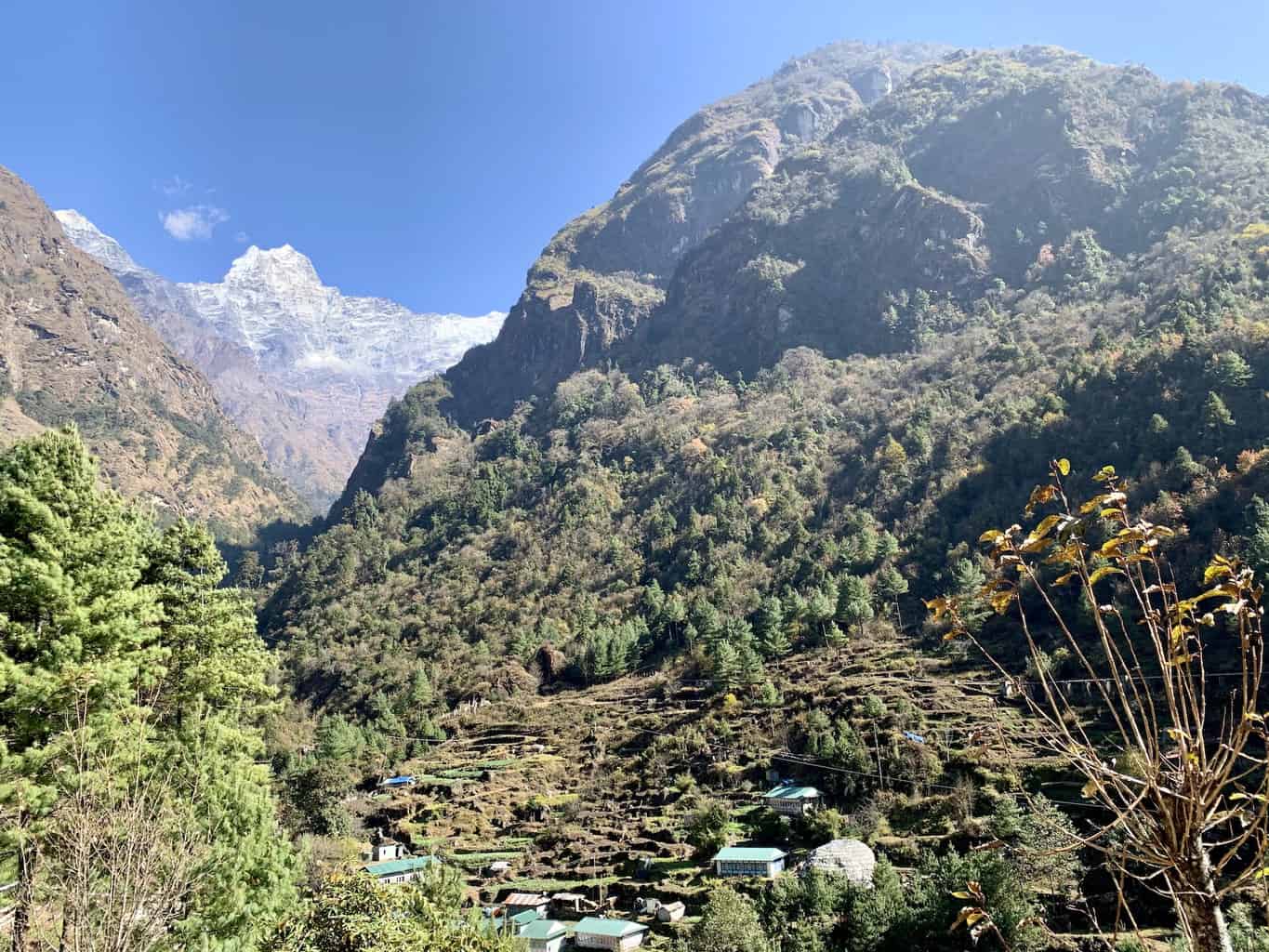
After 10 days of exploring some of the top natural beauty that the Himalayas has to offer, it is time to finish up your Everest Base Camp trek. On day 11, you will trek from Namche to Bazaar to Lukla, before heading back to Kathmandu the next day.
This guide will get you prepared for the hike as it gives you a complete overview of what to expect on day 11 of the trek.
* Affiliate Disclosure : This post may contain affiliate links, which means I may receive a commission if you make a purchase through the links provided, at no additional cost to you. Thanks for supporting the work I put into TripTins!
1) Namche Bazaar to Lukla Trek Facts
Below will be some helpful facts to know about the hike so you have a better idea of what to expect up on the trail between Namche Bazaar and Lukla.
Everest Base Camp Trek Day 11: Namche Bazaar to Lukla
Starting Point: Namche Bazaar
Namche Bazaar Elevation : 11,286 feet / 3,440 meters
Ending Point : Lukla
Lukla Elevation : 9,318 feet / 2,840 meters
Distance : 11.9 miles / 19.1 kilometers
Duration : 7 hours
Elevation Gain : 2,904 feet / 885 meters
Net Elevation Gain : -1,968 feet / -600 meters
*Elevation gain is the true amount of elevation gained for the portion of the trail – although a downhill trail, there will be still be plenty of uphill sections throughout. Net elevation is just the difference in elevation between Namche Bazaar and Lukla.
» Learn more about the various distances, elevations, and durations of the Everest Base Camp Trek
» Learn more about flying into the region in the Kathmandu to Lukla Flight Experience Guide
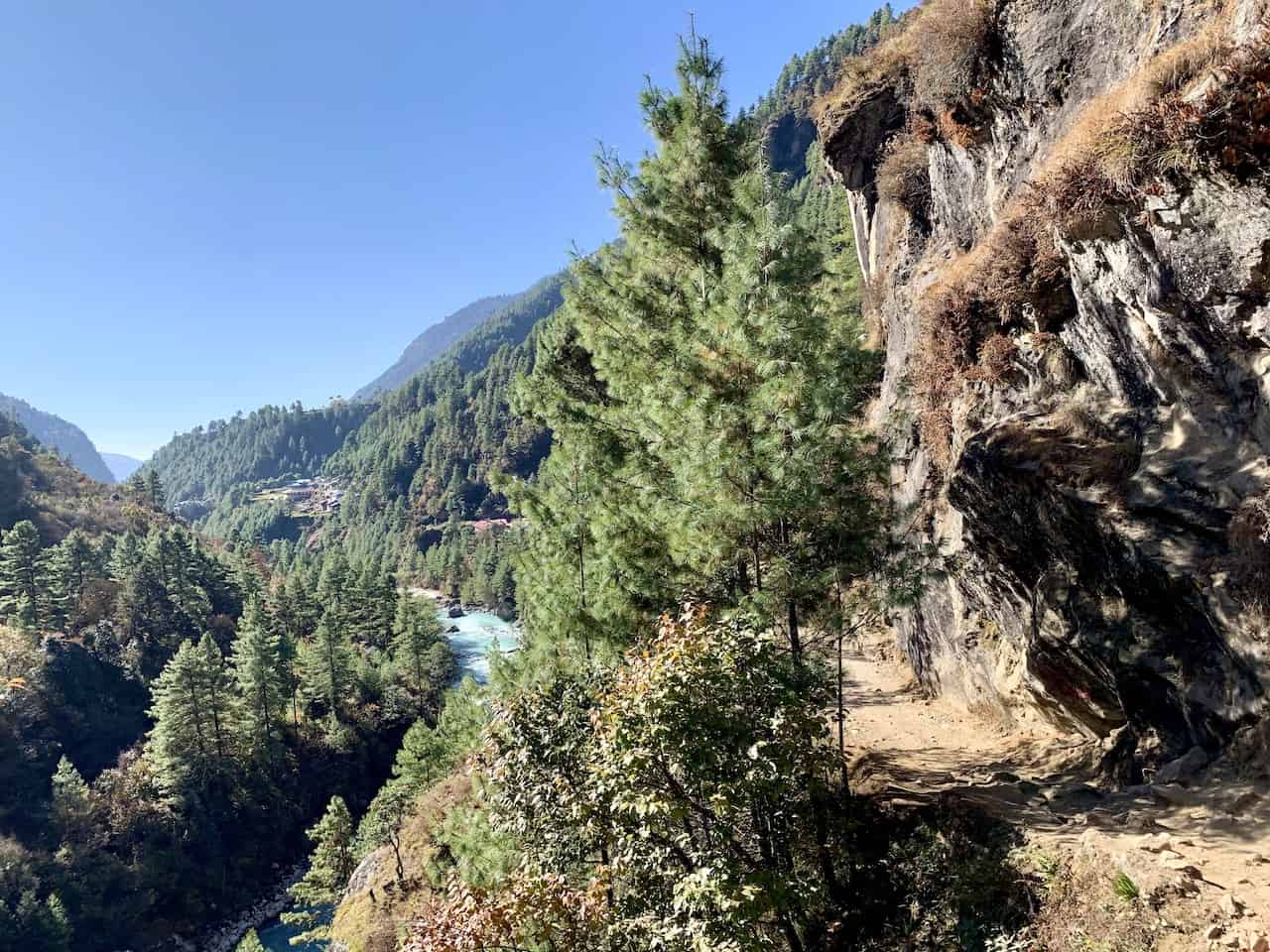
2) Namche Bazaar to Lukla Elevation Profile
Below you can get a sense of the elevation profile between Namche Bazaar and Lukla. Although you will have a large net elevation loss for the day, there will still be uphill sections to make your way through during the trek, resulting in nearly 3,000 feet of elevation gain.
The hike on day 11 will essentially be the opposite route of days 1 and 2, which go from Lukla to Phakding, and then Phakding to Namche Bazaar.
Right when you leave Namche Bazaar, you will begin to lose elevation relatively quickly. After that initial rapid descent, the elevation loss rate will be begin to slow down for the next 10 km / 6 miles or so.
But the last portion of trail will actually be an uphill climb as you make your way back to Lukla and finish up the Everest Base Camp route.
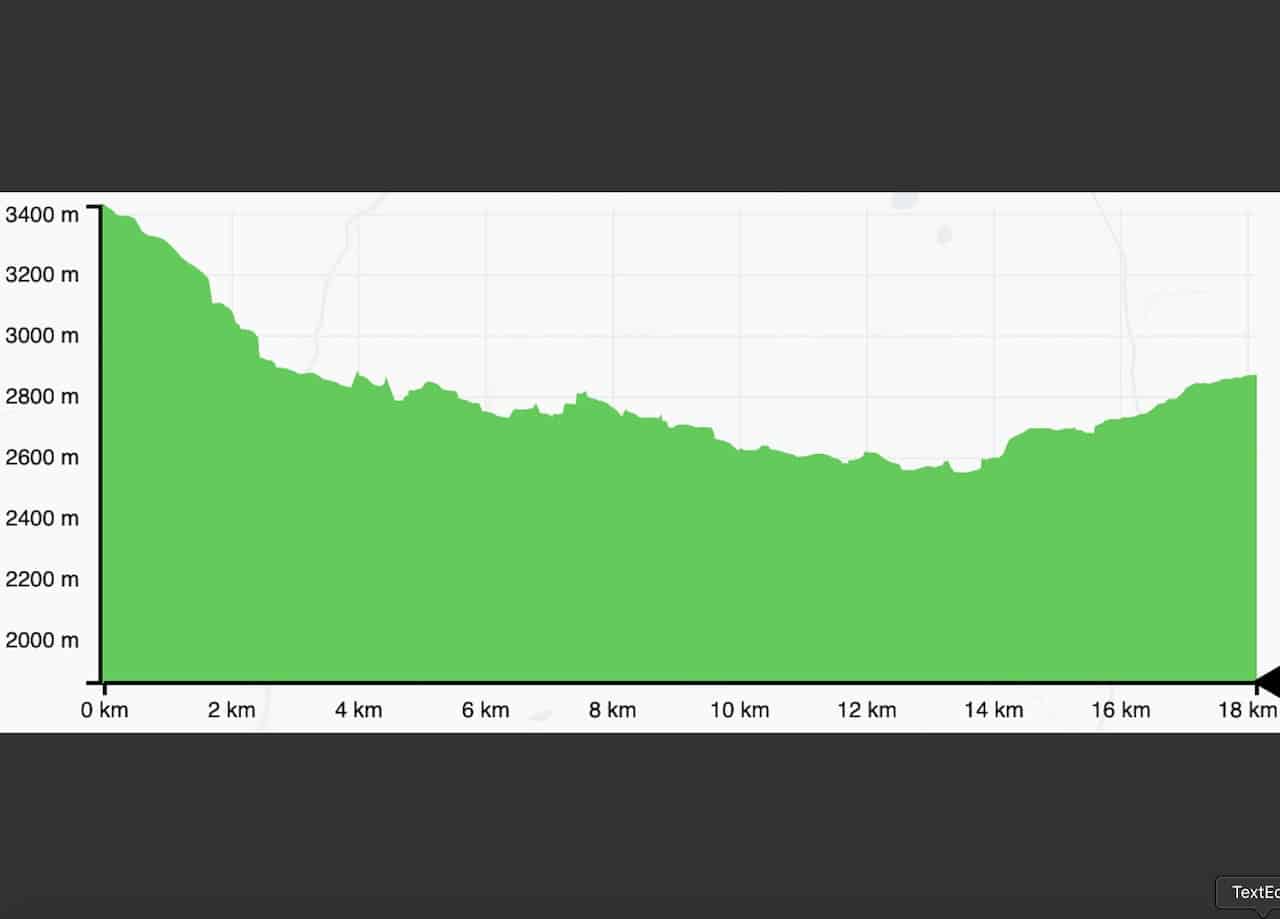
3) Trekking Map
I have also included a trekking map view of the route between Namche Bazaar and Lukla to give you a better sense of the hiking layout.
It is quite a long trek on day 11 as you make a 19 km / 12 mile journey back down the valley.
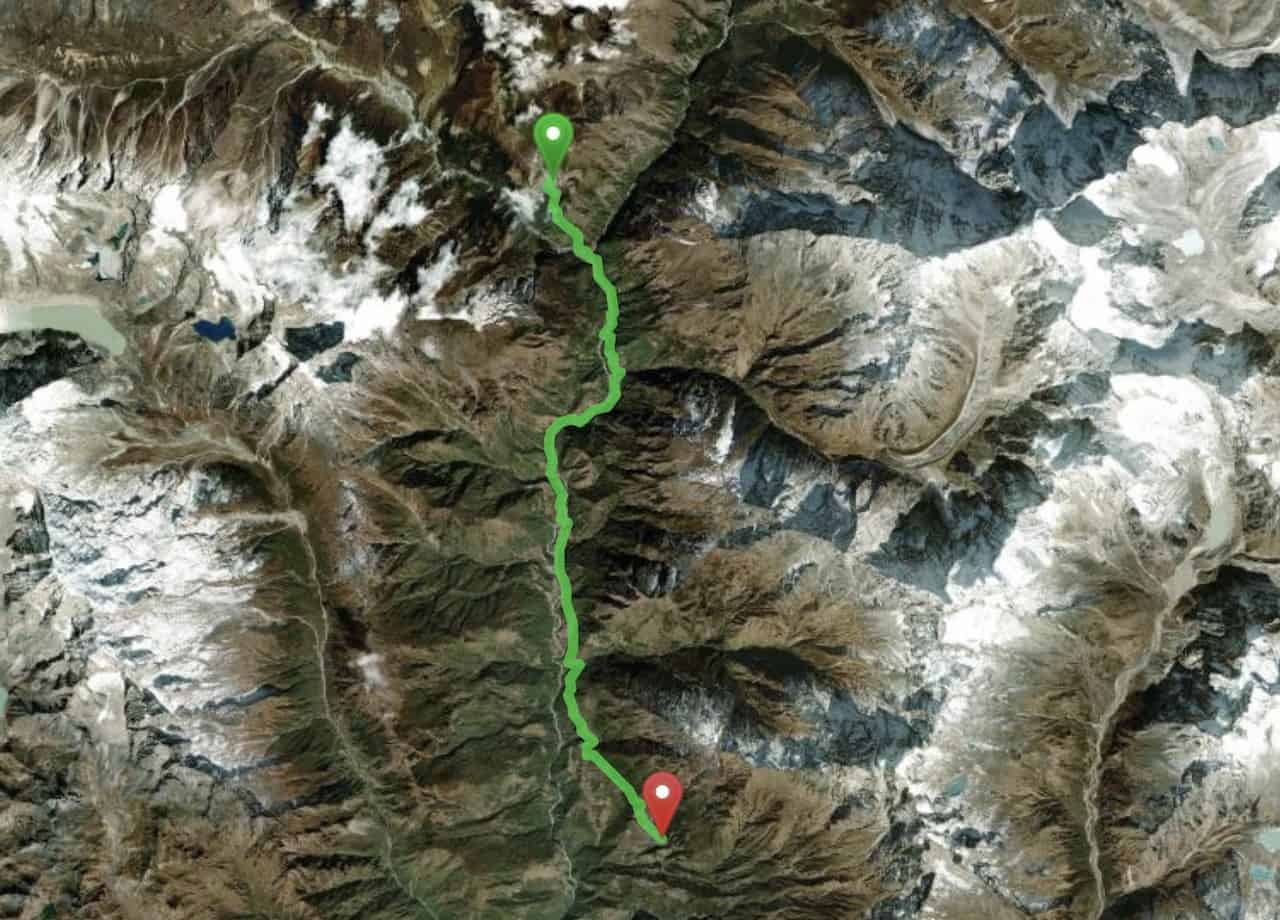
4) Everest Base Camp Trek Packing List
You will want to pack accordingly for this 11-day trek in the Himalayas. I put together a complete Everest Base Camp Packing List that goes over every single item I brought along on the trail. Below you can find just some of those recommended items that are including on the list:
- Hiking Socks: Darn Tough Merino Wool Crew Mens | Darn Tough Merino Wool Crew Womens
- Hiking Pants: Eddie Bauer Men’s Guide Pro Pants | Eddie Bauer Women’s Guide Pro Pants
- Fleece: Columbia Men’s Ascender Softshell | Columbia Women’s Kruser Ridge II Softshell
- Rain Jacket: Columbia Men’s Watertight II | Columbia Women’s Arcadia II
- Hiking Shoes: KEEN Men’s Targhee III | KEEN Women’s Targhee III
- Hiking Backpack: Osprey Atmos 65 | Osprey Renn 65
- Trekking Map | NatGeo Waterproof Map
- Solar Power Bank | Anker 20,000mAh Solar Power Bank
- Deodorizing Body Wipes | Alcala Bamboo Deodorizing Body Wipes
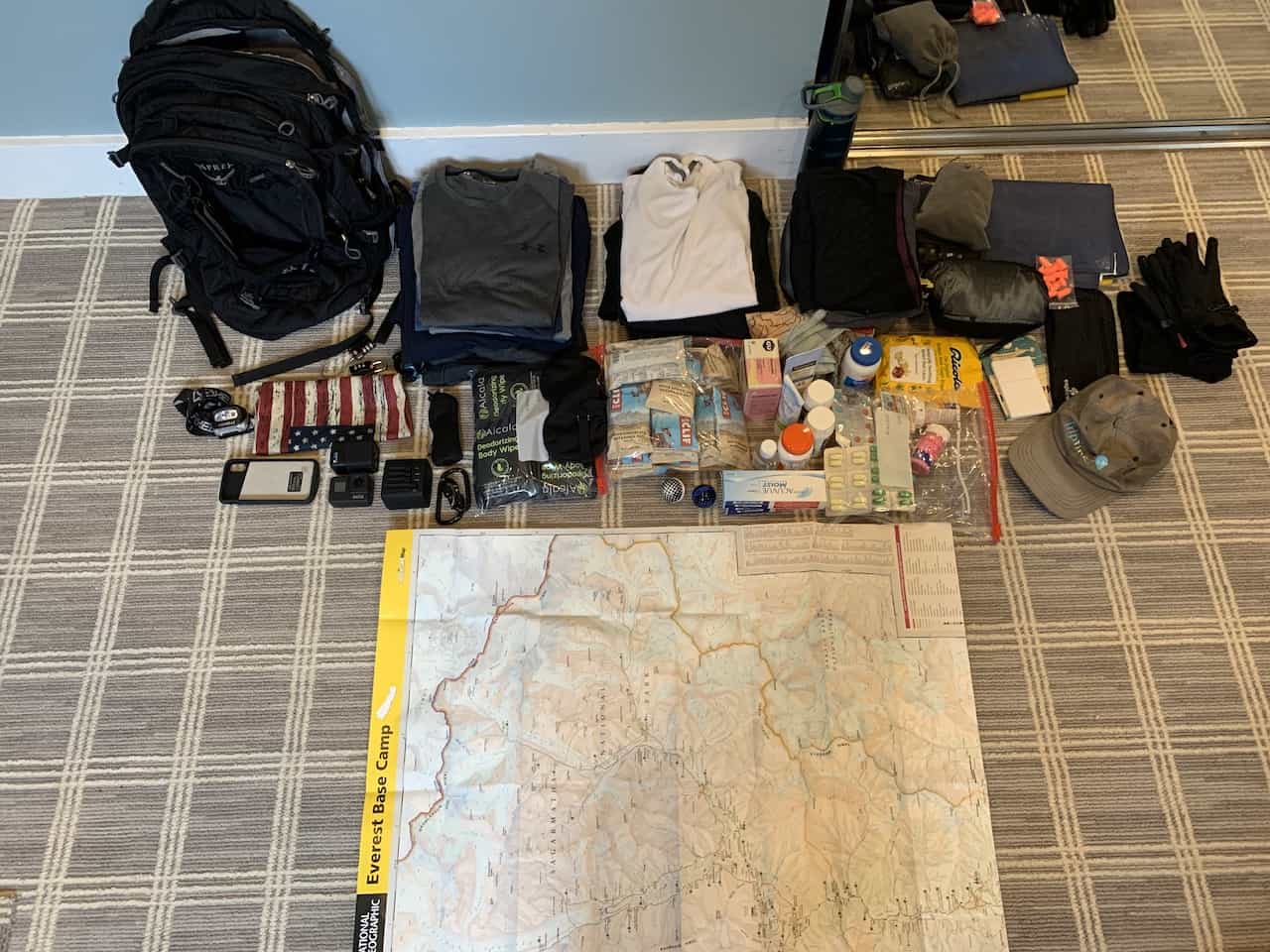
5) Namche Bazaar to Lukla Trek
Note: during the day you will pass by a few checkpoint spots (the same ones you would have pass on the way up).
Be sure you keep your 2 permits in a safe spot throughout the duration of the trek as you will need to show them here again.
By now you should be an expert on trekking through Sagarmatha National Park as you have already completed over 100 km / 60 miles of trail over the last 10 days.
On top of that, day 11 is the same hike that you already completed on days 1 and 2, so nothing should be too new here for you.
After checking out of your Namche teahouse and having a nutritious breakfast, it is time to hit the trail. You will make your way down the stone steps to the bottom of the Namche village and follow the trail towards Lukla.
Right of the bat you will begin to lose that elevation and head down the dirt/stone paths. After around 45 minutes or so of trekking you will arrive back at the rest stop area (from the end of day 2), where you can now get your final glimpse of Mount Everest.
After this point, you no longer will get any more views of the mountain. Although it is just a tiny portion of the peak through the trees, it is still a beautiful view to take in.
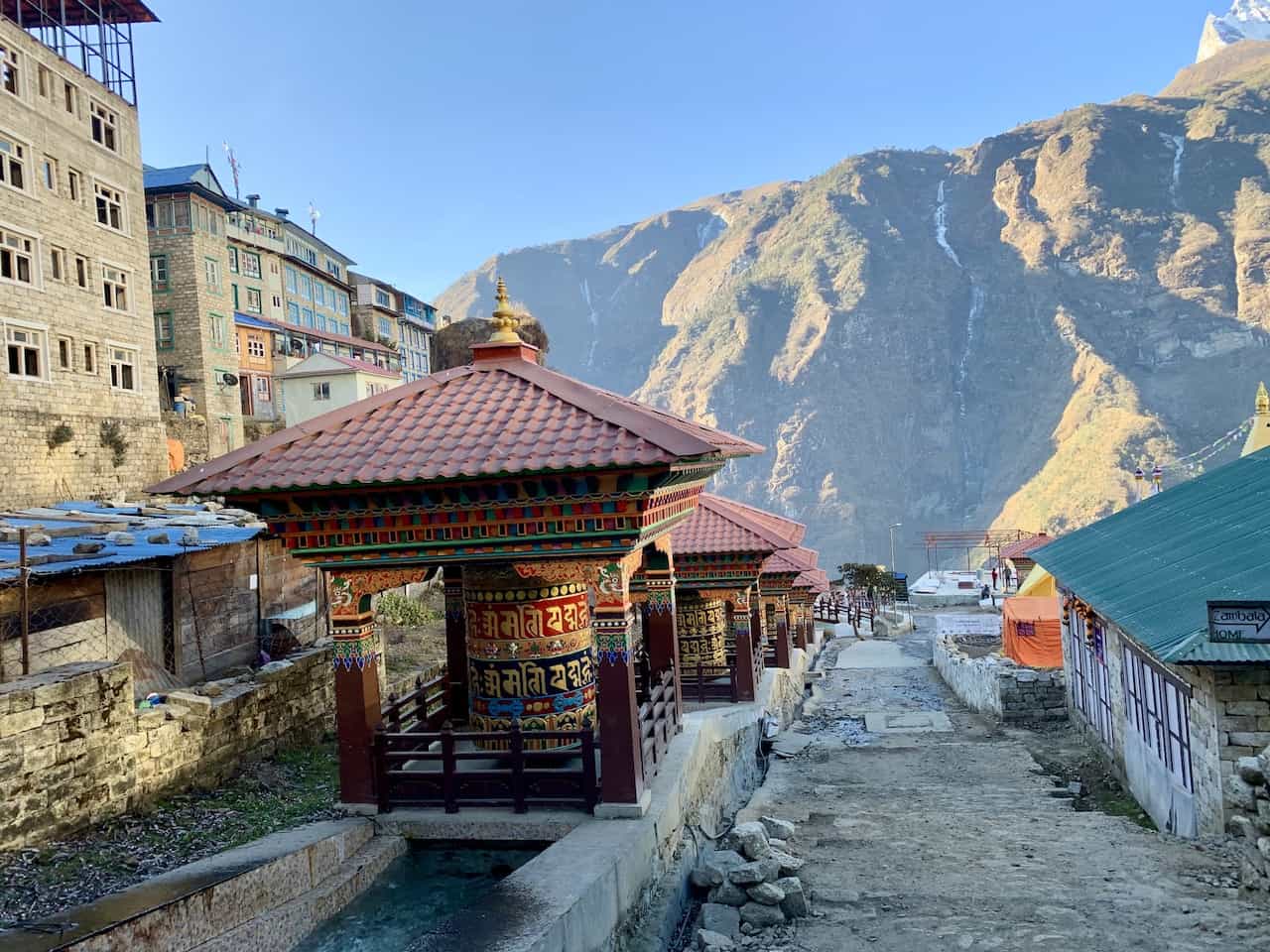
The path will continue downwards from there, where you will head down a mixture of stone steps and dirt pathways, and cross over some suspension bridges as well.
You will get to walk right alongside the river as you finish up that initial steep decline section and will now be walking on a much more moderate decline as you continue the trek.
Although most of this section is downhill, you will also come across a few uphill climbs as well, so do be prepared for those as you make your way along.
Throughout this portion of trail, you will get some beautiful mountain and river views in, as you pass by small villages and Sherpa stones and you will eventually end back in the village of Phakding.
Considering travel insurance for the Everest Base Camp Trek? World Nomads offers coverage for more than 150 adventure activities as well as emergency medical, lost luggage, trip cancellation and more. For years, World Nomads has been protecting, connecting & inspiring independent travelers, offering travel insurance & safety advice to help you travel confidently. Their mission is to support and encourage travelers to explore their boundaries . World Nomads has simple and flexible travel insurance that has been designed by travelers for travelers. Even if you leave home without travel insurance or your policy runs out, you can buy or extend out on the road. Get a quote for a World Nomads travel insurance policy today!

By now you are you a bit more than half way to Lukla, so it would be a great spot to have some lunch, relax, and rest those legs for a bit before finishing up the very last portion of trail.
After leaving Phakding, you will continue to make your way further down the valley with more river views, suspension bridges, and mountain ranges out in front of you.
However, over the last 4 km / 2.5 miles of the trek, instead of dealing with that moderate decline you will be dealing with a moderate incline instead.
The path won’t be too technical but you will be dealing with several sections of stairs and an incline path all the way through. There will be a few more small villages that you pass by before you enter the outskirts of Lukla.
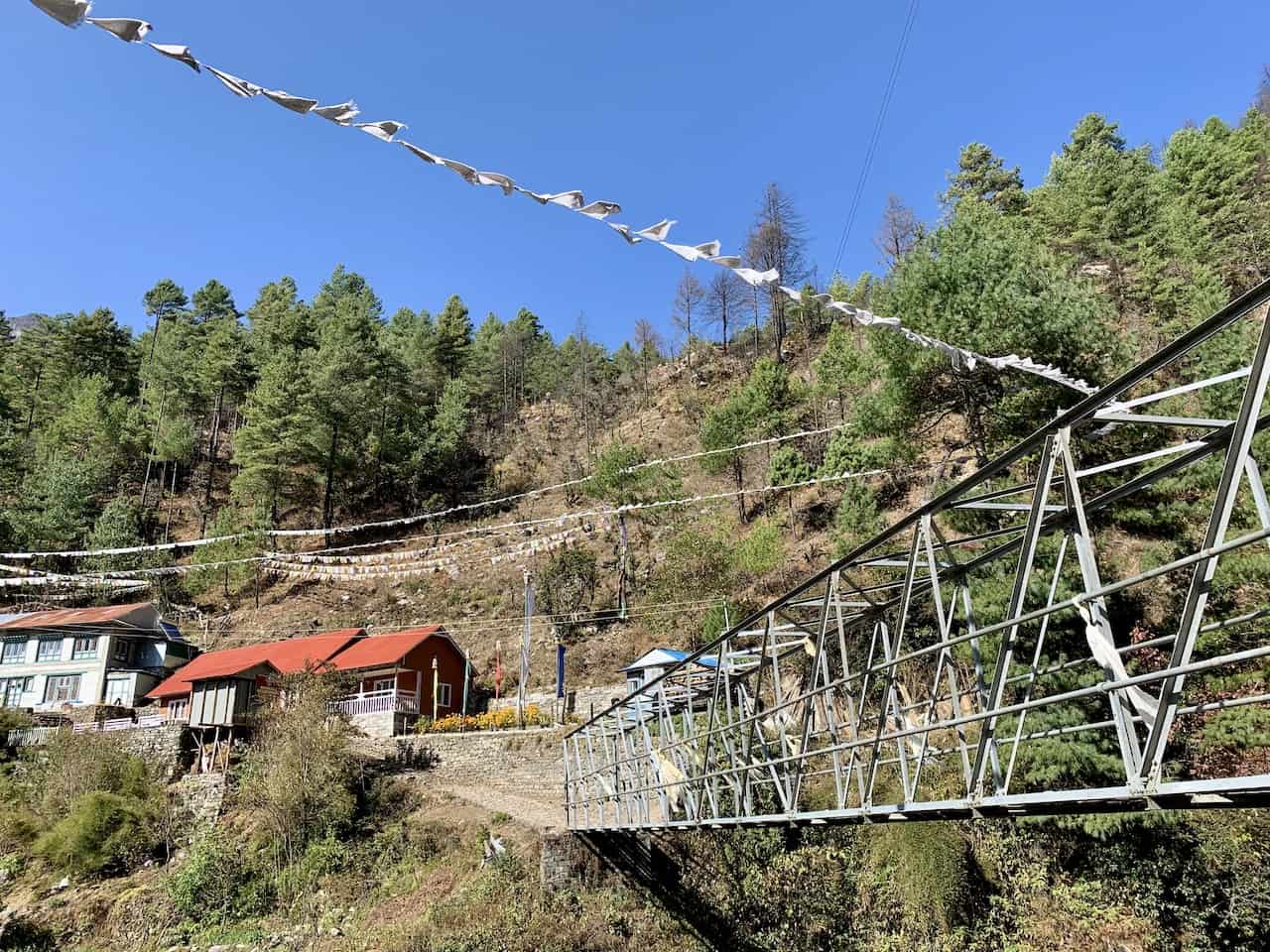
Congratulations! After 11 days of trekking, more than 120 km / 76 miles, and 7,000+ meters / 24,000 feet of true elevation gain, you have completed the one and only Everest Base Camp trek. It is no easy feat to accomplish and you should feel very satisfied for getting it done.
6) Where to Stay in Lukla
After entering Lukla, you will walk your way through town, and onto your teahouse for the last night on the Everest Base Camp trek.
Lukla has plenty accommodations to choose from and you should have no trouble finding a spot for the night. I decided to stay directly next to the airport at the Buddha Lodge Lukla.
Luckily when I was there, the teahouse had hot water showers (for free too!), so it was a great way to clean up after so much trekking. While it is nice to be right near the airport for the early morning flight on day 12, it is really no more than a 10-minute walk to the airport no matter where you are staying in town.
On day 12, head to the airport around 1 hour before your flight, check in, drop your bag off and head back to Kathmandu to end a successful Everest Base Camp trek adventure in the Himalayas.
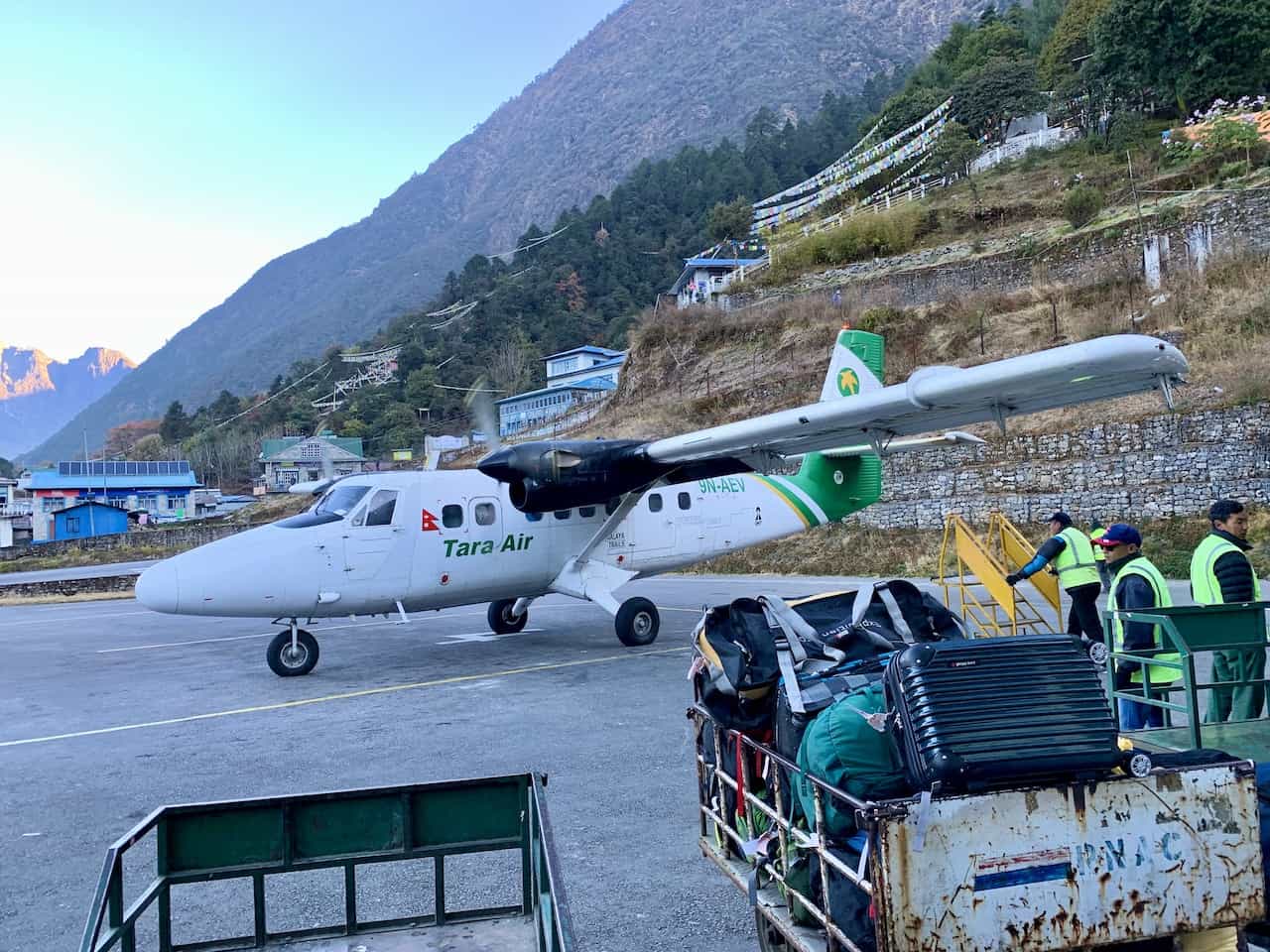
Take a look at this in depth overview of the Everest Base Camp Trek as well as the below guides I put together for each day of the journey:
Day 1 – Lukla to Phakding
Day 2 – Phakding to Namche Bazaar
Day 3 – Hotel Everest View Acclimatization
Day 4 – Namche Bazaar to Tengboche
Day 5 – Tengboche to Dingboche
Day 6 – Nangkartshang Acclimatization
Day 7 – Dingboche to Lobuche
Day 8 – Lobuche to Gorak Shep & Everest Base Camp
Day 9 – Kalapathar & Gorak Shep to Pheriche
Day 10 – Pheriche to Namche Bazaar
Day 11 – Namche Bazaar to Lukla
That about wraps up a recap of the Namche Bazaar to Lukla trek. If you have any questions about the Everest Base Camp trek in general feel free to add them in below.
Be sure to also check out the other Nepal itineraries and guides up on the site.
Have fun out there and safe travels!

Related posts:
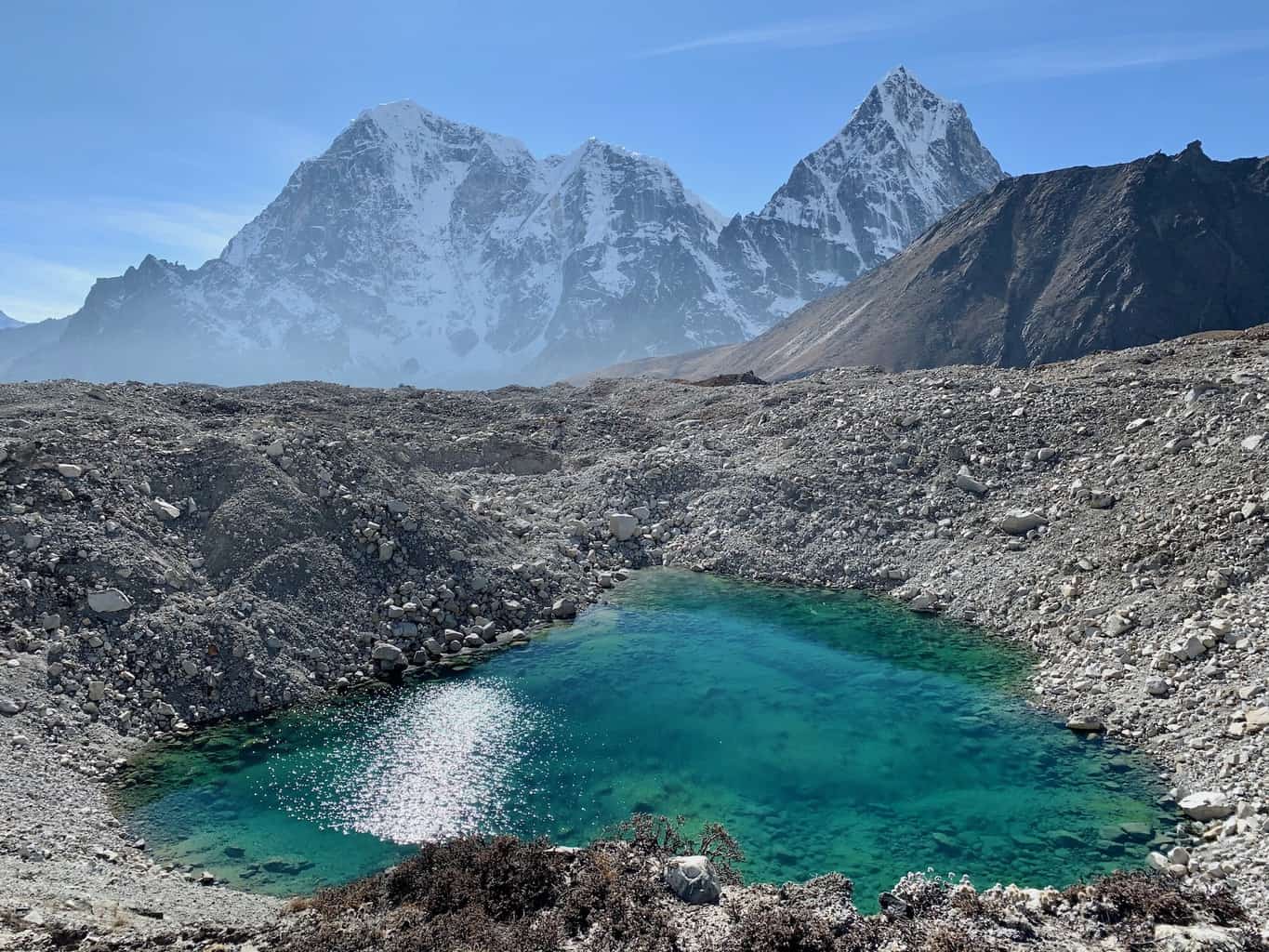
Sharing is caring!
Wednesday 7th of September 2022
Hi, planning to come in February 2023.,after my trim in Malesia. Question: Is it possible to leave my big suitcase in Lukla and have with me just back pack and big bag? Thank you
Hi Mladen - I would highly recommend leaving any additional baggage in Kathmandu. The plane to Lukla is quite small and there is no need to take more than what you need with you. Many hotels in Kathmandu would keep your belongings safe while you trek to EBC. Enjoy!
Michael Leigh
Monday 7th of December 2020
Hello Is this possible to do sometime IN April 2021?I have no prior experience in trekking or hiking
Wednesday 9th of December 2020
Hey Michael – yes April is one of the peak seasons to hike to Everest Base Camp (April/May and October/November). I would not recommend doing this trek with no prior hiking experience. Start off with some local hikes and build your way up from there. Remember this is an 11 day hike with 4-8 hours a day of hiking. When you take in the altitude as well as daily elevation gain, it is a pretty tough trek overall.
Hope that helps. Feel free to let me know if you have any other questions.

Namche Bazaar to Everest Base Camp Trek: Your Ultimate Guide

The Namche Bazaar to Everest Base Camp trekking route is one of the most popular and iconic treks in the world. It offers breathtaking views of the Himalayan mountains and takes you through some of the most beautiful and remote landscapes on earth.
In this article, we will provide a comprehensive guide to the Namche Bazaar to Everest Base Camp trekking route, including information on the distance, route, cost, difficulty level, safety tips, and much more. We will also address some of the common questions and keywords related to this trek, such as the closest town to Everest Base Camp, the best route for the Everest Base Camp trek, and whether a beginner can go to Everest Base Camp. By the end of this article, you will have a better understanding of what it takes to complete this challenging trek and be prepared for an unforgettable adventure in the Himalayas.
Table of Contents

The Namche Bazaar to Everest Base Camp Trekking Route
The Namche Bazaar to Everest Base Camp trekking route is a challenging and rewarding journey that takes you through the heart of the Khumbu region in Nepal. The trek starts in Lukla, a small town situated at an altitude of 2,800 meters, and takes you through the famous Sherpa village of Namche Bazaar. From Namche Bazaar, the trek continues to the village of Tengboche, famous for its ancient monastery and stunning views of Mount Everest.
The route then takes you through Dingboche, Lobuche, and Gorak Shep, before finally reaching the Everest Base Camp. The trek back is via the same route or can be via the alternative route through the famous viewpoint of Kalapatthar, offering stunning views of Mount Everest and the surrounding peaks.
Distance and Duration
The total distance covered on the Namche Bazaar to Everest Base Camp trek is approximately 130 kilometers (81 miles), round trip. The duration of the trek can vary depending on the route, pace, and acclimatization schedule. Generally, it takes around 12 to 14 days to complete the trek, including rest days for acclimatization.
Difficulty Level
The Namche Bazaar to Everest Base Camp trekking route is considered a challenging trek, as it involves high altitude trekking and several steep ascents and descents. Trekkers need to be physically fit and mentally prepared for the trek. Proper acclimatization is essential to prevent altitude sickness, which can be life-threatening.
Cost of the Trek
The cost of the Namche Bazaar to Everest Base Camp trek can vary depending on various factors such as the duration of the trek, route, and package. On average, the cost can range from $1,200 to $3,000 per person, excluding international airfare.
Common Questions and Keywords
Can you see mount everest from namche bazaar.
Yes, you can see Mount Everest from Namche Bazaar, which is situated at an altitude of 3,440 meters (11,286 feet). Trekkers can enjoy stunning views of Mount Everest and other surrounding peaks from various viewpoints in Namche Bazaar.
What is the Closest Town to Everest Base Camp?
The closest town to Everest Base Camp is Gorak Shep, situated at an altitude of 5,164 meters (16,942 feet). It is the last settlement before reaching the base camp and offers basic accommodation and facilities.
Is Namche Bazaar Worth Visiting?
Yes, Namche Bazaar is definitely worth visiting, as it is one of the most vibrant and picturesque villages in the Khumbu region. It offers a glimpse into the unique Sherpa culture, with its colorful prayer flags, traditional houses, and bustling markets.
Can a Beginner Go to Everest Base Camp?
Yes, a beginner can go to Everest Base Camp, but they need to be physically fit and mentally prepared for the trek. It is recommended to have some prior trekking experience and to undergo proper training and preparation before embarking on the trek.
Are There Shops at Everest Base Camp?
No, there are no shops at Everest Base Camp, as it is a temporary campsite used by mountaineers and trekkers during the climbing season. Trekkers need to carry all the necessary supplies and equipment with them during the trek.
Which Route is Best for Everest Base Camp Trek?
The best route for the Everest Base Camp trek depends on various factors such as duration, fitness level, and personal preference. The two most popular routes are the classic route via Nam
As you continue your trek, you’ll pass through Tengboche, Dingboche, and Gorak Shep before finally reaching Everest Base Camp. The trek can be strenuous, with varying altitudes and rugged terrain, but the stunning views and the feeling of accomplishment upon reaching your destination make it all worthwhile.
Now that we have a general idea of the trek, let’s answer some common questions that trekkers may have before embarking on this journey.
How much will it cost to go to Everest Base Camp?
The cost of the trek can vary greatly depending on a number of factors such as the time of year, the trekking agency, the length of the trek, and the level of luxury or basicness desired. On average, a basic 12-16 day trek can cost anywhere from $1,000 to $1,500 USD. However, for a more luxurious trek with added amenities, the cost can be upwards of $5,000 USD.
Is it hard to walk to Everest Base Camp?
The trek to Everest Base Camp is considered to be moderate to difficult in terms of physical exertion. The varying altitudes, rugged terrain, and changing weather conditions can make it challenging. However, with proper physical conditioning and acclimatization, anyone with a moderate level of fitness can accomplish this trek.
Can you see Everest from Namche Bazaar?
Yes, on a clear day, you can see the majestic peak of Everest from Namche Bazaar. In fact, many trekkers take a rest day in Namche Bazaar to acclimatize and explore the town’s unique culture and stunning views.
What is the closest town to Everest Base Camp?
Gorak Shep is the closest town to Everest Base Camp. It is situated at an altitude of 5,164 meters and serves as the final resting spot for trekkers before their ascent to the base camp.
How long is the trek from Lukla to Everest Base Camp?
The trek from Lukla to Everest Base Camp is approximately 65 kilometers or 40 miles long. The trek generally takes 12-16 days, depending on the itinerary and pace of the trekker.
Is Namche Bazaar worth visiting?
Yes, Namche Bazaar is definitely worth visiting. It is a unique town with a rich cultural heritage and stunning views of the surrounding peaks. Many trekkers choose to spend a rest day in Namche Bazaar to acclimatize and explore the town’s markets, restaurants, and museums.
Can a beginner go to Everest Base Camp?
Yes, a beginner with proper physical conditioning and acclimatization can go to Everest Base Camp. It is recommended that beginners take a slower pace and allow for extra rest days to properly acclimatize to the higher altitudes.
Are there shops at Everest Base Camp?
Yes, there are a few shops at Everest Base Camp that sell basic supplies such as snacks, water, and souvenirs.
Which route is best for Everest Base Camp Trek?
The most popular and well-established route for the Everest Base Camp Trek is the route that goes through Namche Bazaar. It offers stunning views and a chance to experience the unique culture of the region.
Is it hard to breathe at Everest Base Camp?
At an altitude of 5,364 meters, the air is thinner and oxygen levels are lower at Everest Base Camp. This can make breathing more difficult, but with proper acclimatization and the use of medication such as Diamox, most trekkers can adjust to the altitude.
Is there electricity in Namche Bazaar?
Yes, there is electricity in Namche Bazaar, but it can be unreliable at times. Many teahouses and lodges have backup generators
Another popular route is the Gokyo Lakes trek, which offers stunning views of the turquoise Gokyo Lakes, the Ngozumpa glacier, and the surrounding Himalayan peaks. This trek also takes you to the Everest Base Camp and includes a hike up Gokyo Ri, a peak that offers a breathtaking panoramic view of the entire Everest region.
Overall, whether you choose the classic Namche Bazaar to Everest Base Camp trek or the Gokyo Lakes trek, you are in for an unforgettable experience that will leave you with a newfound appreciation for the beauty and majesty of the Himalayas.
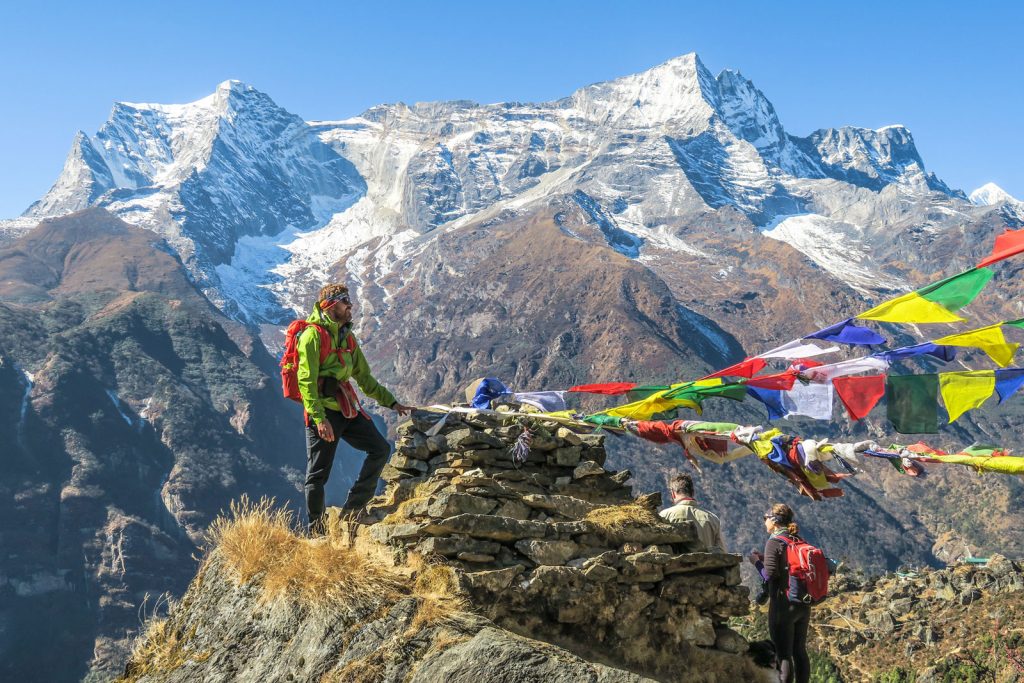
Everest Base Camp Trekking Permits
One of the most important things to keep in mind when planning your Everest Base Camp trek is that you will need to obtain permits before you can embark on your journey. These permits are necessary to regulate the number of visitors to the area and to help preserve the natural beauty and cultural heritage of the region.
Explanation of Permits Required for the Trek
There are two permits that you will need to obtain for the Everest Base Camp trek: the Sagarmatha National Park Entry Permit and the TIMS (Trekkers’ Information Management System) card.
The Sagarmatha National Park Entry Permit is issued by the Nepal Department of National Parks and Wildlife Conservation and is required for entry into the Sagarmatha National Park, which includes the Everest Base Camp trekking route. The permit costs USD 30 per person and is valid for multiple entries for a period of 30 days.
The TIMS card is issued by the Trekking Agencies Association of Nepal (TAAN) and is a way for the government to ensure the safety and security of trekkers on the trail. The card costs USD 20 per person for independent trekkers and USD 10 per person for trekkers traveling with a registered trekking agency. The card is valid for the entire duration of your trek.
Cost of Permits
The total cost of the permits required for the Everest Base Camp trek is USD 50 per person for independent trekkers and USD 40 per person for trekkers traveling with a registered trekking agency. Keep in mind that these costs are in addition to the cost of your trekking package and other expenses such as accommodations, meals, and equipment.
Information about Obtaining Permits
You can obtain your Sagarmatha National Park Entry Permit and TIMS card either through a registered trekking agency or by visiting the Nepal Tourism Board in Kathmandu. If you choose to obtain the permits yourself, you will need to bring your passport, two passport-sized photos, and the permit fee in cash.
If you choose to go through a registered trekking agency, they will typically take care of obtaining the permits for you as part of their package. This can save you time and hassle, and ensure that you have all the necessary permits before starting your trek.
Conclusion:
Obtaining the necessary permits for the Everest Base Camp trek is an important part of the planning process. By understanding the requirements and costs associated with the permits, you can ensure that you are fully prepared for your journey. Whether you choose to obtain the permits yourself or through a registered trekking agency, make sure that you have all the necessary documentation before embarking on your trek.
Everest Base Camp Trekking Packages
If you’re planning to go on the Everest Base Camp trek, you’ll have a number of package options to choose from. These packages usually include transportation, accommodation, meals, permits, and a guide. The cost of the package will depend on the duration of the trek, the level of service you require, and the season in which you’ll be trekking.
Overview of Everest Base Camp Trekking Packages
There are a variety of trekking packages available for Everest Base Camp. Some packages are more basic and budget-friendly, while others are more luxurious and expensive. Most packages will include the following:
- Transportation: This usually includes a flight from Kathmandu to Lukla, which is the starting point for the trek. Some packages also include transportation back to Kathmandu.
- Accommodation: This includes a mix of teahouse lodges and camping. Teahouses are basic guesthouses that provide a bed and meals. Camping is usually included for those who want a more adventurous experience.
- Meals: Packages usually include three meals a day, which are provided by the teahouses or camping staff.
- Permits: The permits required for the trek, including the Sagarmatha National Park permit and the TIMS card.
- Guide: Most packages include a guide, who will provide information about the trail, the culture, and the environment. A guide is especially important for those who are not experienced trekkers.
Comparison of Different Packages
When choosing an Everest Base Camp trekking package, it’s important to compare different options to find the one that best suits your needs and budget. Some factors to consider include:
- Duration of the trek: Most packages range from 12 to 16 days, but some may be longer or shorter.
- Level of service: Basic packages will be less expensive but offer fewer amenities, while luxury packages will be more expensive but provide more comfort and service.
- Season: Peak season (October and November) is the most expensive time to trek, while the off-season (June to August) is less expensive.
- Inclusions: Some packages may include extras like helicopter evacuation insurance or additional sightseeing tours.
By comparing different packages, you can find the one that best fits your needs and budget. It’s important to read reviews and ask questions before booking a package to ensure that you’re getting what you expect.
Difficulty Level of the Everest Base Camp Trek
Everest Base Camp Trek is one of the most challenging treks in the world. The trek requires a good level of physical fitness and mental preparation. The trek is not only physically demanding, but also mentally challenging due to the high altitude, harsh weather conditions, and long hours of walking. However, with proper preparation and training, anyone can complete the trek.
Level of Difficulty
The difficulty level of the Everest Base Camp Trek can vary depending on the route taken and the individual’s physical fitness level. The trek is classified as a moderate to strenuous trek, and it can take anywhere from 12 to 16 days to complete. The trek involves long hours of walking and steep ascents and descents. Trekking at high altitudes can also be challenging, as the air gets thinner and oxygen levels decrease, making breathing difficult.
Preparation and Training
Proper preparation and training are essential for completing the trek successfully. It’s recommended to start training at least three months before the trek. Cardiovascular exercises such as running, swimming, and cycling can help improve stamina and endurance. Strength training exercises such as squats, lunges, and leg presses can help build leg muscles necessary for trekking.
Comparison of Different Trekking Routes
There are several trekking routes to Everest Base Camp, each with its own level of difficulty. The most popular route is the classic route that starts from Lukla and passes through Namche Bazaar, Tengboche, Dingboche, Lobuche, and Gorak Shep before reaching Everest Base Camp. This route is moderately difficult and offers stunning views of the Himalayas.
The Gokyo Lakes trek is another popular route that offers a more challenging alternative to the classic route. The trek involves crossing the Cho La Pass, which is at an altitude of 5,420 meters, making it a more strenuous trek.
The Everest Base Camp Trek is a challenging but rewarding trek that requires proper preparation and training. The trek offers stunning views of the Himalayas and provides an opportunity to experience the unique culture and traditions of the Sherpa people. The different trekking routes offer varying levels of difficulty, making it accessible to a wide range of trekkers.
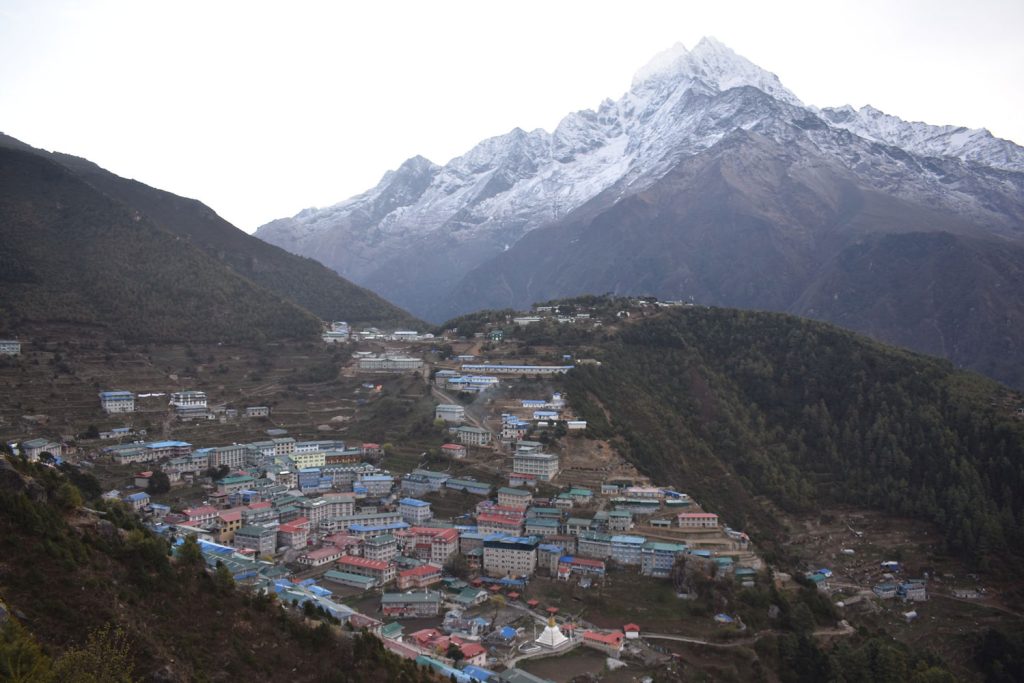
Namche Bazaar: The Gateway to Everest Base Camp
Namche Bazaar, situated in the Khumbu region of Nepal, is a popular stopping point for trekkers en route to Everest Base Camp. It is a vibrant and bustling town that serves as the gateway to the highest mountain in the world. In this section, we will explore the town of Namche Bazaar, its attractions, and its importance as the gateway to Everest Base Camp.
Description of Namche Bazaar
- Namche Bazaar is a small town situated at an altitude of 3,440 meters above sea level.
- It is located on a steep hillside overlooking the Dudh Koshi River valley.
- The town is home to several lodges, restaurants, bakeries, and shops that cater to the needs of trekkers and locals.
- The town is surrounded by beautiful mountain peaks, including Thamserku, Kangtega, and Kongde Ri.
Attractions in Namche Bazaar
- Namche Bazaar has several attractions that are worth visiting, such as the Sherpa Museum, the Namche Monastery, and the Everest View Hotel.
- The Sherpa Museum is dedicated to the history, culture, and traditions of the Sherpa people.
- The Namche Monastery is a beautiful monastery that offers stunning views of the surrounding mountains.
- The Everest View Hotel is a luxury hotel that offers breathtaking views of Mount Everest and the surrounding peaks.
Importance of Namche Bazaar as the gateway to Everest Base Camp
- Namche Bazaar is an important stopover for trekkers on their way to Everest Base Camp.
- It is the last town on the trek where trekkers can stock up on supplies and gear before heading to higher altitudes.
- Trekkers need to acclimatize to the high altitude, and Namche Bazaar offers an ideal place for rest and acclimatization.
- Namche Bazaar is also the center of Sherpa culture and serves as a hub for the Sherpa people.
In conclusion, Namche Bazaar is a must-visit destination for trekkers on their way to Everest Base Camp. It offers a unique opportunity to experience the Sherpa culture and acclimatize to the high altitude before heading to higher altitudes.

Accommodation and Facilities at Everest Base Camp
Trekking to Everest Base Camp is a once-in-a-lifetime experience that requires a lot of preparation and planning. While the trek itself is challenging, it is also an opportunity to explore the stunning landscapes of the Khumbu region, experience the local culture, and make new friends along the way.
Accommodation at Everest Base Camp
After a long and arduous trek, trekkers finally reach Everest Base Camp, which is located at an altitude of 5,364 meters. At this altitude, the air is thin, and the temperature can drop to below freezing at night. However, trekkers need not worry about accommodation as there are many tea houses and lodges available in the area.
The tea houses and lodges at Everest Base Camp offer basic but comfortable accommodation for trekkers. Most tea houses have dormitory-style rooms with shared bathrooms. However, private rooms are also available at some tea houses for those who prefer more privacy.
Facilities at Everest Base Camp
While the facilities at Everest Base Camp are basic, they are sufficient to meet the needs of trekkers. Here are some of the facilities available at Everest Base Camp:
- Electricity: Most tea houses at Everest Base Camp have electricity, which is usually generated by solar panels. However, trekkers are advised to bring their own power banks and batteries as electricity may not be available 24/7.
- Water: Trekkers can buy bottled water or refill their water bottles at the tea houses. However, they are advised to bring water purification tablets or a water filter as the water may not be safe to drink.
- Internet: Some tea houses at Everest Base Camp have Wi-Fi, but the connection may be slow and unreliable. Trekkers are advised to buy a local SIM card with a data plan for better connectivity.
- Shops: There are several shops at Everest Base Camp that sell basic supplies such as snacks, drinks, and trekking gear. Prices may be higher than in other parts of Nepal, so trekkers are advised to bring everything they need from Kathmandu or Namche Bazaar.
Accommodation and facilities at Everest Base Camp are basic but sufficient to meet the needs of trekkers. Trekkers can enjoy comfortable accommodation, electricity, water, and internet at the tea houses and lodges at Everest Base Camp. Additionally, they can buy basic supplies at the shops located in the area.
(open trekking bag photo with some items visible)
Packing List for Everest Base Camp Trekking
When preparing for the Everest Base Camp trek, it’s crucial to pack the right equipment and gear to ensure a safe and comfortable journey. Here is an overview of the essential items to pack:
Clothing and Footwear
- Base layers: Moisture-wicking tops and bottoms
- Insulating layers: Fleece or down jacket
- Waterproof and windproof jacket and pants
- Hiking boots with ankle support
- Hiking socks
- Hat, gloves, and scarf
Gear and Equipment
- Sleeping bag and liner
- Trekking poles
- Headlamp with extra batteries
- Water bottles and hydration system
- Personal first aid kit
- Sunscreen and lip balm
- Insect repellent
- Toilet paper and wet wipes
- Camera and spare batteries
- Portable charger and charging cables
Miscellaneous Items
- Cash and credit cards
- Passport and trekking permits
- Travel insurance
- Snacks and energy bars
- Books and games
When packing, keep in mind the weight limit for flights to and from Lukla, which is 15kg (33lbs) for checked baggage and 5kg (11lbs) for carry-on. It’s also recommended to pack in layers to adjust to changing weather conditions during the trek. Don’t forget to leave some space in your backpack for souvenirs and other items you might pick up during the trek.
Remember, it’s important to pack only what you need and to avoid overpacking to prevent unnecessary strain on your back and knees. Keep your backpack weight within your physical limits to make your trek enjoyable and comfortable.
Altitude Sickness and Safety Tips
Altitude sickness is a serious concern for trekkers who are planning to hike to the Everest Base Camp. As you ascend higher, the air pressure decreases, and the air becomes thinner, which can lead to altitude sickness. It’s important to be aware of the symptoms and take preventive measures to avoid altitude sickness during the trek. Here are some tips for staying safe during your Everest Base Camp trek:
Altitude Sickness and its Symptoms
Altitude sickness, also known as acute mountain sickness (AMS), is caused by a lack of oxygen in the body at high altitudes. The symptoms of altitude sickness include:
- Nausea and vomiting
- Shortness of breath
- Loss of appetite
- Trouble sleeping
If you experience any of these symptoms, it’s important to take immediate action to prevent the condition from getting worse.
Tips for Acclimatization and Prevention of Altitude Sickness
To avoid altitude sickness, it’s important to take time to acclimatize as you ascend higher. Here are some tips for acclimatization and prevention of altitude sickness:
- Ascend gradually and take rest days at regular intervals
- Stay hydrated by drinking plenty of water
- Avoid alcohol and smoking
- Eat a balanced diet with enough calories to sustain the trek
- Take medication to prevent altitude sickness if necessary, under the guidance of a doctor
Safety Tips for Trekking to Everest Base Camp
Trekking to Everest Base Camp can be challenging and dangerous if proper safety precautions are not taken. Here are some safety tips to keep in mind during the trek:
- Always trek with a guide or a group
- Carry a first-aid kit and know how to use it
- Dress appropriately for the weather conditions and wear sturdy hiking boots
- Keep yourself warm and dry to prevent hypothermia
- Follow the instructions of your guide and pay attention to the weather conditions
- Be prepared for emergencies and carry a satellite phone or a communication device
By following these safety tips and taking preventive measures for altitude sickness, you can have a safe and enjoyable trekking experience to the Everest Base Camp.
Hiring Porters for the Namche Bazaar to Everest Base Camp Trek
The Namche Bazaar to Everest Base Camp trek is a challenging journey that requires a lot of physical exertion. Carrying a heavy load of equipment and supplies can be daunting, and that’s where hiring porters comes in. Porters are experienced locals who can carry your luggage and supplies, allowing you to focus on the trek itself. Here’s what you need to know about hiring porters for the trek:
How to hire a porter for ebc trek:
- Contact a trekking agency: Most trekking agencies in Kathmandu and Namche Bazaar offer porter services. You can contact them via email or phone to arrange the hiring.
- Discuss your requirements: Let the agency know how much luggage you have, and how many porters you need. They will provide you with a quote based on the distance and duration of the trek.
- Meet the porters: Once you arrive in Namche Bazaar, you will meet your porters. You can discuss the details of the trek with them, such as how many hours you will walk each day and where you plan to stay overnight.
Pre-Booking and Availability of porters for everest base camp trek:
Porters are readily available in Namche Bazaar and Kathmandu. However, it’s important to book them in advance during peak season (March to May and September to November) as they get booked up quickly.
Cost of hiring a porter for the namche to ebc trek:
The cost of hiring a porter for the Namche Bazaar to Everest Base Camp trek can vary depending on the season and duration of the trek. On average, you can expect to pay around USD $20-25 per day per porter, which includes their meals, accommodation, and insurance. You will also need to cover the cost of their transportation to and from the starting point of the trek.
Suggestions:
- Choose a reputable trekking agency: It’s important to choose a reputable agency to ensure that you get experienced and reliable porters.
- Pack light: While porters can carry a considerable amount of weight, it’s still important to pack light. Keep in mind that the weight limit per porter is typically 30 kg.
- Be respectful: Porters are an essential part of the trekking experience, and they work hard to make your journey comfortable. Be respectful and kind to them throughout the trek.
Hiring porters can make the Namche Bazaar to Everest Base Camp trek more enjoyable and less challenging. With the help of experienced locals, you can focus on the breathtaking views and the adventure of a lifetime.
After exploring the Namche Bazaar to Everest Base Camp trekking route, it’s clear to see why it’s such a popular choice among trekkers. The stunning views of Mount Everest and the surrounding Himalayan mountains, the unique cultural experiences in the villages along the way, and the sense of accomplishment upon reaching the base camp make it a truly unforgettable journey.
Summary and Key Takeaways
To summarize, in this article we covered:
- The importance of the Namche Bazaar to Everest Base Camp trekking route
- Information on the permits required for the trek and their cost
- Overview of the Everest Base Camp trekking packages and what they include
- Difficulty level of the trek and tips for preparation and training
- Description of Namche Bazaar and its attractions
- Accommodation and facilities available at Everest Base Camp
- Information on altitude sickness and safety tips for the trek
Final Thoughts
Embarking on the Namche Bazaar to Everest Base Camp trekking route is a once-in-a-lifetime adventure that requires careful planning, preparation, and training. However, with the right mindset and guidance from experienced guides and tour agencies, anyone can accomplish this feat. It’s a journey that will test your physical and mental strength, but the rewards are well worth it. So why not take the leap and start planning your EBC trekking trip today?
Related Posts
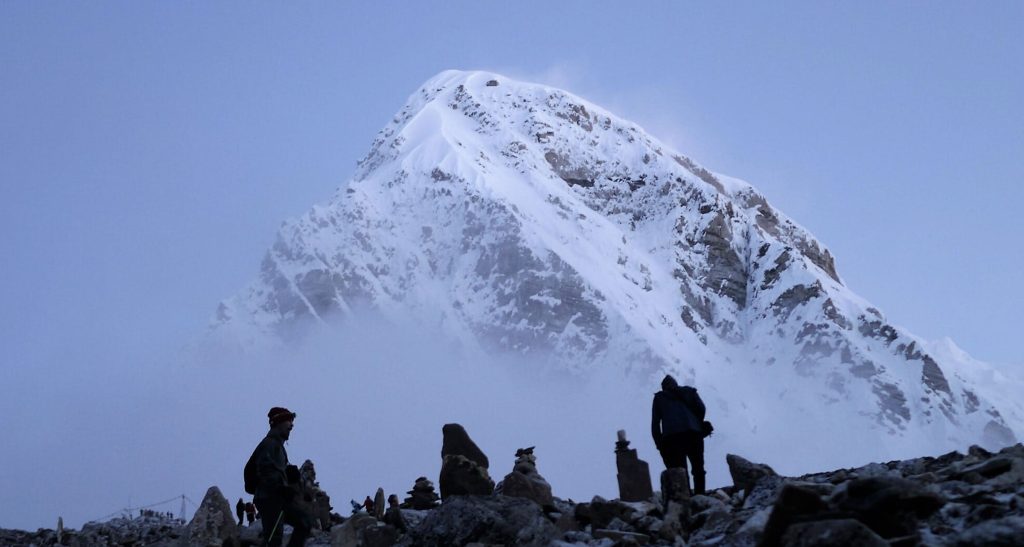
Kathmandu to Everest Base Camp: Your Ultimate Guide to an Epic Adventure
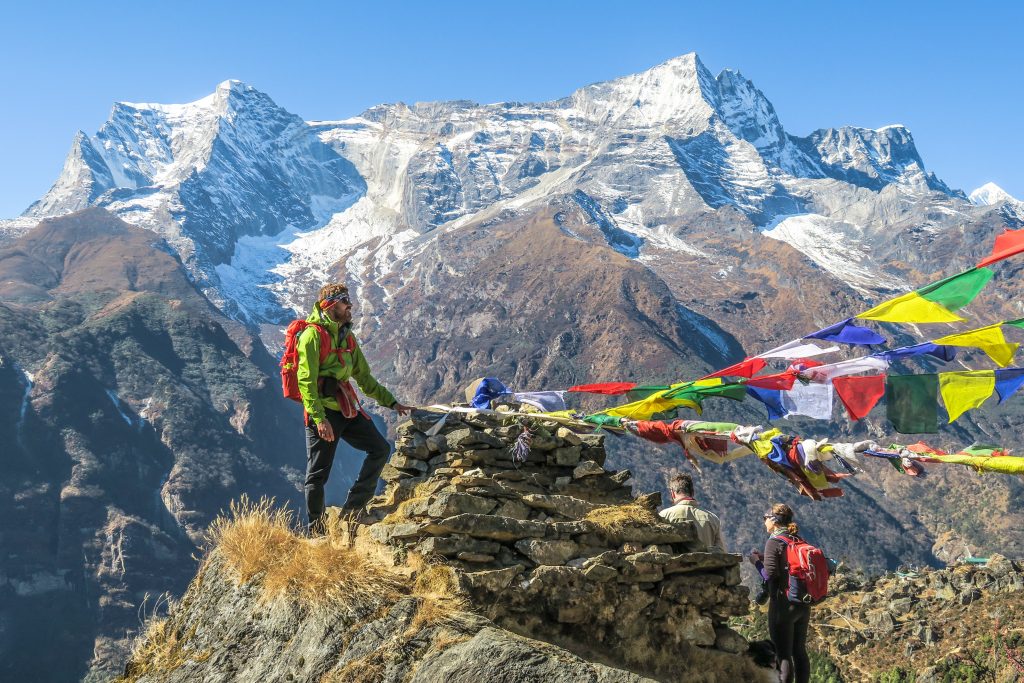
Shortest Everest Base Camp Trek: A 10-Day Round Trip Stunning Himalayan Trek.
Leave a comment cancel reply.
Your email address will not be published. Required fields are marked *
Save my name, email, and website in this browser for the next time I comment.
- [email protected]
- 977-1-4700386

- Availability
Namche Bazaar Trek
Home >Namche Bazaar Trek
based on 0+ reviews
Country Nepal
Duration 7 Days
Maximum altitude 3880m/12726ft
Activity Trekking
Difficulty Easy
Best Season September, October, November, December, February, March, April
Accomodation Mountain Lodge
Meals Included
Start/End Point Lukla
Trek Overview

Namche Bazaar trek gives you the immense pleasure of trekking. This Lukla to Namche trek is one of the best, easy, and most comfortable trekking. This trek can also be done by fresh trekkers. This trekking package is specially designed for those who want to experience the taste of Mount Everest in a short period of time.
Namche Bazaar is the famous and most beautiful village in the Himalayan region. The majority of the Sherpa community has increased the beauty and feeling of brotherhood in Namche Bazaar. There you can find the Sherpa culture, a lifestyle of Sherpa people from a social and cultural point of view. And the most exciting thing is you will get a chance to visit the village of famous Mountaineers, who got success touching the top of the world Mt. Everest (8848m/29029ft) many times.
Namche Bazaar lies inside the Sagarmatha National Park which is one of the world heritage sites of Nepal listed by UNESCO and it is the gateway of the Everest base camp trek. There you can explore the flora and fauna of the Himalayan region. Furthermore, You can enjoy the alpine forest there on the way to Namche Bazaar. The beautiful breathtaking panoramic view of beautiful snow-capped mountains and the Everest Himalayan ranges such as Lhotse, Ama-Dablam, Nuptse, Kongde, Thamserku, and Khangtega Peaks.
Trek Highlights
Scenic mountain flight from Kathmandu to Lukla
Gateway of Mt. Everest
Capital of Sherpa
National Park Museum
Acclimatization and shopping
Buddhist pilgrimage
Outline Itinerary
Arrival in kathmandu., fly to lukla. trek to phakding (2,610 m)., trek to namche bazaar(3444 m), excursion- shyangbonche(3850 m) and khumjung village(3780 m)., trek to lukla. o/n at mountain lodge, fly to kathmandu., price table, package price.
The trekkers should pay by themselves the expenses of their meals and accommodation in the tea house while they're trekking. But other services are the same which are included in the Gold price and are also included in the Silver price.
Price Includes
- Airport to hotel pick up and drop by private vehicle
- Two-night accommodation in Kathmandu at a three-star hotel in BB Plan
- One highly experienced mountain Guide and porters (1 porter for 2 people),
- Accommodation food, drinks, salary, insurance, transportation of both trek guide and porters
- Group medical supplies (first aid kit)
- All necessary paper works and national park entry permits
- TIMS Card (Trekker’s Information Management System card)
- All additional government tax
- Domestic flight both ways from Kathmandu/ Lukla/ Kathmandu.
- Airfare for guide
Price Excludes
- Nepal entry visa fee (USD 25 for 15 days/ USD 40 for 30 days from the date of issue) (You may easily get Nepal visa upon your arrival at Tribhuvan International Airport, Kathmandu)
- International airfare
- Travelers insurance
- All Meals (breakfast, lunch, and dinner) during trekking
- Accommodation in Mountain lodge run by local people during a trek
- All kind of drinks (Alcohol, hot and cold drinks)
- Lunch and dinner in Kathmandu (Approx 10-12 USD)
- Bar bills, telephone bills and other personal expenses (shopping/ laundry)
- Tips to guide and porter
- All expenses due to unavoidable events e.g. Personal illness, strike, etc.
- Helicopter evacuation charge in case of emergency whilst trekking
- Two-night accommodation in Kathmandu at three-star hotel with breakfast
- Meal on full board (breakfast, lunch, and dinner) during trekking
- Domestic flight both ways from Kathmandu/ Lukla/ Kathmandu with airport tax
- Airfare for Guide
- Nepal entry visa fee (USD 30 for 15 days/ USD 50 for 30 days from the date of issue) (You may easily get Nepal visa upon your arrival at Tribhuvan International Airport, Kathmandu)
Detailed Itinerary
Day 1: arrival in kathmandu..
Arrival at Kathmandu International airport in Kathmandu. Meet Himalayan Smile treks representative in Airport. Transfer to Kathmandu hotel. After one-hour refreshment visit office. Orientation program. Meet your guide. Preparation for a trek. Shopping. Overnight hotel in Kathmandu.
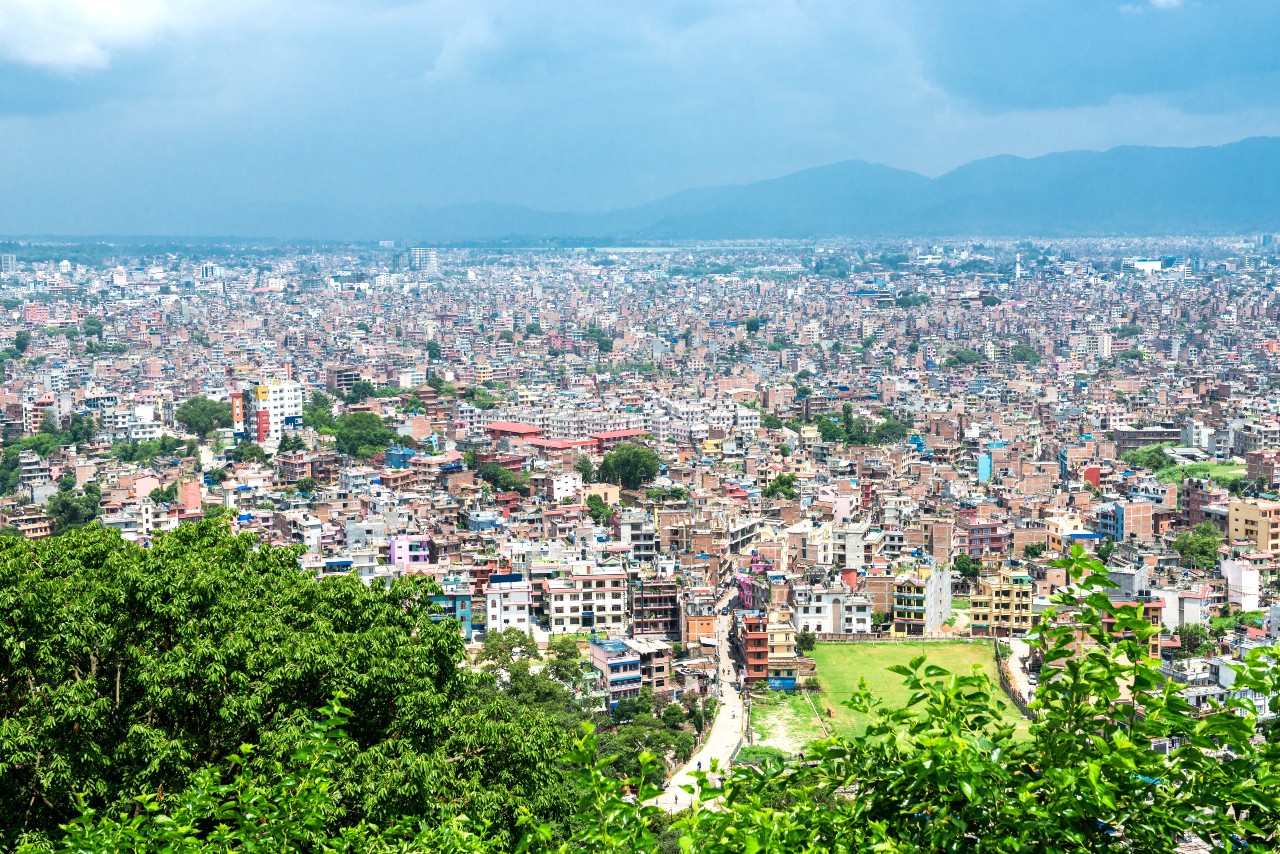
Arrival in Kathmandu
Day 2: fly to lukla. trek to phakding (2,610 m)..
Fly 35 m to Lukla airport (2800m). Trek start, descends forest to the Chauri Kharka. The trail cross a stream make a detour around a large mani stone, steeply descends to the Thoro Kosi. Trail climb and contour to Ghat (2590 m). The trail pass painted Mani stones and climb a bit above the river nearby Phakding.
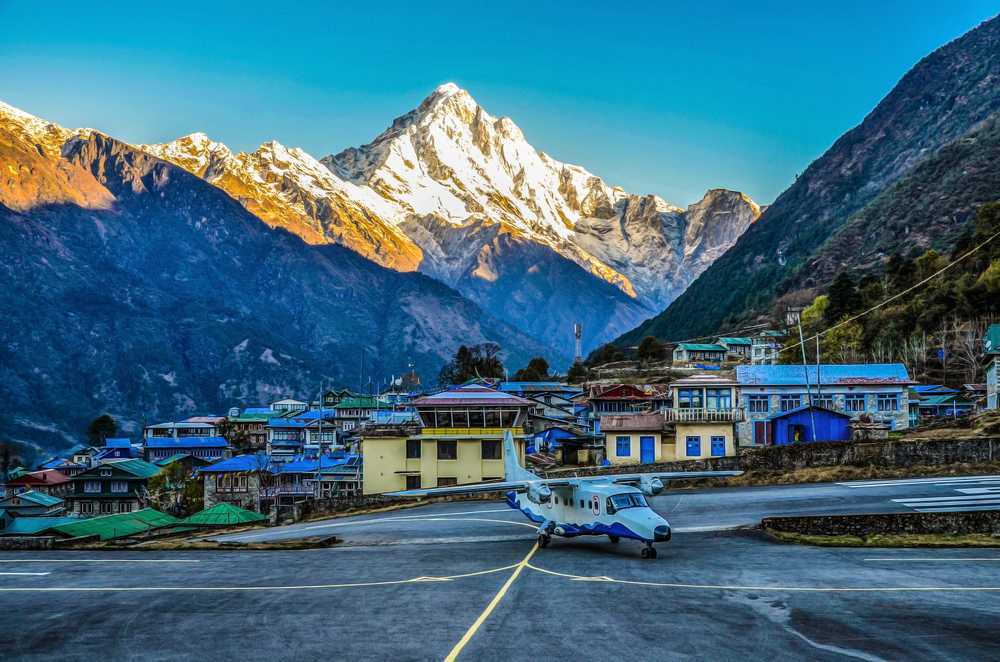
Fly to Lukla
Day 3: trek to namche bazaar(3444 m).
The trail gradually up to the Toktok village nice view of waterfall with the excellent view of east Thamserku (6608 m) traverse above the streams to Benkar (2710 m). From Monjo(2840 m) trail steeply descends to the Jorsalle (2830 m). Trail steeply climb through the pine forest can view Mount Everest(88848 m) to the Namche Bazaar.

Trek to Namche Bazar
Day 4: excursion- shyangbonche(3850 m) and khumjung village(3780 m)..
For accliacclimatization, we will recommend you a day hike to the Shyangbonche(3850 m). From Namche steeply climb to the Shyangboche airstrip(3790m). From here 30 minutes ascends to the top ridge where can view renown world highest mountain including Mout Everest (8848 m). Visit Khumjung village(3780 m). Lunch. Hike to Namche Bazaar(3444 m).
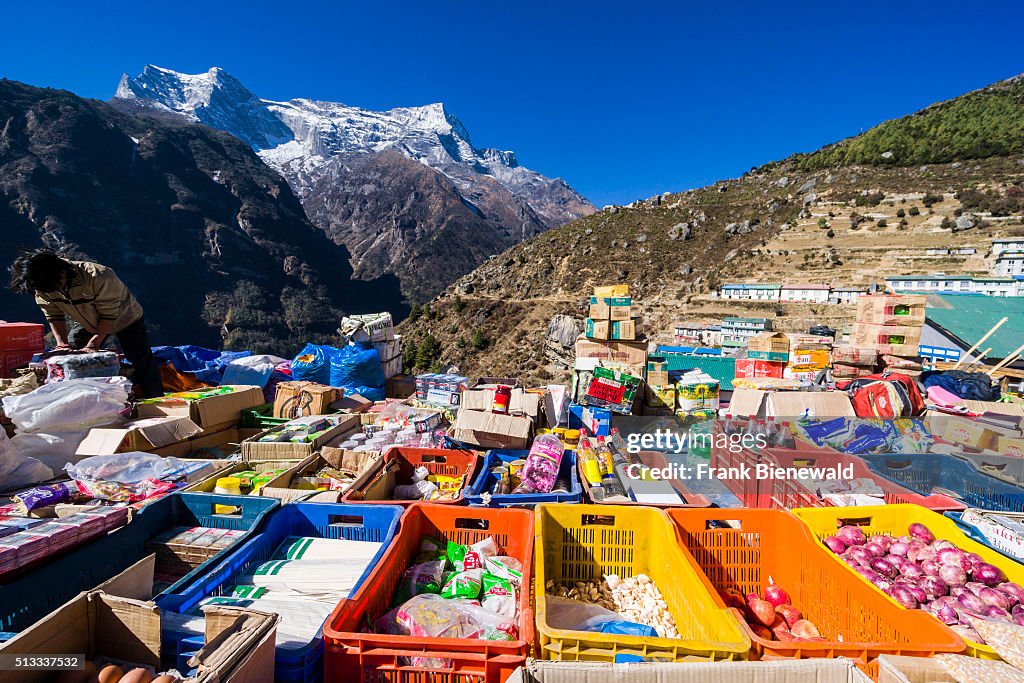
Acclimatization day in Namche bazaar
Day 5: trek to lukla. o/n at mountain lodge.
After having breakfast you will be a trek back to Lukla which contains approximately 8 hours walk. The trail descends through the rhododendron and pine forest to the Jorsalle. You will be staying at Mountain lodge in Lukla. On the way to Lukla, you will enjoy the vegetation, natural beauty, glaciers, rivers, and different animals of the Himalayan region.
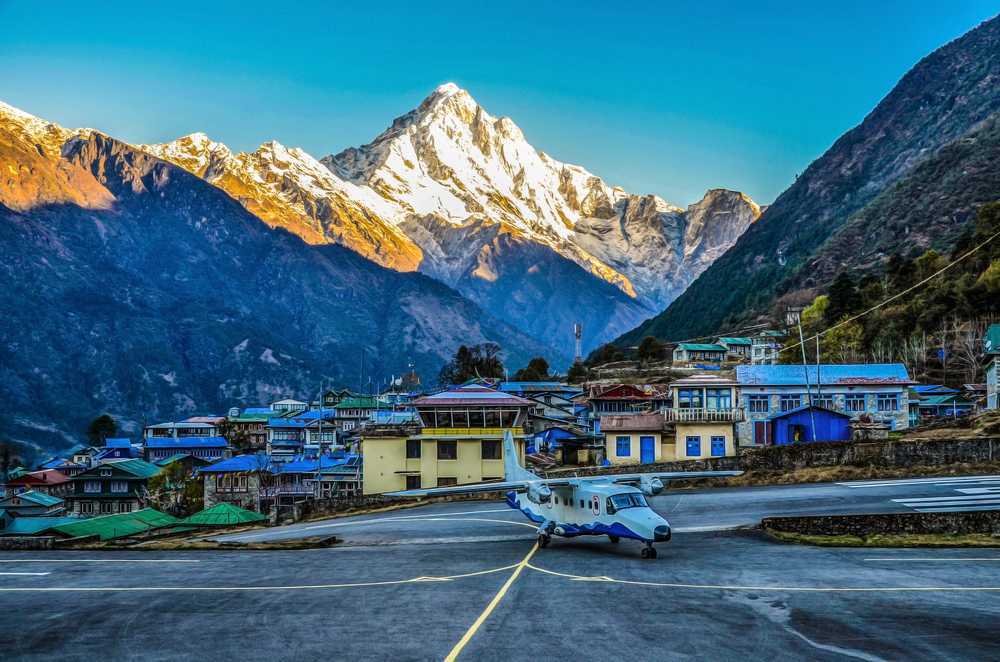
Trek to Lukla
Day 6: fly to kathmandu..
Have an early breakfast in Lukla mountain Lodge. From Lodge, you will 5 minutes walk to the LuklaTenzing–Hillary Airport. You will check in approximately one hour earlier before departure. You will arrive in Kathmandu domestic airport. Transfer to your hotel. Afternoon shopping. Walk around the Thamel. Overnight at Kathmandu hotel.
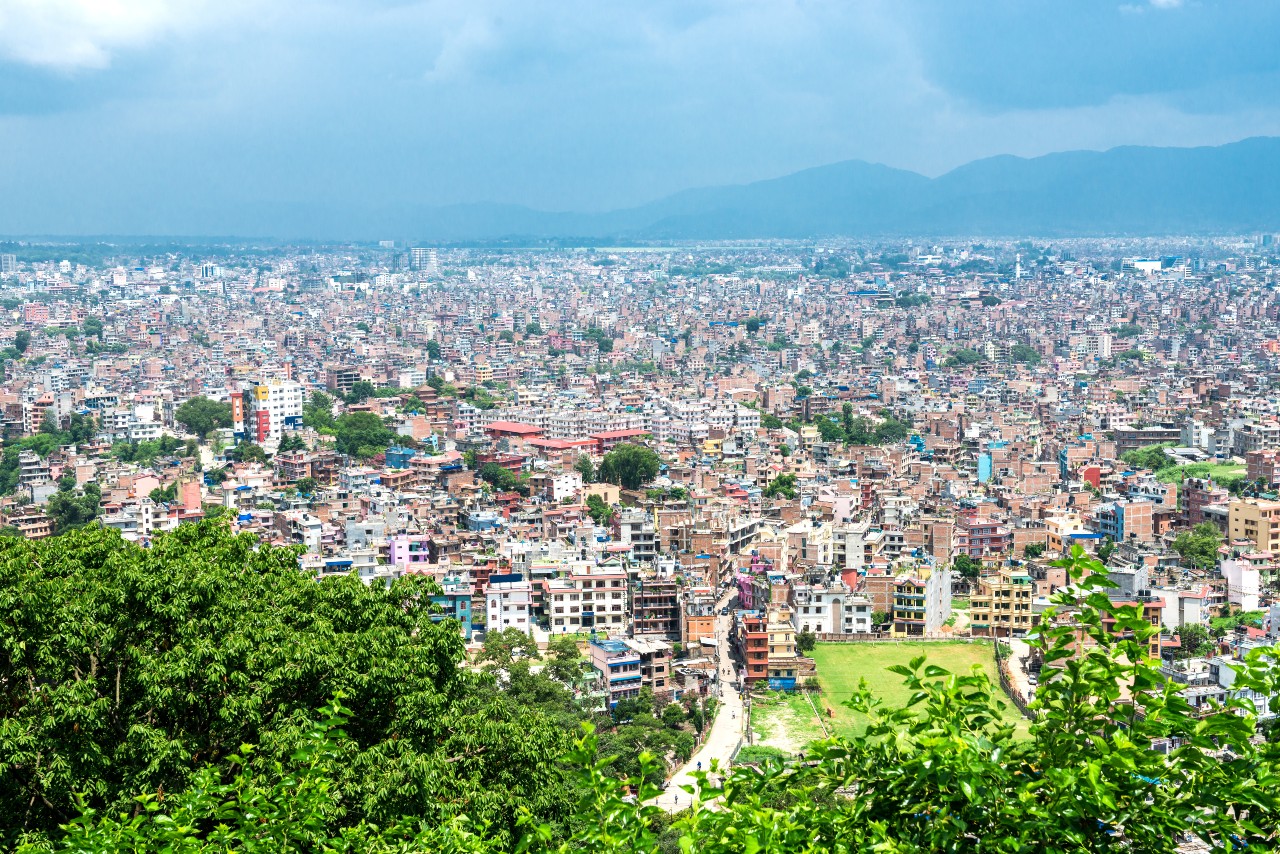
Day 7: Departure
After breakfast walk around the Thamel which is a good place to buy souvenirs for your friend and family. Last minutes Shopping. Preparation your luggage for final departure. From your hotel transfer to Kathmandu Internationa airport before three hours departure. onward your Journey.
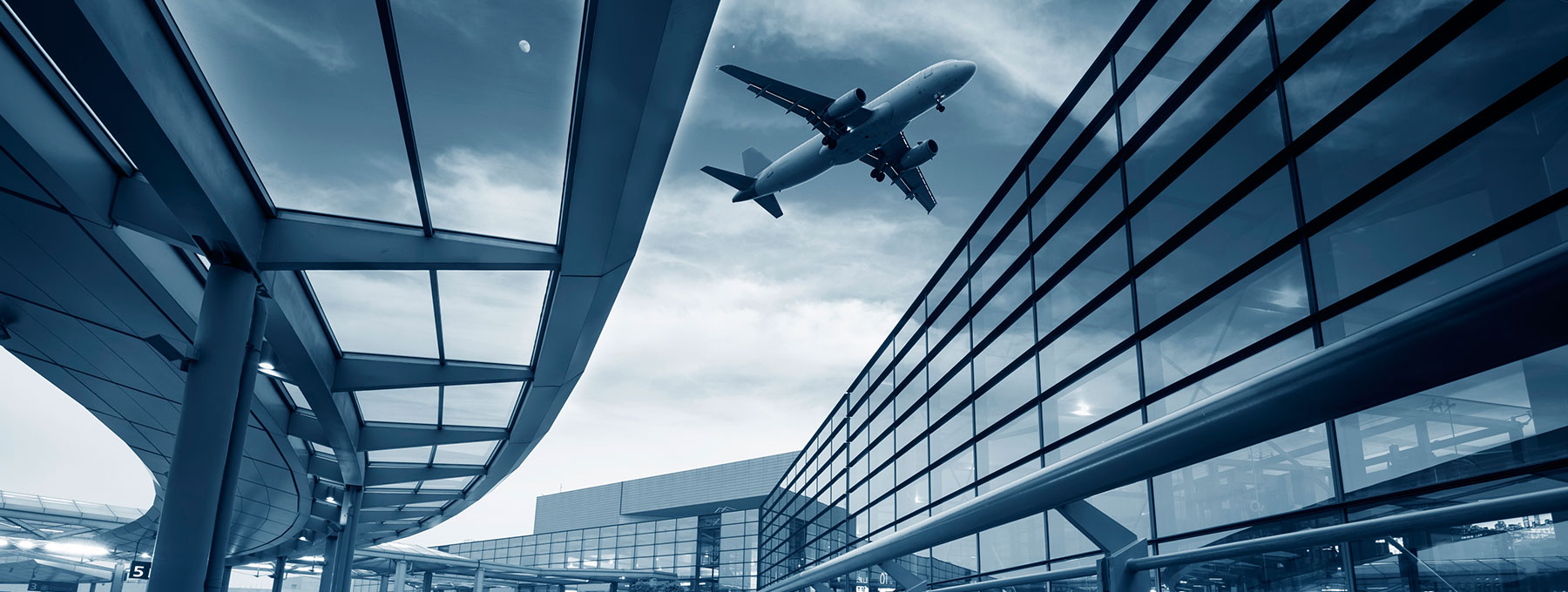
General Information
How to access the namche bazaar.
Trekking to Namche Bazaar starts from the gateway of Mount Everest (8848m/29029ft) Lukla. After the successful landing at Lukla Airport (2828m/9276ft), you will start your trekking with lots of excitement and enjoyment. You will walk for three hours and you will reach your first-day destination which is Phakding (2610m/8560ft). On that day you will rest and explore the Phakding. Also, you will get a chance to interact with the local people of that area. On another day you will reach Namche Bazaar (3440m/11283ft) after 5-6 hours of ascending walk.
Namche Bazaar treks people can enjoy the environment of that region for which your guide will be assisting you. When you reach the Namche Bazaar (3440m/11283ft) you will get a chance to know many things about the people of that region. While you will get a chance to visit Sagarmatha National Park and Sherpa Village, you can enjoy the National Park Museum, Khumjung Village, and Syangboche Village. And the most important and exciting part of the trek is the view of Mount Everest (8848m/29029ft). As a result, you can enjoy the most pleasant time of your life. Consequently, you will get a chance to see the top of the world in front of your face. After completing all activities, you will finally be back to Lukla (2828m/9276ft) and from there fly back to Kathmandu.
In a short period of time, you can collect lots of memories in this Namche Bazaar trek package. You can explore the Himalayas peaks, trails, rivers, and forests of high altitudes.
About Namche Bazaar
Namche bazaar is traditionally the village was a trading post, with locals bartering yak cheese and butter for agricultural goods grown at lower altitudes. The village’s popularity with trekkers and geographical restraints has contained its growth, and it remains a small settlement with no more than 60 dwellings. In addition to an abundance of hotels, the village also boasts three small museums, a stupa, a monastery, several cafes (locally known as bakeries), and many well-stocked stores. Here you can get many facilities such as a bank, internet, Bakery, and shopping. The trekkers who spend two nights in Namche for acclimatization who is planning the Everest base camp trek
Excursion Syangboche (Everest View Hotel)
After breakfast One and a half hours of steep walking to Syangboche(3880m). From Syangboche you can see Mt. Everest(8848m), Lhotse(8516m), Ama Dablam(6814m), Thamserku (6618m), and more mountains. After lunch in Khumjung village (3780m) hike back to the Namche Bazaar
The Syangboche Hill 3880 m is situated within the Sagarmatha (Everest) National Park in Nepal, a UNESCO World Heritage Site, the hotel offers a 360-degree view of the awe-inspiring peaks. With a view of Mt. Everest (8848m), the visitors can immerse themselves in this thrilling scene.
You will visit the Everest view hotel Opened in 1971, which has been listed on the Guinness Book of World Records (2004) as the Highest Placed Hotel in the world at 13000ft. Featured in numerous guidebooks and received media coverage, the resort has become a destination in its own right. Also if you’re interested to spend overnight at the Everest view hotel extra costs USD 200.00 Per Person, it is a perfect place from which to explore the nearby villages and enjoy the beautiful landscape filled with evergreen fir trees, shrubs, and rhododendron forests.
Trip Enquiry
Our friendly team would love to hear from you.
Best Price Offer
US$ 950 Person
Speak to an expert.

Plan your trip with local expertise 17 + years of experience most authentic way to see the Nepal with Himalayan Smile. .
More Categories
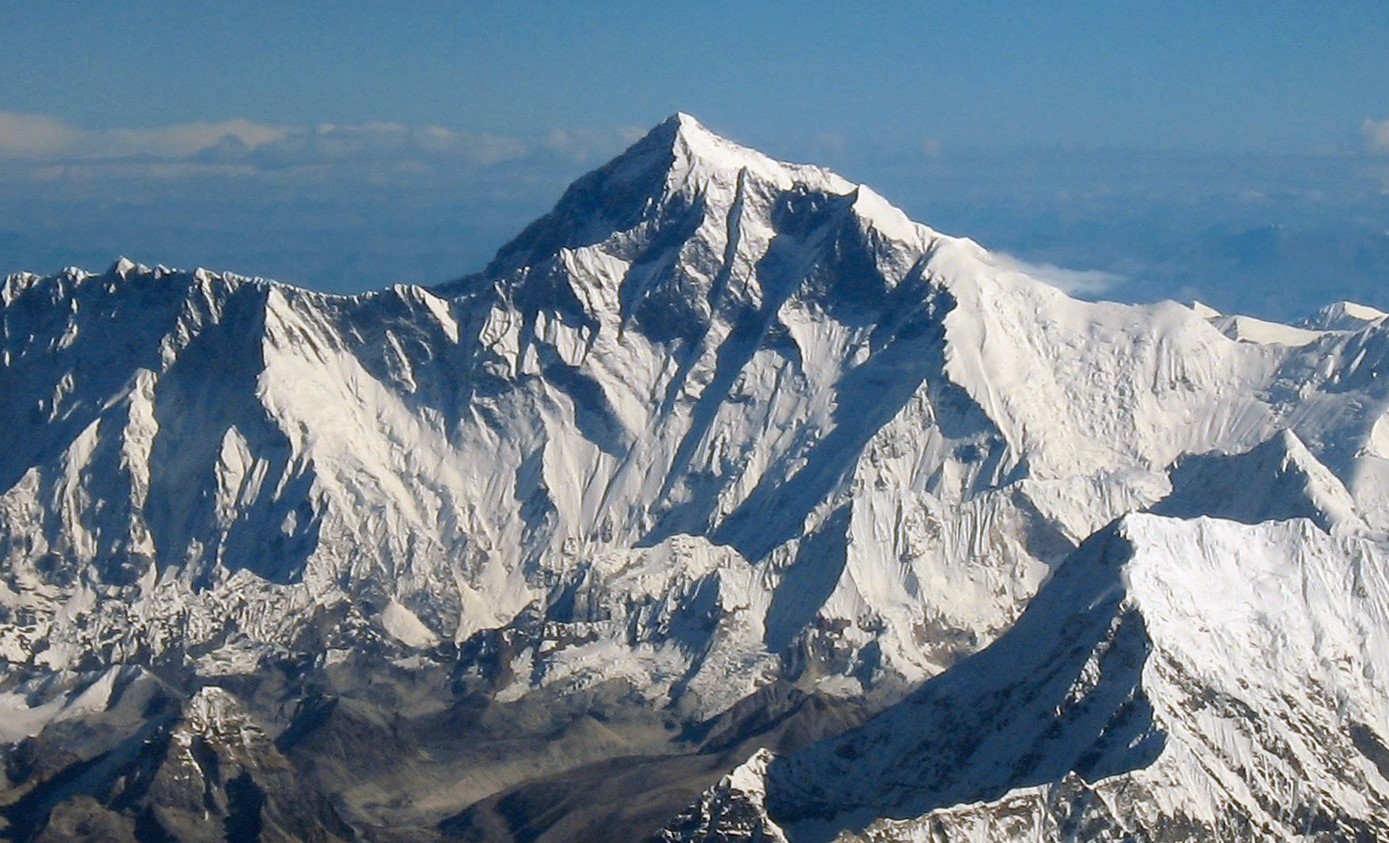
EVEREST TREKKING
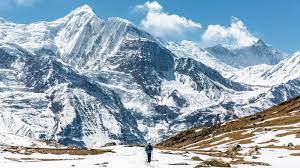
ANNAPURNA TREKKING
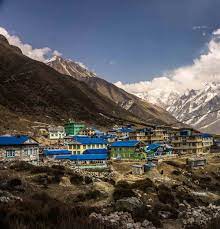
LANGTANG TREKKING
Make a review.
- Cleanliness 5 stars 4 stars 3 stars 2 stars 1 star
- Service 5 stars 4 stars 3 stars 2 stars 1 star
- Facilities 5 stars 4 stars 3 stars 2 stars 1 star
- Location 5 stars 4 stars 3 stars 2 stars 1 star
- Value for Money 5 stars 4 stars 3 stars 2 stars 1 star
You Might Also Like
Kathmandu 2 day trek
Annapurna trek 5 days
1 day trek in Nepal
Easy trekking in Nepal
Nagarkot Changunarayan trek
5 Day Trek Nepal
4 Day Trek Nepal
Annapurna View Trek
Dhampus Trek
Short Annapurna trek
Kalinchowk Trek
Annapurna Circuit Trek 10 days
Poon Hill Trek 3 days
Best Hiking Around Kathmandu Valley
Hiking Walking around Pokhara Valley
Everest View Trek
Why himalayan trek, responsible trek organizer.
We are completely follow the code of conduct of responsible tourism. Responsible Tourism is a conservation practices based on a sustainable theme.
Our social responsibility
HST committed to helping deprived people living in remote areas of the Himalayas. HST is strongly engaged in ecological management and environmental protection of the Himalayas.
Excellent service
We are committed to providing you with a truly memorable experience.
The best price with best value
You will find Best value for money, the most valuable balance of price, with quality service and sustainability to meet customer requirements.
Minimum booking deposit
Book the trip, Pay after your arrival.
Stress free, safe and relaxing trip
Book with us our local expert team will make your trip stress free, safe journey and a relaxing holiday

About Company

Company Promises
- Responsible Trek Organizer
- Become A Green Traveller
- Our Social Activities
Useful Links
- Sustainable Tourism
- Director's Profile
- Terms & Condition
- Company Privacy Policy
- Booking & Payment Condition
- Payment Form
- Flight Booking
- Hotel Booking
- Car Van Rental in Nepal
- Kathmandu, Nepal
We started working with Offset Alliance, so all of our trips are now carbon-neutral!

Everest trek to Namche Bazaar | Short trekking Adventure
Key Information
- Clock Duration: 8 days
- Map Marker Location: Nepal
- Map Marker Nepal Region: Everest Region
- Info Activity: Trekking
- Info Difficulty: Moderate
- Food Meals: Lunch , Dinner , Breakfast
- Bus Transportation: Flight , Private vehicle
- Calendar Best season: September through May
- Checkered Flag Altitude (max): 3800 m
- Users Min. group: minimum 4 trekkers to operate this trip
- Tag Code: IETN-8
- Users Max. group: 12
Book this Nepal trek and get a complimentary one hour Trekker’s’ massage after the trek is over. The masseuses will be from a marginalized community. This is part of our Diversity, Equity, and Inclusion.
Note: You can pre-book a seat on a direct helicopter flight from Kathmandu to Lukla and return for an additional US$500 per person each way. You will avoid the 4-5 hours drive to or from Manthali. For example – if you decide to book a helicopter seat for both ways – US$1000 extra needs to be added.
Lukla to Namche Bazaar trek
The Namche Bazaar trek presents an excellent option for trekkers seeking a taste of the Khumbu region and a deep dive into the remarkable culture in the Himalayas. This condensed journey allows you to savour the beautiful elements of the area without committing to the entire trek to Everest Base Camp.
Your adventure commences with a mesmerizing flight from Kathmandu to Lukla, a quaint town in the Khumbu region. The flight is a breathtaking spectacle, treating you to awe-inspiring views of the majestic Himalayas. From Lukla, you embark on a trek towards Namche Bazaar. As you traverse the trail, meandering through picturesque villages, verdant forests, and suspension bridges ornamented with fluttering prayer flags, you gradually approach Namche Bazaar – the acclaimed Sherpa capital and a remarkable trading hub where Nepalese and Tibetan merchants come together to showcase their goods.
Take a moment to soak in the unique ambience of Namche Bazaar, with its buzzing markets, ornate monasteries, and the warm hospitality of the Sherpa people. Allow extra time to acclimate and relish the opportunity to explore further. Continuing your journey, you set course for Khumjung village – a captivating enclave boasting its cultural significance and panoramic views that undoubtedly take your breath away. Explore the revered Khumjung Monastery, reputed to house the mythical Yeti scalp, while simultaneously immersing yourself in the vibrancy of Sherpa culture against the backdrop of the awe-inspiring Himalayan panoramas, including the incomparable Mount Everest.
The trek then leads you to the serene village of Kunde, nestled amidst the mountains and offering yet another perspective of the captivating Himalayan landscape. Gaze upon the majestic Everest and its neighbouring peaks, embracing the tranquillity of the surroundings while gaining insight into the Sherpa’s cherished way of life.
After an enriching experience in Khumjung and Kunde, you retrace your steps, trekking back to Lukla to conclude this remarkable journey. A final uplifting flight takes you from Lukla back to Kathmandu, allowing you to reflect on the unforgettable memories and the incredible encounters you’ve witnessed amidst the Khumbu region.
The Instant Everest Trek to Namche artfully combines the convenience of a flight to Lukla with a few days of trekking, artfully crafting an itinerary that encapsulates the beauty of the Khumbu region, provides a brief glimpse of Mount Everest, and weaves together the rich tapestry of Himalayan culture. Remembering the significance of acclimatization and physical preparedness, even on this shorter trek, ensuring your safety and enjoyment throughout the journey is vital.
Why Choose Us?
- Our knowledgeable, expert trek leader will ensure your safety and enhance your trekking experience.
- Your private social bubble by staying in less busy lodges and trekking away from the crowded trails where possible.
- Experience authentic Sherpa culture, both past and present.
Note – Flight to Lukla and back can be delayed or cancelled due to poor visibility. We ask you to have buffer days of a few days in case your flight to Lukla is affected.
Detailed Itinerary
- Chevron down Day 01: Arrive in Nepal's capital, Kathmandu. You will be met at the airport by our representative and drive to Manthali.
Upon arrival in Nepal’s capital, Kathmandu, our representative will warmly greet you. They will meet you at the airport and make the necessary arrangements. From Kathmandu, you will embark on a scenic drive to Manthali near the airport. It is recommended to book an international flight that arrives in the early afternoon in Kathmandu to allow ample time for the drive.
Note: You can pre-book a seat on a direct helicopter flight at an additional $500 per person to avoid the 4-5 hours of drive to Manthali.
- Chevron down Day 02: We fly to Lukla 2840m and start our trek.
Day 02: Flight to Lukla and Trek to Monjo (or Phakding if the flight arrives later) – After an early morning flight from Kathmandu, we will arrive in Lukla, the gateway to the Everest region. This scenic flight offers breathtaking views of the Himalayas. Upon landing in Lukla (2,800m), we will start our trek towards Monjo, which is approximately a 5-hour trek. If our flight arrives in the morning, we will continue our walk towards Monjo. However, if the flight arrives later, we will stay at the charming village of Phakding, which is around a 3-hour trek from Lukla. Monjo and Phakding offer cosy accommodations and an opportunity to experience the local culture and hospitality.
- Chevron down Day 03: Trek to Namche Bazaar. 3441 meters.
Trek to Namche Bazaar – Today, we will embark on a scenic trek along the Dudh Koshi River, immersing ourselves in the region’s stunning natural beauty. Our route will lead us across a suspension bridge on the Kyashar Khola and through Jorsalle, which marks the entrance to Sagarmatha National Park.
During the trek, we will encounter a variety of terrain, including some flat sections and short, steep ascents and descents. After approximately one hour of trekking, we will reach a high-suspension bridge. From here, we will begin a steep climb that will take around 2 hours to reach our destination: Namche Bazaar.
Namche Bazaar, located at approximately 3,440m, is a vibrant Sherpa town and a significant regional trading hub. Surrounded by towering Himalayan peaks, Namche Bazaar offers stunning panoramic views. We will stay in a lodge at the top of Namche Bazaar, providing a comfortable resting place and the opportunity to explore the local market and immerse ourselves in the rich Sherpa culture.
- Chevron down Day 04: Explore around Namche Bazaar or take a longer hike.
Acclimatisation and Exploration in Namche Bazaar – Today is an acclimatisation day in Namche Bazaar, which is essential to ensure our bodies adjust to the increasing altitude. In the morning, we will rise early and climb to a viewpoint that offers magnificent views of the region’s Mt. Everest and other towering peaks. This awe-inspiring sight is a highlight of the trek and provides a glimpse into the majesty of the Himalayas.
After enjoying the breathtaking views, we can visit the Sherpa Museum and Cultural Centre. Located within the compound of our lodging, this private museum showcases the rich cultural heritage of the Sherpa community. We can immerse ourselves in the exhibits that depict the traditional way of life, mountaineering history, and the Sherpa people’s close connection with the mountains. Additionally, the lodge owner, a conservationist and photographer, offers scenic posters and postcards for sale, providing a chance to support local initiatives and bring back unique souvenirs.
For further exploration, we can hike past the Syangboche airstrip and to Khumjung village. Here, we can visit the school built by Sir Edmund Hillary, a renowned mountaineer and philanthropist. The school has played a significant role in educating the local Sherpa children.
On our return, we will take a different route that descends to Kyangjuma, following the main trail to Everest Base Camp. This alternate path allows us to make a small circuit and witness different views, adding further diversity to our trekking experience.
By the end of the day, we will return to our accommodation in Namche Bazaar, where we can relax, reflect on the day’s adventures, and continue acclimatising to the altitude.
- Chevron down Day 05: We will retrace our steps back to Phakding. 5 hour hike.
Trek from Namche Bazaar to Phakding via Monjo and Jorsalle – Today, we will retrace our steps and begin our journey back towards Phakding. Starting from Namche Bazaar, we will descend towards Monjo, passing through the steep hill and crossing the high suspension bridge. The trail will lead us through the charming village of Monjo, where we can take in the peaceful surroundings and enjoy the traditional mountain atmosphere.
From Monjo, we will continue our trek, descending further towards Jorsalle, the entrance to Sagarmatha National Park. This is an excellent opportunity to explore the park, learn about its unique flora and fauna, and appreciate the importance of conservation efforts in the region.
After visiting the National Park, we will have a well-deserved lunch in one of the local villages, immersing ourselves in the warm hospitality and savouring the local cuisine. Afterwards, we will continue our trek towards Phakding, where we will stay for the night. The walk from Namche Bazaar to Phakding usually takes 5-6 hours, allowing us to enjoy the region’s scenic beauty while retracing our steps along the Dudh Koshi River.
- Chevron down Day 07: Fly to Manthali and drive back to Kathmandu for 4 hours.
Flight to Manthali and Drive to Kathmandu – Today, we will conclude our trekking adventure in the Everest region and embark on the journey back to Kathmandu. Firstly, we will take a scenic flight from Lukla to Manthali, the nearest airport to the Everest region. This short flight will provide us with one last opportunity to soak in the breathtaking aerial views of the Himalayan peaks before bidding farewell to the mountains.
Upon landing in Manthali, we will continue our journey by road, driving for approximately 4 hours to reach Kathmandu. The drive will take us through picturesque landscapes and charming villages, allowing us to witness the diverse beauty of Nepal.
Once we arrive in Kathmandu, the afternoon will be free for you to relax and unwind after the trek. You can take this time to explore the vibrant streets of Kathmandu, go souvenir hunting in the bustling markets, or enjoy some downtime at your leisure.
You may want to savour a delicious farewell dinner in the evening, reflecting on the incredible experiences and memories from the Everest trek. This will provide a fitting end to our Himalayan adventure.
Please note that flight timings and road conditions may vary, so keeping some flexibility in your schedule is advisable to accommodate any unforeseen circumstances.
Note: You pre-book a seat on a direct helicopter flight to Kathmandu for an additional $500 and avoid a 4-5 hour drive from Manthali.
- Chevron down Day 08: International Departure.
This morning is free for further exploration or shopping depending on flight times. International departure.
Cost Includes:
- Boutique hotel in Kathmandu on a bed-and-breakfast basis
- Hotel/lodges on a twin-sharing basis
- All transportation
- Responsible Adventures’ expert trek leader or Trek with Raj
- Complimentary T-shirt
- Use of trekking kit bag during the trek
- One assistant guide between 4 trekkers
- Trekking Chef
- One porter between two trekkers
- Proper clothing for porters and crew
- Food for porters & crew members (we are one of the few trekking companies that provide this facility)
- Insurance for team and porters
- All permits
- Twin sharing room on the trek
- All meals on the trek (the healthiest and most varied trekking meals in the whole of the Himalayas)
- Domestic airfare
Cost Excludes:
- International airport taxes
- All optional additional tours or activities during free time
- Transportation outside of the tour program
- Travel insurance (compulsory to have insurance that covers helicopter evacuation)
- Tips (suggested amount US$75 per week for staff only); Leader’s tips at your discretion
- Items of a personal nature, e.g., alcoholic drinks, bottled beverages, laundry, souvenirs, etc.
- Chevron down Booking Policy
A Responsible promise
Despite the exceptional circumstances in which we find ourselves at the moment, we don’t want you to give up your holiday – and we want you to be able to book your trip without any worries.
To provide additional security for your booking, we have introduced a new rebooking and cancellation policy so that you can easily rebook or cancel your trip free of charge if the worst comes to the worst.
Free Cancellation With the Responsible Promise 100% Money-Back Guarantee
For new bookings made between May 10th 2021, and December 31st 2022, you may cancel your complete package (activities, hotels, tours, excl. flight) free of charge up to 30 days before your departure and get 100% of your money back. However, to stay flexible, we recommend that you choose a flexible fare when booking your flight.
Complete flexibility on your booking
Stay flexible with our new rebooking service until shortly before your departure. For new bookings made between May 10th and December 31st, 2021, you may rebook your package (activities, hotels, tours) free of charge up to 30 days before your departure (subject to availability). Rebooking is only allowed once, and you must inform us 30 days before your planned departure. Any additional costs incurred due to changes in your schedule or upgrades, such as additional fees in high season or upgrades to your accommodation, will still apply. To remain flexible, we recommend that you choose a flexible fare when booking your flight.
- Chevron down Frequently Asked Questions - Trekking FAQs
Am I too young or old?
Most of our clients have completed their treks from 3 years old to some in their 70s with almost no exercise or training .
Do you offer hotel/airport pick-up?
We offer hotel and airport pick-up . As you continue with your booking, there will be an option to input flight details or hotel names.
Do I need a Visa?
A visa for Nepal can be acquired on arrival at the Tribhuvan International Airport, Kathmandu, and at border entry points in Kakadvitta, Birgunj, Bhairahawa, Nepalgunj, Gaddachowki on the Nepal-India border, and Kerung on the Nepal-China border.
A visa can also be obtained outside of Nepal at the nearest Nepal Embassy or Diplomatic Mission.
For more information, visit the Department of Immigration, Kalikasthan, Kathmandu.
What should I bring on a Trek?
Being adequately equipped is one of the keys to a successful trek. For information to help you select the best type of clothing and equipment for your trip, please see our Clothing and Equipment Guide.
Also, see our Links page for details of specialist retailers who will offer further advice and assistance with purchasing new clothing or equipment.
If you have more questions, please check this article to reference equipment to pack or contact us.
Is this trip safe for solo/female/LGBT+/minority/POC travellers?
You are safe if you respect the culture, do not show affection in public, and dress decently (this won’t pose too much of a problem as you will be covered up in layers to stay warm).
Here are some helpful articles: Am I too old to go trekking? Arriving at Kathmandu airport. Should I bring cash or ATM cards? What to pack for a trek? Do I need to train for a hike? What is a typical day on a hike like? What is the food like on the tour? The Benefits of Using Trekking Poles. What do I need to know about high altitudes? High altitude myths. How to trek safely? For more articles, you can go to our blogs.
Related Trips
- Info Trekking
- Map Marker Nepal
- Clock 15 days
Sherpa Legends of Everest Trekking | Wellness Tour
Trekking through the Everest region offers an awe-inspiring experience, showcasing the majestic Tengboche Monastery and breathtaking vistas of iconic peaks like Everest, Lhotse, AmaDablam, Nuptse, and many others. It’s a journey where you walk amidst the footsteps of renowned Sherpas, tracing their legendary paths and feeling the essence of their rich cultural heritage.
- Clock 14 days
Luxury Everest Trek to Ama Dablam Base Camp Wellness Tour
Immerse yourself in a luxurious Everest trek meticulously designed to unveil the Sherpa heartland’s stunning beauty. Traverse through the vibrant Sherpa capital of Namche Bazaar and explore the captivating charm of nearby Sherpa villages. This curated journey invites you to discover the essence of Sherpa culture while leading you to the base of the breathtaking Amadablam, renowned as the most exquisite and alluring mountain in this iconic Himalayan region.
- Clock 16 days
Everest base camp trek – Wellness Adventure
Experience the ultimate journey to Everest Base Camp and Kalapathar with our exceptional focus on wellness, making it the finest Everest Base Camp trek you can find. Secure your spot online now.
Day 11: Namche Bazaar to Lukla
It was the last day of trekking in Everest. I was excited to go back home. And the place, I was hallucinated. The enticing Himalayas, the lonely trails, the scenic ridges, splashing rivers, the twinning Himalayan Thars,… will I ever forget these?
The last breakfast in Namche! I loved the pancakes there. My favorite was the Apple pancake. It’s going to be a long day, I knew it. So, we started right after breakfast. It was a bright morning. I looked back at Namche Bazaar from a water fountain (there’s a water fountain and a few self-driven prayer wheels in Namche).
There were lots of trekkers lining on the trekking trail. We also saw some trekkers who were returning on the back of the donkeys. Maybe they got injured or couldn’t get back walking.
The trail was familiar. Descending the downhill trail from Namche Bazar to the Hilary suspension bridge was the toughest walk. I was holding my trekking poles firmly. Maybe I bought a really good pair of trekking boots. They were easy to wear and walk.
It was pretty early. I thought we won’t see any trekkers or porters reaching Namche so early. But there were some porters and trekkers who were already reaching Namche. Maybe they stayed overnight at Jhorsale yesterday, Gun Das said.
Crossing the Hilary suspension bridge was a big deal to me. Every time I saw any bride, I used to say that if there was an alternative trail, I’d take that even if it’d take me an extra hour of walking. I closed my eyes, took a deep breath and started running. I was stupid! As I began running, the bridge started swirling, I was so scared.
I don’t want to cross any suspension bridges. Oh, Lord! Please make them vanish. But maybe it was too early for Lord to wake up, there were many others ahead on the trail.
The trail was dirty. There were lots of bad-smelling dungs scattered here and there. The Jokpeys and Donkeys were making bags of dust. I had to cover both my nose and mouth. On the trail, there were some teahouses. We also saw a woman who was selling Apples and Oranges.
There were lots of Rhododendron trees. At places, we were walking over the scattered Rhododendron petals. It was a bright day. I was applying sunscreen to my face again and again. I had emptied many water bottles as well.
We stopped for lunch at a hotel on the way. The food was so good there. I had ordered an egg fried noodles. After stuffing, we started trekking again. Namche Bazar to Lukla was a long walk. En route, there were lots of mani walls. (huge rocks painted with Buddhist mantras)
There was a huge waterfall, so beautiful. The lofty hills and lush trees were looking amazing. We were walking across the dusty trail alongside Dudh Kosi river. We took a rest at a lodge in Phakding. I bought a caned juice and a bottle of water there.
Phakding to Lukla was a flat and an easy trail. The trail was slightly ascending somewhere. My body was tired from the long walk. Is Lukla close? I was asking Gun Das in every 15 minutes. The sun was travelling too fast. We were walking without stopping.
At a distance, I saw a plane. I knew it was going to land at Lukla airport. Then, I knew where Lukla was. It was still two hills away. I started tapping the trail with my trekking poles while Gun Das followed me with a tired face.
Oh! Finally, after a really tiring day, we reached Lukla. Lukla was a beautiful town. It wasn’t as big as Namche, but there were good hotels, coffee shops, and others there as well. After dinner, I decided to walk around and buy a few things for my friends and families.
There were different shops selling handicrafts and local products. There were several clothes with “Made in Nepal” tags, Buddha eyes, Everest Base Camp prints, and others. I bought a few things and entered a coffee shop. Coffee at Lukla was so good.
With the excitement of returning home tomorrow, I took a sound nap at the hotel room.
You can read next days article here:
Day 12: Lukla to Kathmandu
Previous Day article:
Day 10: Pheriche to Namche Bazaar
Related Articles
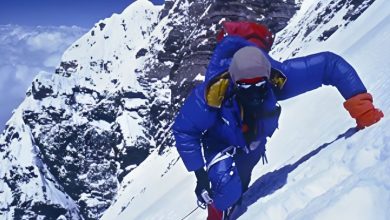
Mick Burke: 1975 Expedition And Tragic Missing Of English Mountaineer

13 Must Watch Movies To Gain Deep Insights On Mount Everest
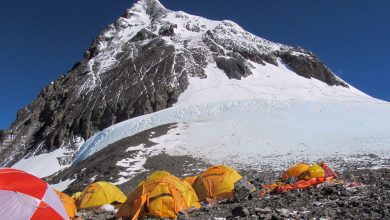
Mount Everest Camps: How Many Camps Are There On Everest?
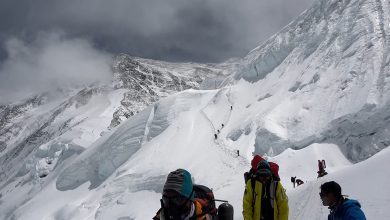
Facts About Mount Everest

Halfway Anywhere
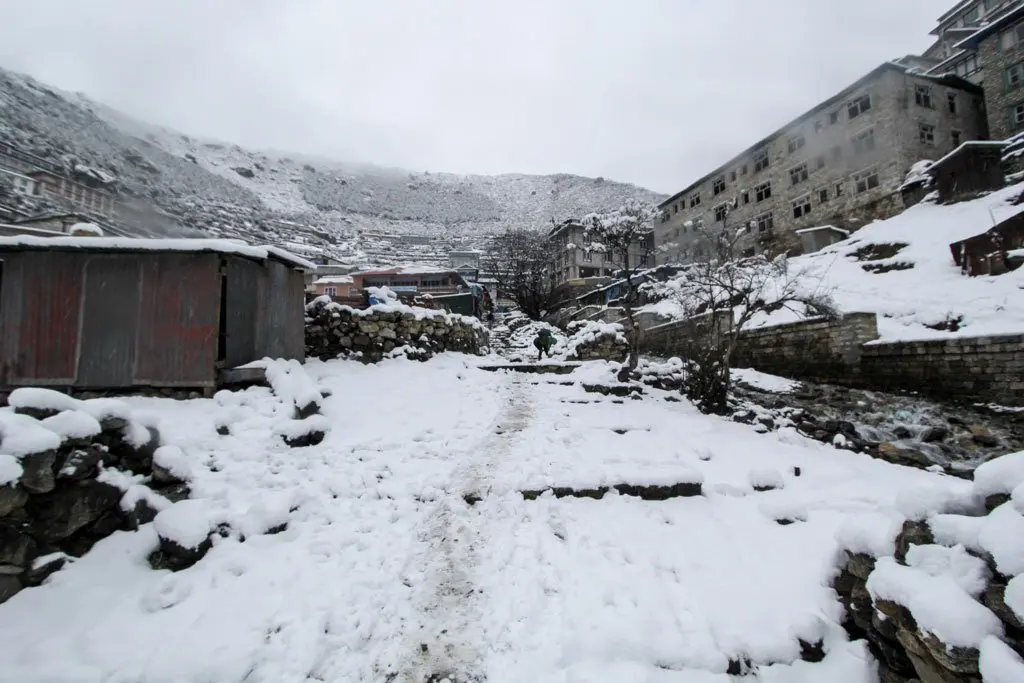
Everest Base Camp Day 13: Namche Bazaar to Lukla
- Starting elevation: 11,290 ft / 3,440 m
- Ending elevation: 9,100 ft / 2,800 m
- Elevation change: -2,190 ft / -640 m m
- Starting oxygen: 67% of sea level
- Ending oxygen: 73% of sea level
- Distance covered: 11.12 mi / 17.9 km
- Time hiked: 6h 15m
Today begins what will be the last day of my first Himalayan adventure.
Once again, the hike I will be doing today took me multiple days on the way up to Base Camp. The way down is truly quicker.
I wake up where I fell asleep (usually a good thing): on the cafe floor that Mr. Susan (the owner) allowed me to sleep in. To my surprise, I look at something I haven’t seen once this entire trip: snow falling from the sky (it turns out it’s a good thing Susan moved me in from the porch).
And it looks like it’s been falling for a while now.
How grateful I am to be going down instead of up.

All my known hiking associates departed Namche Bazaar yesterday, so I am again alone; I like things that way.
I begin my trip south through the snow, incredibly grateful that I am not just beginning my trip up to Base Camp. However, seeing everything covered in snow would undoubtedly be spectacular.
After an hour of hiking, the snow has transitioned into rain, bringing muddy slopes and trails (which have been thoroughly mixed with pack animal excrement).
The benefits of hiking downhill (yes, I prefer down to up; I know some of you out there with awful knees don’t agree) are negated by the now treacherous mudslides that must be avoided during the descent.
Despite the mud, it’s fairly easygoing, and I am surprised to find myself reunited with Michael and Garth halfway down to Lukla (I met them all the way back on day one ).

Teamed up with my Aussie companions, we head down past the villages of Monjo, Phakding, and numerous others dotting the hillsides and valleys of the lower Himalayas.
The worst part about coming down from the Himalayas to Lukla (other than the fact that you’re leaving one of the most spectacular places in the world) is that the last bit of hiking takes you uphill . For something like 1.86 mi / 3 km!
Steepest at the end, this last bit of elevation change serves to remind those cocky enough to consider the descent from Everest Base Camp a simple task who is boss (the mountains are, in case you’re wondering).

Having finally arrived in Lukla, I follow Mike and Garth to the hotel their guide recommended and where they are staying.
I am willing to splurge after thirteen days without having taken a shower, washed my clothes, or slept in a room with an ensuite bathroom (not that all of these things have to do with remaining clean). We also appear to be the only guests in the entire hotel.
But the bathrooms are clean, the water in the shower is not freezing (but it’s still very cold), and they have a cafe across the street with pizza and beer.
Tomorrow, I fly back to Kathmandu; tonight, life is good.
Mission accomplished.

EBC Day 1 | 1.5 | 2 | 2.5 | 3 | 4 | 5 | 6 | 7 | 8 | 9 | 9.5 | 10 | 10.5 | 11 | 12 | 13
Similar Posts
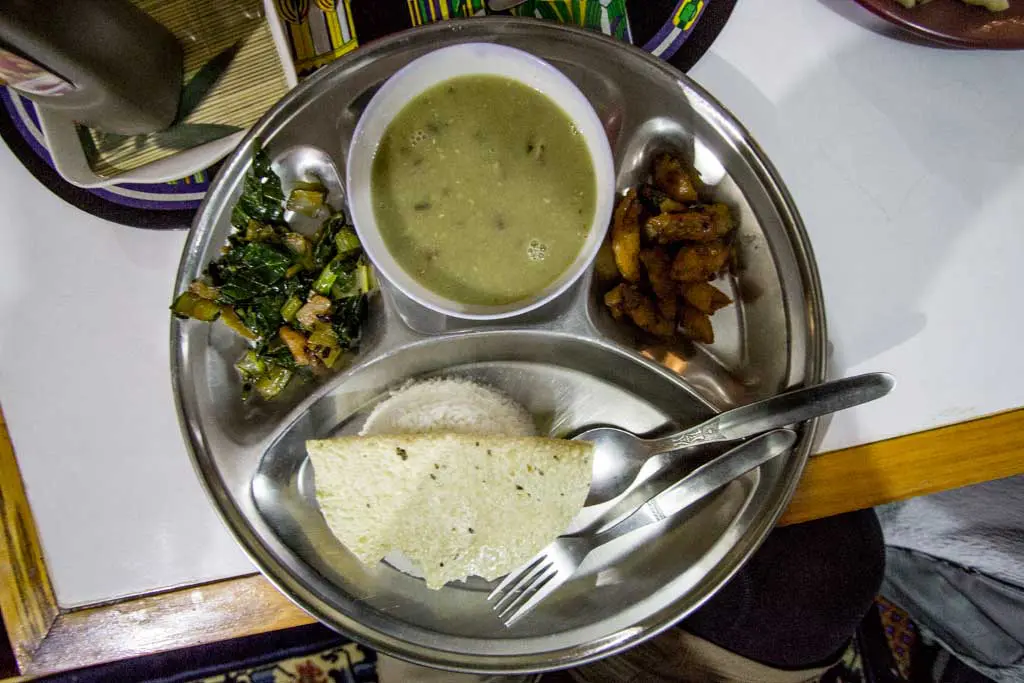
What Is Food Like In The Himalayas?
The Himalayas may be remote, but that doesn’t mean you can’t enjoy a huge variety of meals whilst trekking through the highest mountains on Earth….
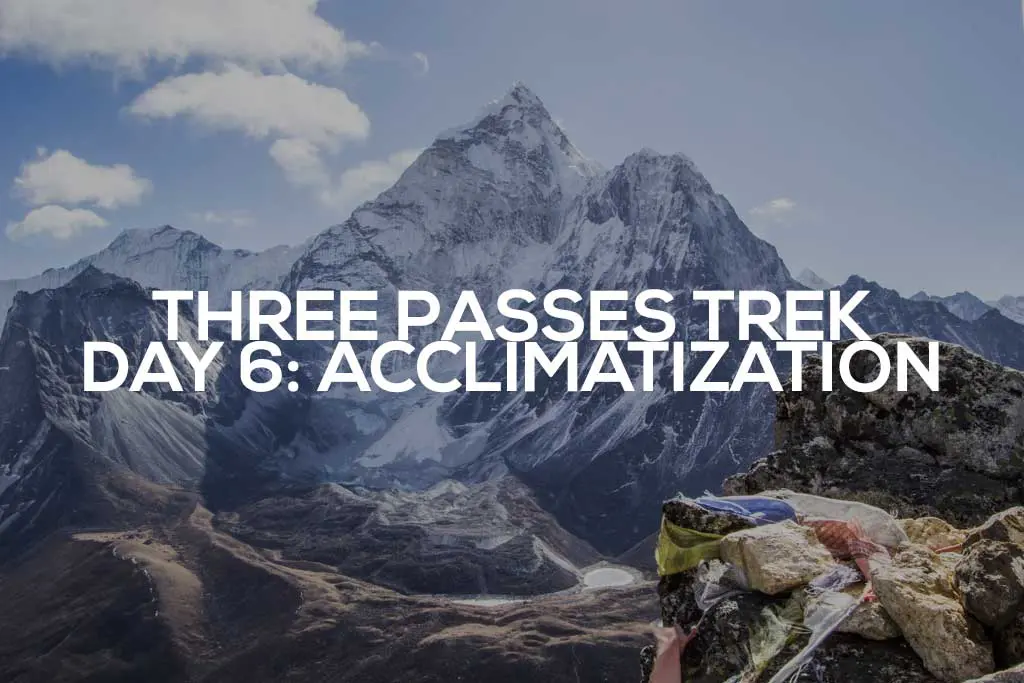
Three Passes Trek Day 6: Dingboche Acclimatization
After what may have been my best sleep of the trip thus far, I spring out of bed to meet Pavel in the common area…
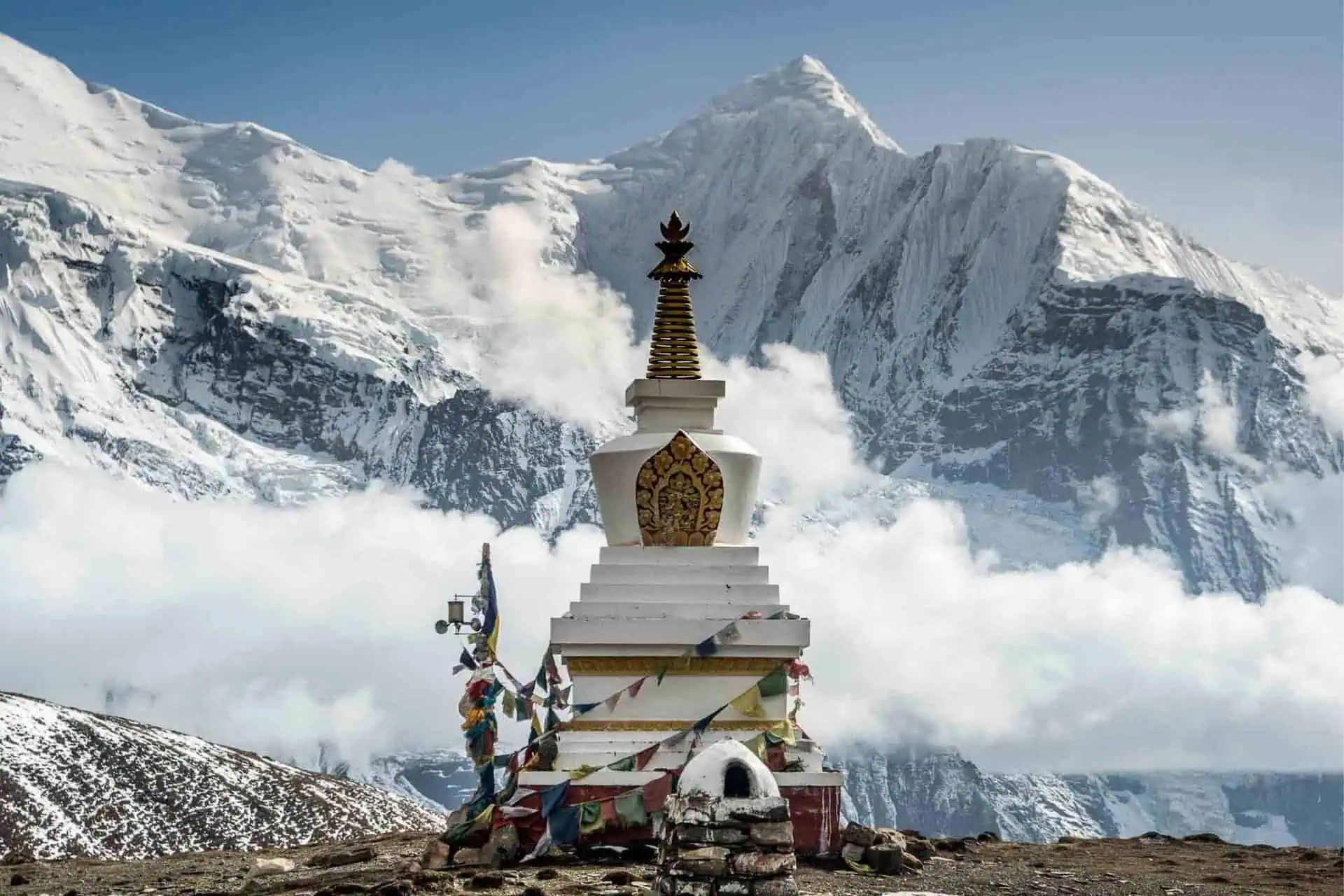
Why You Should NOT Hike the Annapurna Circuit
The Annapurna Circuit in Nepal is one of the country’s most well-known treks. Perhaps second only to Everest Base Camp, every year, trekkers from across…
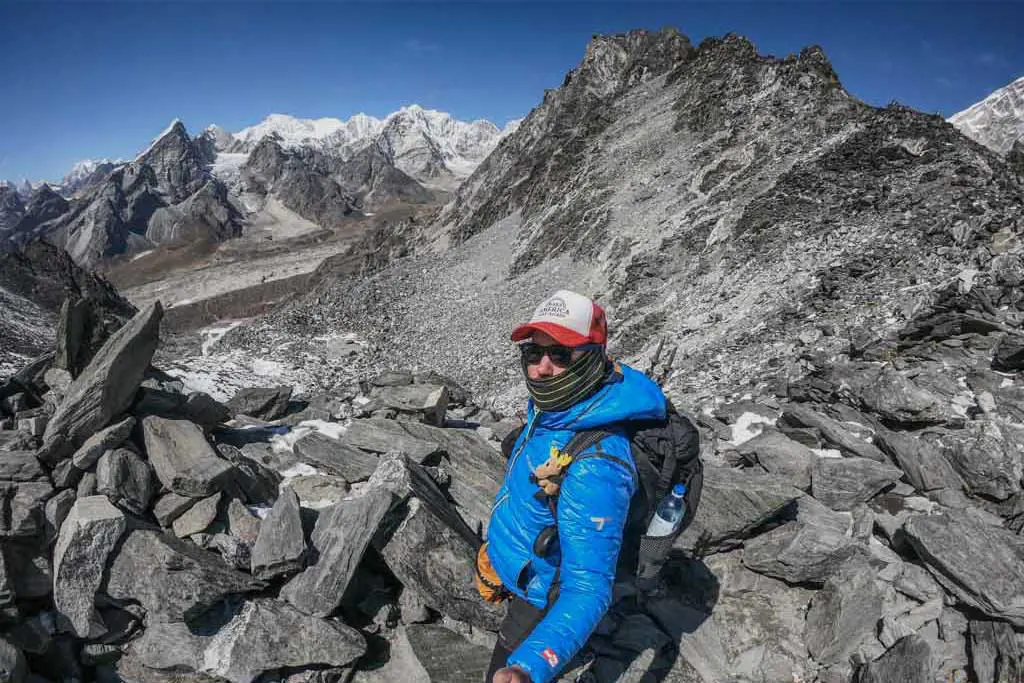
Nepal’s Three Passes Trek: Kongma La
Kongma La is the easternmost pass of Nepal’s Three Passes Trek and is generally considered to be the most difficult of the three (but don’t…
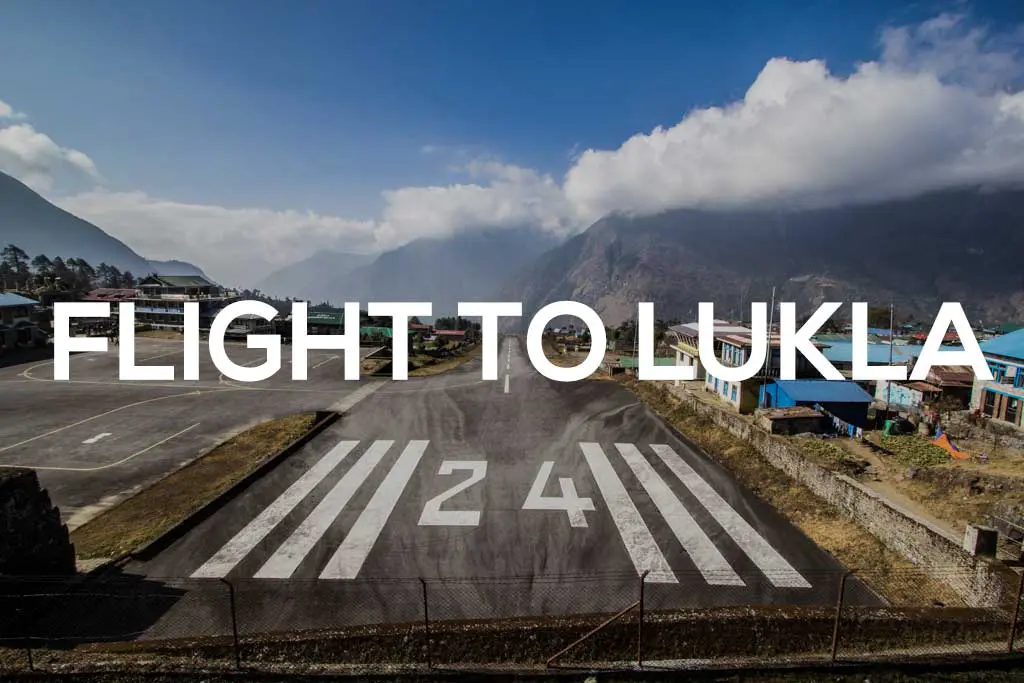
Catching (Or Not Catching) A Flight To Lukla
Most people visiting the Everest Region begin their journies by flying from Nepal’s capital city of Kathmandu to the Himalayan town of Lukla. As I…
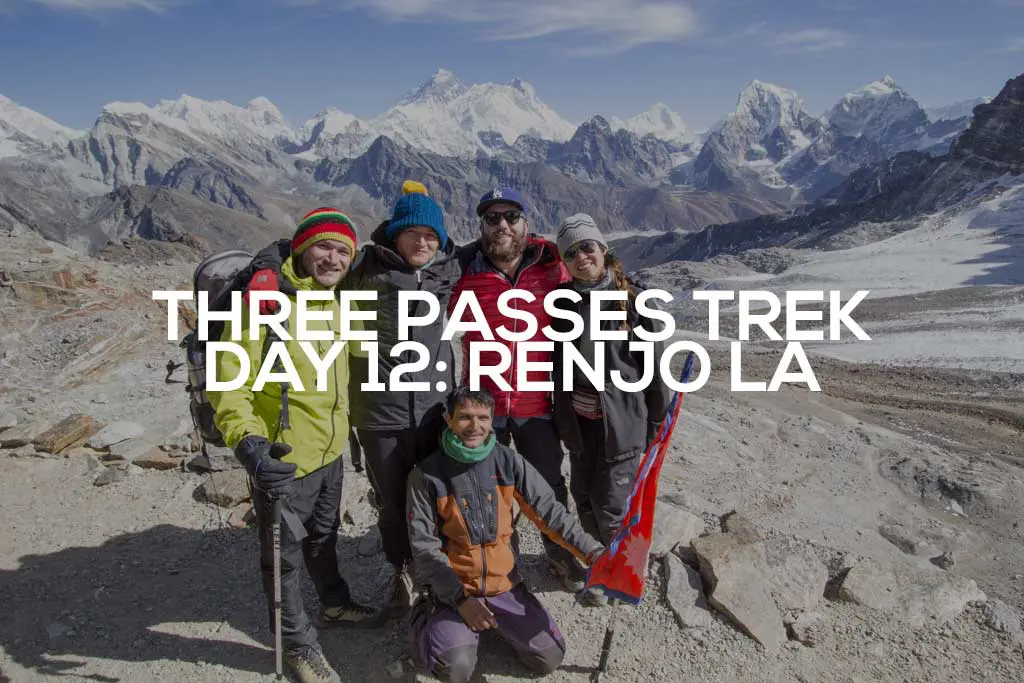
Three Passes Trek Day 12: Renjo La (Gokyo to Thame)
This morning I am happy to find that the clouds responsible for last night’s snow have vacated the area and left blue skies in their…
26 Comments
Hi there! I’m so glad I came across your journey, this is the most honest account of the EBC I’ve seen, so thank you! I’m currently in the planning stages of my trip and considering I live at sea level I’ll definitely take a bit extra time for slower ascension and more acclimatisation days. I cant wait!
Happy to share! Have a great trip!
Im going to do this in late March 2024. Any thoughts on where I could stay to break the trek from Namce to Phakding? Im planning an extra day for this so not to go so fast. Any suggestions appreciated.
There are a few places between Namche and Phakding but I can’t speak for the lodging availability.
To be honest, if you don’t think you can make it from Namche to Phakding (downhill) in a day, you may want to reconsider your trip.
Hello Mac, Thanks for the details information about Everest base camp trekking.
You got it, friend.
Hi Mac! Thanks for the funny posts! I have one question. Is it possible to make the trek (in winter) without buying any water? I suppose the rivers are solid frozen in the mornings, but what about in daytime? Are there water sources in any village or along the way in order to fill, or one needs to ask for cold water (I suppose free?) in the guesthouses? Thanks!
I can’t speak for all the villages, but there is running water in a few that I remember (Dinboche, Chukhung), but you can ask for tap water at any guest house and they will fill up your bottles for free. That said, they will (sometimes) be annoyed if you just take the water and leave without buying anything since in some places they actually have to bring up the water from sources and are not simply taking it out of a tap. You could probably just throw them 100 or 200 rupees ($1/$2) for filling your bottles with tap water if you’re not buying anything.
Thanks for the info!
Enjoyed your hilarious posts! I’m going to EBC next month! Can’t wait! Going solo at the moment, but I’m thinking whether I should get a porter-guide since this is my first time hiking in the Himalaya. Is the trek clearly marked? Afraid I will take wrong paths somewhere.
The trek is very clearly marked and if you’re going next month then it will also be crowded with trekkers. If in doubt, just ask someone (there will be people everywhere).
Thanks Mac! Sorry one more question, did u get into trouble for not having the TIMS and Sagarmatha National park permit in advance? Is it Ok to just apply for both at the place u did yours (i will make sure to turn around if anyone called me haha). Cos I will arrive in Kathmandu on weekend and I doubt the TAAN office is open.
There is no way to get your Sagarmatha NP permit in advance (that I know of), you get it when you enter the park. You can get your TIMS on the way up (when I was in Nepal this past March the Everest Region wasn’t accepting TIMS – the people in charge up there were at odds with the people in Kathmandu – and you had just just buy a different permit when you got up there anyway). Nothing to worry about! (Just bring enough cash.)
Cool! Thank you sooo much!
My 19 yo daughter just returned from this trip, solo there, but trekked with a small group. Greatest thing she has ever done! My 50yo ass is inspired and likely to do this next year. Great narrative. Envious I am!
If you’re feeling really inspired, I would suggest the Three Passes Trek + EBC.
My daughter and I have decided Kilimanjaro is next summer. Little easier on this old man and her third continent. Excited!
Thank you for this very entertaining blog! I so envy you for your ability to solo to EBC and take your time along the way. At 65, this is a bucket list trip for me. I will be one of those irritating, though hopefully friendlier, members of an all womens group that you had to work your way around. I have been training for a year, since going to Peru for the Inca Trail to Machu Picchu (another bucket list item now scratched off, but would do it again in a minute). Great blog with a very enjoyable sense of humor! Thanks for sharing and hope I am not one of those copter rescues. That would be so distressing after looking forward to this for so long. What’s next for you??
Starting a hike across the Japanese Alps in a couple of weeks.
Im LOLing while reading at 2 am! hahahaha Im loving it! I think i can do it. I need to train yet for about a year.
A year of training would certainly do, but I think you could certainly shorten that training schedule.
Wow, super enjoyed this series. Great source for Nepal, where everyone tells you that you MUST have a shit-ton of gear (people thought my hiking partner, an ex-olympic runner with an 80L pack, was my sherpa, bc I used a super compressed-down Exodus on the AC) or get a guide (only required on certain treks). Def gonna check this out. Good luck on the CDT! Starting my PCT thru in 12 days 😛
Yeah, a lot of people go overboard on EBC. Have fun on the PCT!
Hi Mac, Thanks for the detailed trip report. Did you get to use your tent in any stage of your trip ? Thanks
I used my tent one night in Dingboche, but it was 100% unnecessary.
Leave a Reply Cancel reply
Your email address will not be published. Required fields are marked *
You are using an outdated browser. Please upgrade your browser to improve your experience.

Lukla to Namche bazaar distance
Lukla to namche bazaar distance is 13.5 km 2 days hike.
Lukla to Namche bazaar distance is 13.5 km only, though you need one night 2 days to reach Namche bazaar from Lukla, because of going to landing already 2800 altitude first day in the Lukla airport from Kathmandu.
When you are doing your trek in high-altitude areas , you should hike slowly and make sure that your body is familiar with the mountain altitude in order to acclimatize successfully. There is an option to descend down within a day from Namche to Lukla after reaching Everest base camp, but you may need to stop a night in Phagding from Lukla and travel the next day to Namche Bazaar to begin your trek.
Namche to Tengboche distance in one day is also possible, but there is no point in rushing in the high altitude area. Please take note that Namche Bazaar is at 2440 m altitude and it is not recommended that you climb more than 500 m per day above 2000 m altitude. You will want to keep a flexible itinerary, either 3 passes or just Everest base camp, whichever trek you choose. Before you head to any of the corners of the Everest region on your trek, we recommend one day of rest in Namche Bazaar.
Namche to Tengboche is a distance of 5.9 km and the height of Tengboche is 3860 m. Also, the distance from Tengboche to the next village is only 7 to 8 kilometers . During low altitudes, we can hike 15 to 20 km per day, but at high altitudes, it is completely different since the air is thin and the body does not receive enough oxygen. As such, whenever hiking at high altitudes, you should familiarize yourself with the natural air and environment of the area.
More time more relaxed
There will be a more relaxing time when you do a 2 night 3 day trip from Lukla to Namche, then you can arrange your luggage for a porter-guide in Lukla, and you will have the best time having breakfast in the cool air at some restaurant in Lukla, taking photos on the trails when you go hiking, enjoying the views of mountain peaks, wooden bridges, and the Dudh Koshi river.
Minimum days for Everest base camp
For the Everest base camp trek , you need to keep at least 11 to 12 days, and if you want to include Gokyo lake via the Chola pass then you need at least 14 to 15 days. In order to make the EBC trek more enjoyable, it is better to allow one or two extra days because the flight can be delayed from Lukla to Kathmandu due to bad weather at times.
I would like to remind you that if you need any help regarding your trek to Everest base camp please remember us, as we will be there to make it more comfortable for you by providing expert, professional guides and porters from Lukla, Lukla flight booking s , Gokyo Ri trek package, or any peak climbing package in this region like Island peak climbing package from Base camp, Labuche peak climbing package from Dingboche or also Mera peak climbing package from Khare. During the main season, all of our players will be in these places.
Faster help by WhatsApp +9779849693351
Himal Ghale

Leave a Comment
Lakpa sherpa female guide, pasang yangzi sherpa, shristi khadka, jomsom airport, ganesh himal trek, pasang doma sherpa, female sherpa guides, travel photographer, thonak lake.
Trek booking opened for 2024/25 ! A notice for Lukla flight diversion through Manthali Airport from March, April and October and November 2024 !
- Amadablam Base Camp Trekking - 10 Days
- Annapurna Base Camp Heli Tour -1 Day
- Annapurna Base Camp Trekking - 10 Days
- Annapurna Base Camp Trekking - 7 Days
- Annapurna Base Camp Yoga Trekking - 12 Days
- Annapurna Circuit and ABC Trekking - 20 Days
- Annapurna Circuit and Mustang Trekking - 21 Days
- Annapurna Circuit Trekking - 11 Days
- Annapurna Circuit with Tilicho Lake Trekking - 13 Days
- Annapurna Foot Hill Trekking - 6 Days
- Annapurna North Base Camp Trekking - 8 Days
- Annapurna Sun Rise and Everest View Trekking - 12 Days
- Australian Camp Hiking - 3 Days
- Baglungpani and Ghanpokhara Trekking - 7 Days
- Bardia Jungle Safari Tour - 4 Days
- Chandragiri - Chitlang Hiking - 2 Days
- Chisapani Nagarkot Hiking - 3 Days
- Chitwan Jungle Safari Tour - 3 Days
- Chulu East Peak Climbing - 15 Days
- Churen Himal Base Camp Trekking - 15 Days
- Cultural Tour - 14 Days
- Everest 3 Pass Trekking - 16 Days
- Everest Base Camp Heli Tour - 1 Days
- Everest Base Camp Luxurious Trekking - 12 Days
- Everest Base Camp Trekking - 12 Days
- Everest Base Camp Trekking with Helicopter Return - 9 Days
- Everest Base Camp with Gokyo Lake Trekking - 15 Days
- Everest Base Camp Yoga Trekking - 12 Days
- Everest View Nagarkot Hiking - 1 Day
- Everest View Trek - 5 Days
- Ghandruk Ghorepani circuit Trek - 3 Days
- Ghandruk Trekking - 3 Days
- Ghorepani Poon Hill Trekking - 4 Days
- Gokyo Lake Trekking - 10 Days
- Gosaikunda Lake Trekking - 6 Days
- Gurja Himal Dhorpatan Trekking - 11 Days
- Helambu Trekking - 5 Days
- Helambu, Gosaikunda and Langtang Trekking - 13 Days
- Hidden Village and Gurja Himal Trekking - 8 Days
- Honey Hunting Tour - 4 Days
- Honey Hunting tour in Manaslu - 4 Days
- Indigenous People Trail - 5 Days
- Island Peak Climbing with EBC Trekking - 17 Days
- Jomsom Muktinath Trekking - 8 Days
- Kanchenjunga Base Camp Trekking -23 Days
- Kathmandu World Heritage Tour - 5 Days
- Khaptad National Park Trekking - 9 Days
- Khopra Danda Muldai View Point Trekking - 6 Days
- Kori Danda Kapuche Lake Heli Tour - 1 Days
- Lamjung Himal Trekking - 12 Days
- Langtang and Gosaikunda Trekking - 11 Days
- Langtang Valley Trekking - 8 Days
- Lapchi Kang Milarepa Cave Trekking -11 Days
- Limi Valley Trekking - 17 Days
- Lobuche Peak Climbing - 17 Days
- Lower Dolpo Trekking - 14 Days
- Lower Manaslu Trekking - 10 Days
- Makalu Base Camp Trekking - 16 Days
- Manaslu and Annapurna Circuit Trekking - 23 Days
- Manaslu Circuit Trek - 12 Days
- Manaslu Short Trek - 9 Days
- Manaslu, Annapurna Circuit and Upper Mustang Trekking - 33 Days
- Mardi and Annapurna Base Camp Trekking - 12 Days
- Mardi Himal Heli Tour - 1 Days
- Mardi Himal Trek - 6 Days
- Mardi Himal Yoga Trekking - 6 Days
- Mera Peak Climbing - 16 Days
- Mohare Danda and Khopra Muldai View Point Trekking - 11 Days
- Mohare Danda Trekking - 5 Days
- Muldai View Point Trekking - 4 Days
- Mundhum Trail Trekking - 11 Days
- Nagi village trekking - 6 Days
- Nar Phu Valley Trekking - 9 Days
- Nar Phu Valley with Annapurna Circuit Trek - 15 Days
- Numbur Cheese Circuit Trekking - 13 Days
- Paldor Base Camp Trekking - 10 Days
- Paldor Peak Climbing with Ruby Valley Trek -13 Days
- Panchase Trekking - 3 Days
- Pikey Peak Trek - 7 Days
- Pisang Peak Climbing - 15 Days
- Rolwaling Valley Trekking - 7 Days
- Ruby Valley Circuit Trekking - 12 Days
- Ruby Valley Trekking - 8 Days
- Sarangkot hiking - 1 Days
- Shivapuri Hiking - 1 Days
- Siklesh Village Trekking - 4 Days
- Singla Pass Ganesh Himal Trekking - 6 Days
- Tamang Heritage Trekking - 7 Days
- The Royal Trekking - 4 Days
- Tsum Valley and Manaslu Trekking -17 Days
- Tsum Valley Trekking - 12 Days
- Tsum valley, Manaslu and Annapurna Circuit Trekking - 28 Days
- Upper Dolpo Trekking -23 Days
- Upper Mustang Alternative Trek - 15 Days
- Upper Mustang Jeep Tour - 7 Days
- Upper Mustang Tiji Festival Tour 2024 - 8 Days
- Upper Mustang Tiji Festival Trekking - 14 Days
- Upper Mustang Trek - 11 Days
- Upper Mustang Trekking - 14 Days
- Everest View Trek – 5 Days
- Pikey Peak Trekking – 7 Days
- Everest Base Camp Trekking – 9 Days
- Rolwaling Valley Trekking – 9 Days
- Amadablam Base Camp Trekking – 10 Days
- Gokyo Lake Trekking – 10 Days
- Mundhum Trail Trekking – 11 Days
- Annapurna Sun Rise and Everest View Trekking – 12 Days
- Everest Base Camp Trekking – 12 Days
- Everest Base Camp Yoga Trekking – 12 Days
- Everest 3 Pass Trekking – 16 Days
- Ghandruk Ghorepani circuit Trek – 3 Days
- Ghandruk Trekking – 3 Days
- Panchase Trekking – 3 Days
- Ghorepani Poon Hill Trekking – 4 Days
- Muldai View Point Trekking – 4 Days
- Mohare Danda Trekking – 5 Days
- Annapurna Foot Hill Trekking – 6 Days
- Khopra Danda Muldai View Point Trekking – 6 Days
- Mardi Himal Trekking – 6 Days
- Mardi Himal Yoga Trekking – 6 Days
- Nagi village trekking – 6 Days
- Annapurna Base Camp Trekking – 7 Days
- Annapurna North Base Camp Trekking – 8 Days
- Jomsom Muktinath Trekking – 8 Days
- Hidden Village and Gurja Himal Trekking – 8 Days
- Nar Phu Valley Trekking – 9 Days
- Annapurna Base Camp Trekking – 10 Days
- Gurja Himal Dhorpatan Trekking – 10 Days
- Annapurna Circuit Trekking – 11 Days
- Mohare Danda, Khopra and Muldai – 11 Days
- Upper Mustang – 11 Days
- Annapurna Base Camp Yoga Trekking – 12 Days
- Mardi and Annapurna Base Camp Trekking – 12 Days
- Lamjung Himal Trekking – 12 Days
- Annapurna Circuit with Tilicho Lake Trekking – 13 Days
- Upper Mustang Tiji Festival Trekking – 14 Days
- Upper Mustang Trekking – 14 Days
- Nar Phu Valley – 15 Days
- Upper Mustang Alternative Trek – 15 Days
- Limi Valley Trekking – 17 Days
- Annapurna Circuit and ABC Trekking – 20 Days
- Annapurna Circuit and Mustang Trekking – 21 Days
- Helambu Trekking – 5 Days
- Gosaikunda Lake Trekking – 6 Days
- Langtang Valley Trekking – 8 Days
- Langtang and Gosaikunda Trekking – 11 Days
- Helambu, Gosaikunda and Langtang Trekking – 13 Days
- Numbur Cheese Circuit Trekking – 13 Days
- Manaslu Short Trek – 8 Days
- Lower Manaslu Trekking – 10 Days
- Manaslu Trekking – 12 Days
- Tsum Valley Trekking – 12 Days
- Tsum Valley and Manaslu Trekking – 17 Days
- Manaslu and Annapurna Circuit Trekking – 23 Days
- Paldor Base Camp Trekking – 11 Days
- Ruby Valley Trekking – 8 Days
- Paldor Peak Climbing with Ruby Valley Trek – 13 Days
- Mera Peak Climbing – 16 Days
- Island Peak Climbing – 17 Days
- Lobuche Peak Climbing – 17 Days
- Chulu East Peak Climbing – 15 Days
- Pisang Peak Climbing – 15 Days
- Manaslu Region
- Everest View Nagarkot Hiking – 1 Day
- Sarangkot hiking – 1 Day
- Shivapuri Hiking – 1 Day
- Chandragiri – Chitlang Hiking – 2 Days
- Australian Camp Hiking – 3 Days
- Chisapani Nagarkot Hiking – 3 Days
- Indigenous People Trail – 8 Days
- Annapurna Base Camp Heli Tour – 1 Day
- Everest Base Camp Heli Tour – 1 Day
- Kori Danda Kapuche Lake Heli Tour – 1 Day
- Mardi Himal Heli Tour – 1 Day
- Chitwan Jungle Safari Tour – 3 Days
- Bardia Jungle Safari Tour – 4 Days
- Honey Hunting Tour – 4 Days
- Honey Hunting tour – 4 Days
- Kathmandu World Heritage Tour – 5 Days
- Upper Mustang Jeep Tour – 7 Days
- Upper Mustang Tiji Festival – 8 Days
- Cultural Tour – 14 Days
- B2B Partnerships
- Legal Documents
14th April, 2024 posted by Tej Bahadur Gurung
Namche Bazaar: Gateway To Mount Everest

Namche Bazaar is a trading hub in the heart of the Himalayas and a gateway to the Everest trek. It offers a unique blend of cultural charm and natural beauty.
Whether you’re embarking on a trek to Everest Base Camp or seeking an authentic mountain experience, Namche Bazaar will leave you amazed by its beauty. Join us and explore this charming destination with all the necessary information.
Table of Contents
Introduction to namche bazaar.
Namche Bazar is a vibrant mountain town in the Solukhumbu district. It is well known for its beautiful landscapes in the Khumbu region of Nepal. Namche Bazaar is a small town and the Khumbu region’s capital. It is a famous stopping point for trekkers and mountain climbers moving towards the Everest Base Camp Trek , the Gokyo Lakes Trek, or other peaks.

Renowned for its unique blend of Tibetan and Nepali culture, the place is a central point for trade and exploration. The Khumbu region provides scenic attractions of snow-capped Himalayan peaks, such as Kongde Ri, Kusum Khangaru, Thamserku, and Khongeta.
Significance and History of Namche Bazaar
Recently, it has become a major hub for mountain tourism in Nepal. As a gateway to Khumbu, it is the perfect place to acclimate to higher elevations. Namche Bazaar offers several lodging and store options and internet cafes that cater to visitors’ needs. From luxurious lodges to basic ones, this town has many accommodation options. Some say that the Irish pub you can find is the highest and most remote Irish pub in the world.
Origin of Namche Bazaar
Several centuries ago, the local Sherpa people inhabited Namche when it was a small settlement. The town derives its name from the Tibetan words ” Nyan” and ”She”, which mean horse market, indicating it as a traditional port.

Evolution into a Trading Hub: Saturday Market
Namche Bazaar was a trading place between Tibet and Nepal in the 15th century. Tibetan traders exchanged salt, dried meat, and other goods for Nepalese cereals, vegetables, milk, wool, and other items. Since then, it has become a stopping point for pilgrims traveling to Lhasa, the capital of Tibet.
Between the 19th and 20th centuries, Namche Bazaar became an important regional trading center between Nepal and Tibet. The town’s bustling market became a hub for local Sherpa communities and traders to buy, sell, and barter goods. It was further cemented when Namche Bazaar became a staging point for British expeditions to Mount Everest in the early 20th century. Today, the town has introduced a Saturday market every Saturday. This colorful market town sells everything, representing its signification.
Cultural and Historical Importance
With many Sherpa residing, the bazaar is a center of Sherpa culture and tradition. Namche Bazaar is home to many Sherpa families whose livelihoods depend on tourism and trade. You can experience Sherpa’s hospitality, sample local cuisine, and learn about their customs and practices. The place hosts festivals, religious ceremonies, and cultural events yearly.
Beyond its practical significance, Namche Bazaar is also culturally and spiritually important. Following Buddhism, the town is home to several monasteries and religious sites. It serves as a hub for cultural exchange and preserving traditional Sherpa ways of life. Overall, this place plays a crucial role in the economy, culture, and tourism of the Everest Region.
Geography and Location: Where is Namche Bazaar Located in Nepal?
Namche Bazaar is 3,440 meters above sea level in the Khumbu Region within the Sagarmatha National Park. The towering peaks of the Himalayas, including Mount Everest, the highest mountain in the world, dominate the surrounding landscape.

Located on a steep, horseshoe-shaped slope, Kongde RI is 6,187 m to the west, and Thamserku is 6,608 m to the east.
Weather and Climate
The town experiences cool weather and a humid climate, with an average temperature ranging from 10°C in the summer to below-freezing in the winter. It has a cold, dry winter subtropical climate or a mild, dry, warm-summer humid climate.
The city features pleasant, wet summers and chilly, dry winters, mainly affected by its altitude and the summer monsoon season. The best time to visit Namche Bazaar is during the trekking seasons of spring (March to May) and autumn (September to November), when the weather is mild.
Transportation and Access Route: How can you reach Namche Bazaar?
Getting to Namche Bazaar typically features three routes: by flight, road, or helicopter access. Here are the outline route and transportation options:
Flight From Kathmandu To Lukla
Duration: 30-40 minutes flight
One of the most common and preferred ways to reach Namche Bazaar is by flight to Lukla. Officially known as Tenzing-Hillary Airport, it is one of the most dangerous airports in the world. Lukla is popularly known for being the starting point for trekkers and mountaineers.
The flight takes around 30 minutes and offers a stunning Everest view of the Himalayas. It costs between $200 and $300. You can also book the ticket online or contact us. Choose a time and itinerary that perfectly fits you.
After reaching Lukla, you trek on foot towards your destination. The trek takes around 2 days and covers approximately 13.5 kilometers. The Lukla to Namche trail passes through Sherpa villages, lush forests, and a suspension bridge.
The trail is steadily uphill, following the Dudh Koshi River. You can spend one night in Phakding. On day 2, you start a trek from Phakding. It is challenging to walk, but it can be worthwhile to reach the top. An 8-kilometer walk from Namche is good and offers the best landscape views, and you can enjoy a beautiful day at Namche.
However, the flight route is not always guaranteed due to unpredictable weather in the mountainous region. In such a case, you can opt for trekking via road or helicopter.
Trek From Kathmandu To Namche Bazaar
Duration: 6-8 days
You can take the Jiri route to trek to Namche Bazaar rather than take a flight. From Kathmandu, you can take a public bus or jeep to Jiri, which is about 188 km and takes 6 or 7 hours. After a one-day stay at Jiri, your trek towards Namche Bazaar starts.
Once you reach Jiri/Phaplu, the next day’s trek includes reaching Lukla. You need at least two days to walk from Phaplu to Lukla. Once you reach Lukla, you must trek for two days to reach Namche Bazar. It takes 6 hours to walk from Namche to Jiri.
However, this trek route has become uncommon because it takes a long time. Although the trails offer interesting cultures and views and are less crowded, people now prefer taking Lukla flights to walk for seven days.
By Helicopter
Duration: 1 hour
Even though you cannot find the helicopter from Kathmandu to Namche, you can opt for the Kathmandu to Everest Base Camp Helicopter tour . This tour transports you to Namche Bazaar. You can also land in an elevated area above the town.
If you have enough money and want to experience something beautiful, this tour can be a lifetime experience. The helicopter departs from Tribhuvan Airport and arrives in Namche in less than an hour. It allows you to experience some of Nepal’s most breathtaking alpine landscapes and mountains while saving time and physical effort.
Layout and Structure
In Namche Bazaar, you will find a bend of traditional Tibetan-style and slate buildings to more modern structures catering to the needs of every traveler. The buildings use local materials such as stone, trees, timber, bamboo, or mud. The old structure buildings feature sloped roofs, craved woodwork, and colorful religious motifs. The houses typically use bright orange & blue roofs .
With its development, you will now find newer buildings with commercial establishments. Shops line the streets, selling Tibetan carpets, jewelry, thangkas, and Nepali and Western goods.
The town blends traditional and commercial architecture, making it a lively hub in the heart of Nepal’s Everest region.
Cultural Diversity
Sherpas are the main ethnic group living in Namche Bazaar and the surrounding Everest region. They are mainly known for their excellence in mountaineering and warm hospitality. Tibetan Buddhism roots its strong cultural identity. In addition to Sherpas, the market town hosts members of other ethnic groups, such as Rais, Tamangs, and Gurungs.

Losar is one of the most important festivals celebrated in Namche Bazaar. It involves rituals, prayers, and masked dances. In addition, they celebrate Dumje to honor the birth of Guru Rinpoche, the founder of Tibetan Buddhism. Mani Rimdu is a major festival celebrated at Tengboche Monastery.
Nestled at 3,867 m on a hilltop, Tengboche Monastery is one of the most important religious attractions in Namche Bazaar and one of the best things to do in Namche. It is the place where many Sherpa and Buddhists pray and learn. Similarly, people know Khumjung Monastery for its Yeti’s scalp and great views of Mount Everest. You can visit the Sherpa Museum, Namche Library, and other stupas for meditation and peace, major attractions in Namche Bazaar .
Accommodation and Services
Serving as a paradise for many trekkers, you will find different accommodation options. From budget-friendly guesthouses to luxurious hotels with amenities, there is something for every cost range of travelers.
Budget Guesthouse
These family-run establishments typically provide basic amenities, such as a private or shared room with comfortable beds, warm blankets, and shared bathroom facilities. Many guest houses will also have an on-site restaurant serving Nepali cuisine. Namche Bazaar offers the cheapest accommodation, ranging from $10 to $20 per night.
Mid-range Lodge
With prices ranging from $20 to $50, these Namche accommodations are good options and offer a step up compared to private rooms. They often have two single beds or double beds. You may also find an option to select between a private or shared bathroom. Besides, there are also facilities for free Wi-Fi and hot showers.
Luxurious Hotels
There are a few luxury hotels and lodges for higher comfort and amenities. They provide well-appointed rooms with private bathrooms, heaters, Wi-Fi, and other modern conveniences. Some offer spa service, fine dining options, and stunning mountain views from private balconies. Prices range from $50+ per night.
Some popular places to stay in Namche Bazaar:
- Panorama Lodge and Restaurant
- Mountain Lodges of Nepal
- Hotel Camp de Base
- Everest View Hotel
Things To Do In Namche Bazaar: Major Attractions
Here are some of the things to do and major attractions of Namche Bazaar, which is the major point for expeditions to Everest:
- Explore the weekly market
- Visit the Sherpa Cultural Museum
- Trek to Everest viewpoint
- Explore Sagarmatha National Park
- Attend a Buddhist ceremony
- Shop for souvenirs
- Relax and acclimatize
Environmental Conservation Efforts
The growing number of people and travelers can bring significant environmental challenges. Thus, a continuous effort is being made to promote conservation and sustainable tourism. Here are some of the environmental conservation efforts made in Namche Bazaar:
Sagarmatha National Park Management: Under the UNESCO World Heritage Sites list, the Nepal government and other international organizations have implemented different strategies. This includes restrictions on the number of trekkers and mountaineers, regulation in water management, and promoting sustainable tourism.
Waste Management Initiative: The local government and Nepal Tourism Board have implemented waste management programs and established recycling centers. This aim is to promote a cleaner and more sustainable Namche Bazaar.
Reforestation and Afforestation projects: With firewood and demand for construction, deforestation has been a major problem. To reduce this, they have initiated reforestation and afforestation projects.
Challenges and Future Prospects
Namche Bazaar, despite its popularity, faces challenges. Located at a high altitude, building and maintaining a high-quality infrastructure is difficult. During the peak season, tourism may receive a lot of hype, but it experiences null during the off-season, leading to job losses and financial difficulties. Also, the popularity and frequency of tourism lead to a risk of losing unique character and cultural heritage.
Using eco-friendly lodges with solar power and water conservation methods attracts environmentally conscious tourism and contributes to long-term sustainability. Lodges can cater to specific niches like budget, luxury, or wellness, allowing them to target a specific market and stand out. Similarly, involving local people in hospitality can broaden tourism’s benefits and ensure community benefits.
Namche Bazaar is the gateway to Mount Everest and other Himalayan peaks. It offers a blend of culture, adventure, and natural beauty. Namche Bazaar is also a cultural melting pot where diverse ethnic groups live together. With bustling marketplaces, serene monasteries, and awe-inspiring vistas, Namche Bazaar is a great destination for those who seek an unforgettable experience.
We hope you will find our little list helpful. If you want to hike or trek in Nepal, Nepal Alternative Treks is here to help. For booking or any inquiries, you can contact us anytime!
Tej Bahadur Gurung
With an experience of almost two decades, founder Mr. Tej Bahadur Gurung has established Nepal Alternative Treks as a widely recognized and reliable tourism operator. His degree in Tourism Studies and devotion to the sector has given him in-depth knowledge about trekking, climbing, cultural, and geological aspects of the country. He is a pioneer in introducing the concept of ‘off-beaten tracks’ and ‘alternative routes’ as well as treks and tour packages surrounding it.
Similar Posts

6 Best Tips for Annapurna Base Camp Trek in November

10 Best Short Treks in Nepal

Best Short Treks Starting From Pokhara

Best Time to Hike to Everest Base Camp
Sign up to our newsletter.
Stay up to date with the latest news, announcements, and articles.
Write us a Review
- Nepal Tourism
- Nepal Hotels
- Nepal Bed and Breakfast
- Nepal Vacation Rentals
- Flights to Nepal
- Nepal Restaurants
- Things to Do in Nepal
- Nepal Travel Forum
- Nepal Photos
- All Nepal Hotels
- Nepal Hotel Deals
- Last Minute Hotels in Nepal
- Things to Do
- Restaurants
- Vacation Rentals
- Travel Stories
- Rental Cars
- Add a Place
- Travel Forum
- Travelers' Choice
- Help Center
EBC via high scenic trail + ADBC + Kala patthar - Nepal Forum
- Asia
- Nepal
EBC via high scenic trail + ADBC + Kala patthar
- United States Forums
- Europe Forums
- Canada Forums
- Asia Forums
- Central America Forums
- Africa Forums
- Caribbean Forums
- Mexico Forums
- South Pacific Forums
- South America Forums
- Middle East Forums
- Honeymoons and Romance
- Business Travel
- Train Travel
- Traveling With Disabilities
- Tripadvisor Support
- Solo Travel
- Bargain Travel
- Timeshares / Vacation Rentals
- Asia forums
- Nepal forum

i will be flying to kathmandu this 17th may till 31 may.
this is my itinerary. can you check is for me and do you think its ok? i got most info from this forum. but still a bit confused with day 6-8. is it correct?
day 2: Fly to Lukla (2,800m); trek to Phakding 8km / Manjo 13km
day 3: Hike to Namche Bazaar
daay 4: Acclimatisation walk to Everest View Point and Khumjumg, return to Namche Bazaar
day 5: Hike to Mong La (lunch) then Trek to Phorste Village
day 6: hike to high scenic trail to Pangpoche, (lunch), and straight to dingboche (night)
day 7: hike down to pangpoche, then shamore (lunch) then dingpoche for the night. acclimatisation day. acclimasation hike to ama dablam base camp, 4-5 hours round trip
day 8: Dingboche to dulgha or Lobuche?
day 9 labuche to Everest Base Camp and spend the night at Gorak Shep
day 10: 4am Climb Kala Patthar descend to Pheriche
day 11: Pheriche to Namche Bazaar
bakery at tengboche, with everst and ama dablam view
day 12: Namche Bazaar to Lukla
day 13: back to kathmandu
8 replies to this topic

Find an already made itinerary for ebc.
Compare it to yours.
Read the comments of experienced and regular posters about the itinerary!💡
You have no buffer days for cancelled flights to, but definitely out of Lukla as the pre monsoon begins to cloud things over.
And that is just for starters!
Get a map or check Google Earth. You have things mixed up days 6 - 8, walking back and forth.
Variation 1, no extra days but a bit risky:
day 6: in the morning hike Phortse - Pangpoche (3-4 hours), in the afternoon hike to ADBC and stay overnight at Mingbo Khara lodges, 600 m from the ADBC.
day 7: drop back down to Pangpoche and hike to Dingpcohe
day 8; continue to Dulgha/Lobuche.
There is a slight risk of AMS at Mingbo Kharka as it is slightly higher than Dingpoche already, but at least is quite fast to drop back down to Pangpoche (1:30h) if necessary. No need to stay 2 nights at Dingpoche so no extra days needed.
Safer variation with day added:
Day 6: Hike Phortse - Pangpoche and stay lower village, visit monastery, rest day, hike to upper kharkas for views.
Day 7: Hike to ADBC in the morning (3-4 h), have lunch, drop back down to Pangpoche for the night, or hike to Somare.
Day 8: hike to Dingpoche
DAy 9: acclimatisation day in Dingpoche
Day 10: Lobuche etc
Third variation:
day 6: Phortse - Pangpoche - ADBC - Pangpoche - Shomare. Bit log but doable
day 7: to Dingpoche
day 8: Dulgha/Lobuche
Also regarding days up your sleeve. You will need to be feeling fit and healthy to get from Namche to Lukla in a day. I have done it twice when a lot younger and very trek fit but they were still long days. Any issues with health, fatigue etc would / could require an extra day!
I have told this story before! I met a guy all banged up at the Khumbu Lodge in 96. He walked out of his office and was in Namche four days later. Woke during the night disoriented, tripped, fell and that ended his trek.
Re #1: I do get your point, but just finding and using an "already made" itinerary for EBC trek would certainly mean missing the high Phortse route on the way up. Also the visit to ADBC.
I wrote … Read the comments of experienced and regular posters about the itinerary!💡…
So I do not think the OP would be missing anything!
I was assuming that you and rdc would be adding advice and you and rdc would be among the experienced commentators he would need to look for in previous ebc posts. If he was looking / researching with due diligence! That often seems missing by those without a guide book!
Despite being a regular commentator here I am not a fan of TA rather than guide books with their maps etc as one’s initial point of research.
I have not commented on the logistics above Tengboche but the basics of needing time for buffer flight days and more general cultural acclimatisation! If those basics are not attended to then the whole idea seems like the tick box tourism that for memory, you have commented against ?
Trekking at altitude is fundamentally different from more normal holidays (eg a tour of say Italy). The big, big variables are the weather (both getting to/from a trek start point and whilst out on a trek), acclimatisation (this varies from person to person) and health (illness, knee etc issues and stomach problems - the latter are much less common nowadays).
These can ruin an itinerary even before s trek starts (eg no flights Ktm to Lukla for several days). Also, what I like to do can change (eg adding on Ama Dablam Base Camp) and many people, even if they don't get AMS or are zonked out by ascending too quickly, seem to get a sort of cumulative fatigue, especially on treks where many days are spent at high altitude (this particularly seems to affect people doing the 3 High Passes trek). I have rest days and shorter days, as and when I feel these are needed.
More specifically, and as the posts above, do have a look at a map of the Everest region, to get perspective and better understand the route. No point in going back on yourself to add ADBC - the 3 times I have done it was from and back to Pangboche (we stay at the far end of P, which is near to where you pick up the trail to ADBC). I would suggest walking in via Tengboche etc, and out via Upper Pangboche and Phortse.
Doing ADBC from Dingboche would require a lot longer than 4-5 hours. ADBC will take at least this long from P and P to D is about 3-4 hours one way.
We have walked from Lukla to Namche in one day (and from Cheplung to N in one day), but much depends on how trekking fit you are, and how early your flight gets into Lukla. Also you have to manage your energy whilst trekking - a long day followed by excessive tiredness (which leaves you much more vulnerable to say a viral infection - colds and other respiratory infections are very common - these sap or even zap one's energy, and energy is obviously essential for trekking) makes little sense.
thank you so much! will correct back my itinerary. i really would love to go ADBC
- Summit Air refuse to refund 4:42 pm
- Seeking Advice for 14days Nepal Trip Options in November 2:08 pm
- pokhara-chitwan national park-kathmandu 10:29 am
- Short visit to Nepal - not interested in Trekking yesterday
- Wise Debit Card in Kathmandu yesterday
- Packing list for Gokyo-Renjo La Pass in May May 14, 2024
- Kathmandhu 6 days May 14, 2024
- Warning: Heavy Smoke Across Country May 14, 2024
- Personal views of Manaslu and Tsum Valleys with no cake May 14, 2024
- Nepal Trip with Senior Citizen Parents in August May 14, 2024
- Airport water May 14, 2024
- Closest you can drive to Lukla May 14, 2024
- Routines before and after treks May 13, 2024
- Renting a scooter in Nepal May 13, 2024
- World Expeditions- anyone used them? 7 replies
- Kolkata to Nepal/Kathmandu transport options 3 replies
- Nepal tour operators 5 replies
- Accommodation in Boudha, near the Stupa 3 replies
- Flight from Kathmandu to Pokhara 8 replies
- Hire car with driver from Kathmandu 94 replies
- ashrams in nepal? 29 replies
- Flight to Kathmandu from India 2 replies
- Is Nepal safe for travel: May 2012? 13 replies
- Dashain 2012 2 replies
- Itinerary for Gosainkund and Helambu
- New Sticky Thread for posters to add their recent Nepal trip / trek reports.
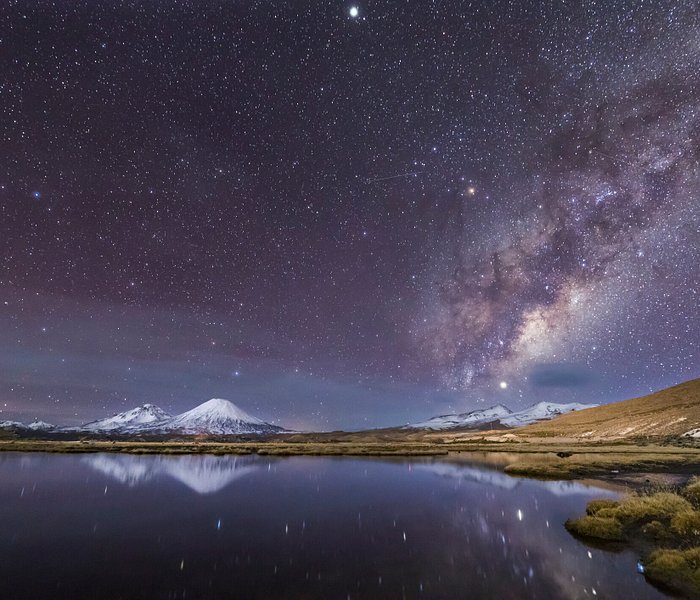

From Lukla to Everest Base Camp: A Guide to the Best Routes and Trails
Quick links, how long is the trek from lukla to everest base camp, where can hikers stay while traveling from lukla to everest base camp, can any level hiker travel from lukla to everest base camp is it safe.
Located in the Himalayas lies the world-renowned trek from Lukla to Everest Base Camp, a journey that draws adventurers from across the globe. This 130 km (77 miles) round trip trek is a challenging but rewarding experience, showcasing the natural beauty of the region and offering a glimpse into the daily lives of the local Sherpa people.
The trek from Lukla to Everest Base Camp typically takes 13 days, starting from Kathmandu. Before embarking on this journey, hikers must train to prepare for the rigorous terrain and high altitude. This is especially important given the risks associated with being at such high altitudes for an extended period.
The trek from Lukla to Everest Base Camp is an unforgettable journey that offers a glimpse into one of the world's most breathtaking regions. With proper training and a sense of adventure, anyone can tackle this challenging but rewarding trek and come away with memories to last a lifetime.
- Lukla to Everest Base Camp is 38.5 miles.
- This entire hike should take people between 11 and 14 days in total.
- Many hikers between these two spots spend 8–9 hours walking daily.
For people wanting to take on Everest Base Camp from Lukla, this will be the journey of a lifetime. This trek between the two spots is approximately 38.5 miles, usually taking hikers 11–14 days. One thing to note, this trek is 38.5 miles either way: totaling 77 miles. According to past hikers, people will begin their eight-day hike from Lukla to the Everest Base Camp and then four days to trek back to Lukla. Some may want to hang out at Everest Base Camp for a couple of days, so that will add time to the entire voyage.
Luckily, the scenery between these notable hiking locations offers unparalleled views of the surrounding landscape, giving adventurers insight into the Sherpa people. Another detail to remember when traveling between Lukla and Everest Base Camp is that most people recommend hiking for 8–9 hours daily to keep the schedule at 11–14 days.
Some people even skydive from Mount Everest : so the adventure doesn't need to stop at the ground.
Related: 10 Stunning Himalayan Hiking Trails That Are Not Everest (Or Even Close)
The Best Trekking Route To Everest Base Camp
When it comes to the best route for those trekking to Everest Base Camp, people want to take The Classic Everest Base Camp trek. This path is the most direct route from Lukla to the 18,192-foot peak of Kalapatar. Hikers will also get the best view of Mount Everest from here, so that's perfect for those wanting to snap a few photos.
However, here are some alternative routes and timelines that one could take to get to the Classic Everest Base Camp Trek:
- Jiri to Everest Base Camp (19–21 days trekking)
- Tumlingtar to Everest Base Camp (21–23 days trekking)
- Gokyo Over Cho La Pass (17–18 days trekking)
- Lukla to Tengboche (around 7 days trekking).
The trek from Lukla to Everest Base Camp is 38.5 miles each way, totaling 77 miles for hikers. Therefore, to finish this trek in 11–14 days, hikers must spend 8–9 hours daily on the move.
- Hikers can stay between Lukla and Everest Base Camp in teahouses, lodges, and campsites.
- Phakding lies between Lukla and Namche Bazaar, making it a great stop along the way.
Trekking from Lukla to Everest Base Camp will have a few lodging opportunities between the two destinations. Generally, past hikers recommend stopping in Phakding, which takes roughly 3 to 4 hours to walk from Lukla. Along this trail, people can stay in lodges or teahouses, which will be primitive and won't be a "typical" experience. The road to Everest may be daunting, so preparing for this journey is crucial .
To explain these teahouses/lodges , they are houses with usually more than two floors but sometimes only one, with dozens of rooms. This could be a fun way to meet other adventure seekers along the way to Everest Base Camp (and back), so don't be afraid to start a conversation.
The trail between Lukla and Everest Base Camp is globally visited, so there will be people from all different cultures and countries to enjoy this with. These ten Everest Base Camp facts may be fun to know before the journey.
Related: Mt Everest: The History & Story Behind The World's Tallest Mountain
In general, if someone is healthy and regularly hikes, they should be able to handle the walk from Lukla to Everest Base Camp. One thing to keep in mind, however, is that this trek isn't easy but isn't nearly as challenging as taking on Mount Everest. The entire region is known for its high elevation and chilly weather, which may be difficult for some hikers.
There are many things to see and experience at the base of Mount Everest , so people don't need to take on the summit to have a memorable experience.
According to trek guides , the Everest Base Camp area is far easier for hikers than other areas, especially when compared to Everest: often considered one of the more dangerous journeys on Earth. It may be helpful to train before heading to Lukla and then to Everest Base Camp, taking on hikes near where someone lives. For example, if there are mountains nearby, that could be a great way to train for this Nepal adventure.
Going to the gym and using machinery at an incline may also help prepare someone for this, although nothing beats getting outdoors. If there is any hesitation with taking on a trek from Lukla to Everest Base Camp, it might be worth consulting a doctor and ensuring people's health is good enough to head to the mountains.
These are ten essential tips for anyone traveling to Everest Base Camp that are worth reading.

- Culture & Lifestyle

- Madhesh Province
- Lumbini Province
- Bagmati Province
- National Security
- Koshi Province
- Gandaki Province
- Karnali Province
- Sudurpaschim Province
- International Sports
- Brunch with the Post
- Life & Style
- Entertainment
- Investigations
- Climate & Environment
- Science & Technology
Visual Stories
- Crosswords & Sudoku
- Corrections
- Letters to the Editor
- Today's ePaper
Without Fear or Favour UNWIND IN STYLE

What's News :
- Sandeep Lamichhane
- Giri Bandhu Tea Estate controversy
- JSPN splits
- Lithuania-Nepal ties
- 2024 Kantipur Half Marathon
Trekking through Himalayan heights to the roof of the world

On travel guides and bucket lists, one destination that echoes is the Everest Base Camp.
Situated at 5,364 metres from sea level, the starting point of the journey is a 45-minute plane ride away to the world’s most dangerous airport, Tenzing–Hillary Airport, from Kathmandu.
Once in Lukla, the journey begins. Theoretically, the distance from Lukla to the base camp can be covered in three days by foot. Practically, it isn’t possible since the walk is a tedious one on treacherous grounds.
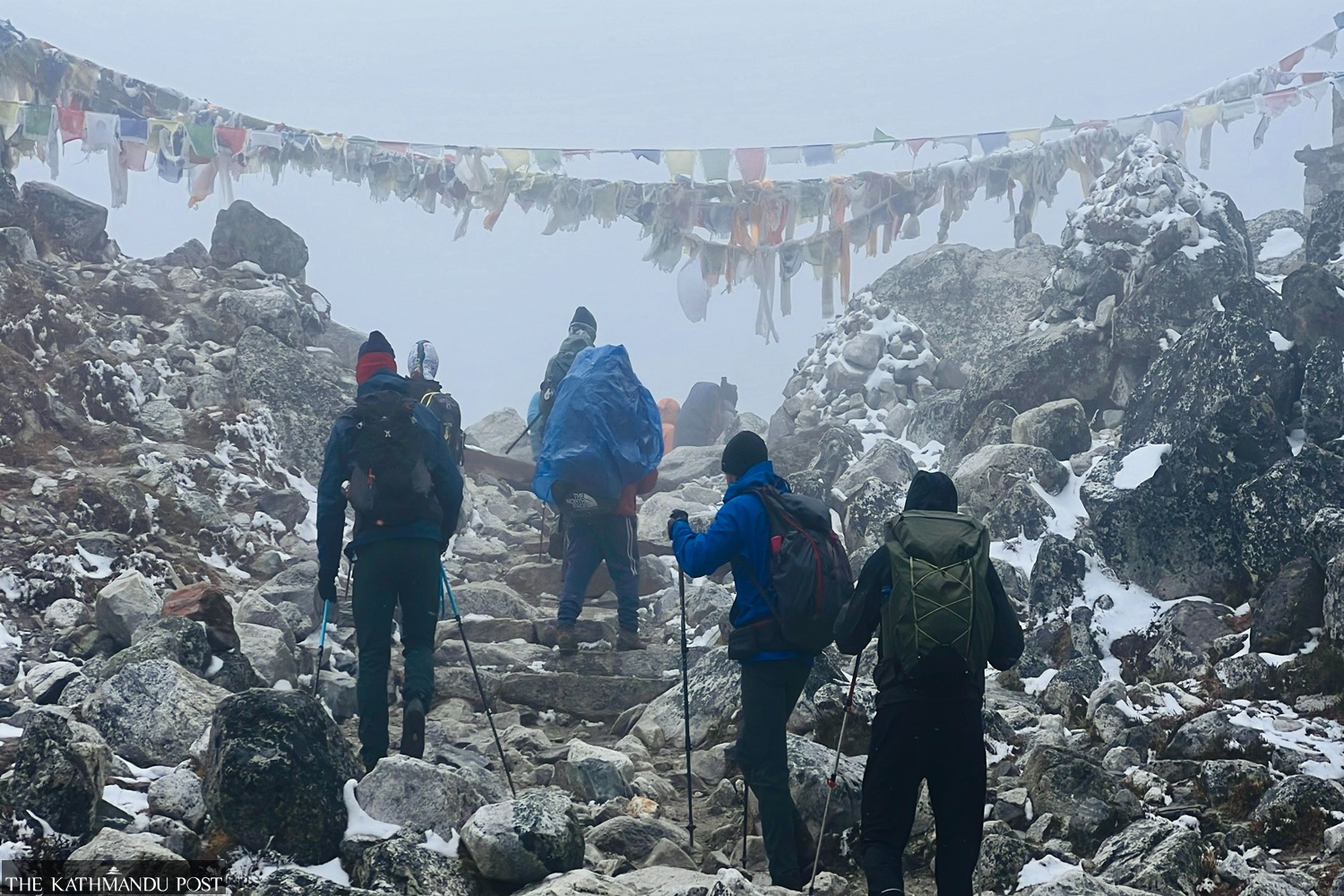
That is why the trek is covered in phases. On the first day, travellers walk from Lukla to Manjo, a small settlement in the Khumbu region. After spending a night, they continue their journey to the famous Namche Bazaar, which is located at 4,340 metres.
From Everest aspirants to those wishing to witness the majestic Himalayas up close to porters and guides earning a living, you encounter numerous stories on your walk to the Everest base camp.
While some travellers return to Namche from Syangboche on the third day, others prefer to halt in Khumjung.
On the fourth day, travellers are greeted by a view of the mighty Everest and other mountain ranges from Tengboche. It is advisable to halt and acclimatise by visiting the Sherpa settlements or hiking to nearby destinations.
We conquer an elevation of 4,400 metres at Dengboche on the fifth day and 5,100 metres at Nangkartshang Peak on day six.

A week into the journey, travellers inch closer to the base camp. While some descend to Lebuche, at 4,940 metres, to spend their night, others find accommodation in Gorakshep, situated 5,180 metres from sea level.
On the eighth morning, we reach the base camp.
The walk back to Lukla typically begins on day nine. It takes travellers two days to descend and by the twelfth day, we’re back in the hustle and bustle of Kathmandu.
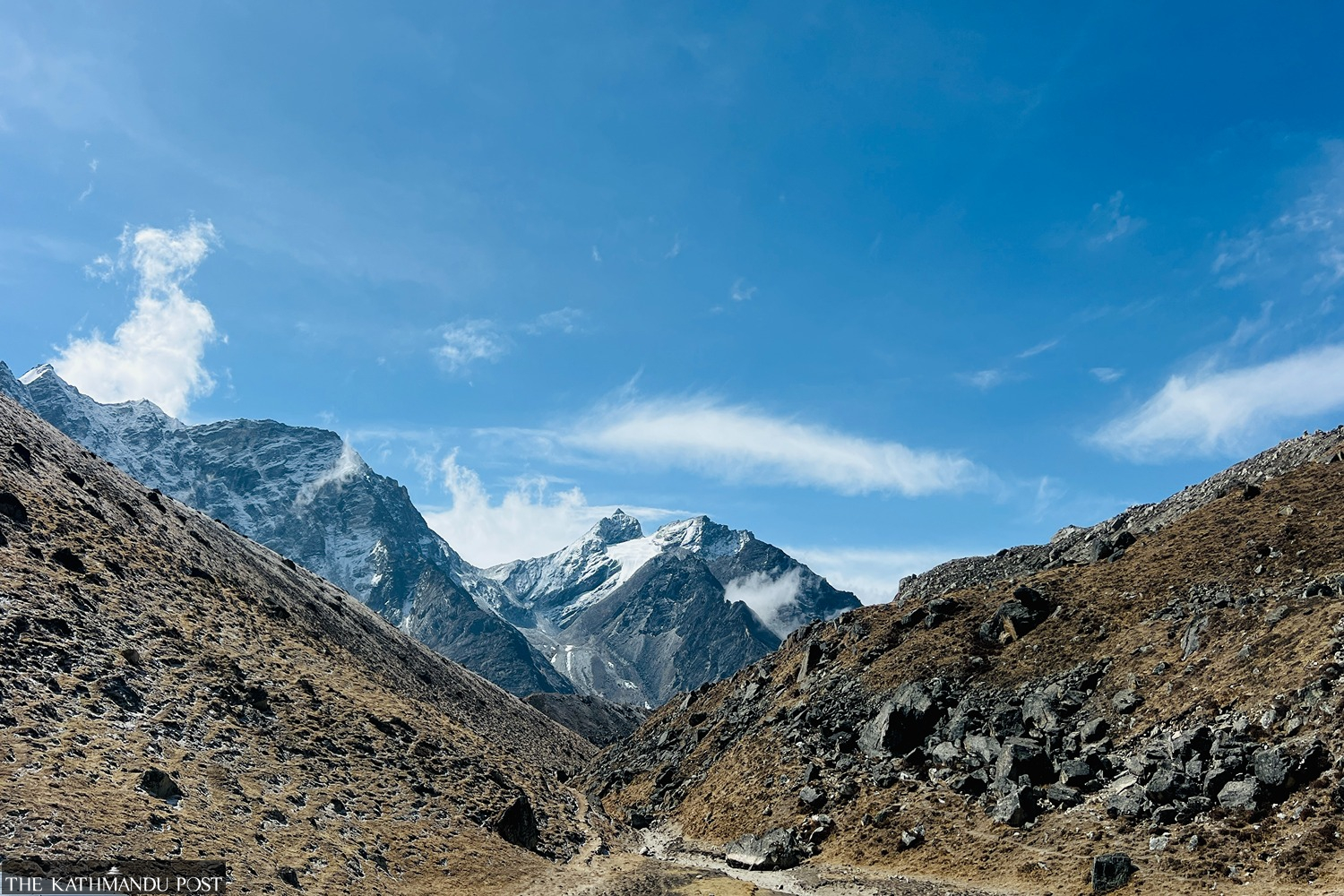
Related News

The week in 7 photos
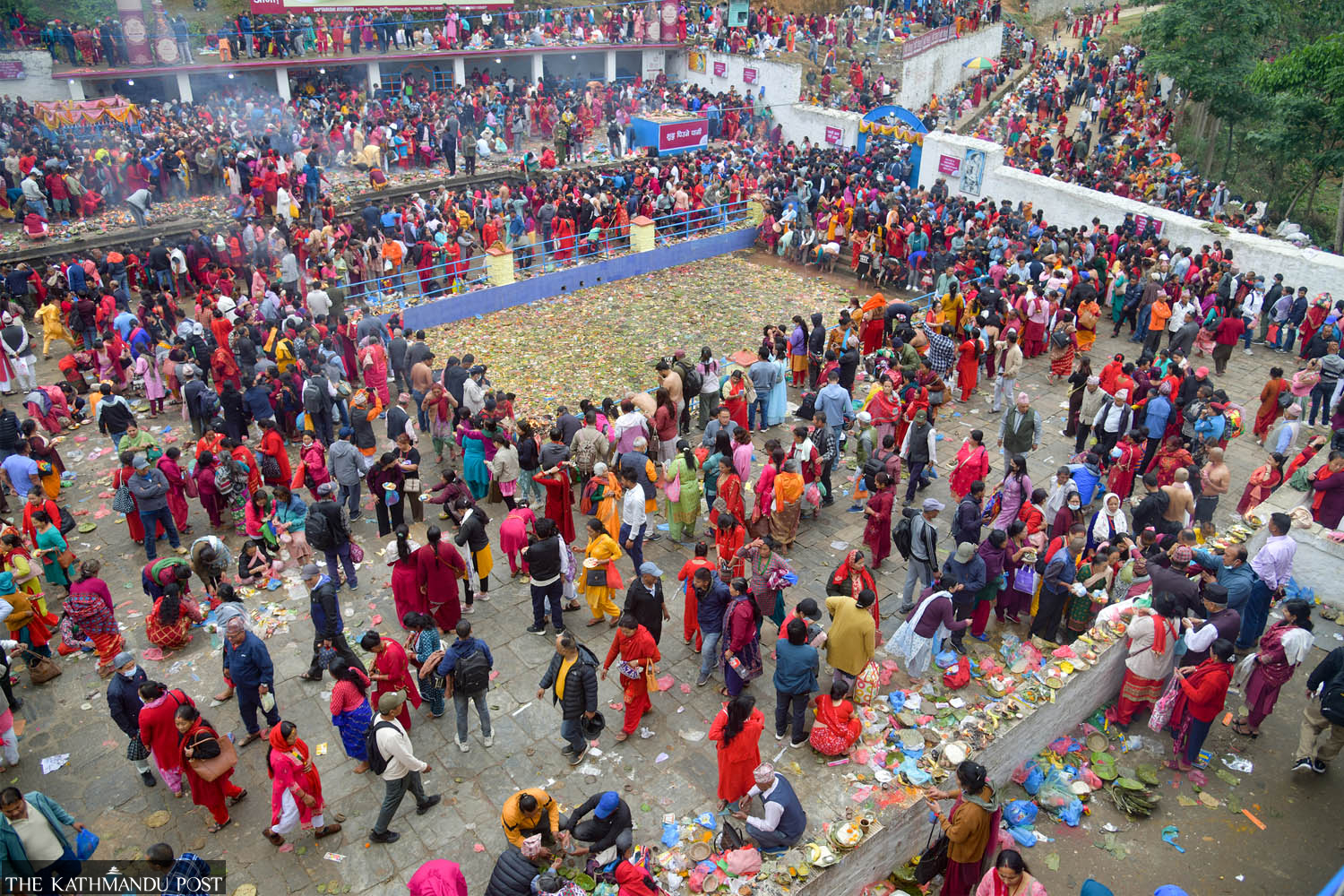
Devotees throng Matatirtha Kunda in memory of mother
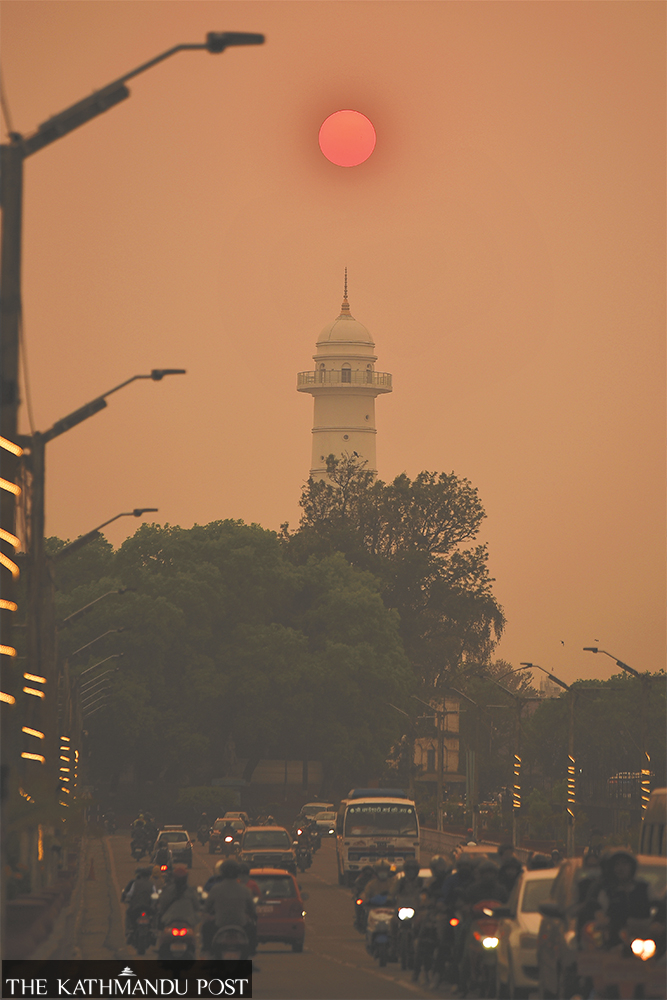
The week in 10 photos
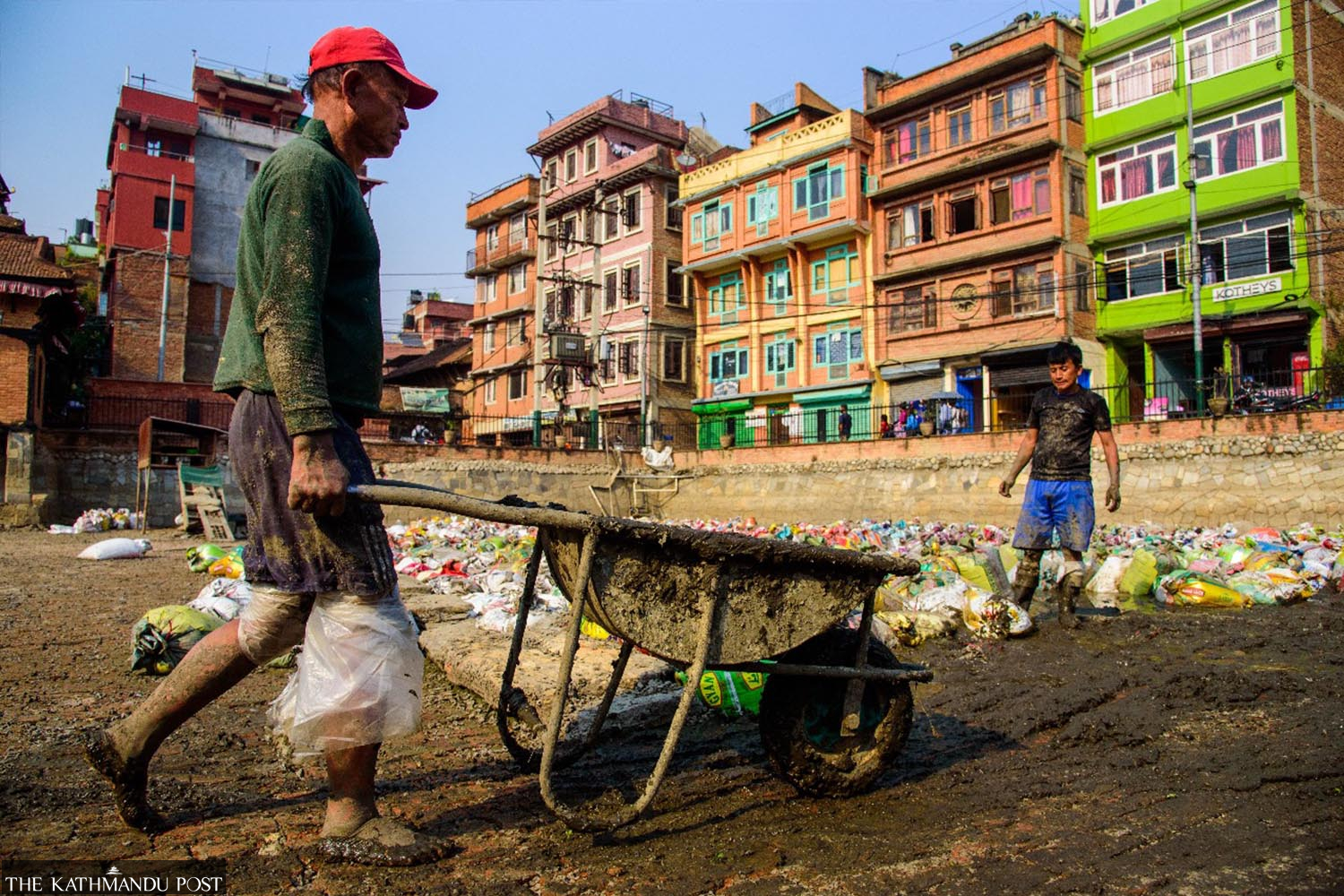
Nepali labourers’ harsh reality as world marks May Day
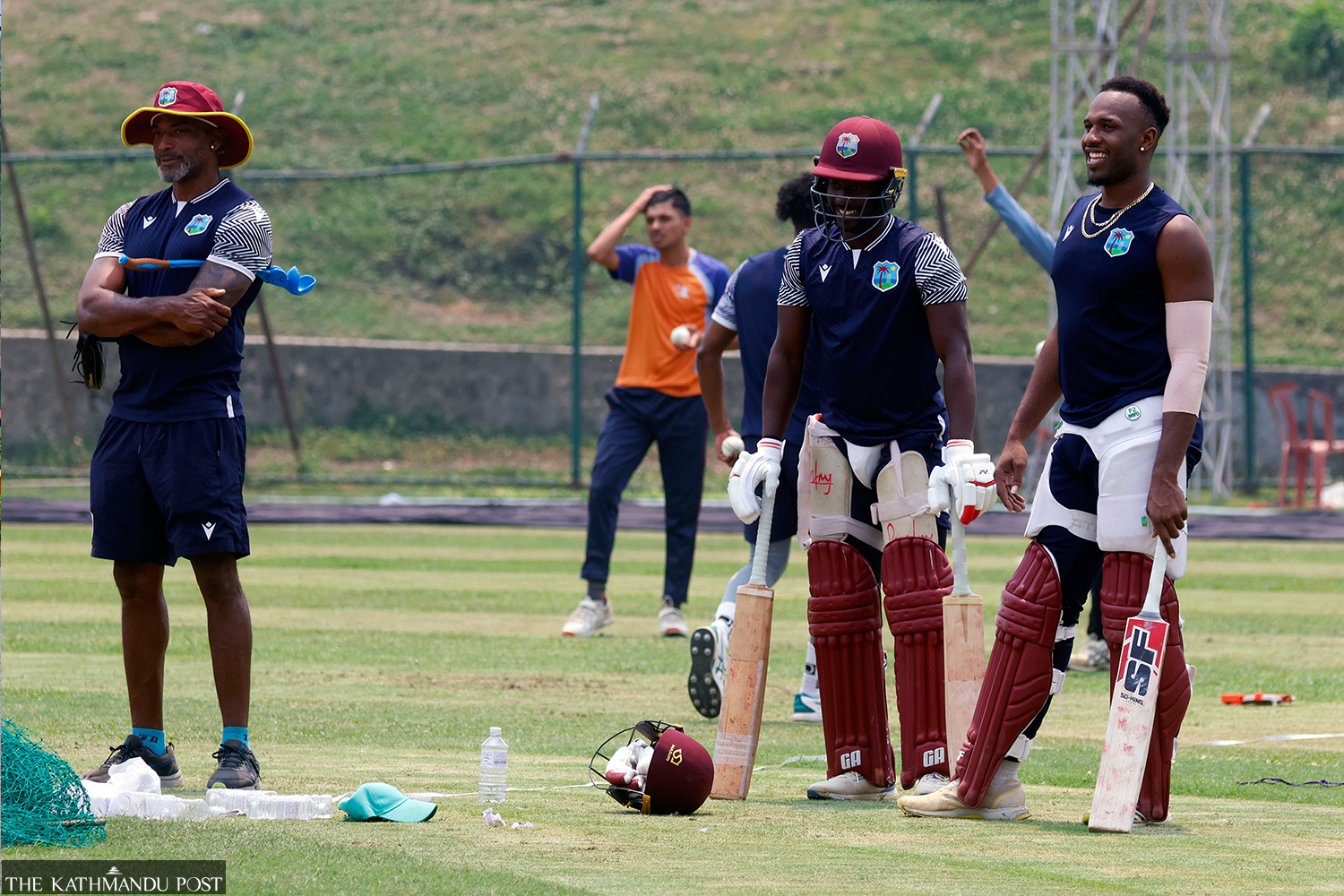
The week in 9 photos
OUTSIDE FESTIVAL JUNE 1-2
Don't miss Thundercat + Fleet Foxes, adventure films, experiences, and more!
GET TICKETS

The Man Who Raced to Tell the World That Mount Everest Had Been Climbed
When Tenzing Norgay and Edmund Hillary made history by reaching the summit, a courier named Ten Tsewang Sherpa ran 200 miles to Kathmandu to deliver the news. He died a few weeks later. His story has never been told—until now.
Heading out the door? Read this article on the Outside app available now on iOS devices for members! >","name":"in-content-cta","type":"link"}}'>Download the app .
By the time Tenzing Norgay and Sir Edmund Hillary reached the summit of Mount Everest in May of 1953, the British had been trying to climb it for 31 years. This was the country’s ninth expedition, in addition to two reconnaissance flyovers commissioned by England’s wealthy elite in the 1930s. Meanwhile, several other countries had been trying to find their way to the summit at 29,035 feet, continually threatening to grab the prize away from the Crown.
In 1947, a rogue Canadian engineer named Earl Denman got to 22,000 feet before being turned back by a storm. In 1951, Denmark’s Klaus Becker-Larsen made it to the North Col—a 23,000-foot ridge on the Tibet side of the mountain—but turned back because of rockfall. In 1952, a Swiss expedition failed to make the summit, perhaps only because their Sherpas got nervous about the weather and the expedition leaders were too polite to push them on. If the 1953 British expedition was unsuccessful, France had the permits in hand to try next.
You can’t really overstate how badly England needed this. Over the previous decade, a yearslong World War II bombing campaign—the Blitz—had destroyed over a million British homes, and the cost of victory put a damper on the economy that lasted for years. In the summer of 1947, British control over India came to an end, resulting in widespread violence and massive loss of life. A few years later, in early 1952, their wartime king, George VI, died suddenly, a few months after undergoing an operation for lung cancer. In short, England was taking some lumps, and the nation was looking for something to celebrate. The coronation of Queen Elizabeth II coincided nicely with Everest’s climbing season .
So when Tenzing and Hillary reached the summit at 11:30 A.M. on May 29, their feat was a source of pride for the whole empire. Britain had proved itself Great. And as the climbers descended, the race was on to tell the world.
James Morris, a London Times reporter, was embedded with the expedition and had been waiting at a high camp—21,000 feet—for news of success or failure. (Morris underwent a gender transition in the 1970s and took the name Jan Morris.) It was hours before she got word, at which point Morris rushed down toward Base Camp in gathering darkness. When she got there, her only means of communication were the mail runners—a half-dozen trusted Sherpas who carried updates from the expedition 200 miles from Base Camp to Kathmandu. There had never been bigger news to deliver.
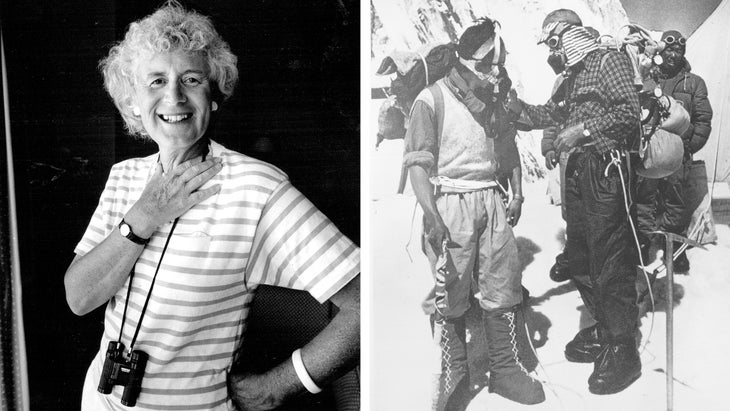
But this is where the story gets fuzzy, imprecise, and very nearly lost. Because there’s almost no record of what happened on that run to Kathmandu. And a few weeks after the message arrived, the runner who carried it was dead.
I first heard about the mail run five and a half years ago, in January 2019, at Base Camp Brewing, a now defunct, climbing-themed bar in Portland, Oregon, with a Nepalese food truck stationed outside. I was there to meet up with Ang Pemba Sherpa, a local photographer, who, I’d been told, had a story to tell. At first glance, Ang Pemba looked like he might be in the habit of running messages over long distances himself. Thirty-eight years old at the time, he was slim and wiry, his face all sharp angles, with just a dash of hair on his chin. Born near Everest, educated in Austria and then the U.S., Ang Pemba had lived in a way that was similar to many Sherpas of his generation. His dad had made a good living in tourism and the climbing industry, and that gave Ang Pemba the means to leave Nepal and live in the States for the previous 20 years. He worked at Next Adventure, a locally famous outdoor store, moonlighting as a photographer and filmmaker for various climbing brands.
“I’m from here as much as I’m from there,” he said during that first meeting. “I’m sort of from nowhere.” Maybe because of that statelessness, he was still haunted by the story of his grandfather, Ten Tsewang Sherpa (pronounced “Ten Chwong”), who ran himself to death delivering the news that Everest had been climbed.
Ten Tsewang was like a Nepalese Pheidippides —the Greek messenger who famously collapsed and died immediately after a 26.2-mile run to tell ruling officials in Athens that they’d won the battle of Marathon. The Pheidippides story probably isn’t true, but it became a powerful part of western cultural history. Ten Tsewang did something similar in real life, perishing a few weeks after delivering perhaps the last piece of world news ever sent by a runner. And his name, as far as I could tell, had never been written down.
We ordered another round. A plan took shape. We would run the Everest Marathon , which starts at Base Camp every May 29 and follows the route the mail runners traveled to the village of Namche. Then we’d keep going, running to Kathmandu as fast as possible, following in his grandfather’s footsteps.
Later we met up again to hash out the details, like where we’d sleep and what we’d carry. I was about to have a second surgery on a previously broken leg, and I was in no shape to run 200 miles, but something about the way Ang Pemba’s eyes lit up when he described the trip made me say: Yes, I will figure out a way.

It took a year to plan everything, then three to wait out the pandemic. My leg healed. Ang Pemba tore his meniscus rock climbing. Jan Morris died before I could interview her.
By the time we got to Everest, on May 29, 2023, the plan had changed considerably. We would no longer be running the Everest Marathon. In fact, we would no longer be running any of the route, just trekking. Instead of traveling light and carrying our own gear, like Ten Tsewang did, we had hired a 17-year-old porter, Rujan Thulung Rai, who kept stopping on the trail to film TikTok dance videos ( @rujanthulung2 ). And instead of doing interviews at Everest Base Camp the morning of our departure like I had envisioned, I was walking around outside our hotel in Gorak Shep having a pretty good cry.
Gorak Shep, at 17,000 feet, is the spot where the Swiss made camp for their 1952 summit attempt. Today it’s a cluster of plywood buildings to house tourists, and modern Base Camp is about a mile and a half—and 500 vertical feet—away.
I never got to Base Camp.
A week ago, we’d taken a helicopter directly from Kathmandu to Namche—at 11,000 feet—and spent a few days acclimatizing and doing interviews. We then began climbing, about 1,000 feet each day, toward Base Camp. We felt great until yesterday, when we got to Lobuche—the usual overnight stop on this part of the trek—in the early afternoon. It was just a couple more hours to Gorak Shep. And only a few hundred extra vertical feet added to the day.
What was the harm in that?
At first, not much. Ang Pemba got a little dizzy; I got a little goofy. We had a good laugh when I pulled out some energy gels and learned that the Nepali word for “poop” is gu.
We made it to Gorak Shep, ate dinner, and went to bed. But I had only been asleep for 45 minutes when I woke up with ice-cold hands and feet, a nauseous brick of a stomach, and a head that felt like a squeezed water balloon.
I tested my oxygen saturation level: 57 percent. Those digits should have been reversed at this altitude.
“All I can say is hike back down,” my wife, an ICU nurse, told me via InReach. “If you lose your balance, that’s an emergency.”
Ten Tsewang would hardly have noticed the altitude. Once he was given the message, he would have left in a hurry, leaping through the boulders and ice blocks of the Khumbu Glacier, leaving behind the snowcapped peaks of Everest, Ama Dablam, and Kala Patthar. There was no time to waste.
It had already taken a day, May 30, for Morris to get back to Base Camp, and at first light the next morning she sent two runners sprinting downhill. They were headed to Namche, which had one of the only radio transmitters in the area. The operator had agreed to send a single message on the expedition’s behalf. Secrecy was paramount, however, and Morris knew that anyone tuning in would be able to hear the broadcast. So the message was short and written in code. “Snow conditions bad,” it said. “Advance base abandoned yesterday. Awaiting improvement. All well!”
Only staff at the British Embassy in Kathmandu and the Foreign Office in London would have known that those sentences meant Tenzing and Hillary had made it to the top. But would anyone be listening at the embassy? Would the military operator stick by his word and send the message? Would the radio even be working? Morris didn’t know. So she spent the next day, May 31, writing out a longer, more detailed account of the climb, and in the morning paid a premium for Ten Tsewang to deliver it to the British Embassy in Kathmandu as quickly as possible.

“All the others [mail runners] were out, somewhere in the mountains between Everest and Kathmandu,” Morris wrote in Coronation Everest , her 1958 memoir of the expedition. “But I had saved the best of them for these last dispatches.”
The first Western climbers to take note of the Sherpas’ natural ability in the mountains were a pair of Norwegian climbers going for a summit in 1907. In 1909, British chemist A.M. Kellas showed up to study the effects of high altitude on human physiology, and almost immediately began promoting Sherpas as the best alpine workforce.
That simple endorsement would change everything. Historically a tiny tribe of religious refugees, Sherpas arrived from Tibet about 600 years ago, scratching level plots of farmland into the steep hillsides of the Khumbu Valley to grow barley and potatoes. They lived higher than trees would grow, burned dried yak dung for heat, and generally worked harder to survive than the nearby lowland tribes, whose farmland was considered more productive and desirable.
But if you were a local farmer who wanted to sell produce in Tibet, all roads led through Sherpa villages. And Sherpas, with their propensity at altitude, could generally carry a lot more than their lowland neighbors. So generations of Sherpas spent entire lifetimes moving goods through valleys and over mountains, hiking up and down steep hills at staggering heights with a lot of weight on their backs. You couldn’t design a better boot camp for mountaineering.

Once climbers started showing up, the steady drip of expeditions brought enough wealth to slowly change the standard of living in the Khumbu. Thanks to some shrewd negotiating over the years, mountaineering work generally paid well, and most expeditions gave away their gear at the end of a climb—especially the warm jackets, boots, and pants—to be used or sold by the Sherpas.
And yet, because Sherpas were the labor class of Himalayan mountaineering, and because their names were confusing to Western mountaineers—most first names are a day of the week and, the last name has also become a job title—it was extremely rare for an individual to distinguish himself in such a way as to enter the historical record. This wasn’t just a case of oversight and confusion, though. Early expeditions were often financed by Brits who opposed India’s independence movement. Never mind that Everest is in Nepal, not India: the British elite wanted a Brit to be first, someone they could point to and claim victory over their former colony. Everyone else was a distraction.
The climbers themselves didn’t do a whole lot to counteract that messaging. Sherpas were so good at moving through the mountains, one anthropologist wrote, that climbers feared it was really the Sherpas doing the climbing, and they were just more cargo to carry to the top. Climbers didn’t go out of their way to share credit.
So we end up with an ethnic group simultaneously celebrated for its strength and endurance, full of individuals whose singular accomplishments and frequent heroism have been glossed over, lumped together, or totally ignored. For example, in Morris’s book-length account of the Everest mail run, none of the runners are mentioned by name. Not one.

The next morning, at Gorak Shep, Ang Pemba went to go tag Base Camp. I started hiking back down the mountain, five steps at a time. Twenty minutes and about 100 yards later, I crossed paths with a guy leading a pony along the rocky trail and asked if I could pay him for a ride to Lobuche. The price was exorbitant in Nepal but would be cab fare in New York. Everyone seemed happy about it except the horse, who stepped forward slightly every time I tried to climb on.
During Ten Tsewang’s 1953 mail run, once he was through the glacier he’d have been able to open up his stride, cruising six miles through the wide, shadeless summer grazing valleys near the villages of Pheriche and Dingboche. It’s more or less downhill after that, across a wooden bridge over the Dudh Khosi River, and into a steep climb, through blooming rhododendrons, up the other side of a canyon to Tengboche Monastery .
This was a good spot to watch Everest Marathon runners, who’d left Base Camp that morning, struggle with the second-to-last major hill of their journey. On the marathon course, eight to twelve hours is a good effort for a seasoned runner. Even the elites come in at around four hours. By all indications, Ten Tsewang would have been near the front of the group.
He was an athlete, and his body always gave what he asked of it. His childhood friend Kancha Sherpa—currently the only living member of the 1953 expedition—said that as kids they would gather firewood together and wrestle in a grassy clearing to see who was tougher.
There is only one picture of Ten Tsewang—five seconds in a newsreel , actually. (You’ll see him on the left, starting at 1:41.) He’s in Kathmandu, posing for a photo with the British expedition leader, Colonel John Hunt . He’s 20 but looks 14, baby-faced and something like five feet tall; he comes up to the chin of Hunt’s wife, Joy. It’s hard to believe that he’s the father of four kids. He’s wearing a pressed button-down shirt and wool beanie, likely new clothes for the occasion. He smiles wide when prompted, but when his face goes slack he looks tired.
We can only imagine what he looked like on the run. We know that his hair was long and would have flowed out behind him. Sherpa men would only begin cutting their hair later, when regular climbing expeditions provided steady income; long hair was also difficult to manage on the mountain. His clothes would have been made from wool or fur, probably with a huge belt around the waist.
His footwear would have been a kind of knee-high moccasin—picture a leather tube sock with laces up the front—perhaps with grass stuffed into it for warmth. His cousin, Kami Sherpa, was a mail runner for the American Everest expedition in 1963 . When your boots started to smell, Kami said, you changed the grass.
He would have carried only the letter from Morris and a small pack. Inside would have been a jug of water and a pouch of tsampa —roasted barley flour and ground nuts. This was the energy gel of its time, a just-add-water meal that could be eaten on the go. If it rained he had a poncho. At night he would have borrowed a lantern from a village, for someone else to return.
His body, clothes, and food were optimized for the environment. He was in his physical prime and had been paid in advance. With all of England expecting news, there was no better or more reliable way to get a message to Kathmandu than Ten Tsewang.
How does someone like that run themselves to death?

The route descends unbelievably quickly. My altitude sickness evaporated and Pemba caught up with me in Pheriche. But by the time we left the Everest region, two days later, we had new issues.
We spent the night in Lukla, at 9,000 feet, where the air felt soupy because it was so rich with oxygen. Most hikers take a flight to Kathmandu from here, but we kept descending, and the trail somehow got even steeper. Our quads burned and our feet cramped from three straight days plodding downhill. Pemba’s knee problems got worse; my leg kept reminding me that it had been broken. That afternoon we limped into a teahouse and sipped from our cups with thousand-yard stares. We were tired, hurting, and just getting started.
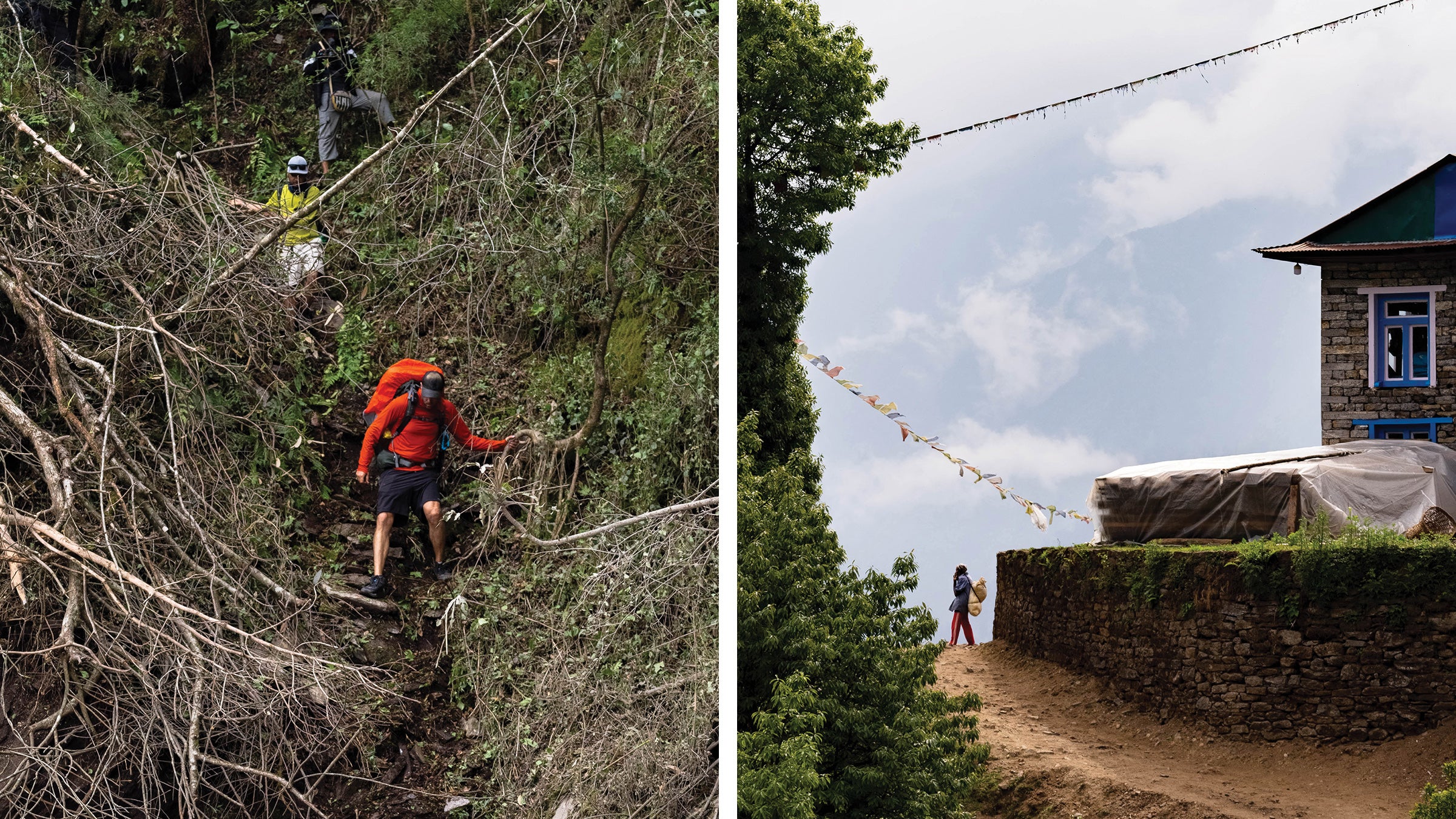
Having so far basically followed the Dudh Khosi River’s straightforward path downhill, our route would soon turn west toward Kathmandu. As we hiked, we were running against the grain of three mountain ranges. The first valley we crossed on our route had roughly the same vertical gain as hiking the Grand Canyon from rim to rim: around 5,500 feet. So did the next three.
The trails themselves were mostly uneven paths made from shoebox-size rocks. We’d hop from rock to rock, trying to avoid those that were slippery with donkey shit. There were very few switchbacks. Most of the route was straight up and down, bouncing between 5,000 and 11,500 feet.
Before the Lukla airport was built in 1964, expeditions took three weeks or a month to make the trek, often arriving at Base Camp disheveled and exhausted. Jamling Norgay—Tenzing Norgay’s son—suggested in his 2002 autobiography, Touching My Father’s Soul, that the trek from Kathmandu to the foot of Everest was harder than climbing the mountain itself.
Morris paid runners ten British pounds to carry her dispatches to Kathmandu. She bumped that up to 15 pounds if they made it there in less than a week; 20 pounds for six days or less. “Two of them, traveling alone, actually did the journey in five days,” she wrote. “An astounding achievement: an average of nearly 35 miles a day.”
In 2013, British ultrarunner Lizzy Hawker set the fastest known time for a run from Base Camp to Kathmandu, making the trip in two days, 15 hours, eight minutes. Impressive, but Hawker ran in only one direction. Mail runners were expected to make the return trip too, bringing news from home. Hawker knew this. “A real challenge would be to run up to Base Camp and back,” she said when she’d finished.
Americans Scott Loughney and Ryan Wagner did exactly that in the fall of 2019. Guided by Nepalese runner Upendra Sunuwar—he’d also guided Hawker during the later parts of her runs—they ran from Kathmandu to Everest and back in nine days, 23 hours, 18 minutes.
“I don’t care who you are or how you’ve trained,” Loughney told me. “The middle hundred miles is going to kick your ass.”
Yet if you truly wanted to re-create the experience of a mail runner—if you wished to prove that you were as tough as Ten Tsewang—you’d have to do the round trip more than once. Because as soon as runners returned to Base Camp, they might be asked to leave again with a new message. By the end of May, when Ten Tsewang embarked on his final run, he had already made the 400-mile round-trip journey twice. When he got to Kathmandu, he would have run almost 1,000 miles in service of the expedition.
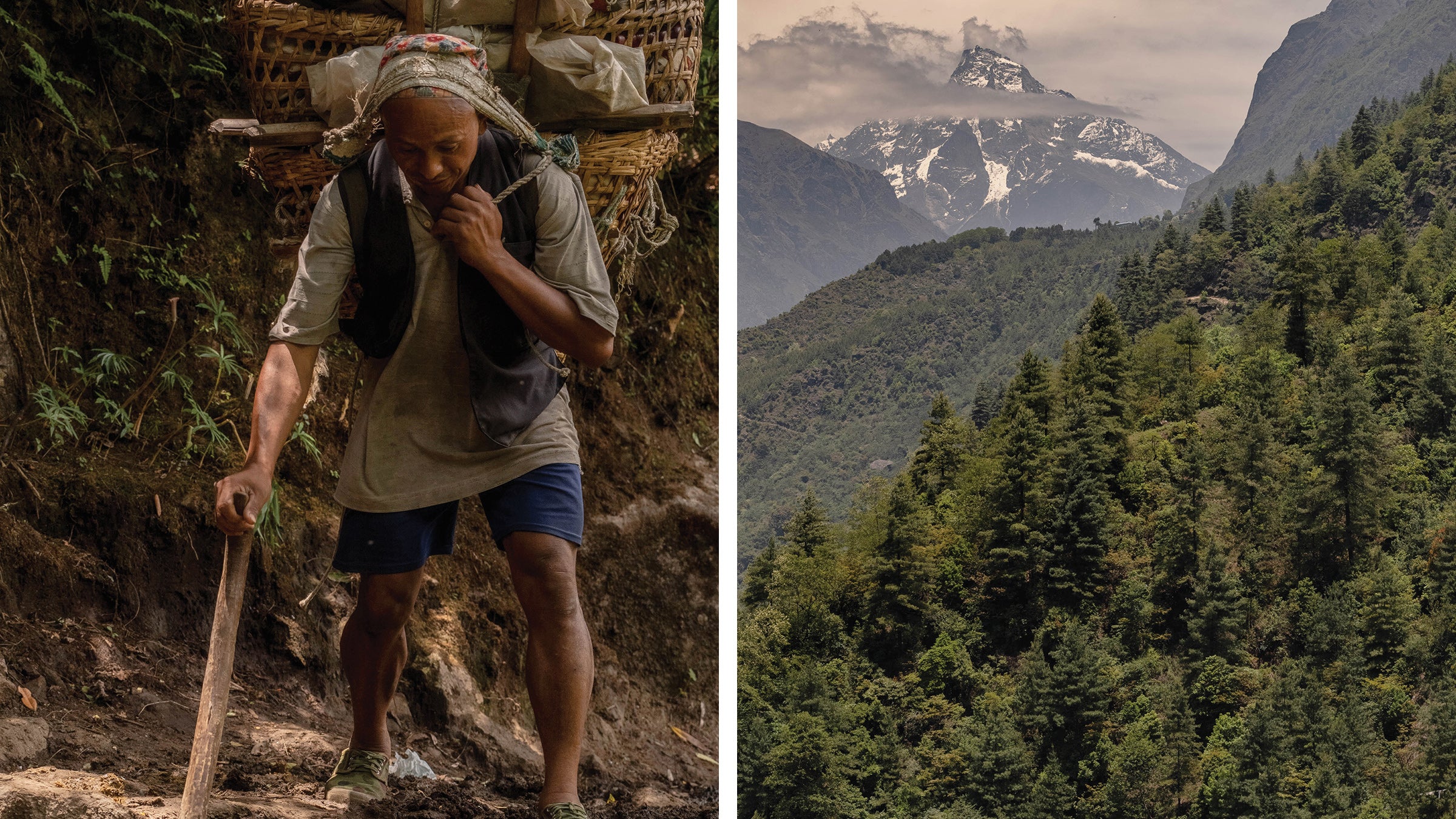
It was an incredible feat of endurance, but not a story people know or tell. It’s almost like it never happened.
When Ang Pemba and I sat down with Upendra Sunuwar for an interview in Kathmandu, he was unsure what we were talking about. He had supported three different FKT attempts and had never heard of the mail runners, much less Ten Tsewang.
“I never knew that was a thing,” Upendra said after we explained. “The whole time I thought they were saying ‘Everest mile run.’ Because it’s a lot of miles.”
Ang Pemba’s favorite stories to tell on a hike are stories from previous hikes. The time he spent a night on that ridge over there—no, the higher one; the time he led a woman with altitude sickness to a medical clinic in the middle of the night; the time he hiked the hardest part of the mail run as a little kid.
He was six years old in Namche when he fell off a fence and broke his arm. He took a medical flight to Kathmandu for surgery and spent a week or two in the hospital. The only way back to Namche was a bus ride to Jiri, and then a very long and difficult walk.
Jiri is halfway between Everest and Kathmandu. It’s where the high country softens up a bit, where mountains become hills and trails become roads.
“I can’t believe I did this as a six-year-old,” Ang Pemba says during one particularly heinous climb up to the town of Nunthala. “What were they thinking?”
His family says he walked the whole way. He wasn’t carried once.
I believe it.
Ang Pemba is energized by this route. He is constantly running ahead to take pictures. He always has two cameras with him: one with a huge telephoto lens that he carries in his hands, and another smaller camera strapped to the shoulder of his pack.
When I manage to catch up to him, he’s often posing someone for a trailside portrait, or taking a shot of field workers in the distance. He’s drawn to images that haven’t changed for a thousand years, that you wouldn’t believe are from the 21st century. Water buffalo plowing fields. Old men scything grass.
His photos make the argument that the past wasn’t so long ago, that it still lives on in certain places, certain people. He takes pictures as if he lost something that can only be found with his camera.
The trail from Jiri to Lukla—the one we’re on—was once a popular trekking route. The airfield in Lukla opened the door for tourists to come to the region, but back then it was like landing on an aircraft carrier parked between two mountains. It was safer and cheaper to take a bus and then hike from Jiri. These days, however, the runway is longer and tourists take helicopters.
There are plenty of places to stay, the path is well-marked, but there are fewer people hiking each season. As a result, most of the youth have gone to Kathmandu to work or have moved abroad to live. Ang Pemba points out that almost everyone in each village is elderly; that the new roads are being built atop the old walking trails; that after another couple of years of growth and development, this route will hardly exist. Even now it barely resembles the path Ten Tsewang took. Ang Pemba’s mission to retrace his grandfather’s steps couldn’t have waited much longer. Soon the route won’t offer any clues at all about the man we’re looking for. Soon, it seems, he will disappear forever.

We know basically what he looked like. It’s harder to get a grasp on what he was like . His eldest son, Pemba Tsering Sherpa, only remembers that he made it back to Namche a few weeks after the run, got sick, and died in bed. “There were no doctors in Khumbu at that time,” he said. “Not one.”
Ten Tsewang’s childhood friend, Kancha Sherpa, remembers him in general terms. “He was a good man,” he said. “With a good heart.”
Lakhpa Sonam Sherpa, a local historian who founded the Sherpa Culture Museum in Namche, had never heard of him. “I studied all the famous climbing Sherpas,” he said. “I never studied the mail runners.”
We can assume that Ten Tsewang was happy to be on the expedition. Historical accounts highlight the extraordinarily good attitudes of workers recruited from Sherpa villages. The “happy Sherpa” stereotype is still something you hear about, even today.
But the recipe for a happy workforce has never been secret.
“Their financial success on early expeditions was a major factor in their cheerfulness,” writes UCLA anthropologist Sherry Ortner in Life and Death on Mt. Everest, her 1999 study of Sherpa climbing .
Happiness wasn’t entirely about the money, though. On those early expeditions—the 1930s and before—tribes from other areas were paid similar wages and did not seem nearly as contented. Ortner writes that Western climbers described them as “sullen, ill-tempered, and largely unreliable.”
The difference, she says, was the way the Sherpa economy was organized. In other tribes labor was owed, like taxes, to a leader or chief, and the expedition worked with that chief to manage personnel. Any payment for climbing or portering work was indirect. It sometimes came only in the form of favors endowed by the chief later on. Sometimes it was simply a way to avoid punishment.
Sherpas, on the other hand, worked for themselves. They were paid directly, in cash, and received bonuses for exemplary performance. One popular reward for going above and beyond on the mountain was a fistful of coins from a chest—as many as they could grab with one hand.
“They were true capitalist workers,” Ortner writes, “selling their own labor power on their own behalf and keeping their own wages.”
Anthropologist and mountaineer Mike Thompson took this idea a step further, suggesting that Sherpas developed their friendly cultural style because they relied so much on relations with other groups.
“Their individualistic, exuberant, risk-taking, reward-enjoying trade has formed the basis for a cheerful, convivial, easy-going, open and hospitable life-style,” Thompson writes. “That has endeared them to generations of Western mountaineers.”
That’s a pretty wide brush to paint an entire ethnic group with, although few dispute the characterization. But it doesn’t fully explain Ten Tsewang.
Before he was a mail runner, Ten Tsewang was a farmer and trader. His village, Namche Bazaar, was home to one of the most popular markets in the region, and strategically located at the crossroads of trails to Tibet (four days away) and Lukla (one or two days away). Lukla was the gateway to the rest of Nepal. Ten Tsewang’s life—and the life of nearly every Sherpa man—was spent hiking up and down these inclines to buy, sell, and trade products like wool, barley, sheepskin, rice, buckwheat, and maize.
Yet one does not get paid—in advance—to run 200 miles in six days, then run it in five because they want to make a good impression. Something else compelled Ten Tsewang.
His son, Pemba Tsering, says it was Tenzing Norgay himself who pushed him so hard.
“They were like brothers,” he says. “He risked his life on the mail run because Tenzing risked his life on the mountain.”

Now 74, Pemba Tsering is compact and stout, with a huge, quick smile and thick fingers and hands. He has a playful face, but from his forearms down he looks like someone who chops firewood by tearing it in half.
Pemba Tsering is in the middle generation of this family. He is Ten Tsewang’s son and Ang Pemba’s father. He grew up not knowing the story of how his father had died. He didn’t know there was a story until much later. He was three when it happened. What would anyone say?
As the eldest of Ten Tsewang’s four children, he was tasked with finding an income for the family. The situation was bleak until Tenzing Norgay sent for him.
Apart from Pemba Tsering’s story, I couldn’t find any firm evidence that Ten Tsewang and Tenzing were close. He isn’t mentioned in any historical accounts, but of course he wouldn’t be. No one I talked to could comment on their friendship, but that isn’t surprising: this was 70 years ago. People tend to exaggerate their connection to someone like Tenzing Norgay, who became world-famous when the news of success on Everest made it back to London. Still, it seems likely that they knew each other: it would have been Tenzing who chose Ten Tsewang for the job of mail runner.
Tenzing had been the sirdar—the head Sherpa—on the 1953 expedition, so he hired a lot of people for a lot of jobs. Being a mail runner was desirable: it paid well, and you didn’t have to risk your life with high-altitude work. Later, when Tenzing summoned Ten Tsewang’s son to come to Darjeeling for school, it opened up a world of opportunity that wouldn’t have been available otherwise. That seems like the best evidence of their friendship.
The problem was that as of 1959, Pemba Tsering had never been to school before. By the time he started, he was a nine-year-old in a class of first-graders. It wasn’t a good fit, and he stopped going after a week. When Tenzing found out, he had an angry-parent moment and said that if Pemba Tsering didn’t like school, he would work. The next day, Tenzing had him wash dishes and deliver room service at the hostel connected to the climbing school. Eventually, Pemba Tsering became something like Tenzing’s personal assistant, carrying his luggage on trips, setting up his tent on climbs, and accompanying him on official business.
It was a good job, he said, but he was surrounded by mountaineers all the time. He realized that he wanted to be one, too.
So in 1969, at 19, he went back to Everest and joined a Japanese expedition. He got altitude sickness at Camp Two but didn’t tell anyone. He just snuck away to puke. In 1971, he worked on an expedition for the Argentinian military. “The equipment was bad, the food was bad,” he said. “Anyway, we try our best.” He climbed to the South Col at 26,000 feet that year. It was the highest he ever went on Everest.
In 1972, he decided that if he was going to make a career out of mountaineering, he needed more training, so he went back to Darjeeling to enroll in the mountaineering school where he’d grown up. This was the only formal education he ever had.
The next year he worked on an Italian expedition that was unlike anything that had come before it. A 64-person, mostly military team led by Italian adventurer Guido Monzino, they hired some 80 Sherpas and 3,000 porters to get to Base Camp. During the climb, they had three helicopters and flew in fresh vegetables every day. Things have been getting more luxurious on Everest ever since.
Pemba Tsering’s climbing career spanned 30 years and 42 expeditions. He survived avalanches and accidents, and worked with the best climbers in the world, including Reinhold Messner and Peter Habeler, eventually becoming a sirdar himself on expeditions to Everest, Annapurna II, and Dhaulagiri II. In 1981, with contacts all over from his expeditions, he started Amadablam Trekking and ran it from Kathmandu.
His work as a sirdar made him, at times, a celebrity. Throughout the 1970s and ’80s, whenever climbers from a country made it to the top of Everest for the first time—Spain, Austria, Korea, Japan—they sometimes brought their sirdar with them for a victory tour back home. Pemba Tsering attended bullfights as the guest of honor; his movements and opinions were regarded as news. People would cry when they didn’t get his autograph. He was treated like a king.
“Mountain also not a bad job,” he said with a grin.
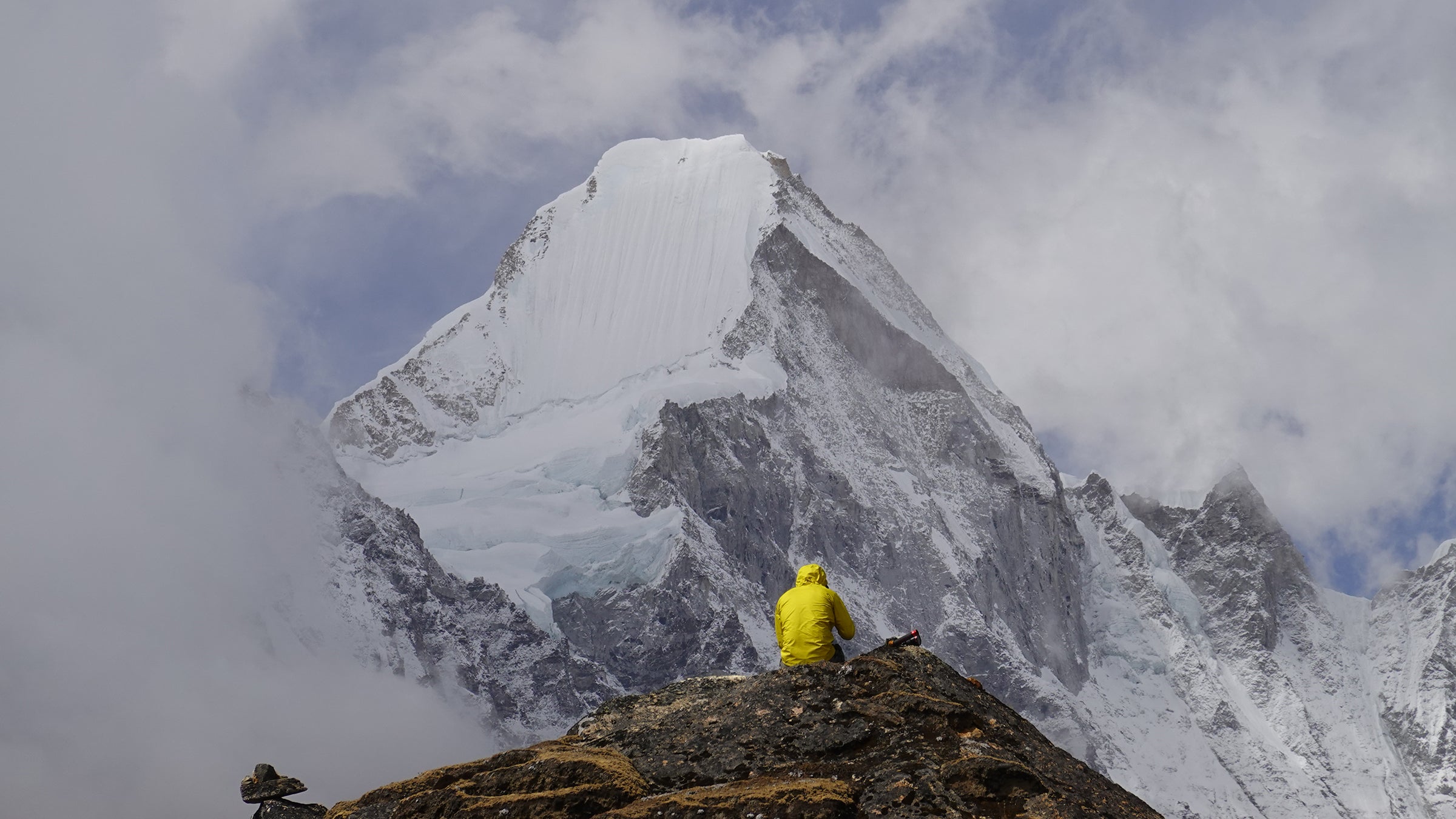
I asked him if he ever thought about a life where none of this happened, where it wasn’t Tenzing who made the summit and became famous, where his father wasn’t motivated to run so hard that he died, where he wasn’t summoned to climbing school and didn’t have a career in the mountains. Was this all because Tenzing felt guilty about Ten Tsewang’s death?
He thinks quietly for a minute. “It wasn’t Tenzing’s fault,” he says finally.
“How did your father die?” I asked.
“Low-altitude sickness.”
I wait for him to smile and acknowledge the joke. But later he says it again.
As we progressed toward Kathmandu, our days fell into a brutal rhythm. We would wake up, eat as much breakfast as we could cram in, and try to hit the trail before it got too hot. We were rarely successful. It was early June, and everyone kept saying that the monsoon rains were coming, but they sure weren’t here yet. At lower elevations, temperatures and humidity peaked in the mid-nineties. We tried to adjust our pace so that we ended each day up high, to sleep where it was cool.
As a result, most mornings were spent descending, and afternoons climbing in terrible heat.
As we moved up and down, Ang Pemba’s fitness changed dramatically. Whenever we were up high, he could charge down the path to take pictures whenever he wanted. Down low he got noticeably slower. I’d sometimes leave him behind. He said that he wasn’t any good in hot weather, but one night we stopped in the village of Kharikhola, at 6,600 feet. We’d been twice that high two days ago, and while I felt and slept better, Ang Pemba felt worse. At dinner he slumped in his chair, elbows on the table, barely able to keep his eyes open.

“This always happens below 8,000 feet,” he told me. “I never have any energy.”
When Ang Pemba’s father told me about low-altitude sickness, I didn’t know what to think. Some kind of joke? Mistranslated folk wisdom? But when I looked into it back home, I found out it’s a real condition.
Scientists call the phenomenon high-altitude de-acclimatization syndrome, or HADAS, and it occurs when someone who lives at altitude descends too quickly.
In a 2013 study of seasonal factory workers in China who returned to sea level after six months working at 12,000 feet, researchers found that one-half to three-quarters of the group experienced a suite of symptoms eerily similar to mountain sickness—fatigue, dizziness, coughing.
The authors, a group of ten researchers from the Institute of Respiratory Diseases, and one from the College of High Altitude Military Medicine, both based in Chongqing, aren’t sure about the mechanism, but their paper suggests that having too much oxygen in one’s blood may cause inflammation and tissue damage that the body has to process and repair—like feeling exhausted when your immune system is working overtime to fight a virus.
Unlike altitude sickness, however, HADAS’s symptoms are mild and never life-threatening. A 2019 study by the same authors showed that pollen capsules were effective at mitigating the effects. It would be nearly impossible to descend quickly enough on foot to die from the shock to your system.
But oxygen isn’t the only thing that changes with altitude.
As we hiked our way through the peaks and valleys of rural Nepal, we began to notice certain differences between elevations. Some were obvious and expected, like trees and insects disappearing up high. Some were more surprising, like the way accents changed. The owner of the hostel where we stayed in Kharikhola—Keshav Regmi Magar—explained that in this part of Nepal, everything was organized by elevation, even people.
This is because altitude affects the kinds of crops you grow, the kinds of animals you raise, the type of clothes you wear—culture itself is shaped by altitude. In the flatlands, different tribes stuck together and lived in one place, like different types of food on a plate. Here, tribes gravitated toward specific altitudes, spread through the mountains like the layers of a cake.
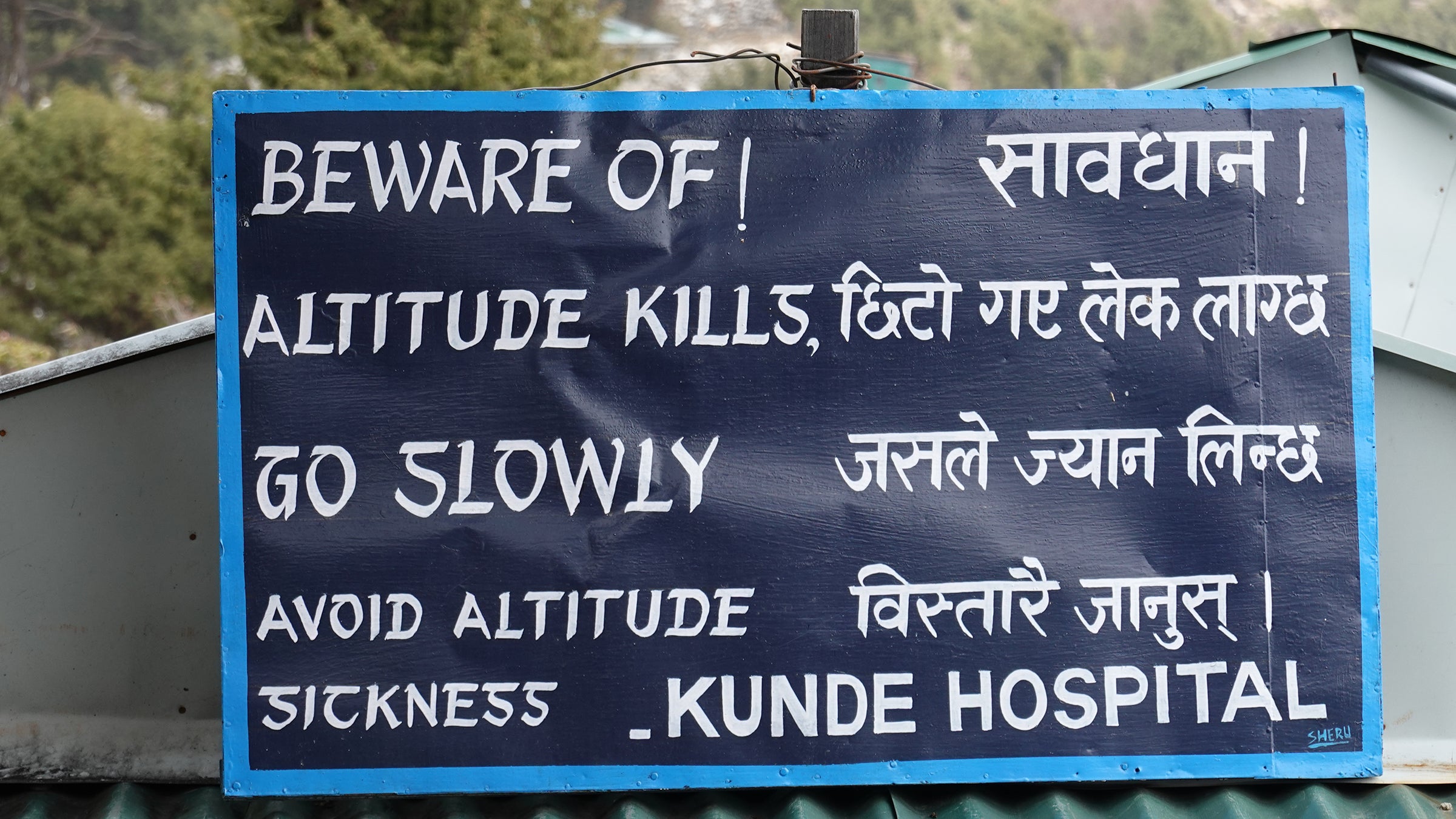
As we got farther away from Everest, Keshav said, we’d find that it was still Sherpas living up high. And we did. Other tribes—Magar, Tamang, Rai—lived at lower elevations, some along the rivers, others on the hillsides. Historically, because each elevation had its own bugs and illnesses, different tribes developed distinctive immune systems. As a result, travel was sometimes limited: In the winter, you could go anywhere you wanted. But once it got hot and the mosquitoes came out, travel between elevations was dangerous.
Ang Pemba called it “ auhl.” In Sherpa, it referred to all the different ways you got sick if you went down too low during summer. Low-altitude sickness. Before modern medicine, Sherpas never went below Lukla after May, much less all the way to Kathmandu. Ten Tsewang got a bonus for delivering his message quickly, but he should have asked for hazard pay.
Two hundred miles isn’t such a long way really, but it’s far enough for the world to change completely.
We had started up high, and we were cold; now we were down low, and it was hot. Instead of being circled by vultures in an expanse of ice and rock, we were watched by wild monkeys, perched in trees, as we drenched ourselves and gulped water from natural fountains.
When we began, it felt like pretty much everyone we met had some connection to Ang Pemba. His cousin owned the best restaurant in Namche; a photo of him as a child was on the wall at one of our hotels. At one point near Lukla, we paused to buy soda from a guy selling bottles out of a basket, and it turned out that Ang Pemba’s grandma was his aunt. Then the man’s neighbors wandered over, and they knew Ang Pemba’s mom.
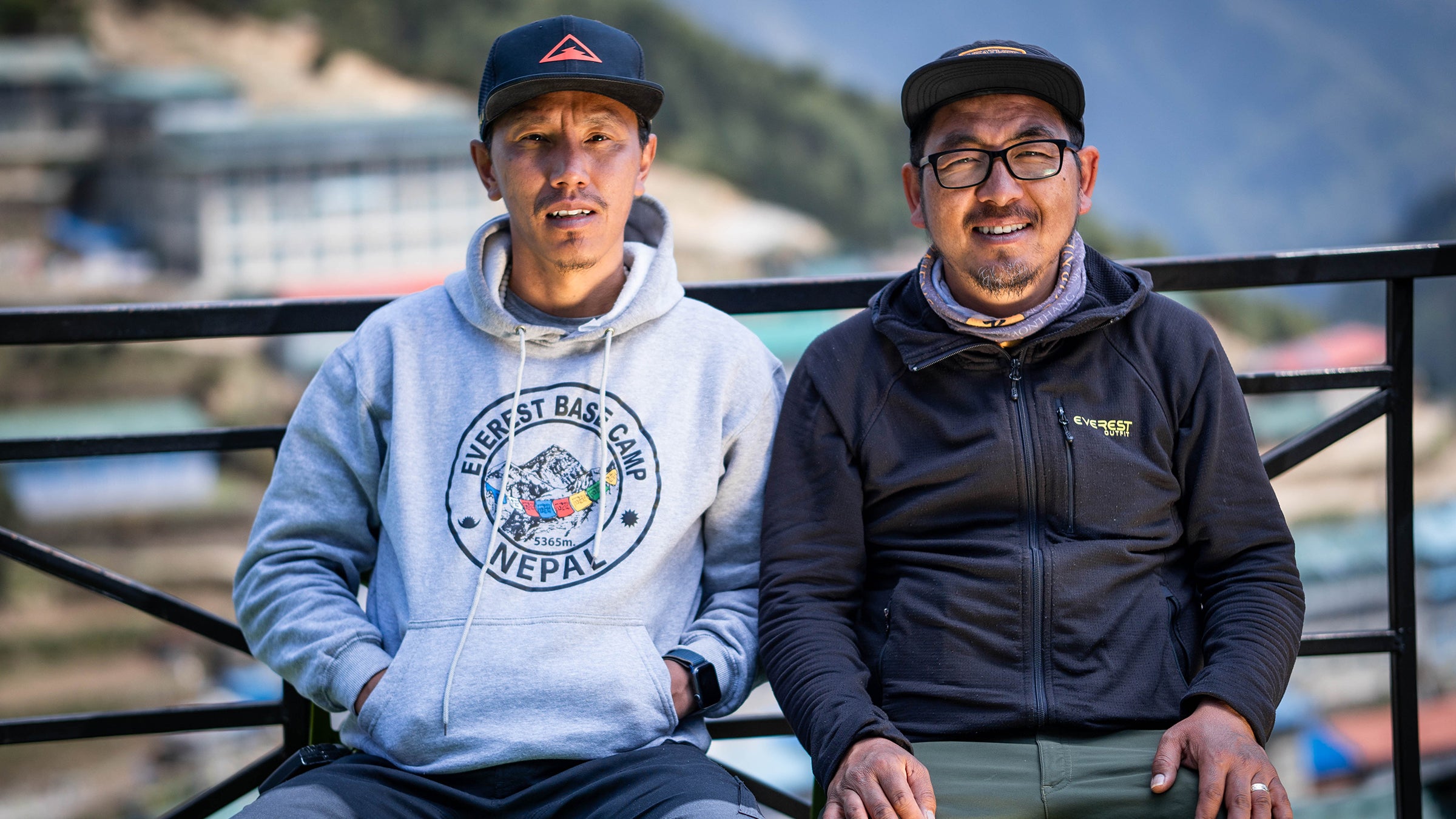
As the days went by and we put Everest farther behind us, everything got much less familiar. Shaded, rocky trails turned into sun-beaten dirt roads. Sun-beaten dirt roads became pavement shimmering with heat. People stopped knowing Ang Pemba’s family, then they stopped knowing his village. He replied “Solu-Khumbu”—the region’s political name—when asked where he was from.
Eventually, we met a guy named Umesh. He was traveling from the district of Surkhet to work on new electrical lines.
“Where are you guys coming from?” he asked in Nepali as we walked along the same path.
“Mount Everest,” Ang Pemba said.
“Ever-rest,” he said slowly. “Where’s that?”
Like his father, Ang Pemba left Namche when he was nine. Unlike his father, he didn’t go to climbing school; instead he went to an English-language boarding school in Kathmandu. His father had been the only nine-year-old in first grade, but Ang Pemba’s education was right on track. And this, too, was thanks to the 1953 Everest expedition.
After Hillary reached the summit and was knighted, he came back to Nepal and offered to build hospitals—there were almost no doctors in Khumbu. The community declined the offer. They would prefer schools.
So Ang Pemba was educated at the Edmund Hillary School in Khumjung, a 45-minute walk from Namche, which allowed him to go to boarding school in Kathmandu and learn English, which allowed him to go to Austria and then Wisconsin for college. That was 19 years ago. The disconnection from his homeland has been profound.
It’s a common story. Climbing changed the lives of one generation; education changed the lives of the next. So many Sherpas have left the region that when we dropped in on Pemba’s old school in Khumjung, most of the students were from other tribes—all the Sherpa families had left. Kids from downvalley were coming up to take their spots in the classroom.
Ang Pemba is undecided on whether he’s had a better life in the U.S. He had a hard time at first, so far from Nepal, not knowing anyone. Eventually, he transferred to Portland State University to be closer to family members in Oregon. But he suffered panic attacks, and his fear of having one in public kept him cooped up at home. A doctor gave him medication; he never took the pills, but it helped to know he had them. He just held them in his hand, inside his pocket, as a kind of comfort.
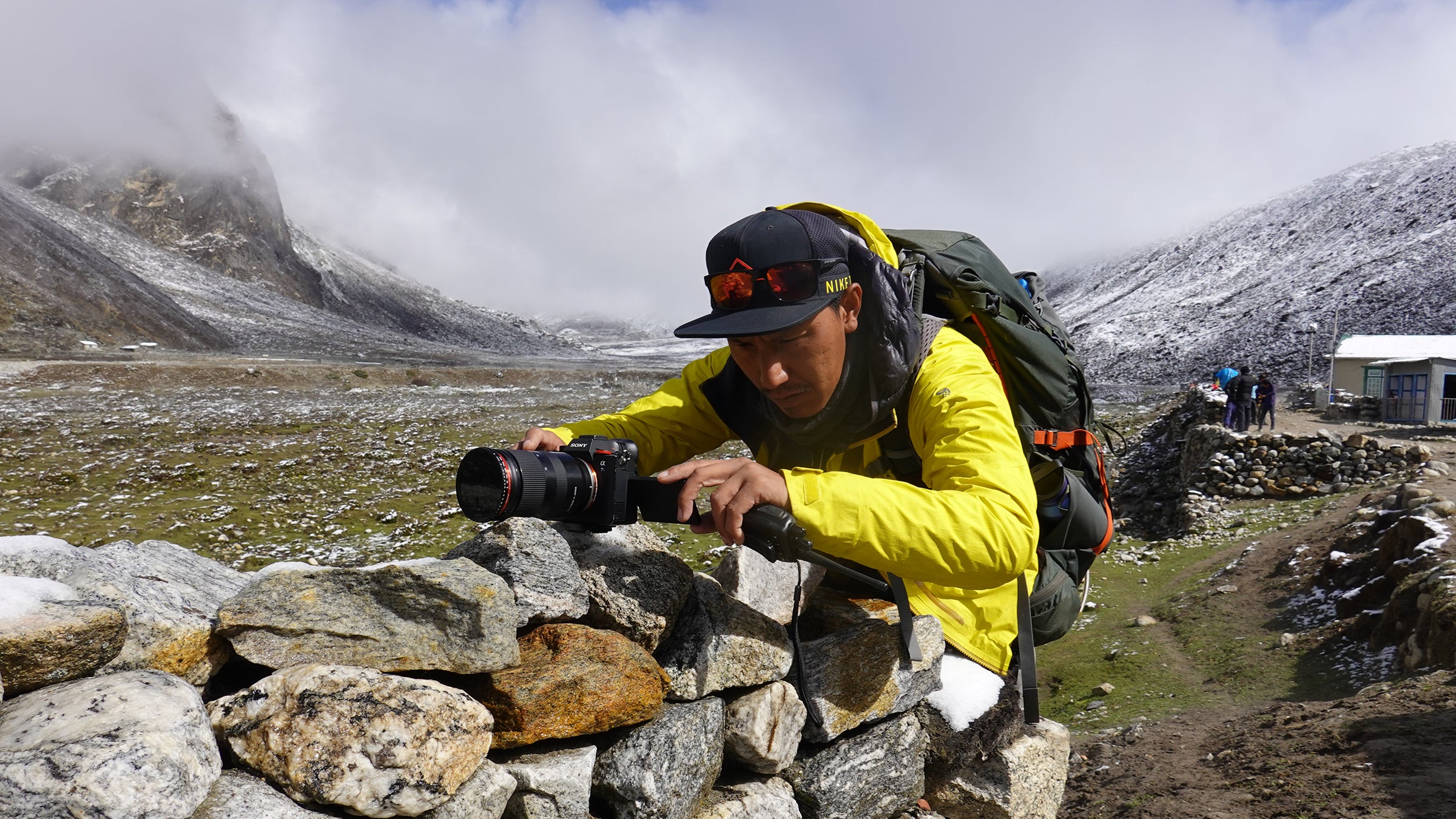
“Why didn’t you go back to Nepal?” I asked.
“I couldn’t leave my room,” he said. “How was I supposed to travel?”
The one thing that helped was taking pictures. He found that if he had his camera with him—if he had a reason to be outside—he could go out and do things. First a park, then a hike, then a backpacking trip. After we met, he found himself organizing a trek retracing the mail run. It was a rescue mission for his grandfather’s memory—his chance to bring something back to the community he left behind.
“I’ve been trying to find an identity as someone from both places,” he told me later. “Seeking my grandfather is seeking myself.”
On the final lunge toward Kathmandu, I found myself wondering how Ten Tsewang’s story had survived at all. He’d been left out of the written history, his kids had never known what he did, and no one else seemed to remember, either. It wasn’t a story people told.
I was quite far into this journey before I realized that there was someone else with Ten Tsewang on the mail run.
Palden Sherpa.
Everyone remembers the same detail about Palden.
“Always drinking,” his son Anu Sherpa said.
“Drinking, every day drinking,” Pemba Tsering told me.
Palden lived to be 90. He was Ten Tsewang’s cousin. They made the run to Kathmandu three times together, but Pemba Tsering never knew that. He would see Palden at weddings, at ceremonies, and Palden never brought it up.
That might be because Pemba Tsering had left Namche, left the community. He was off guiding famous climbers, or he was in Kathmandu organizing logistics for foreign trekkers. He was raising his family’s standard of living, but losing his connection to the Khumbu region in the process.
It wasn’t until Pemba Tsering was in his thirties that this situation started to change. That was when he moved back to Namche, when his kids became fixtures playing in the grassy field at the center of town. One day, hiking the steepest part of the trail between Namche and Lukla, he realized that there was a stretch where almost everyone got thirsty but there was nowhere to get a drink. It was the very first spot where you could see Everest. He opened a teahouse and worked there every day, carrying his liquor inventory back up the hill at night to keep it from being stolen.
Palden walked between Namche and Lukla constantly. His house was in Namche; his wife’s family was near Lukla. He was probably the only person in Nepal who really knew Ten Tsewang’s story. He stopped in at the teahouse all the time but never talked about it.
All Pemba Tsering knew about his father’s death was that he’d gotten sick in the low country and died very young. He had no idea why he was down there. Everyone knew you didn’t go below Lukla after May.
Palden knew why Ten Tsewang had gone. But he wasn’t telling. Not to outsiders.
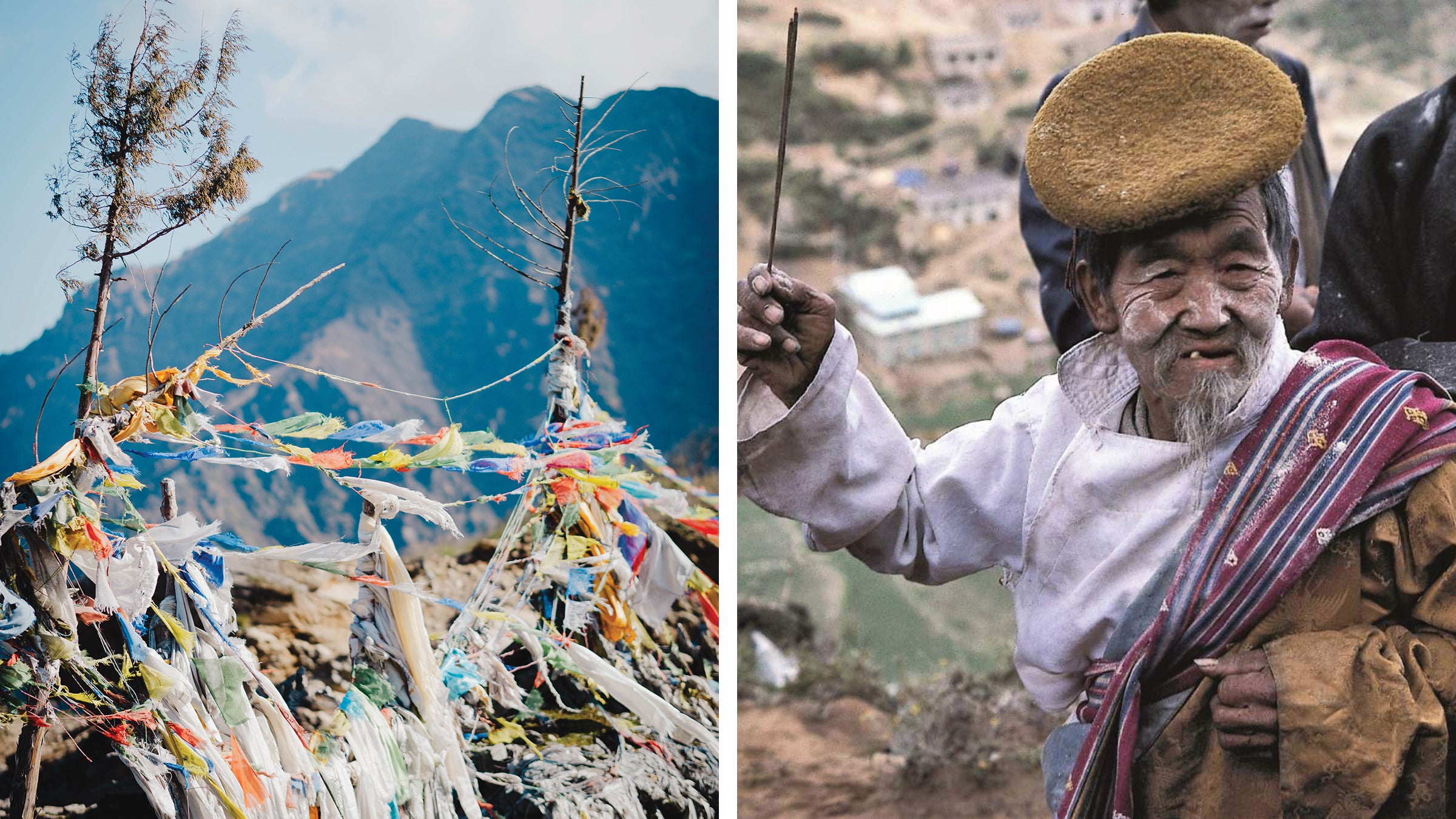
One reason for Palden’s silence may have been that the story wasn’t so flattering. To tell it would mean describing how Ten Tsewang was always urging Palden to move faster. How Palden would protest and plead with him to take a break, slow down. And how, instead of easing the pace, Ten Tsewang would run ahead, drop his stuff, and come back to carry Palden’s pack.
Or maybe his silence was because, in the end, they weren’t the people who broke the news of the climb’s success. As it happened, the first message, the one sent by radio, made it through. News of the first Everest ascent was published in the London Times evening edition on June 1, 1953, the night before the queen’s coronation. The longer dispatch, which Ten Tsewang and Palden carried, was published a week later, on June 8. They came in second.
Maybe he didn’t talk about it because, according to Morris, not a single mail runner knew the contents of the message they carried, in order to guard its secrecy.
More likely, they did know. They would have been aware that Tenzing was going for the summit that day. And suddenly they had a message of the highest importance to deliver? They weren’t stupid.
Whatever the reason, the story of the mail run might have been lost forever if Pemba Tsering hadn’t opened that teahouse and Palden wasn’t such a loyal drinker. One time, probably in the mid-1980s, he stopped in and the place wasn’t busy. And there was Pemba Tsering behind the bar, with plenty of time to chat.
Palden sat down and ordered his usual.
“You know, you look just like your father,” he said after a moment.
“Really?” Pemba Tsering said, pulling up a chair and settling in. “How did you know my father?”
- Mount Everest

IMAGES
VIDEO
COMMENTS
Duration: 2 days of trekking. While the trek from Lukla to Namche Bazaar can be done in one long day, it's much more comfortable and common to spread it over two. Most trekkers arrive in Lukla from Kathmandu on a morning flight and start their trek shortly after. The trail is steadily uphill, and follows the Dudh Kosi River for much of the way.
Lukla to Namche Bazaar or Everest Base Camp Trek: In 2016, I embarked on a transformative and unforgettable journey to Nepal that deepened my appreciation for this stunning country and its people. It paved the way for numerous life-changing experiences and lessons. One highlight was a four-night trek through the Everest region!
Lukla to Namche Bazaar Trek Distance. Lukla (2840M) to Namche Bazaar (3440M) is just an 18 km distance ascending uphill. This is a two-day trekking trail, taking you through cascading waterfalls, snow-melted rivers, Sherpa villages, a Suspension bridge, a praying flag, etc to enter Sagarmatha National Conservation Area.
The time it takes to reach Namche Bazaar from Lukla can vary depending on individual walking pace and weather conditions. On average, it takes about 6 to 8 hours to trek from Lukla to Namche Bazaar. The distance between Lukla and Namche Bazaar is approximately 9 miles (15 kilometers) along the Everest Base Camp trekking route. The trail ...
Detail Itinerary. Day 01: Flight to Lukla early in the morning (2827 meters. 35 minutes) and trek to Phakding (2640 meters.3 hours walking) stay overnight at Lodge. Day 02: Trek to Namche Bazaar (3440 meters. 6/7 hours walking) stay overnight at Lodge. Day 03: Explore Everest View Hotel to see Mount Everest and visit Khumjung Sherpa Day 04: Trek back to Lukla (4 ½ hours walking) stay ...
Namche Bazaar Trek leads to visit the gateway of Mt Everest and also the center of Khumbu, Everest area. ... The trip attraction is the Everest view hotel trek to enjoy the panorama. From Lukla to Namche Bazaar trek is just two days of hiking. Regd. No: 175840/074/075, Tourism License No: 2432 + 977 9851203181 [email protected]
The Namche village trek is also known as the 3 days Everest base camp trek. The trip starts with a quick flight towards Lukla, and then the trekking begins up to Namche bazaar. Enjoy a 3 days EBC trek at the best cost for 2024 and 2025.
Itinerary Expand All. Day 1: Fly from Kathmandu to Lukla (2886m), takes half an hour by flight, Trek to Phakding (2640m) - Trek for 3-4 hours. Day 2: Trek from Phakding to Namche Bazaar (3440m)- Trek for 5-6 hours. Day 3: Exploration day in Namche Bazaar, hike for couple of hours nearby. Day 4: Trek from Namche Bazaar to Lukla.
"Namche Bazaar." Lukla to Namche Bazaar will require an absolute two-day trek. Also, there will be sure teahouses around the trekking preliminaries towards Namche Marketplace, serving great for the adventurers. Namche Bazaar Elevation. Namche Bazaar falls in the Himalayan locale with an elevation of 3440m (11,286ft). The scenes here are ...
1) Namche Bazaar to Lukla Trek Facts. Below will be some helpful facts to know about the hike so you have a better idea of what to expect up on the trail between Namche Bazaar and Lukla. Everest Base Camp Trek Day 11: Namche Bazaar to Lukla. Starting Point: Namche Bazaar. Namche Bazaar Elevation: 11,286 feet / 3,440 meters.
The trek starts in Lukla, a small town situated at an altitude of 2,800 meters, and takes you through the famous Sherpa village of Namche Bazaar. From Namche Bazaar, the trek continues to the village of Tengboche, famous for its ancient monastery and stunning views of Mount Everest.
Hike to Namche Bazaar (3444 m). Mountain Lodge. Breakfast,lunch,Dinner. Namche ,Syangboche. Day 5: Trek to Lukla. O/n at Mountain Lodge. After having breakfast you will be a trek back to Lukla which contains approximately 8 hours walk. The trail descends through the rhododendron and pine forest to the Jorsalle.
Pt. 2: Lukla to Namche Bazaar | Hiking the EVEREST BASE CAMP TREK | EBC 2022 // THIS is the story of how I said "Yes" to my very first international trek, hi...
Maximum Altitude: 1350m. Day 02 Flight from Kathmandu to Lukla (2880m), trek to Phakding (2640m), 3 to 4 hour walking. Day 03 Trek from Phakding to Namche (3445m), 5 to 6 hour walking. Day 04 Hike from Namche Bazaar to Everest View Hotel ( 3,800m), 2 hours hike. Day 05 Trek from Namche Bazaar to Phakding, 5 to 6 hours walking.
Lukla to Namche Bazaar trek. The Namche Bazaar trek presents an excellent option for trekkers seeking a taste of the Khumbu region and a deep dive into the remarkable culture in the Himalayas. This condensed journey allows you to savour the beautiful elements of the area without committing to the entire trek to Everest Base Camp.
Day 12: Lukla to Kathmandu. Previous Day article: Day 10: Pheriche to Namche Bazaar. Namche Trek is one of the most popular treks in the Himalayas. Everest Base Camp Day 11 is the day you trek from Namche Bazaar to Lukla (9,100 ft / 2,800 m)
The walk from Lukla to Namche Bazaar is the warm-up phase of Everest trek leading below three thousand meters above sea level most of the time. It is also the most crowded stage, because nearly everyone must walk this way. Some tourists do not enjoy this walk very much, because they are already looking forward to the outlooks of glaciated ...
Starting elevation: 11,290 ft / 3,440 m. Ending elevation: 9,100 ft / 2,800 m. Elevation change: -2,190 ft / -640 m m. Starting oxygen: 67% of sea level. Ending oxygen: 73% of sea level. Distance covered: 11.12 mi / 17.9 km. Time hiked: 6h 15m. Today begins what will be the last day of my first Himalayan adventure. Once again, the hike I will ...
Lukla to Namche bazaar distance is 13.5 km 2 days hike. Lukla to Namche bazaar distance is 13.5 km only, though you need one night 2 days to reach Namche bazaar from Lukla, because of going to landing already 2800 altitude first day in the Lukla airport from Kathmandu.. When you are doing your trek in high-altitude areas, you should hike slowly and make sure that your body is familiar with the ...
The trek takes around 2 days and covers approximately 13.5 kilometers. The Lukla to Namche trail passes through Sherpa villages, lush forests, and a suspension bridge. ... can take a public bus or jeep to Jiri, which is about 188 km and takes 6 or 7 hours. After a one-day stay at Jiri, your trek towards Namche Bazaar starts. Once you reach Jiri ...
First part of the Everest Trek. Flying into one of the world's most dangerous airports was an incredible and crazy way to start a 12 day trek. From here, rea...
day 2: Fly to Lukla (2,800m); trek to Phakding 8km / Manjo 13km. day 3: Hike to Namche Bazaar. daay 4: Acclimatisation walk to Everest View Point and Khumjumg, return to Namche Bazaar. day 5: Hike to Mong La (lunch) then Trek to Phorste Village. day 6: hike to high scenic trail to Pangpoche, (lunch), and straight to dingboche (night) day 7 ...
The trek from Lukla to Everest Base Camp is 38.5 miles each way, totaling 77 miles for hikers. Therefore, to finish this trek in 11-14 days, hikers must spend 8-9 hours daily on the move.
That is why the trek is covered in phases. On the first day, travellers walk from Lukla to Manjo, a small settlement in the Khumbu region. After spending a night, they continue their journey to the famous Namche Bazaar, which is located at 4,340 metres.
His village, Namche Bazaar, was home to one of the most popular markets in the region, and strategically located at the crossroads of trails to Tibet (four days away) and Lukla (one or two days away).
Mt. Everest South Col. ️ . Going towards "Top of the World" Are you planning to do Climb Mount Everest - Top of the world one day ? And if you...